
PART THREE
Answers
to End-of-Chapter
Questions and Problems

Mishkin • Instructor’s Manual for The Economics of Money, Banking, and Financial Markets, Twelfth Edition 51
Chapter 1
ANSWERS TO QUESTIONS
1. What is the typical relationship among interest rates on three-month Treasury bills, long-
term Treasury bonds, and Baa corporate bonds?
2. What effect might a fall in stock prices have on business investment?
3. Explain the main difference between a bond and a common stock.
4. Explain the link between well-performing financial markets and economic growth. Name one
channel through which financial markets might affect economic growth and poverty.
5. What was the main cause of the recession that began in 2007?
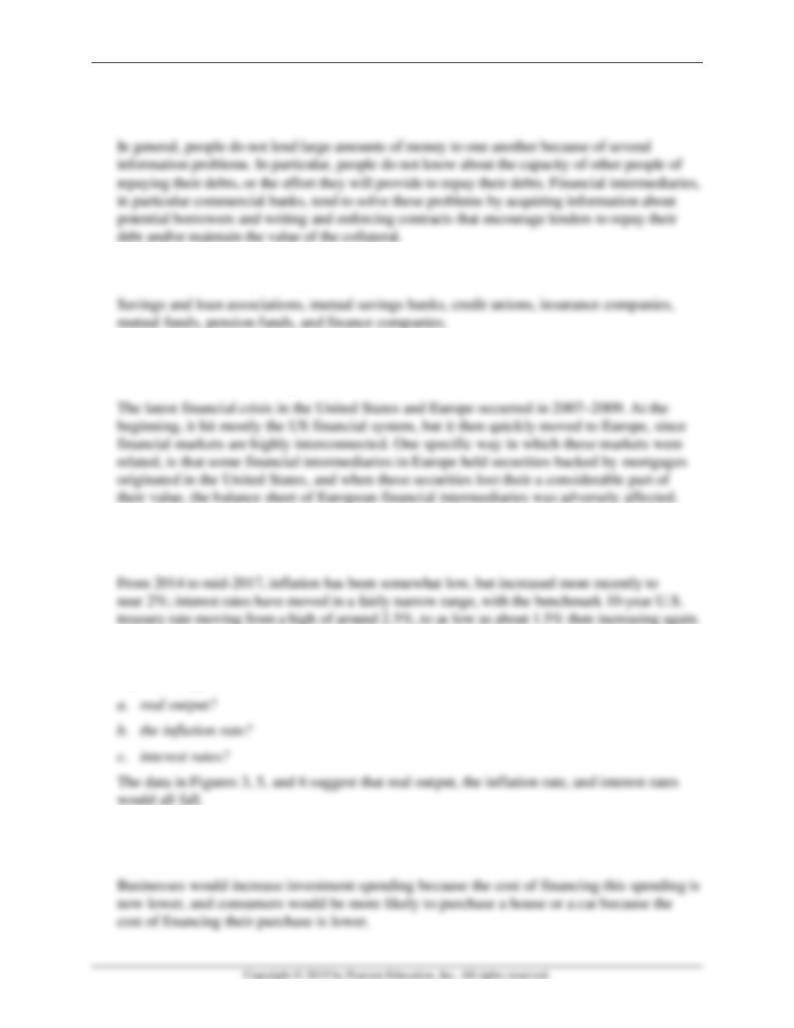
Mishkin • Instructor’s Manual for The Economics of Money, Banking, and Financial Markets, Twelfth Edition 52
6. Can you think of a reason why people in general do not lend money to one another to buy a
house or a car? How would your answer explain the existence of banks?
7. What are the other important financial intermediaries in the economy, besides banks?
8. Can you date the latest financial crisis in the United States or in Europe? Are there reasons
to think that these crises might have been related? Why?
9. Has the inflation rate in the United States increased or decreased in the past few years?
What about interest rates?
10. If history repeats itself and we see a decline in the rate of money growth, what might you
expect to happen to
11. When interest rates decrease, how might businesses and consumers change their economic
behavior?
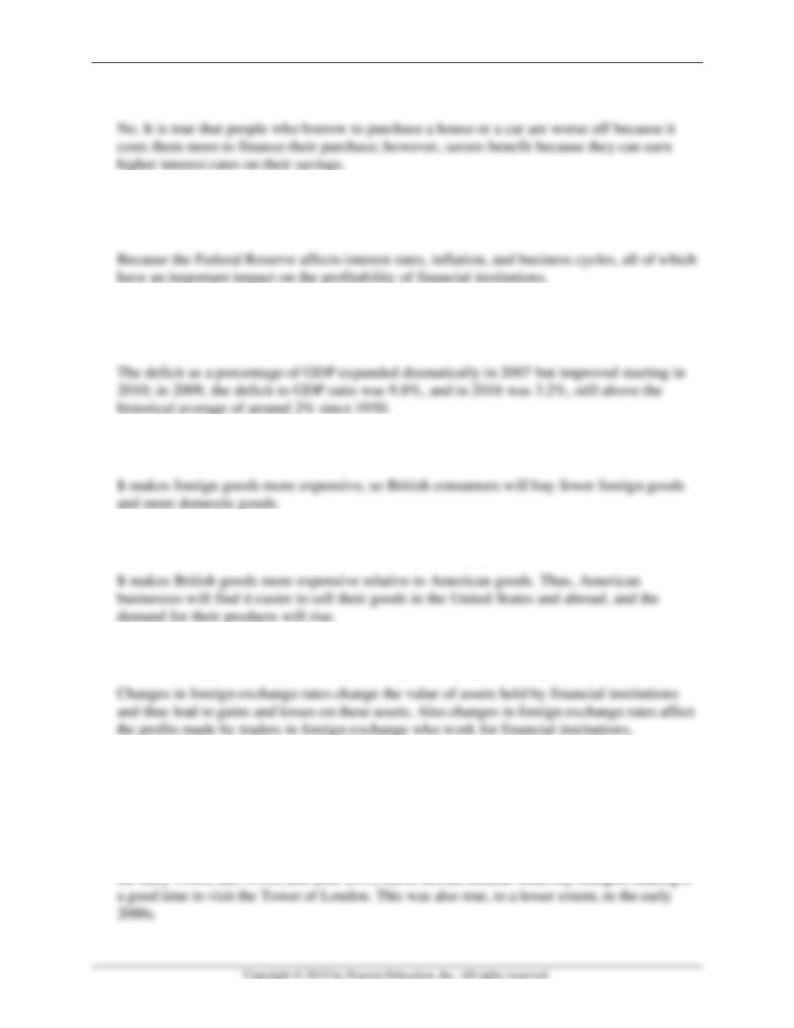
Mishkin • Instructor’s Manual for The Economics of Money, Banking, and Financial Markets, Twelfth Edition 53
12. Is everybody worse off when interest rates rise?
13. Why do managers of financial institutions care so much about the activities of the Federal
Reserve System?
14. How does the current size of the U.S. budget deficit compare to the historical budget deficit
or surplus for the time period since 1950?
15. How would a fall in the value of the pound sterling affect British consumers?
16. How would an increase in the value of the pound sterling affect American businesses?
17. How can changes in foreign exchange rates affect the profitability of financial institutions?
18. According to Figure 8, in which years would you have chosen to visit the Grand Canyon in
Arizona rather than the Tower of London?
In the mid- to late 1970s, the late 1980s to early 1990s, and 2008 to 2015, the value of the
dollar was low, making travel abroad relatively more expensive; thus, it was a good time to
vacation in the United States and see the Grand Canyon. With the rise in the dollar’s value in
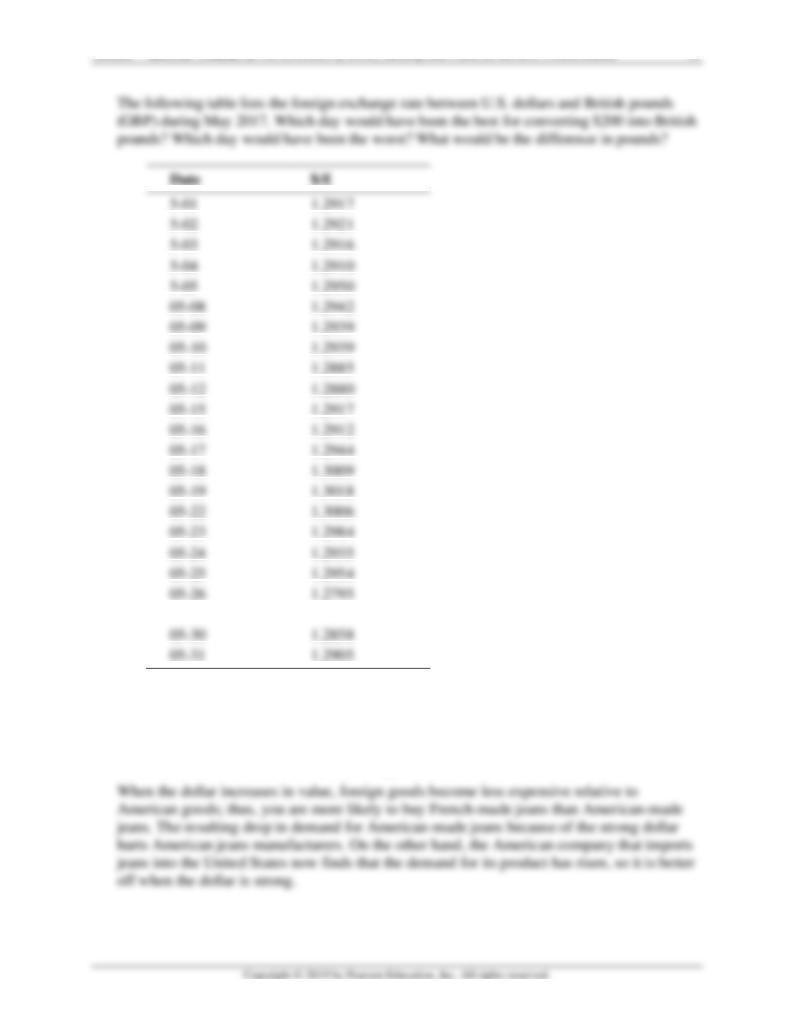
Mishkin • Instructor’s Manual for The Economics of Money, Banking, and Financial Markets, Twelfth Edition 54
19. When the dollar is worth more in relation to currencies of other countries, are you more
likely to buy American-made or foreign-made jeans? Are U.S. companies that manufacture
jeans happier when the dollar is strong or when it is weak? What about an American
company that is in the business of importing jeans into the United States?

Mishkin • Instructor’s Manual for The Economics of Money, Banking, and Financial Markets, Twelfth Edition 55
20. Much of the U.S. government debt is held by foreign investors as treasury bonds and bills.
How do fluctuations in the dollar exchange rate affect the value of that debt held by
foreigners?
21. The following table lists the foreign exchange rate between U.S. dollars and British pounds
(GBP) during May 2017. Which day would have been the best for converting $200 into
5/19. At $1.3018/pound, you would have £153.63, or a difference of £2.68
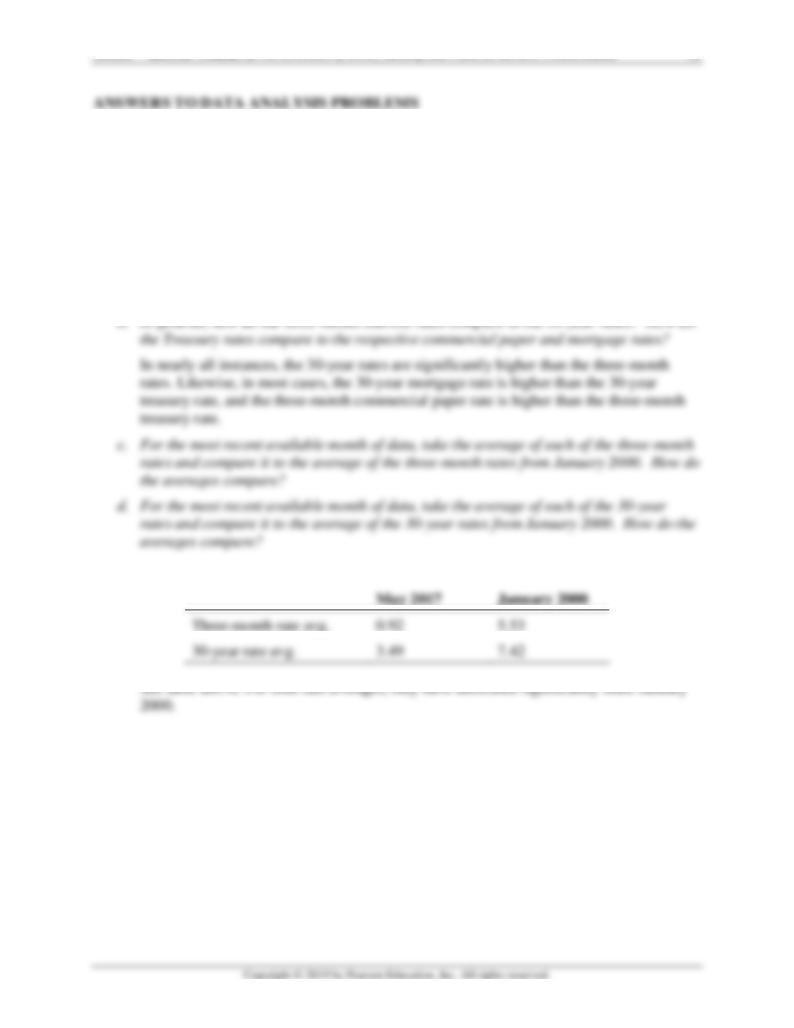
Mishkin • Instructor’s Manual for The Economics of Money, Banking, and Financial Markets, Twelfth Edition 56
1. Go to the St. Louis Federal Reserve FRED database and find data on the three-month
treasury bill rate (TB3MS), the three-month AA nonfinancial commercial paper rate
(CPN3M), the 30-year treasury bond rate (GS30), the 30-year fixed rate mortgage average
(MORTGAGE30US), and the NBER recession indicators (USREC). For the mortgage rate
indicator, set the frequency setting to ‘monthly’.
a. In general, how do these interest rates behave during expansionary periods?
Generally speaking, the interest rates fall during recessions, and rise during expansionary
periods.

Mishkin • Instructor’s Manual for The Economics of Money, Banking, and Financial Markets, Twelfth Edition 57
2. Go to the St. Louis Federal Reserve FRED database and find data on the M1 money supply
(M1SL) and the 10-year treasury bond rate (GS10). Add the two series into a single graph by
using the “Add Data Series” feature. Transform the M1 money supply variable into the M1
growth rate by adjusting the units for the M1 money supply to “Percent Change from Year
Ago.”
a. In general, how have the growth rate of the M1 money supply and the 10-year treasury
bond rate behaved during recessions and during expansionary periods since the year
2000?
10-year Treasury rate
2.30
6.66
The money growth rate is significantly higher in May 2017 than it was in January 2000.
The 10-year treasury rate is significantly lower in May 2017 than it was in January 2000.
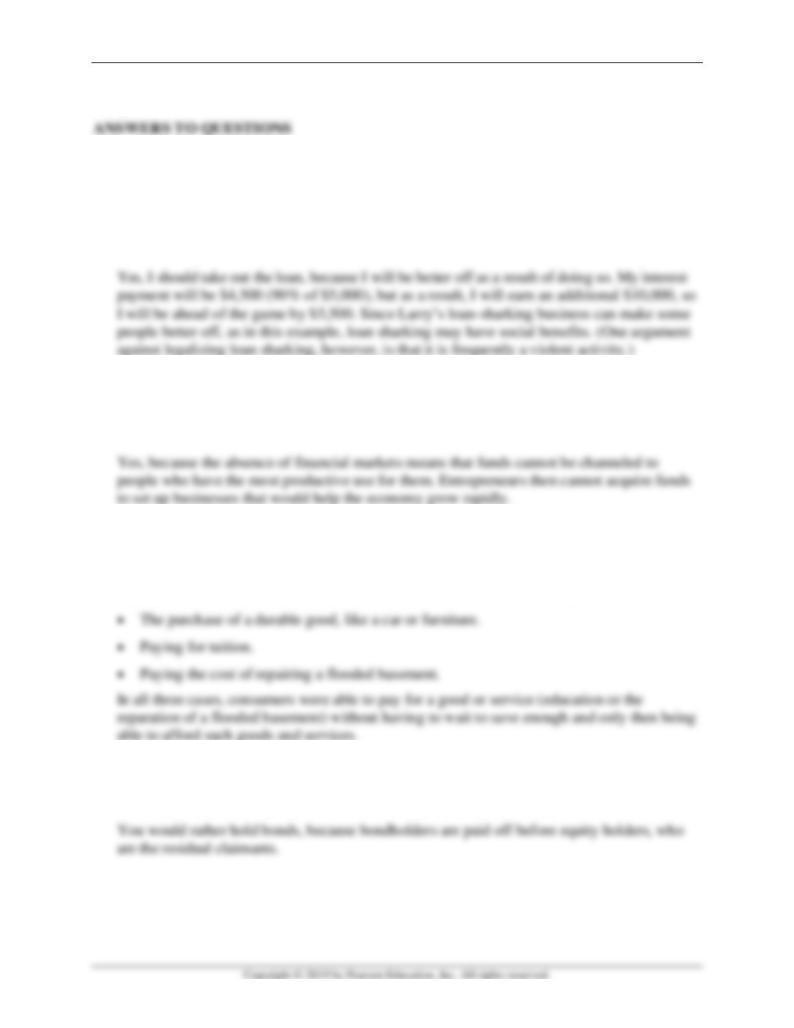
Mishkin • Instructor’s Manual for The Economics of Money, Banking, and Financial Markets, Twelfth Edition 58
Chapter 2
1. If I can buy a car today for $5,000 and it is worth $10,000 in extra income to me next year
because it enables me to get a job as a traveling salesman, should I take out a loan from
Larry the Loan Shark at a 90% interest rate if no one else will give me a loan? Will I be
better or worse off as a result of taking out this loan? Can you make a case for legalizing
loan sharking?
2. Some economists suspect that one of the reasons economies in developing countries grow so
slowly is that they do not have well-developed financial markets. Does this argument make
sense?
3. Give at least three examples of a situation in which financial markets allow consumers to
better time their purchases.
Examples of how financial markets allow consumers to better time their purchases include:
4. If you suspect that a company will go bankrupt next year, which would you rather hold,
bonds issued by the company or equities issued by the company? Why?

Mishkin • Instructor’s Manual for The Economics of Money, Banking, and Financial Markets, Twelfth Edition 59
5. Suppose that Toyota sells yen-denominated bonds in Tokyo. Is this debt instrument
considered a Eurobond? How would your answer change if the bond were sold in New York?
6. Describe who issues each of the following money market instruments:
a. Treasury bills
b. Certificates of deposit
c. Commercial paper
d. Repurchase agreement
7. What is the difference between a mortgage and a mortgage-backed security?
8. The U.S. economy borrowed heavily from the British in the nineteenth century to build a
railroad system. Why did this make both countries better off?
9. A significant number of European banks held large amounts of assets as mortgage-backed
securities derived from the U.S. housing market, which crashed after 2006. How does this
demonstrate both a benefit and a cost to the internationalization of financial markets?
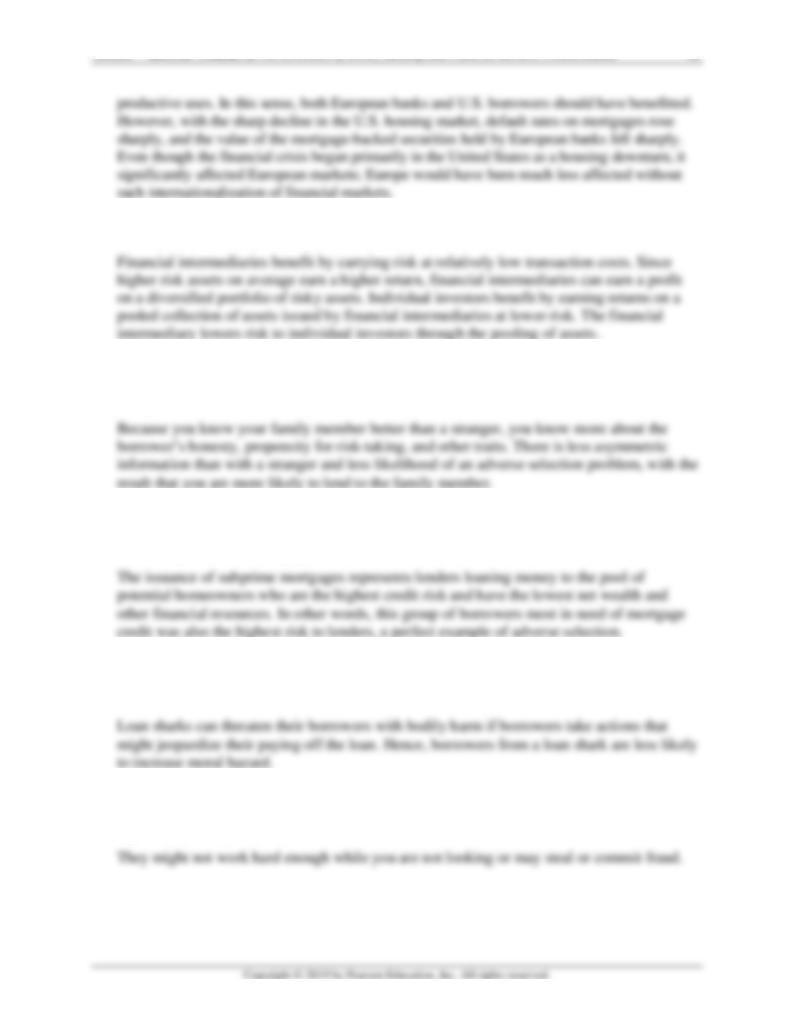
Mishkin • Instructor’s Manual for The Economics of Money, Banking, and Financial Markets, Twelfth Edition 60
10. How does risk-sharing benefit both financial intermediaries and private investors?
11. How can the adverse selection problem explain why you are more likely to make a loan to a
family member than to a stranger?
12. One of the factors contributing to the financial crisis of 2007–2009 was the widespread
issuance of subprime mortgages. How does this demonstrate adverse selection?
13. Why do loan sharks worry less about moral hazard in connection with their borrowers than
some other lenders do?
14. If you are an employer, what kinds of moral hazard problems might you worry about with
regard to your employees?
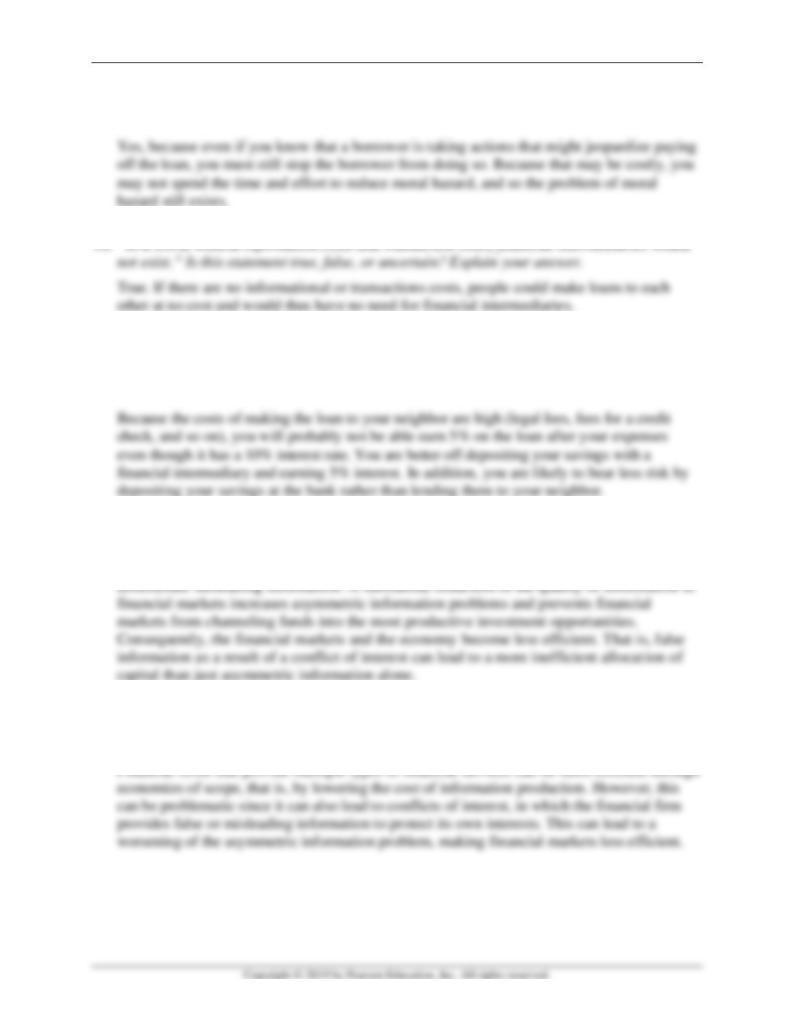
Mishkin • Instructor’s Manual for The Economics of Money, Banking, and Financial Markets, Twelfth Edition 61
15. If there were no asymmetry in the information that a borrower and a lender had, could a
moral hazard problem still exist?
17. Why might you be willing to make a loan to your neighbor by putting funds in a savings
account earning a 5% interest rate at the bank and having the bank lend her the funds at a
10% interest rate, rather than lend her the funds yourself?
18. How do conflicts of interest make the asymmetric information problem worse?
Potentially competing interests may lead an individual or firm to conceal information or
19. How can the provision of several types of financial services by one firm be both beneficial
and problematic?

Mishkin • Instructor’s Manual for The Economics of Money, Banking, and Financial Markets, Twelfth Edition 62
20. If you were going to get a loan to purchase a new car, which financial intermediary would
you use: a credit union, a pension fund, or an investment bank?
21. Why would a life insurance company be concerned about the financial stability of major
corporations or the health of the housing market?
22. In 2008, as a financial crisis began to unfold in the United States, the FDIC raised the limit
on insured losses to bank depositors from $100,000 per account to $250,000 per account.
How would this help stabilize the financial system?
23. Financial regulation is similar, but not exactly the same, in industrialized countries. Discuss
why it might be desirable—or undesirable—to have the same financial regulation across
industrialized countries.
This is a topic for which there is no clear answer. On one side, it would be beneficial to have
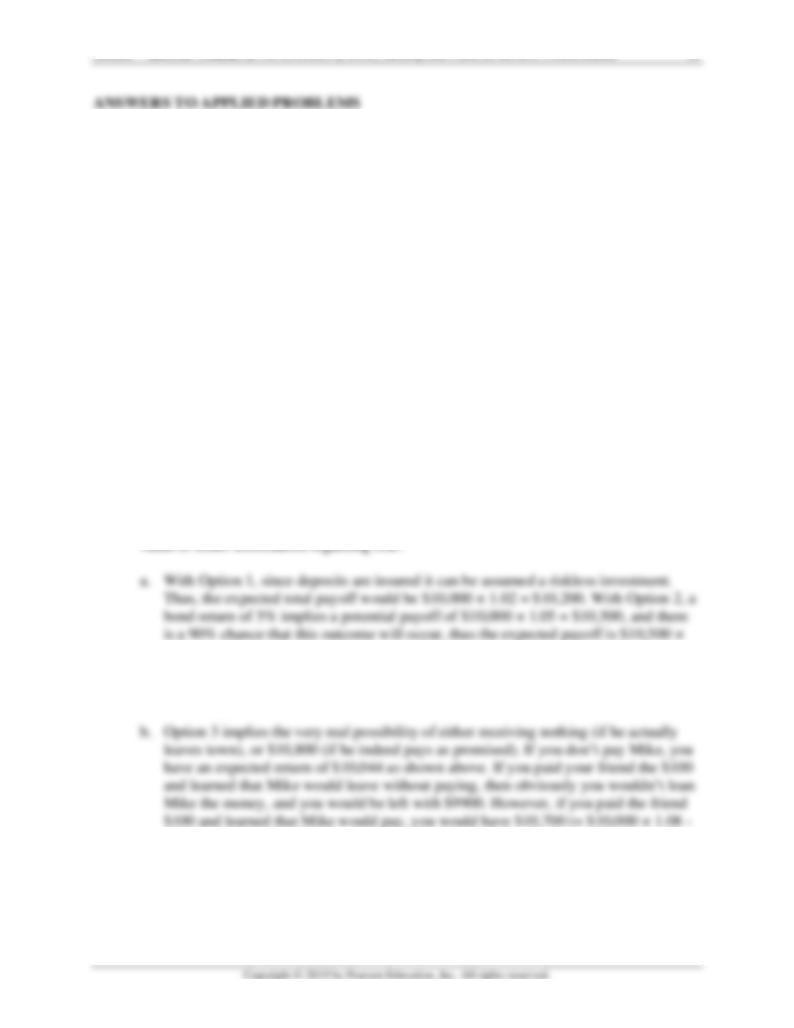
Mishkin • Instructor’s Manual for The Economics of Money, Banking, and Financial Markets, Twelfth Edition 63
24. Suppose you have just inherited $10,000 and are considering the following options for
investing the money to maximize your return:
Option 1: Put the money in an interest-bearing checking account that earns 2%. The FDIC
insures the account against bank failure.
Option 2: Invest the money in a corporate bond with a stated return of 5%, although there
is a 10% chance the company could go bankrupt.
Option 3: Loan the money to one of your friend’s roommates, Mike, at an agreed-upon
interest rate of 8%, even though you believe there is a 7% chance that Mike will leave
town without repaying you.
Option 4: Hold the money in cash and earn zero return.
a. If you are risk-neutral (i.e., neither seek out nor shy away from risk), which of the four
options should you choose to maximize your expected return? (Hint: To calculate the
expected return of an outcome, multiply the probability that an event will occur by the
outcome of that event.)
b. Suppose Option 3 and Option 4 are your only choices. If you could pay your friend $100
to find out extra information about Mike that would indicate with certainty whether he
will leave town without paying, would you pay the $100? What does this say about the
0.9 = $9450. Under Option 3, the expected payoff is $10,000 × 1.08 × 0.93 =
$10,044. Option 4 is riskless, so the expected total payoff is $10,000. Given these
choices and the assumption that you don’t care about risk, Option 1 is the best
investment.
$100). After paying your friend Mike, but before knowing the true outcome, your
expected return would be $10,644 ($9900 × 0.07 + $10,700 × 0.93). Under Option 3,
paying your friend the $100 is definitely worth it because it increases your expected
return and in addition dramatically reduces the downside risk that you make a bad
loan, and increases the certainty of the payoff amount. That is, with asymmetric
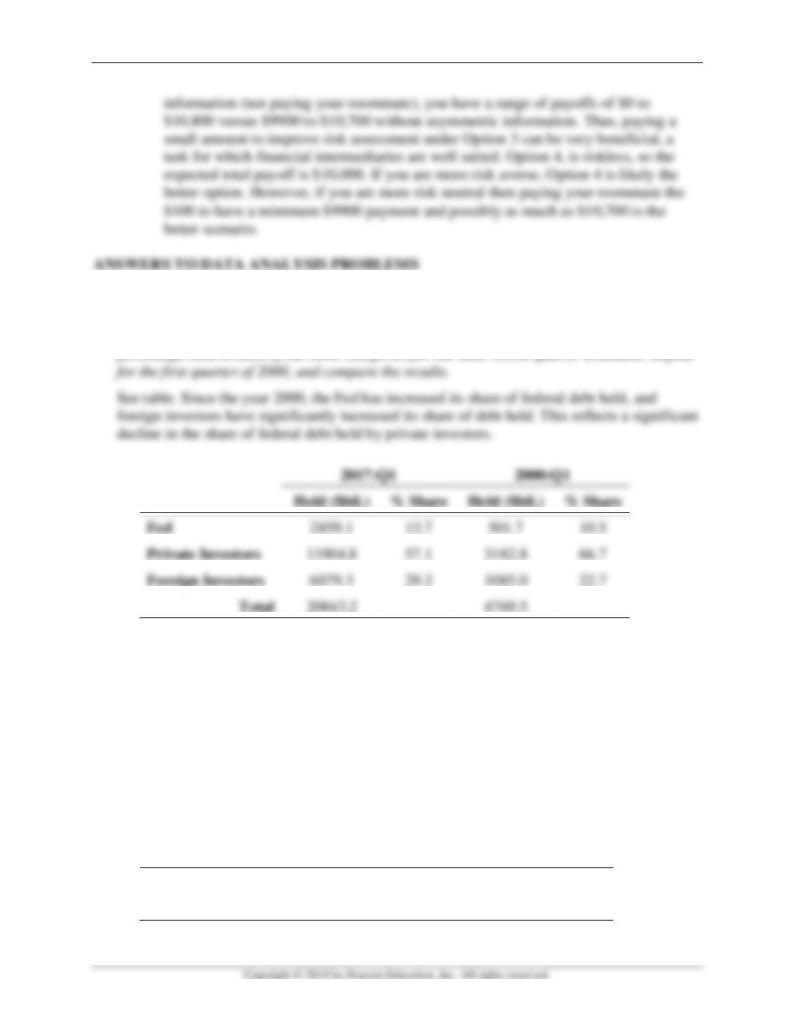
Mishkin • Instructor’s Manual for The Economics of Money, Banking, and Financial Markets, Twelfth Edition 64
1. Go to the St. Louis Federal Reserve FRED database and find data on federal debt held by the
Federal Reserve (FDHBFRBN), by private investors (FDHBPIN), and by international and
foreign investors (FDHBFIN). Using these series, calculate the total amount held and the
2. Go to the St. Louis Federal Reserve FRED database and find data on the total assets of all
commercial banks (TLAACBM027SBOG) and the total assets of money market mutual funds
(MMMFFAQ027S). Transform the commercial bank assets series to quarterly by adjusting
the Frequency setting to “Quarterly.” Calculate the percent increase in growth of assets for
each series, from January 2000 to the most recent quarter available. Which of the two
financial intermediaries has experienced the most growth?
See table below. Commercial bank assets have increased by 187% from 2000:Q1 to
2017:Q1, while money market mutual fund assets have increased also, but by less than
commercial banks during that time, at 57.1%.
2017:Q1
2000:Q1
Commercial Banks
$16,158.7 Bil.
$5,639.9 Bil.
Money Market Mutual Funds
$2,664.3 Bil.
$1,696.1 Bil.
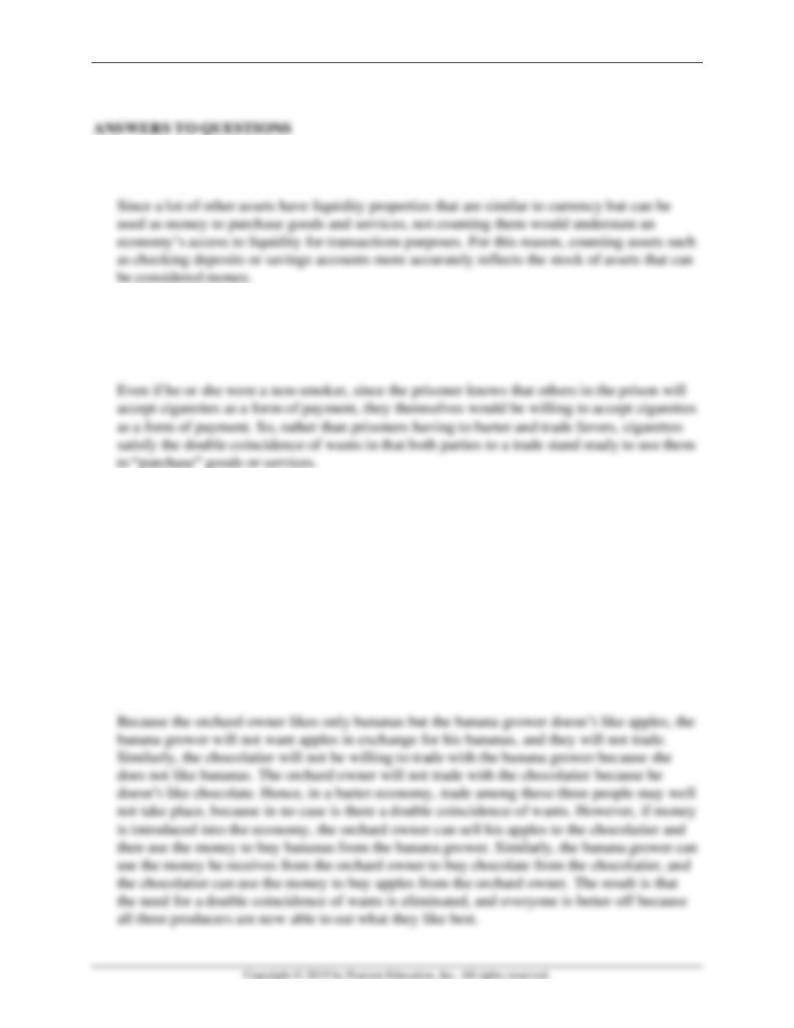
Mishkin • Instructor’s Manual for The Economics of Money, Banking, and Financial Markets, Twelfth Edition 65
Chapter 3
1. Why is simply counting currency an inadequate measure of money?
2. In prison, cigarettes are sometimes used among inmates as a form of payment. How is it
possible for cigarettes to solve the “double coincidence of wants” problem, even if a
prisoner does not smoke?
3. Three goods are produced in an economy by three individuals:
Good Producer
Apples Orchard Owner
Bananas Banana Grower
Chocolate Chocolatier
If the orchard owner likes only bananas, the banana grower likes only chocolate, and the
chocolatier likes only apples, will any trade between these three persons take place in a
barter economy? How will introducing money into the economy benefit these three
producers?
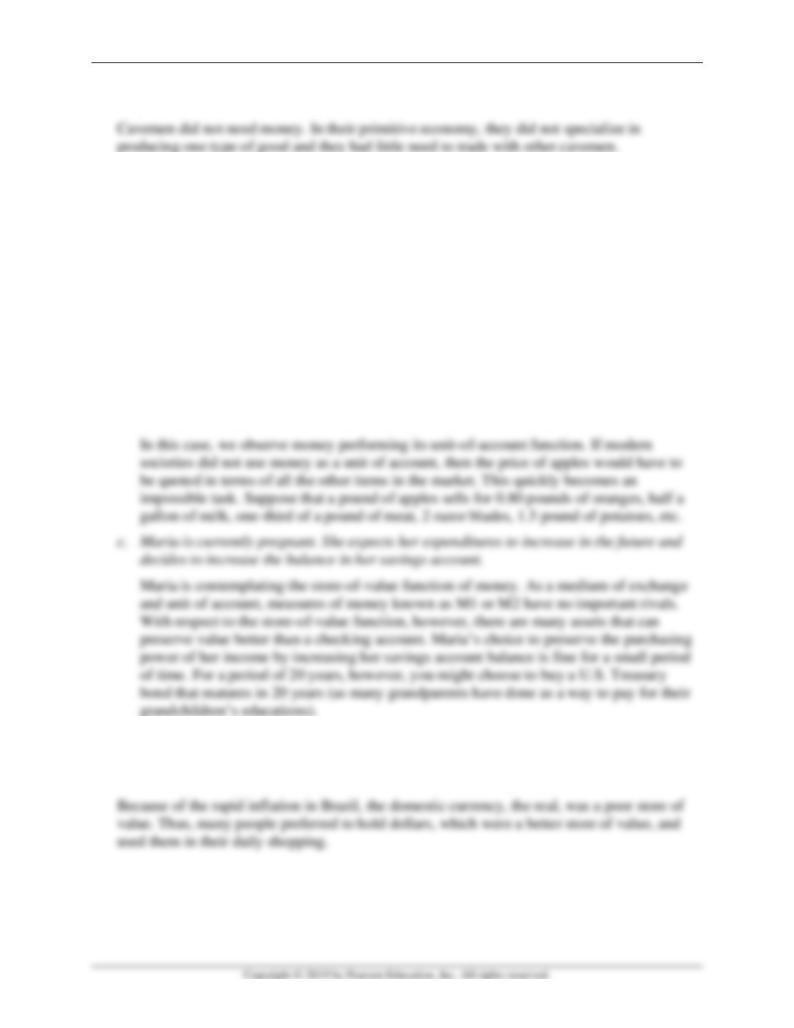
Mishkin • Instructor’s Manual for The Economics of Money, Banking, and Financial Markets, Twelfth Edition 66
4. Why did cavemen not need money?
5. Most of the time it is quite difficult to separate the three functions of money. Money performs
its three functions at all times, but sometimes we can stress one in particular. For each of the
following situations, identify which function of money is emphasized.
a. Brooke accepts money in exchange for performing her daily tasks at her office, since she
knows she can use that money to buy goods and services.
This situation illustrates the medium-of-exchange function of money. We often do not
think why we accept money in exchange for hours spent working, as we are so
accustomed to using money. The medium-of-exchange function of money refers to its
ability to facilitate trades (hours worked for money and then money for groceries) in a
society.
b. Tim wants to calculate the relative value of oranges and apples, and therefore checks the
price per pound of each of these goods as quoted in currency units.
6. In Brazil, a country that underwent a rapid inflation before 1994, many transactions were
conducted in dollars rather than in reals, the domestic currency. Why?

Mishkin • Instructor’s Manual for The Economics of Money, Banking, and Financial Markets, Twelfth Edition 67
7. Was money a better store of value in the United States in the 1950s than in the 1970s? Why
or why not? In which period would you have been more willing to hold money?
8. Why have some economists described money during a hyperinflation as a “hot potato” that
is quickly passed from one person to another?
9. Why were people in the United States in the nineteenth century sometimes willing to be paid
by check rather than with gold, even though they knew there was a possibility that the check
might bounce?
10. In ancient Greece, why was gold a more likely candidate for use as money than wine?
11. If you use an online payment system such as PayPal to purchase goods or services on the
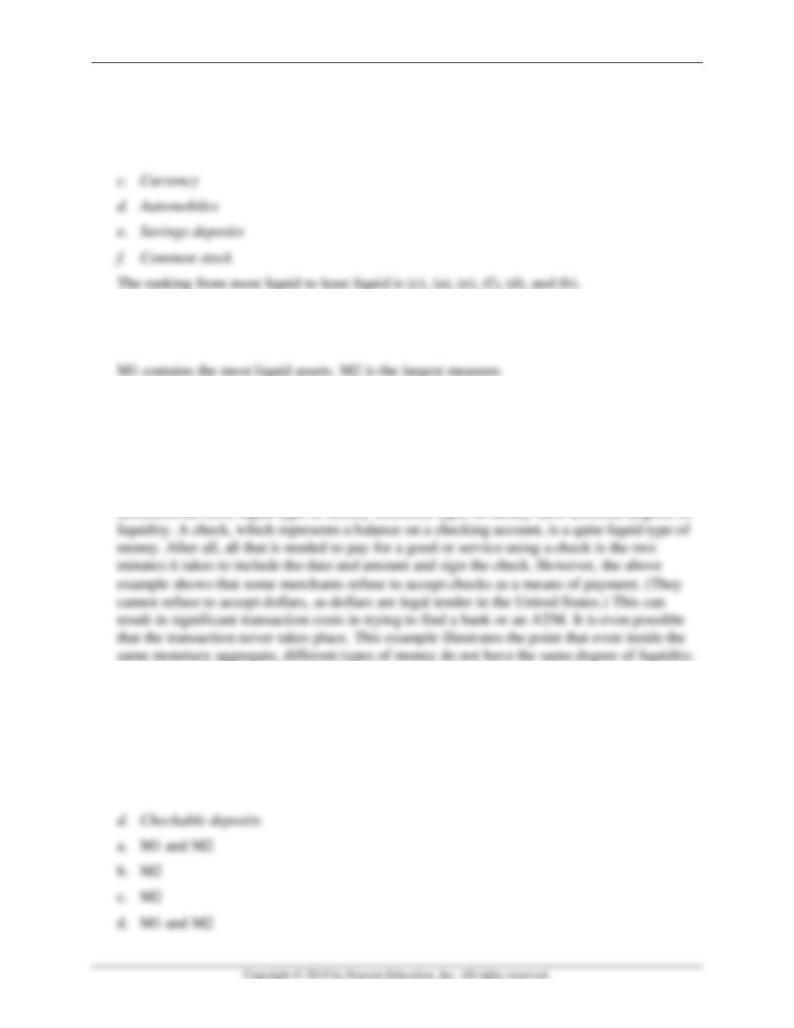
Mishkin • Instructor’s Manual for The Economics of Money, Banking, and Financial Markets, Twelfth Edition 68
12. Rank the following assets from most liquid to least liquid:
a. Checking account deposits
b. Houses
13. Which of the Federal Reserve’s measures of the monetary aggregates—M1 or M2—is
composed of the most liquid assets? Which is the larger measure?
14. It is not unusual to find a business that displays a sign saying “no personal checks, please.”
On the basis of this observation, comment on the relative degree of liquidity of a checking
account versus currency.
The degree of liquidity of an asset is measured by considering how much time and effort
(i.e., transaction costs) are needed to convert that asset into currency. Currency is by
15. For each of the following assets, indicate which of the monetary aggregates (M1 and M2)
includes them:
a. Currency
b. Money market mutual funds
c. Small-denomination time deposits

Mishkin • Instructor’s Manual for The Economics of Money, Banking, and Financial Markets, Twelfth Edition 69
and M2.
17. In April 2009, the growth rate of M1 fell to 6.1%, while the growth rate of M2 rose to 10.3%.
In September 2013, the year-over-year growth rate of the M1 money supply was 6.5%, while
the growth rate of the M2 money supply was about 8.3%. How should Federal Reserve
policymakers interpret these changes in the growth rates of M1 and M2?
18. Suppose a researcher discovers that a measure of the total amount of debt in the U.S.
economy over the past twenty years was a better predictor of inflation and the business cycle
than M1 or M2. Does this discovery mean that we should define money as equal to the total
amount of debt in the economy?
Not necessarily. Although the total amount of debt has predicted inflation and the business
cycle better than M1 or M2, it may not be a better predictor in the future. Without some
theoretical reason for believing that the total amount of debt will continue to predict well in
the future, we may not want to define money as the total amount of debt.
ANSWERS TO APPLIED PROBLEMS
Q.19 The table below shows hypothetical values, in billions of dollars, of different forms of
money.
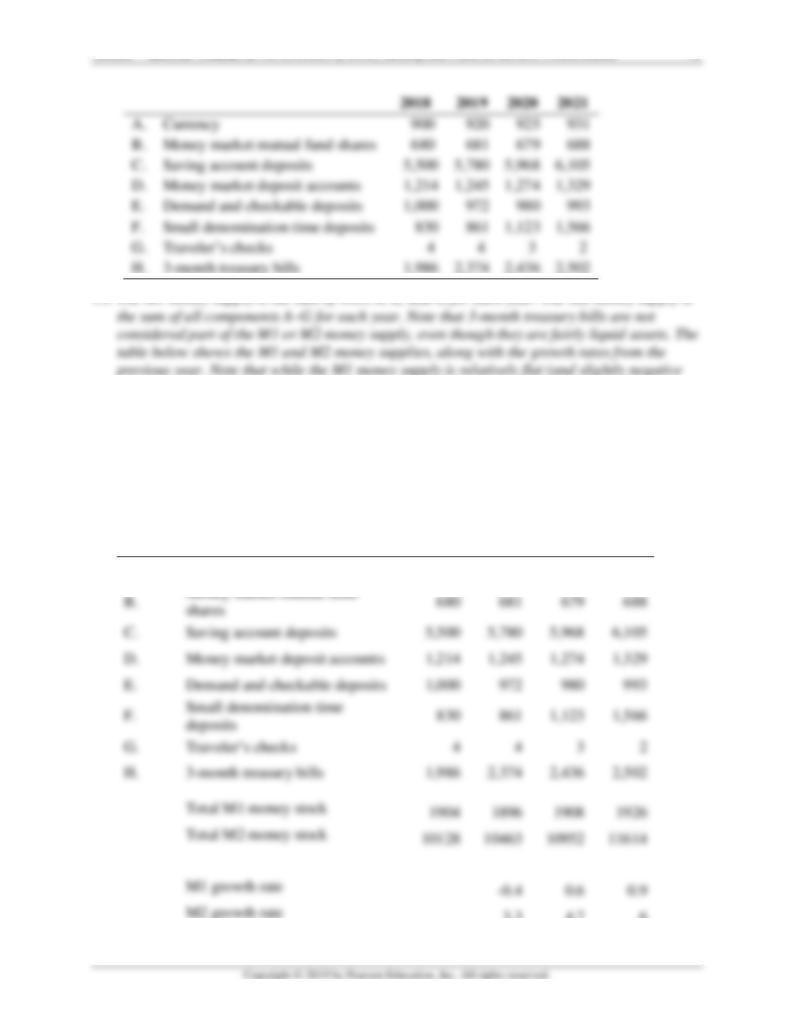
Mishkin • Instructor’s Manual for The Economics of Money, Banking, and Financial Markets, Twelfth Edition 70
for 2019), the M2 money supply grows at a much higher, positive rate. This is because the
components of M2 are rising much more rapidly compared to the components of M1 (which
are also included in M2). In particular, small denomination time deposits increase 30% from
2019 to 2020, and 39% from 2020 to 2021, driving much of the growth in M2. Moreover, the
narrower components that make up just the M1 money supply represent less than 20%
(1904/10128) of the broader M2 indicators. Thus, movements in the money market, savings
account, and time deposit measures will have a much bigger impact on M2 growth than the
narrower M1 components will.
2018
2019
2020
2021
A.
Currency
900
920
925
931
3.3
4.7
6
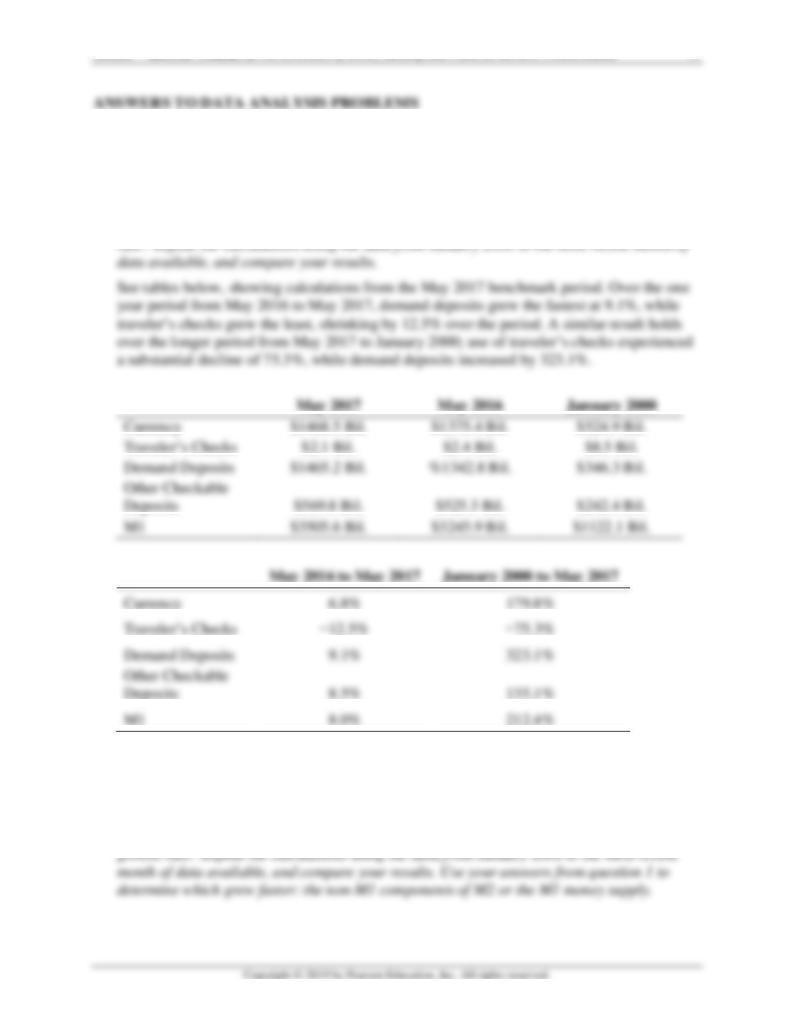
Mishkin • Instructor’s Manual for The Economics of Money, Banking, and Financial Markets, Twelfth Edition 71
1. Go to the St. Louis Federal Reserve FRED database and find data on currency (CURRSL),
traveler’s checks (TVCKSSL), demand deposits (DEMDEPSL), and other checkable deposits
(OCDSL). Calculate the M1 money supply, and calculate the percentage change in M1 and
in each of the four components of M1 from the most recent month of data available to the
same time one year prior. Which component has the highest growth rate? The lowest growth
2. Go to the St. Louis Federal Reserve FRED database and find data on small-denomination
time deposits (STDSL), savings deposits and money market deposit accounts (SAVINGSL),
and retail money market funds (RMFSL). Calculate the percentage change of each of these
three components of M2 (not included in M1) from the most recent month of data available to
the same time one year prior. Which component has the highest growth rate? The lowest
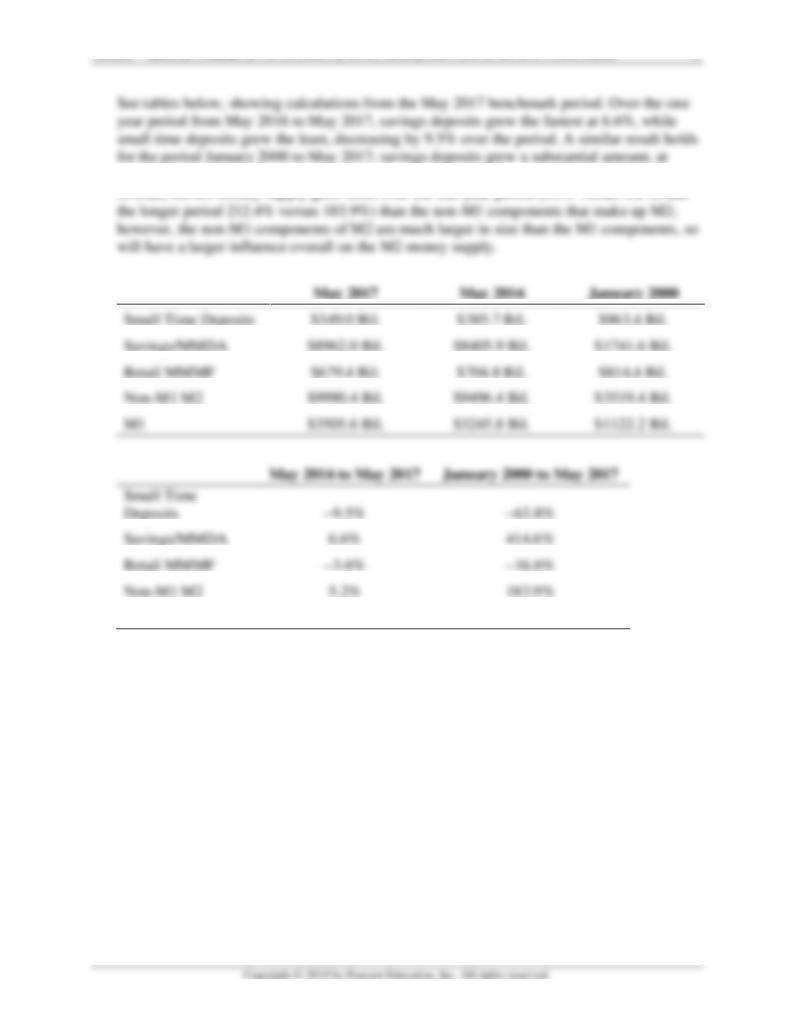
Mishkin • Instructor’s Manual for The Economics of Money, Banking, and Financial Markets, Twelfth Edition 72
414.6% over the period, while small time deposits decreased significantly, by 63.8%.
M1
8.0%
212.4%
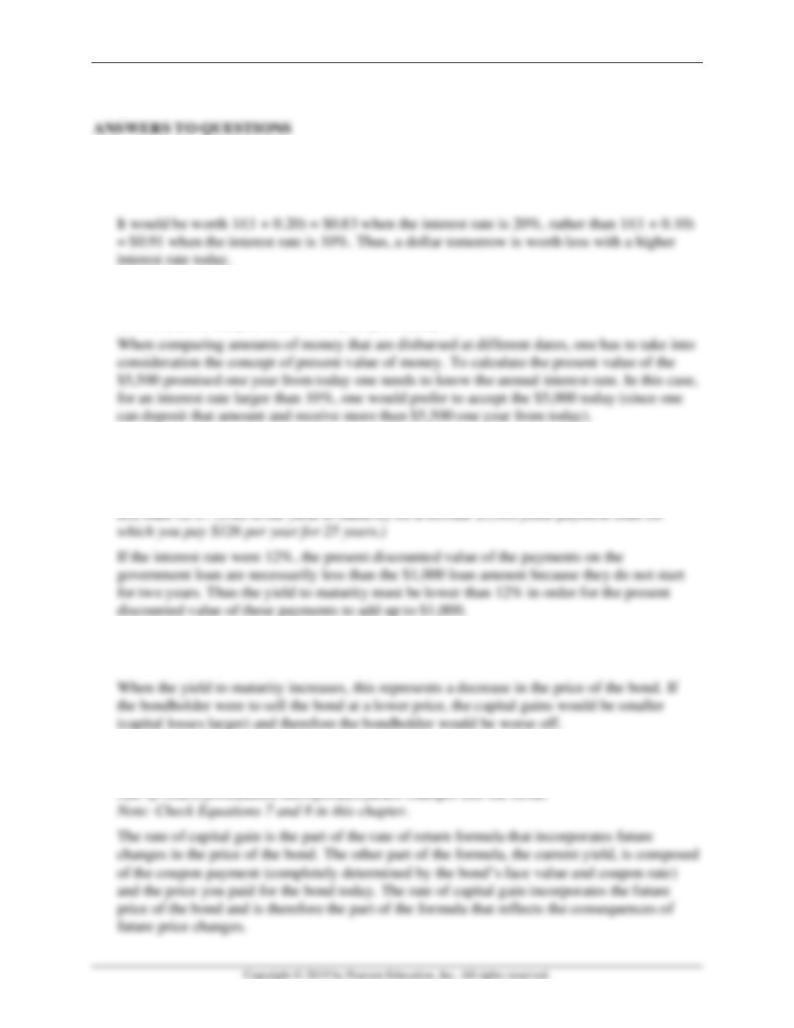
Mishkin • Instructor’s Manual for The Economics of Money, Banking, and Financial Markets, Twelfth Edition 73
Chapter 4
1. Would a dollar tomorrow be worth more to you today when the interest rate is 20% or when
it is 10%?
2. Explain which information you would need to take into consideration when deciding to
receive $5,000 today or $5,500 one year from today.
3. To help pay for college, you have just taken out a $1,000 government loan that makes you
pay $126 per year for 25 years. However, you don’t have to start making these payments
until you graduate from college two years from now. Why is the yield to maturity necessarily
4. Do bondholders fare better when the yield to maturity increases or when it decreases? Why?
5. Suppose today you buy a coupon bond that you plan to sell one year later. Which part of the
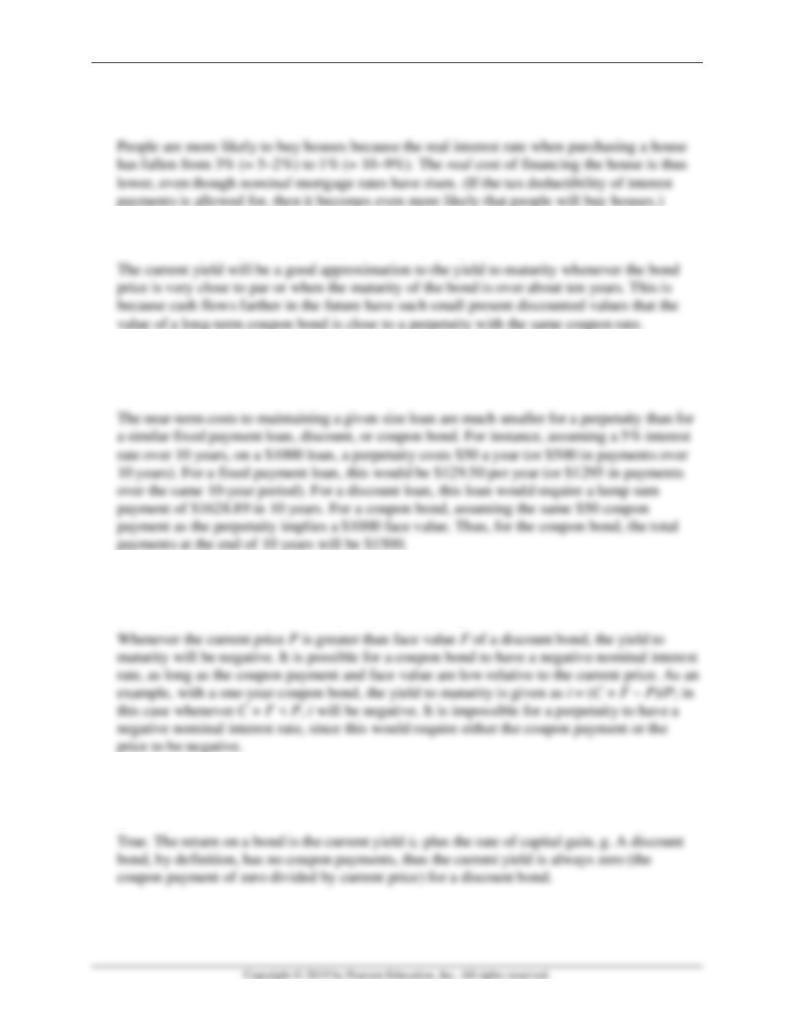
Mishkin • Instructor’s Manual for The Economics of Money, Banking, and Financial Markets, Twelfth Edition 74
6. If mortgage rates rise from 5% to 10%, but the expected rate of increase in housing prices
rises from 2% to 9%, are people more or less likely to buy houses?
7. When is the current yield a good approximation of the yield to maturity?
8. Why would a government choose to issue a perpetuity, which requires payments forever,
instead of a terminal loan, such as a fixed-payment loan, discount bond, or coupon bond?
9. Under what conditions will a discount bond have a negative nominal interest rate? Is it
possible for a coupon bond or a perpetuity to have a negative nominal interest rate?
10. True or False: With a discount bond, the return on the bond is equal to the rate of capital
gain.
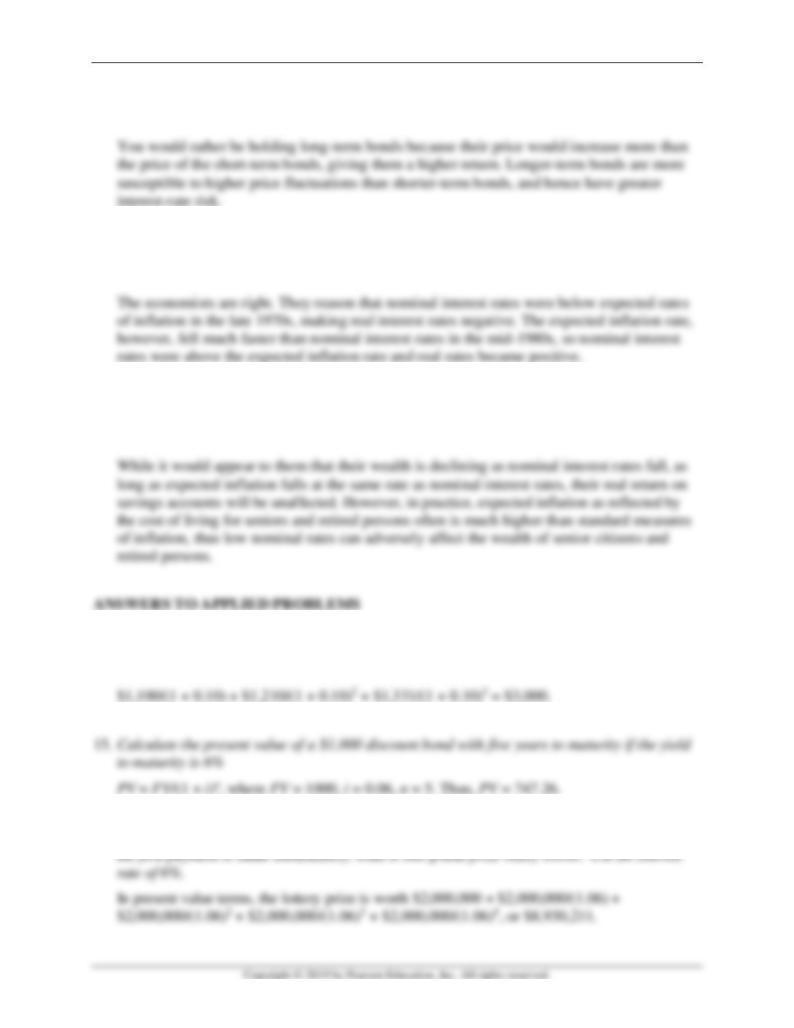
Mishkin • Instructor’s Manual for The Economics of Money, Banking, and Financial Markets, Twelfth Edition 75
11. If interest rates decline, which would you rather be holding, long-term bonds or short-term
bonds? Why? Which type of bond has the greater interest-rate risk?
12. Interest rates were lower in the mid-1980s than in the late 1970s, yet many economists have
commented that real interest rates were actually much higher in the mid-1980s than in the
late 1970s. Does this make sense? Do you think that these economists are right?
13. Retired persons often have much of their wealth placed in savings accounts and other
interest-bearing investments, and complain whenever interest rates are low. Do they have a
valid complaint?
14. If the interest rate is 10%, what is the present value of a security that pays you $1,100 next
year, $1,210 the year after, and $1,331 the year after that?
16. A lottery claims its grand prize is $10 million, payable over 5 years at $2,000,000 per year. If
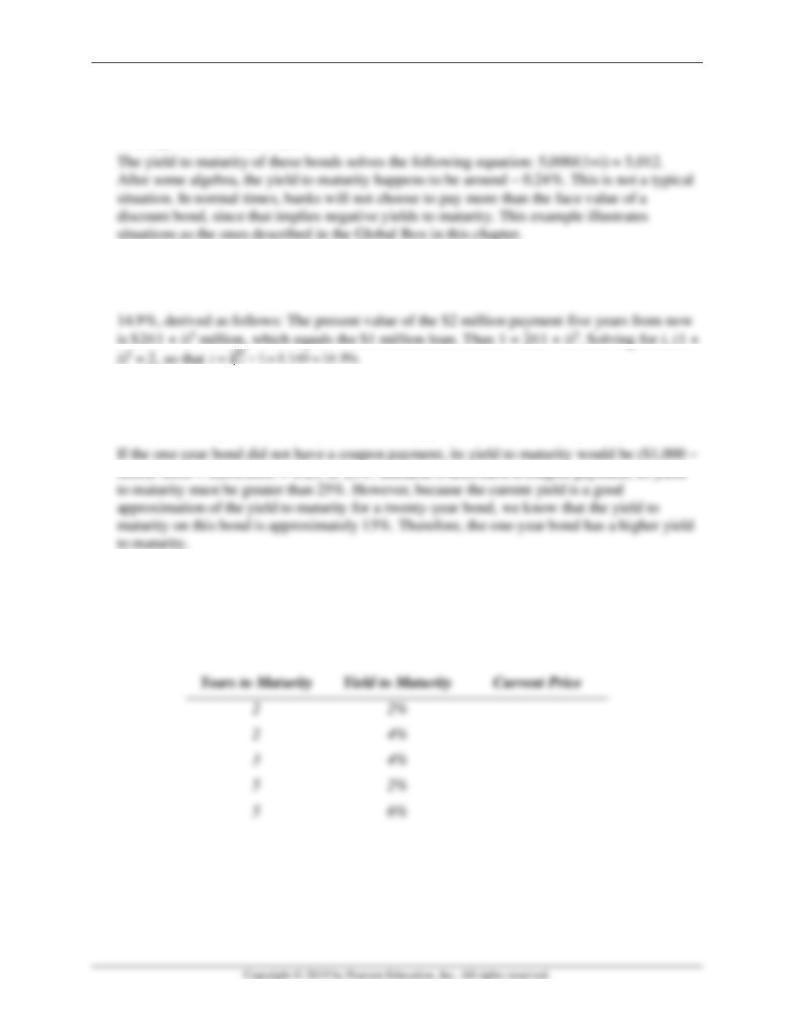
Mishkin • Instructor’s Manual for The Economics of Money, Banking, and Financial Markets, Twelfth Edition 76
17. Suppose that a commercial bank wants to buy Treasury bills. These instruments pay $5,000 in
one year and are currently selling for $5,012. What is the yield to maturity of these bonds? Is
this a typical situation? Why?
18. What is the yield to maturity on a simple loan for $1 million that requires a repayment of $2
million in five years’ time?
19. Which $1,000 bond has the higher yield to maturity, a twenty-year bond selling for $800 with
a current yield of 15% or a one-year bond selling for $800 with a current yield of 5%?
20. Consider a bond with a 4% annual coupon and a face value of $1,000. Complete the
following table. What relationships do you observe between years to maturity, yield to
maturity, and the current price?
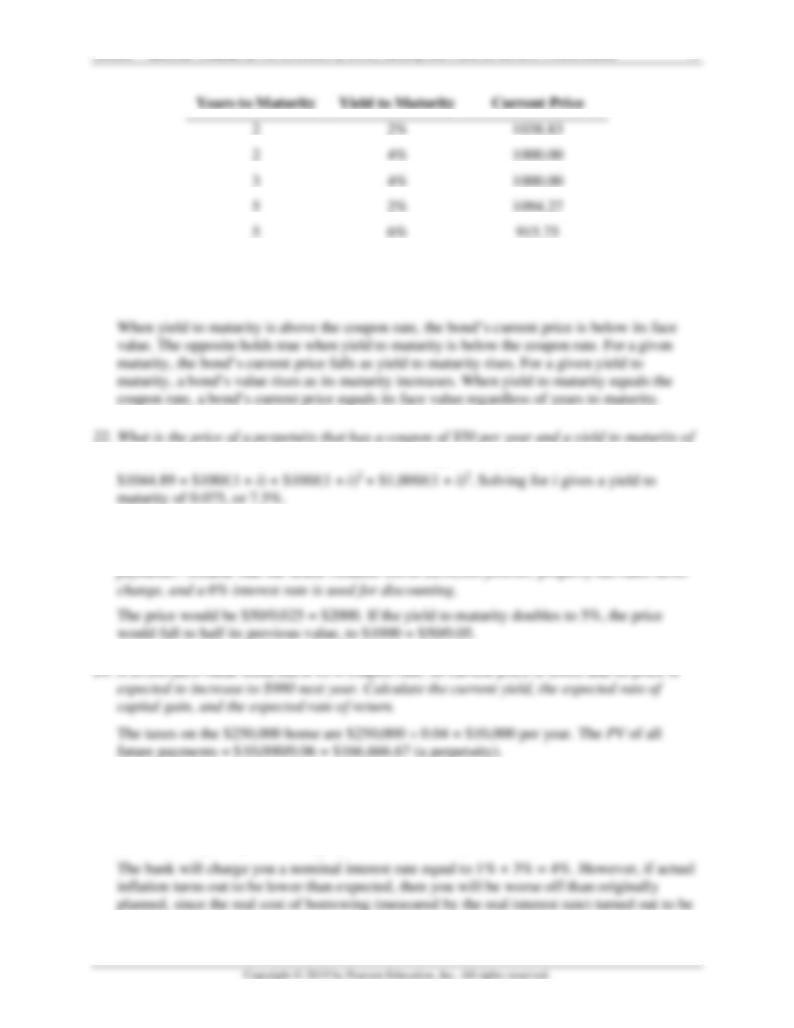
Mishkin • Instructor’s Manual for The Economics of Money, Banking, and Financial Markets, Twelfth Edition 77
21. Consider a coupon bond that has a $1,000 par value and a coupon rate of 10%. The bond is
currently selling for $1,044.89 and has two years to maturity. What is the bond’s yield to
maturity?
2.5%? If the yield to maturity doubles, what will happen to the perpetuity’s price?
23. Property taxes in a particular district are 4% of the purchase price of a home every year. If
you just purchased a $250,000 home, what is the present value of all the future property tax
25. Suppose that you want to take out a loan and that your local bank wants to charge you an
annual real interest rate equal to 3%. Assuming that the annualized expected rate of inflation
over the life of the bond is 1%, determine the nominal interest rate that the bank will charge
you. What happens if, over the life of the loan, actual inflation is 0.5%?
4–0.5% = 3.5%.
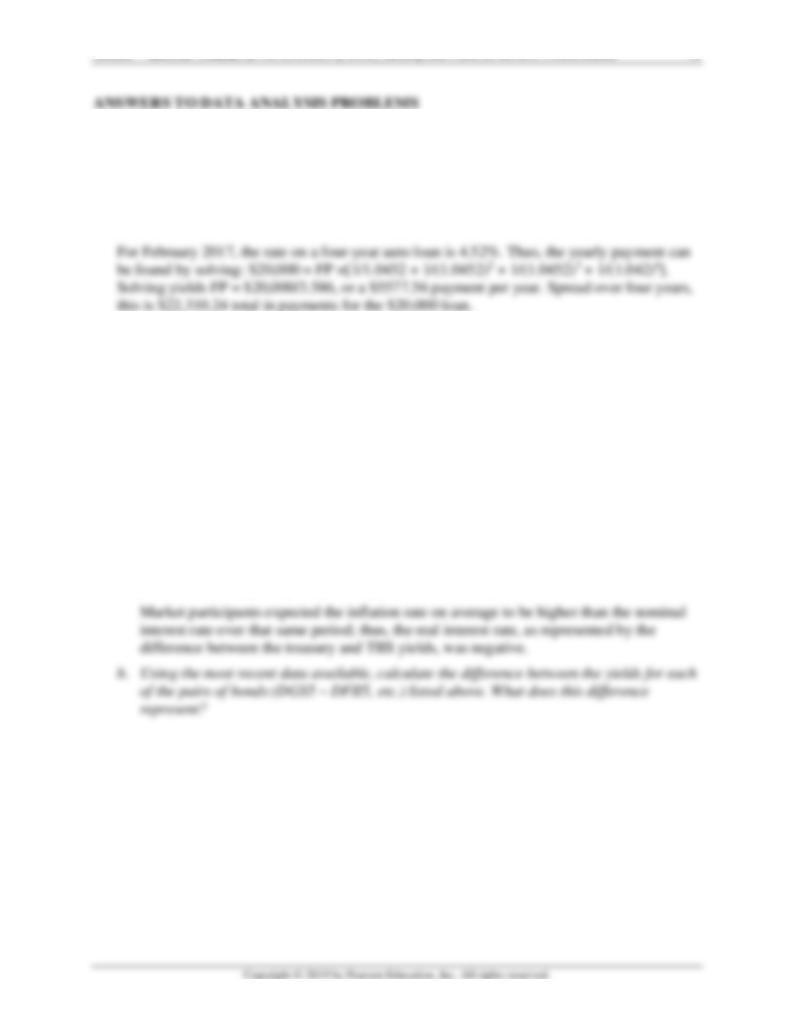
Mishkin • Instructor’s Manual for The Economics of Money, Banking, and Financial Markets, Twelfth Edition 78
1. Go to the St. Louis Federal Reserve FRED database and find data on the interest rate on a
four-year auto loan (TERMCBAUTO48NS). Assume that you borrow $20,000 to purchase a
new automobile and that you finance it with a four-year loan at the most recent interest rate
given in the database. If you make one payment per year for four years, what will the yearly
payment be? What is the total amount that will be paid out on the $20,000 loan?
2. The U.S. Treasury issues some bonds as Treasury Inflation Indexed Securities, or TIIS, which
are bonds adjusted for inflation; hence the yields can be roughly interpreted as real interest
rates. Go to the St. Louis Federal Reserve FRED database and find data on the following
TIIS bonds and their nominal counterparts. Then answer the questions below.
• 5 year U.S. treasury (DGS5) and 5-year TIIS (DFII5)
• 7 year U.S. treasury (DGS7) and 7-year TIIS (DFII7)
• 10 year U.S. treasury (DGS10) and 10-year TIIS (DFII10)
• 20 year U.S. treasury (DGS20) and 20-year TIIS (DFII20)
• 30 year U.S. treasury (DGS30) and 30-year TIIS (DFII30)
a. Following the Great Recession of 2008–2009, the 5, 7, 10, and even the 20-year TIIS
yields became negative for a period of time. How is this possible?

Mishkin • Instructor’s Manual for The Economics of Money, Banking, and Financial Markets, Twelfth Edition 79
30 Year
2.82
0.96
1.86
c. Based on your answer to part (b), are there significant variations among the differences
in the bond-pair yields? Interpret the magnitude of the variation in differences among the
pairs.
The difference, which roughly represents inflation expectations, is fairly constant over
the various horizons, but grows slightly as you move farther out. In this case, market
participants expect average inflation to be somewhat lower in the near term, but average a
bit below 2% at 10, 20, and 30 years out.
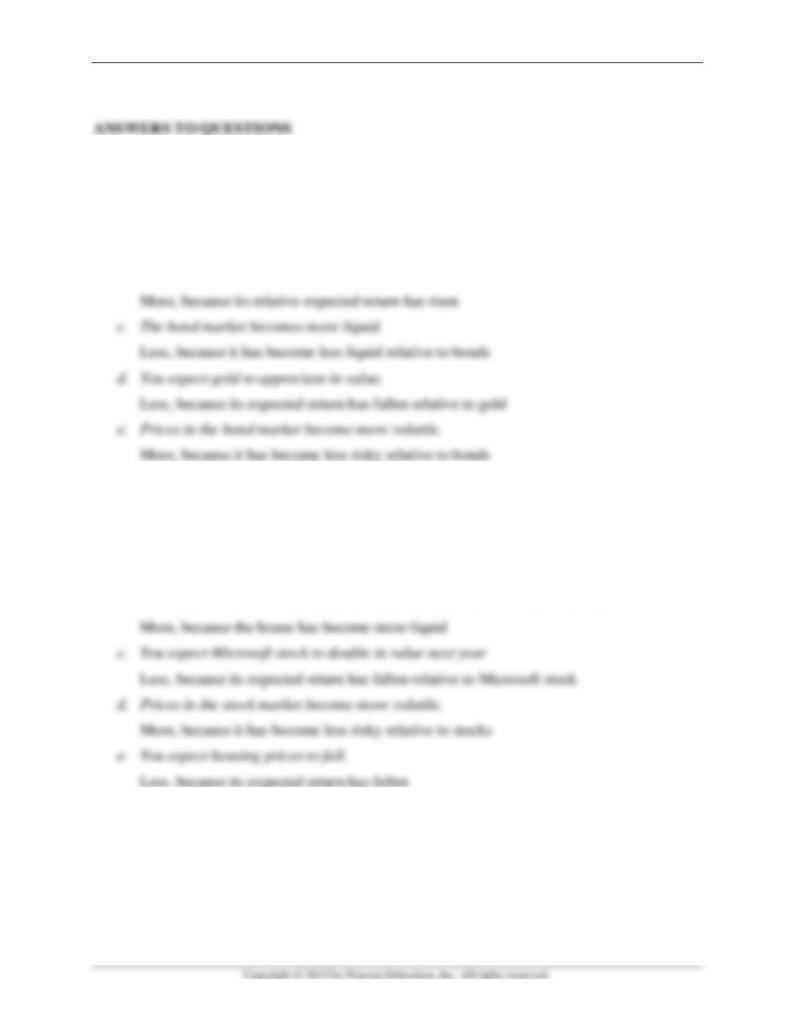
Mishkin • Instructor’s Manual for The Economics of Money, Banking, and Financial Markets, Twelfth Edition 80
Chapter 5
1. Explain why you would be more or less willing to buy a share of Microsoft stock in the
following situations:
a. Your wealth falls.
Less, because your wealth has declined
b. You expect the stock to appreciate in value.
2. Explain why you would be more or less willing to buy a house under the following
circumstances:
a. You just inherited $100,000.
More, because your wealth has increased
b. Real estate commissions fall from 6% of the sales price to 5% of the sales price.
3. Explain why you would be more or less willing to buy gold under the following
circumstances:
a. Gold again becomes acceptable as a medium of exchange.
More, because it has become more liquid

4. Explain why you would be more or less willing to buy long-term AT&T bonds under the
following circumstances:
a. Trading in these bonds increases, making them easier to sell.
More, because the bonds have become more liquid
b. You expect a bear market in stocks (stock prices are expected to decline).
5. What will happen to the demand for Rembrandt paintings if the stock market undergoes a
boom? Why?
6. Raphael observes that at the current level of interest rates there is an excess supply of bonds
and therefore he anticipates an increase in the price of bonds. Is Raphael correct?
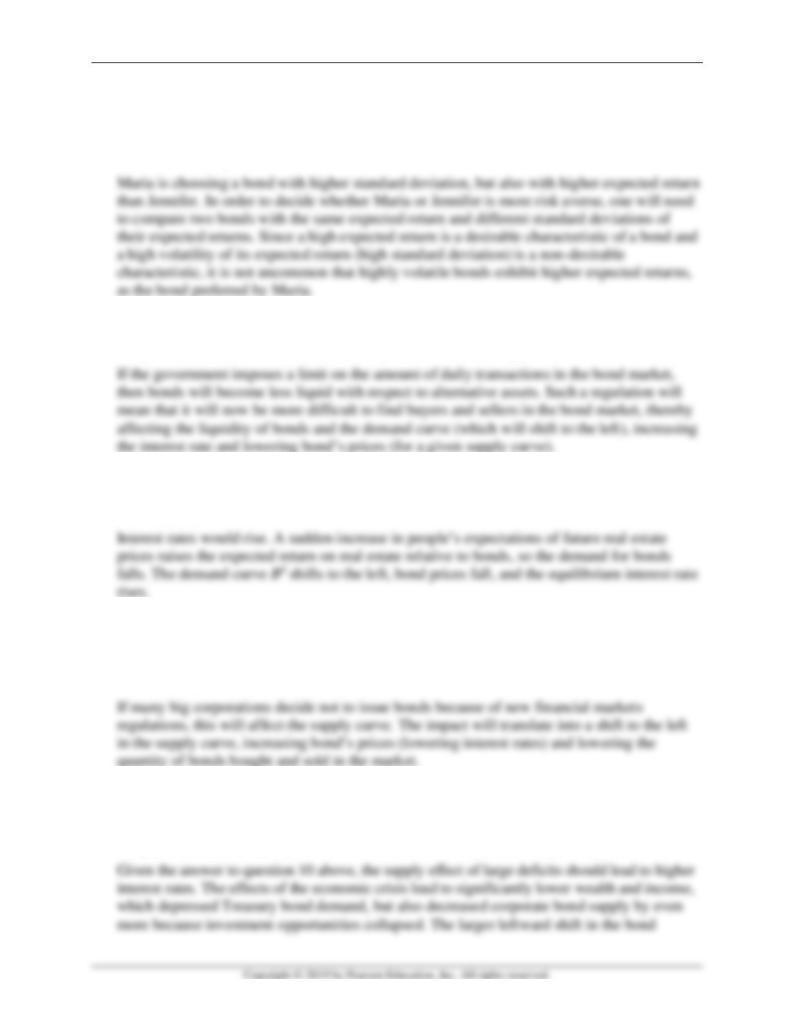
Mishkin • Instructor’s Manual for The Economics of Money, Banking, and Financial Markets, Twelfth Edition 82
7. Suppose Maria prefers to buy a bond with a 7% expected return and 2% standard deviation
of its expected return, while Jennifer prefers to buy a bond with a 4% expected return and
1% standard deviation of its expected return. Can you tell if Maria is more or less risk-
averse than Jennifer?
8. What will happen in the bond market if the government imposes a limit on the amount of
daily transactions? Which characteristic of an asset would be affected?
9. How might a sudden increase in people’s expectations of future real estate prices affect
interest rates?
10. Suppose that many big corporations decide not to issue bonds, since it is now too costly to
comply with new financial market regulations. Can you describe the expected effect on
interest rates?
11. In the aftermath of the global economic crisis that started to take hold in 2008, U.S.
government budget deficits increased dramatically, yet interest rates on U.S. Treasury debt fell
sharply and stayed low for quite some time. Does this make sense? Why or why not?
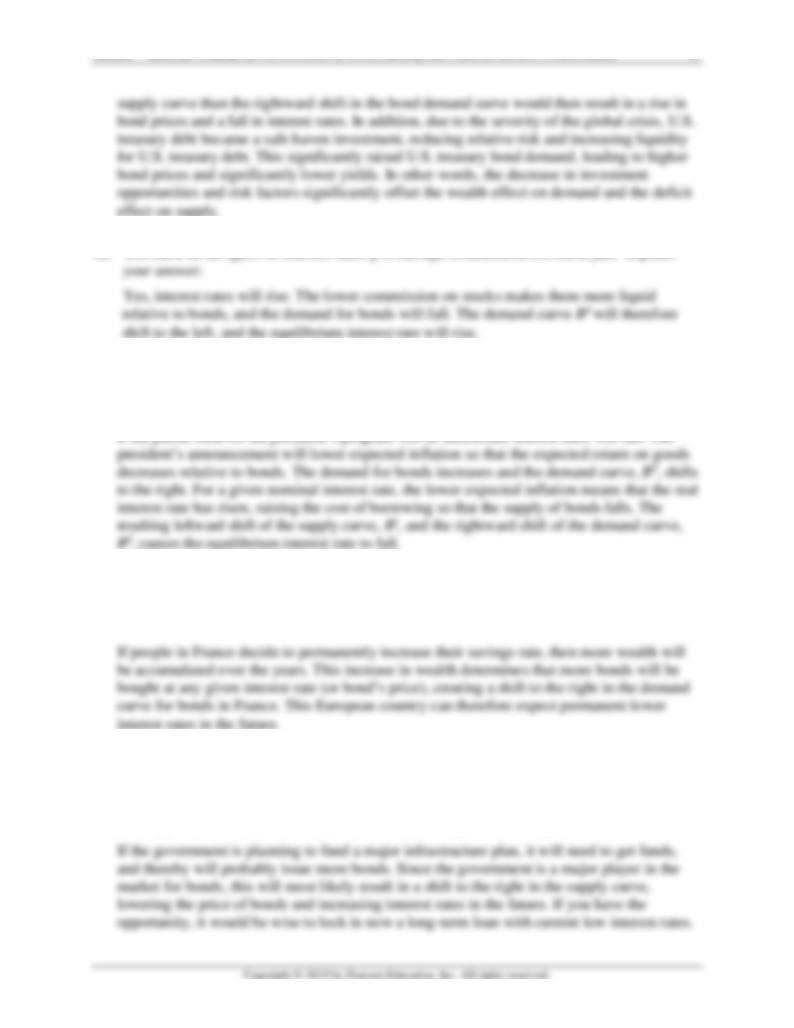
Mishkin • Instructor’s Manual for The Economics of Money, Banking, and Financial Markets, Twelfth Edition 83
13. The president of the United States announces in a press conference that he will fight the higher
inflation rate with a new anti-inflation program. Predict what will happen to interest rates if
the public believes him.
14. Suppose that people in France decide to permanently increase their savings rate. Predict
what will happen to the French bond market in the future. Can France expect higher or
lower domestic interest rates?
15. Suppose you are in charge of the financial department of your company and you have to
decide whether to borrow short or long term. Checking the news, you realize that the
government is about to engage in a major infrastructure plan in the near future. Predict what
will happen to interest rates. Will you advise borrowing short or long term?

Mishkin • Instructor’s Manual for The Economics of Money, Banking, and Financial Markets, Twelfth Edition 84
16. Would fiscal policymakers ever have reason to worry about potentially inflationary
conditions? Why or why not?
17. Why should a rise in the price level (but not in expected inflation) cause interest rates to rise
when the nominal money supply is fixed?
18. If the next chair of the Federal Reserve Board has a reputation for advocating an even
slower rate of money growth than the current chair, what will happen to interest rates?
Discuss the possible resulting situations.
19. M1 money growth in the U.S. was about 15% in 2011 and 2012, and 10% in 2013. Over the
same time period, the yield on 3-month Treasury bills was close to 0%. Given these high
rates of money growth, why did interest rates stay so low, rather than increase? What does
this say about the income, price-level, and expected-inflation effects?

Mishkin • Instructor’s Manual for The Economics of Money, Banking, and Financial Markets, Twelfth Edition 85
20. Suppose you visit with a financial adviser, and you are considering investing some of your
0.05
0%
a. Which investment should you choose to maximize your expected return: stocks, bonds, or
commodities?
0.25(4%) + 0.05(0%) = 9.5%. Since the commodities portfolio has the higher expected
return, you should choose that.
b. If you are risk-averse and have to choose between the stock and the bond investments,
which should you choose? Why?
21. An important way in which the Federal Reserve decreases the money supply is by selling
bonds to the public. Using a supply and demand analysis for bonds, show what effect this
action has on interest rates. Is your answer consistent with what you would expect to find
with the liquidity preference framework?
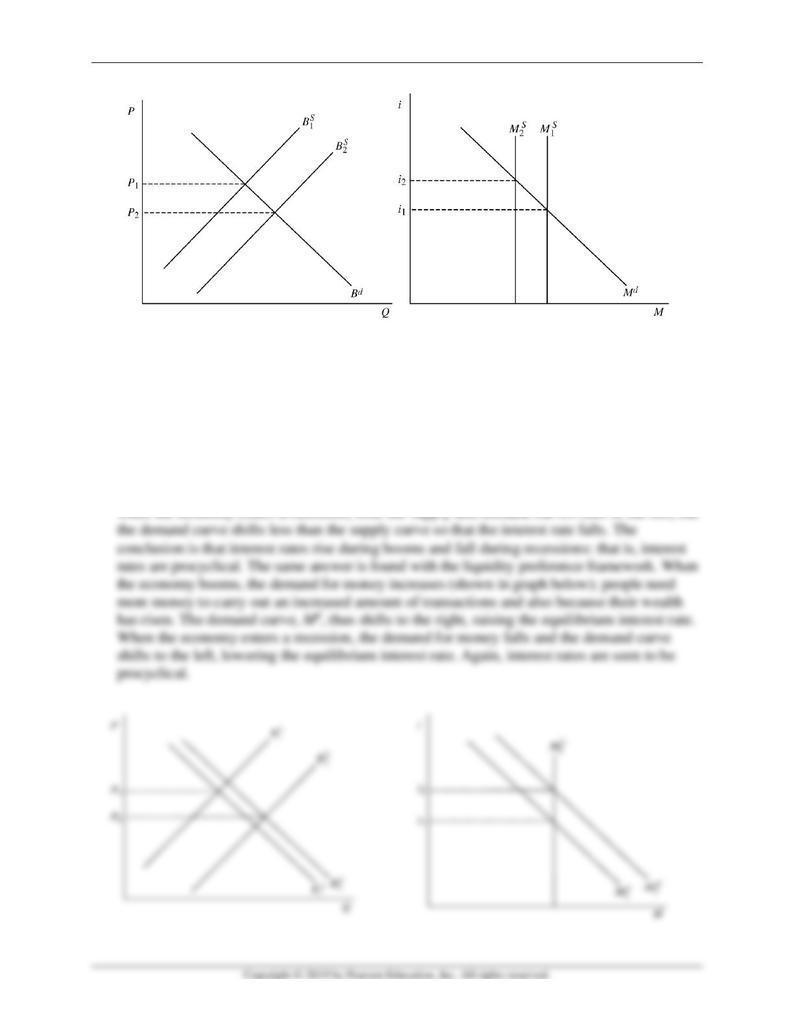
Mishkin • Instructor’s Manual for The Economics of Money, Banking, and Financial Markets, Twelfth Edition 86
22. Using both the liquidity preference framework and the supply and demand for bonds
framework, show why interest rates are procyclical (rising when the economy is expanding
and falling during recessions).
In the bond framework, when the economy booms, the demand for bonds increases. The
public’s income and wealth rises while the supply of bonds also increases, because firms
have more attractive investment opportunities. Both the supply and demand curves (Bd and
Bs) shift to the right (shown in graph below), but as is indicated in the text, the demand curve
probably shifts less than the supply curve so the equilibrium interest rate rises. Similarly,
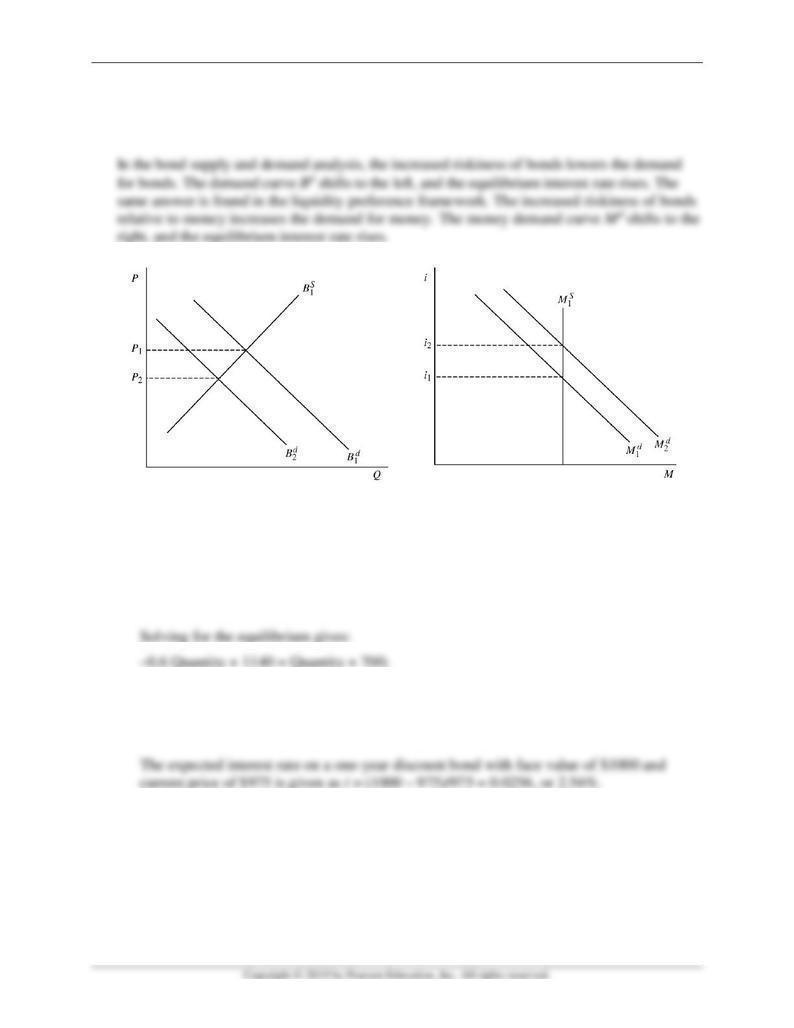
Mishkin • Instructor’s Manual for The Economics of Money, Banking, and Financial Markets, Twelfth Edition 87
23. Using both the supply and demand for bonds and liquidity preference frameworks, show how
interest rates are affected when the riskiness of bonds rises. Are the results the same in the two
frameworks?
24. The demand curve and supply curve for one-year discount bonds with a face value of $1,000
are represented by the following equations:
Bd: Price = − 0.6 * Quantity + 1140
Bs: Price = Quantity + 700
a. What is the expected equilibrium price and quantity of bonds in this market?
1.6 Quantity = 440; or Quantity = 275.
Using the bond supply equation Price = 275 + 700 = 975
b. Given your answer to part (a), what is the expected interest rate in this market?
25. The demand curve and supply curve for one-year discount bonds with a face value of $1,000
are represented by the following equations
Bd: Price = − 0.6 * Quantity + 1140
Bs: Price = Quantity + 700
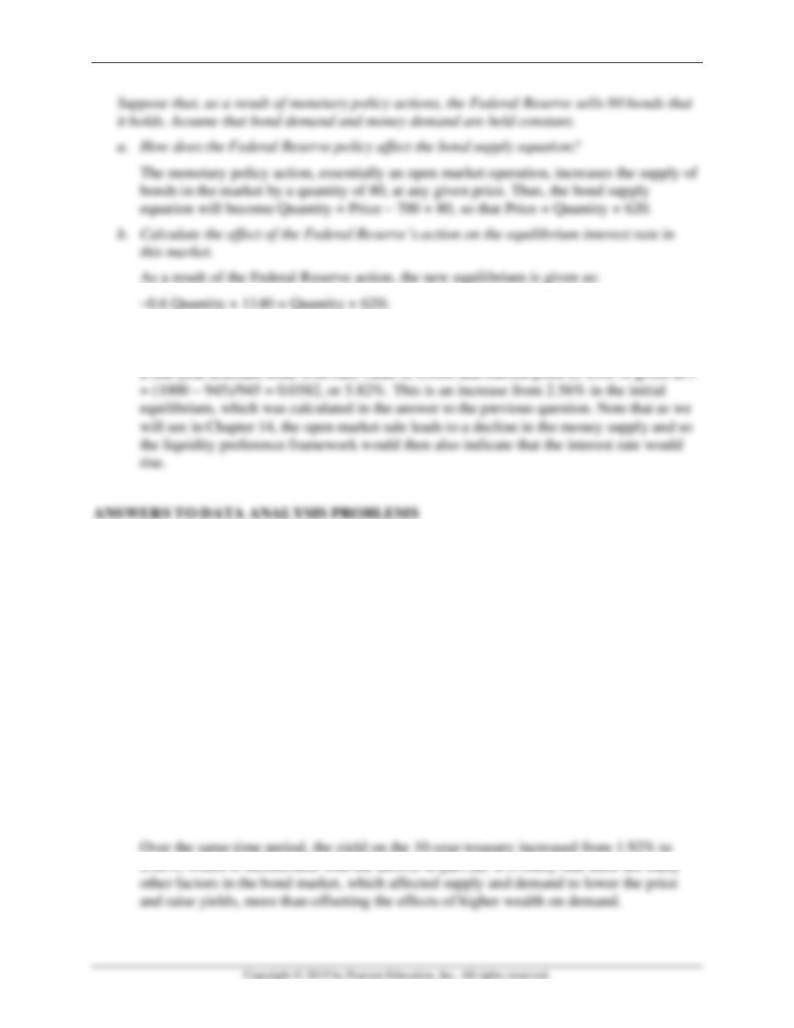
Mishkin • Instructor’s Manual for The Economics of Money, Banking, and Financial Markets, Twelfth Edition 88
1.6 Quantity = 520; or Quantity = 325.
Using the bond supply curve, Price = 325 + 620 = 945. Thus, the expected interest rate on
1. Go to the St. Louis Federal Reserve FRED database and find data on net worth of
households and nonprofits (HNONWRQ027S) and the 10-year U.S. treasury bond (GS10).
For the net worth indicator, adjust the units setting to “Percent Change from Year Ago,” and
for the 10-year bond, adjust the frequency setting to “Quarterly.”
a. What is the percent change in net worth over the most recent year of data available? All
else being equal, what do you expect should happen to the price and yield on the 10-year
treasury bond? Why?
In 2017:Q1, net worth increased by 8.3% from 2016:Q1. Holding everything else
constant, this would be representative of an increase in wealth of bond investors. Thus,
bond demand should rise, leading to an increase in the price of bonds, and a decline in the
yield on bonds.
b. What is the change in yield on the 10-year treasury bond over the last year of data
available? Is this result consistent with your answer to part (a)? Briefly explain.

Mishkin • Instructor’s Manual for The Economics of Money, Banking, and Financial Markets, Twelfth Edition 89
2. Go to the St. Louis Federal Reserve FRED database, and find data on the M1 money supply
(M1SL) and the 10-year U.S. treasury bond rate. For the M1 money supply indicator, adjust
the units setting to “Percent Change from Year Ago,” and for the 10-year treasury bond,
adjust the frequency setting to “Quarterly.” Download the data into a spreadsheet.
a. Create a scatter plot, with money growth on the horizontal axis and the 10-year treasury
rate on the vertical axis, from 2000:Q1 to the most recent quarter of data available. On
the scatter plot, graph a fitted (regression) line of the data (there are several ways to do
this; however, one particular chart layout has this option built in). Based on the fitted
line, are the data consistent with the liquidity effect? Briefly explain.
See scatterplot below. Yes, the liquidity effect is clearly demonstrated. As money growth
increases, the interest rate on the 10-year treasury decreases; based on the regression
results, a one percentage point increase in money growth reduces the 10-year rate by 16.6
basis points.
b. Repeat part (a), but this time compare the contemporaneous money growth rate with the
interest rate four quarters later. For example, create a scatter plot comparing money
growth from 2000:Q1 with the interest rate from 2001:Q1, and so on, up to the most
recent pairwise data available. Compare your results to those obtained in part (a), and
interpret the liquidity effect as it relates to the income, price-level, and expected-inflation
effects.
See scatterplot below. The effects of money growth one year later still seem to indicate
money growth lowers the interest rate on net. However, since the regression coefficient is
smaller, the net effect after one year is less than the initial (liquidity) effect. That is, if the
liquidity effect lowered the 10-year yield by 16.6 basis points on average in a given
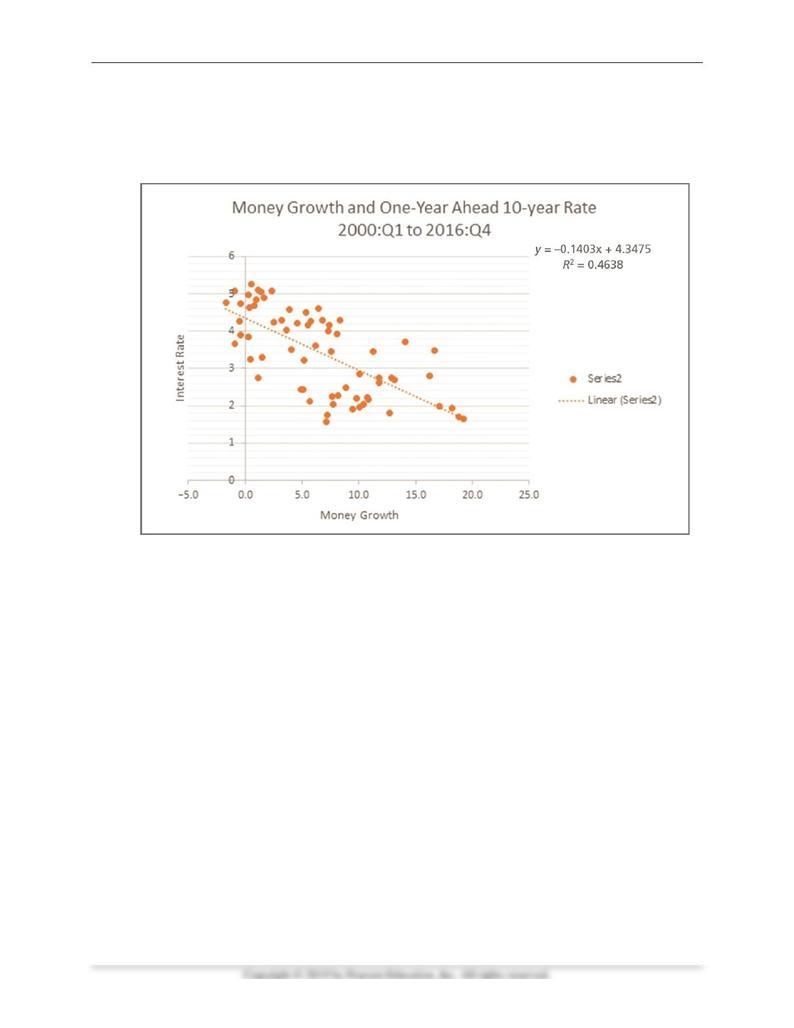
Mishkin • Instructor’s Manual for The Economics of Money, Banking, and Financial Markets, Twelfth Edition 90
quarter as in (a) above, but it was lowered by only 14 basis points one year later, then the
feedback effects from the income, price-level, and expected inflation effect must be
helping to offset some of the liquidity effect (on the order of around 2.6 basis points)
after one year, on average.
c. Repeat part (a) again, except this time compare the contemporaneous money growth rate
with the interest rate eight quarters later. For example, create a scatter plot comparing
money growth from 2000:Q1 with the interest rate from 2002:Q1, and so on, up to the
most recent pairwise data available. Assuming the liquidity and other effects are fully
incorporated into the bond market after two years, what do your results imply about the
overall effect of money growth on interest rates?
See scatterplot below. Assuming all the effects run its course after two years, the data
after two years suggest that a one percentage point increase in money growth, on average,
will leave the 10-year yield lower by about 7 basis points. Thus, putting the liquidity,
income, price-level, and expected inflation effects together, on net indicates that higher
money growth should leave nominal interest rates lower overall.
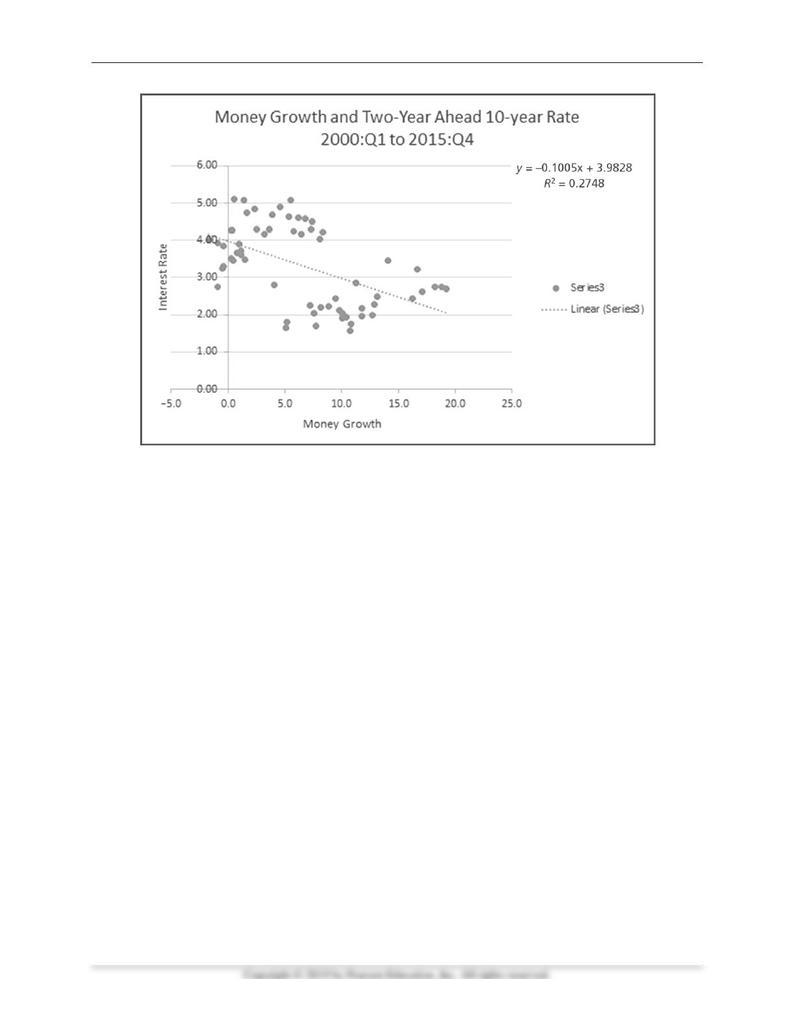
Mishkin • Instructor’s Manual for The Economics of Money, Banking, and Financial Markets, Twelfth Edition 91
d. Based on your answers to parts (a) through (c), how do the actual data on money growth
and interest rates compare to the three scenarios presented in Figure 11 of this chapter?
The data interpretation illustrates a story consistent with panel (a) in the figure, where the
liquidity effect is dominant, and over time the income, price-level, and expected-inflation
effects slowly offset some of the downward effects of expansionary policy on the
nominal interest rate, but leave nominal interest rates lower on net overall.

Mishkin • Instructor’s Manual for The Economics of Money, Banking, and Financial Markets, Twelfth Edition 92
Chapter 6
1. If junk bonds are “junk,” then why do investors buy them?
2. Which should have the higher risk premium on its interest rates, a corporate bond with a
Moody’s Baa rating or a corporate bond with a C rating? Why?
3. Do you think that a U.S. Treasury bill will have a risk premium that is higher than, lower
than, or the same as that of a similar security (in terms of maturity and liquidity) issued by
the government of Colombia?
4. In the fall of 2008, AIG, the largest insurance company in the world at the time, was at risk
of defaulting due to the severity of the global financial crisis. As a result, the U.S.
government stepped in to support AIG with large capital injections and an ownership stake.
How would this affect, if at all, the yield and risk premium on AIG corporate debt?
5. Risk premiums on corporate bonds are usually anticyclical; that is, they decrease during
business cycle expansions and increase during recessions. Why is this so?
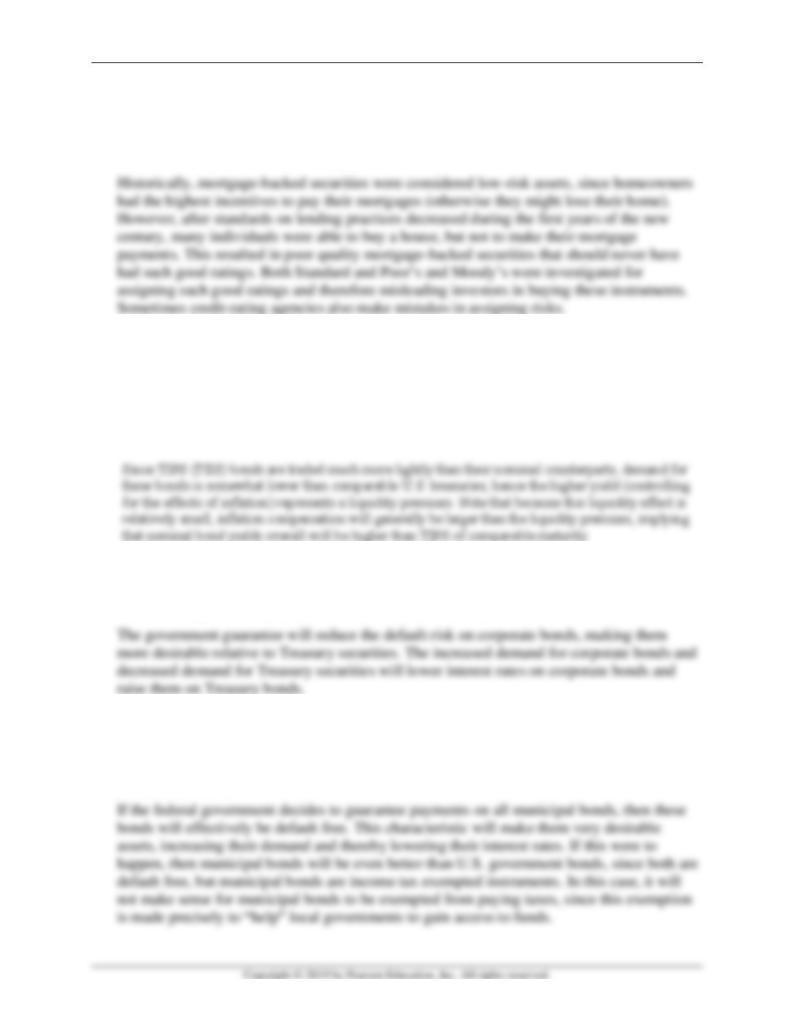
Mishkin • Instructor’s Manual for The Economics of Money, Banking, and Financial Markets, Twelfth Edition 93
6. Just before the collapse of the subprime mortgage market in 2007, the most important credit-
rating agencies rated mortgage-backed securities with Aaa and AAA ratings. Explain how it
was possible that a few months into 2008, the same securities had the lowest possible ratings.
Should we always trust credit-rating agencies?
7. The U.S. Treasury offers some of its debt as Treasury Inflation Indexed Securities, or TIIS
(more commonly known as TIPS, an acronym for Treasury Inflation Protected Securities), in
which the price of bonds is adjusted for inflation over the life of the debt instrument. TIPS
bonds are traded on a much smaller scale than nominal U.S. Treasury bonds of equivalent
maturity. What can you conclude about the liquidity premiums of TIPS versus nominal U.S.
bonds?
8. Predict what will happen to interest rates on a corporation’s bonds if the federal government
guarantees today that it will pay creditors if the corporation goes bankrupt in the future.
What will happen to the interest rates on Treasury securities?
9. Predict what would happen to the risk premiums of municipal bonds if the federal
government guarantees today that it will pay creditors if municipal governments default on
their payments. Do you think that it will then make sense for municipal bonds to be exempt
from income taxes?
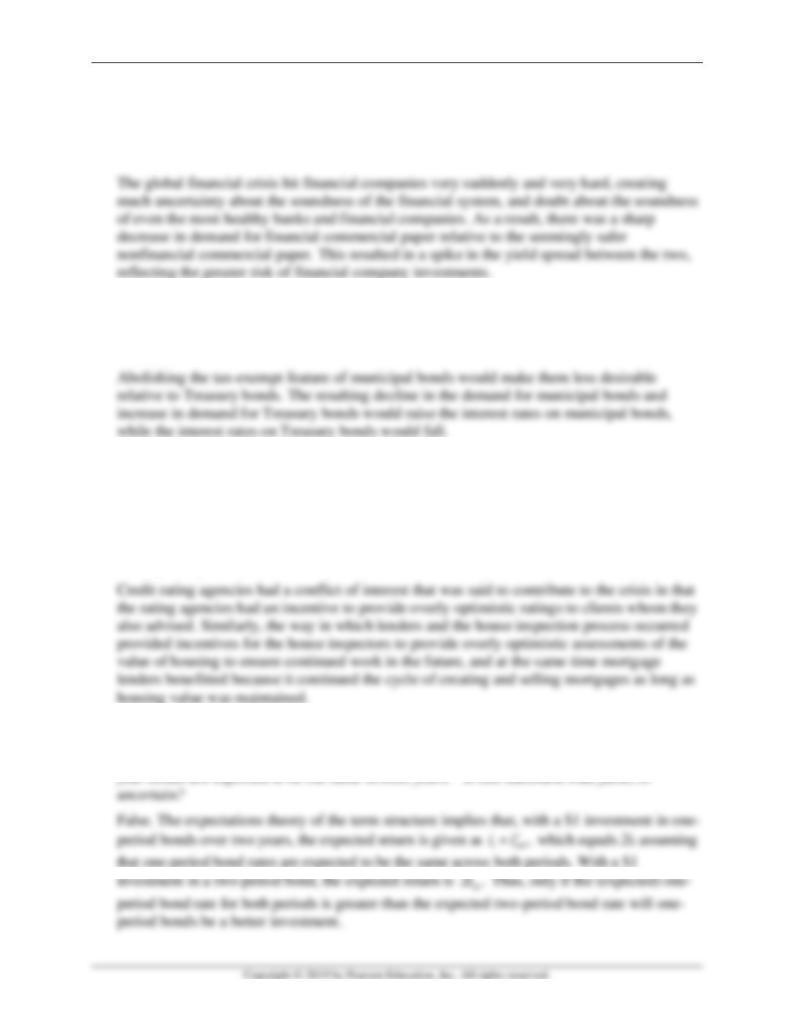
Mishkin • Instructor’s Manual for The Economics of Money, Banking, and Financial Markets, Twelfth Edition 94
10. During 2008, the difference in yield (the yield spread) between three-month AA-rated
financial commercial paper and three-month AA-rated nonfinancial commercial paper
steadily increased from its usual level of close to zero, spiking to over a full percentage point
at its peak in October 2008. What explains this sudden increase?
11. If the income tax exemption on municipal bonds were abolished, what would happen to the
interest rates on these bonds? What effect would the change have on interest rates on U.S.
Treasury securities?
12. Prior to 2008, mortgage lenders required a house inspection to assess a home’s value, and
often used the same one or two inspection companies in the same geographical market.
Following the collapse of the housing market in 2008, mortgage lenders required a house
inspection, but this inspection was arranged through a third party. How does the pre-2008
scenario illustrate a conflict of interest similar to the role that credit-rating agencies played
in the global financial crisis?
13. “According to the expectations theory of the term structure, it is better to invest in one-year
bonds, reinvested over two years, than to invest in a two-year bond if interest rates on one-
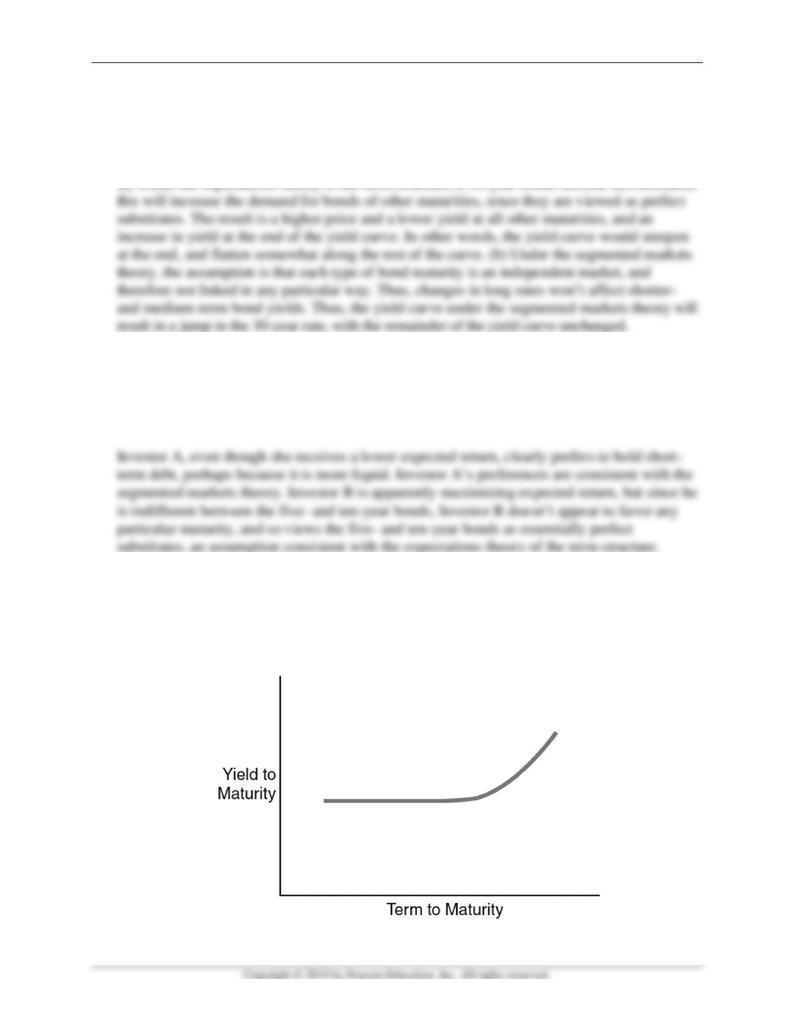
Mishkin • Instructor’s Manual for The Economics of Money, Banking, and Financial Markets, Twelfth Edition 95
14. If bond investors decide that 30-year bonds are no longer as desirable an investment as they
were previously, predict what will happen to the yield curve, assuming (a) the expectations
theory of the term structure holds and (b) the segmented markets theory of the term structure
holds.
15. Suppose the interest rates on one-, five-, and ten-year US Treasury bonds are currently 3%,
6%, and 6%, respectively. Investor A chooses to hold only one-year bonds, and Investor B is
indifferent with regard to holding five- and ten-year bonds. How can you explain the
behavior of Investors A and B?
16. If a yield curve looks like the one shown in the figure below, what is the market predicting
about the movement of future short-term interest rates? What might the yield curve indicate
about the market’s predictions for the inflation rate in the future?

Mishkin • Instructor’s Manual for The Economics of Money, Banking, and Financial Markets, Twelfth Edition 96
17. If a yield curve looks like the one shown in the figure below, what is the market predicting
about the movement of future short-term interest rates? What might the yield curve indicate
about the market’s predictions for the inflation rate in the future?
18. If yield curves, on average, were flat, what would this say about the liquidity (term)
premiums in the term structure? Would you be more or less willing to accept the expectations
theory?
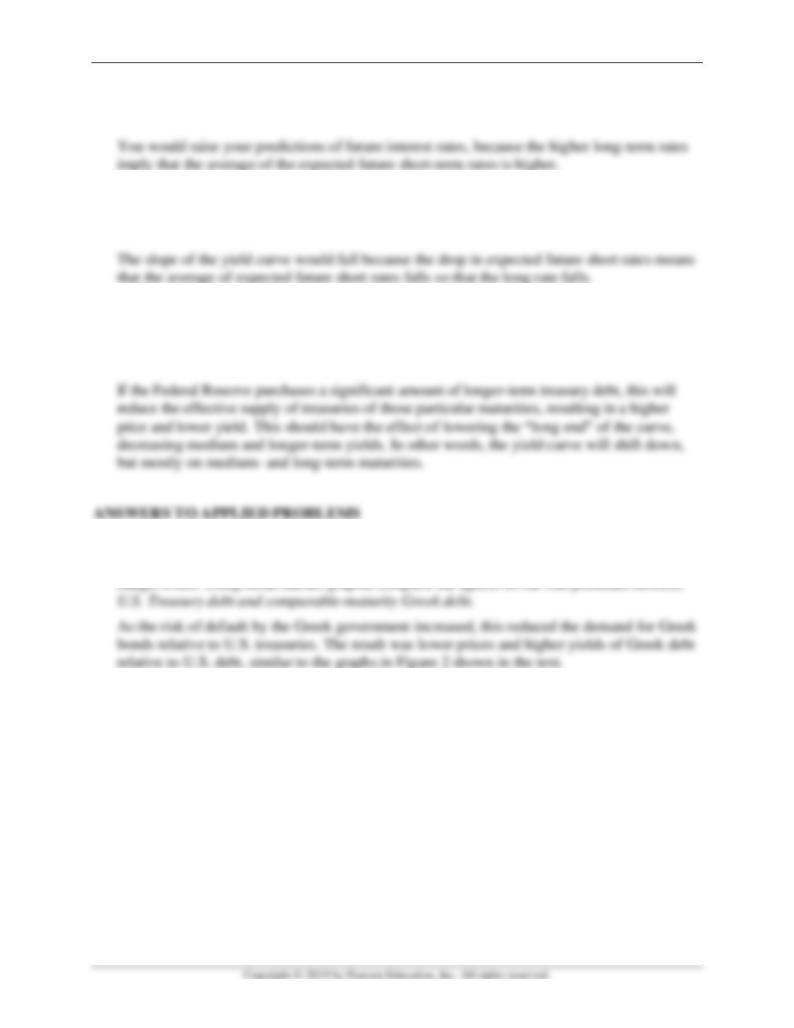
Mishkin • Instructor’s Manual for The Economics of Money, Banking, and Financial Markets, Twelfth Edition 97
19. If the yield curve suddenly became steeper, how would you revise your predictions of interest
rates in the future?
20. If expectations of future short-term interest rates suddenly fell, what would happen to the
slope of the yield curve?
21. Following a policy meeting on March 19, 2009, the Federal Reserve made an announcement
that it would purchase up to $300 billion of longer-term Treasury securities over the following
six months. What effect might this policy have on the yield curve?
22. In 2010 and 2011, the government of Greece risked defaulting on its debt due to a severe
23. Assuming the expectations theory is the correct theory of the term structure, calculate the
interest rates in the term structure for maturities of one to five years, and plot the resulting
yield curves for the following paths of one-year interest rates over the plot the resulting
yield curves for the following paths of one-year interest rates over the next five years:
a. 5%, 6%, 7%, 6%, 5%
b. 5%, 4%, 3%, 4%, 5%
How would your yield curves change if people preferred shorter-term bonds over longer-
term bonds?
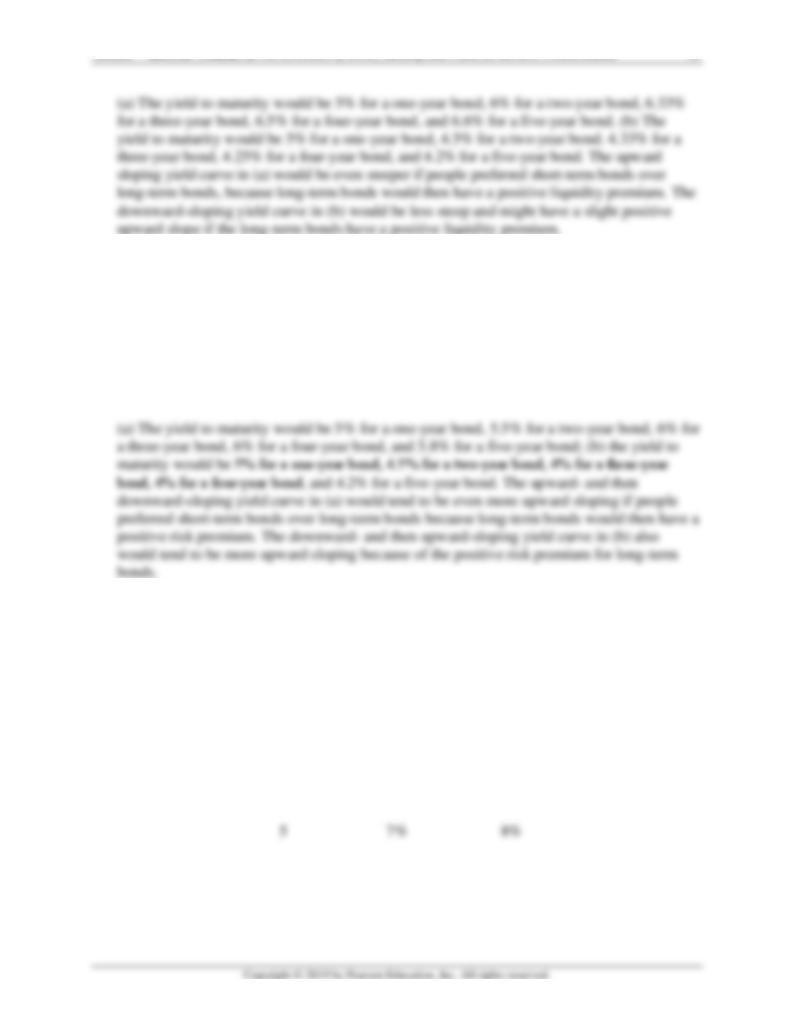
Mishkin • Instructor’s Manual for The Economics of Money, Banking, and Financial Markets, Twelfth Edition 98
24. Assuming the expectations theory is the correct theory of the term structure, calculate the
interest rates in the term structure for maturities of one to five years, and plot the resulting
yield curves for the following paths of one-year interest rates over the next five years:
a. 5%, 6%, 7%, 6%, 5%
b. 5%, 4%, 3%, 4%, 5%
How would your yield curves change if people preferred shorter-term bonds over longer-
term bonds?
25. The table below shows current and expected future one-year interest rates, as well as current
interest rates on multiyear bonds. Use the table to calculate the liquidity premium for each
multiyear bond.
Year
One-Year
Bond Rate
Multiyear
Bond Rate
1
2%
2%
2
3%
3%
3
4%
5%
4
6%
6%
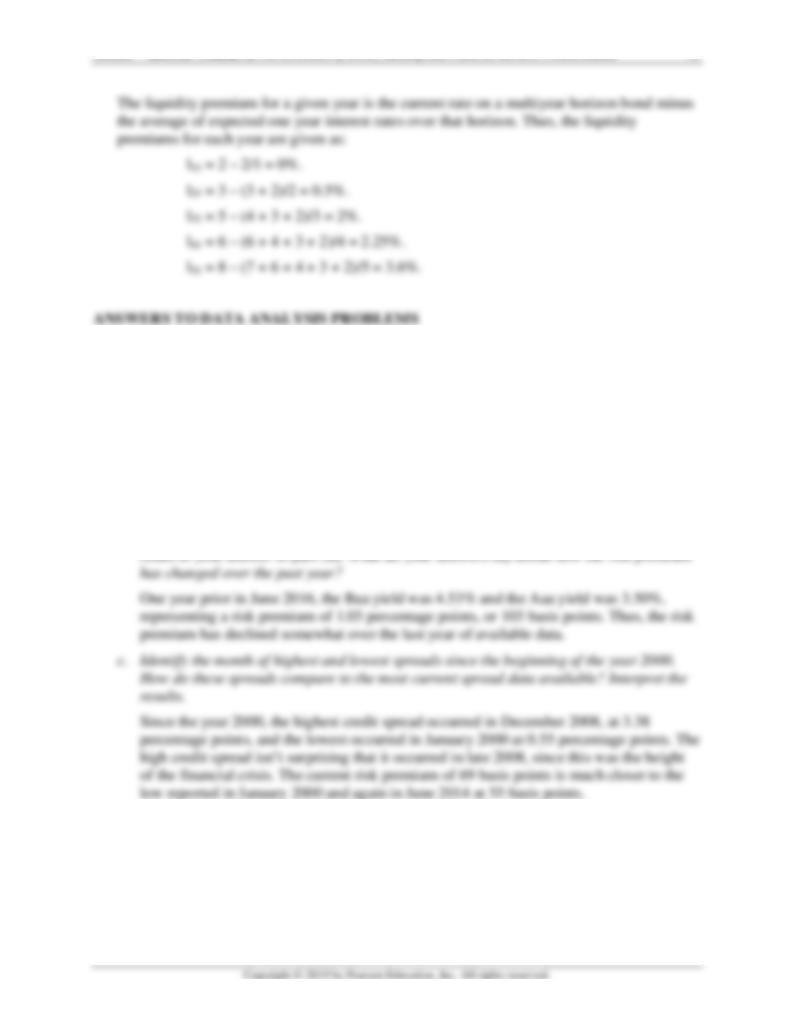
Mishkin • Instructor’s Manual for The Economics of Money, Banking, and Financial Markets, Twelfth Edition 99
1. Go to the St. Louis Federal Reserve FRED database and find data on Moody’s Aaa
corporate bond yield (AAA) and Moody’s Baa corporate bond yield (BAA). Download the
data into a spreadsheet.
a. Calculate the spread (difference) between the Baa and Aaa corporate bond yields for the
most recent month of data available. What does this difference represent?
The Baa yield for June 2017 was 4.37%, and the Aaa yield that month was 3.68%. Thus,
the credit spread was 0.69 percentage points, or 69 basis points. This difference
represents the risk premium.
b. Calculate the spread again, for the same month but one year prior, and compare the
2. Go to the St. Louis Federal Reserve FRED database, and find daily yield data on the
following U.S. treasuries securities: one-month (DGS1MO), three-month (DGS3MO), six-
month (DGS6MO), one-year (DGS1), two-year (DGS2), three-year (DGS3), five-year
(DGS5), seven-year (DGS7), 10-year (DGS10), 20-year (DGS20), and 30-year (DGS30).
Download the last full year of data available into a spreadsheet.
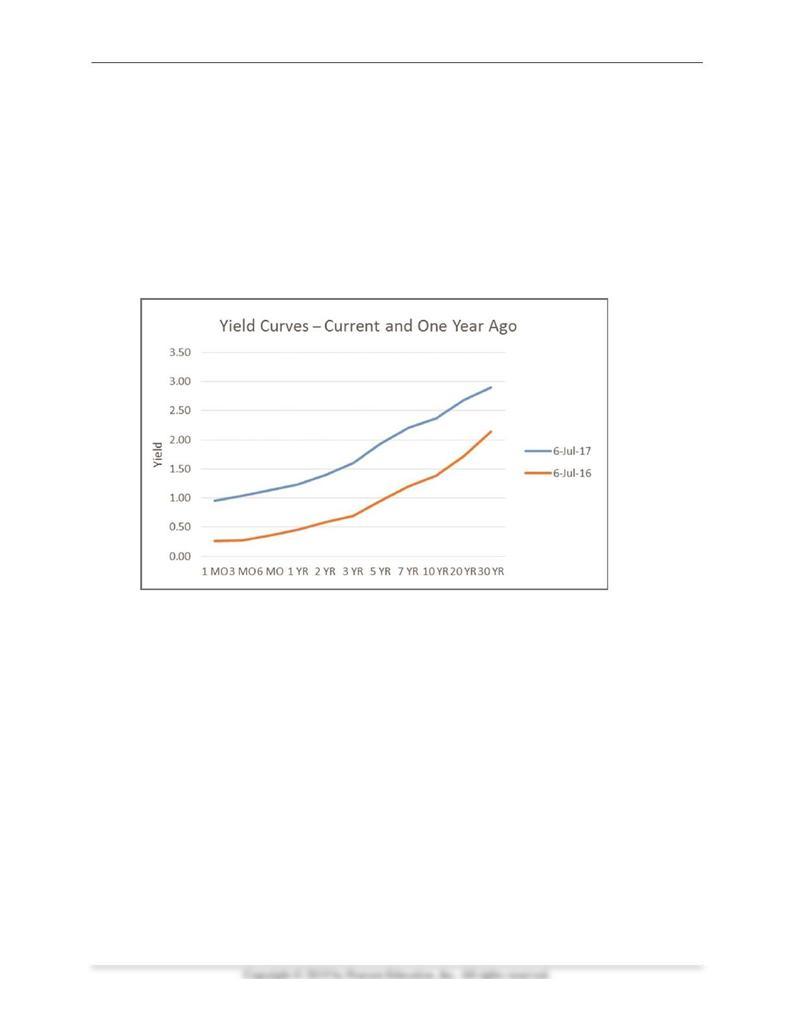
Mishkin • Instructor’s Manual for The Economics of Money, Banking, and Financial Markets, Twelfth Edition 100
a. Construct a yield curve by creating a line graph for the most recent day of data
available, and for the same day (or as close to the same day as possible) one year prior,
across all the maturities. How do the yield curves compare? What does the changing
slope say about potential changes in economic conditions?
The yield curve is shown below, for July 6, 2017, and July 6, 2016. In general, the more
recent yield curve is shifted up across most maturities by about 75 basis points. However,
the more recent yield curve appears to be somewhat flatter at the long end than the yield
curve from one year prior, suggesting that increases in future short-term interest rates
won’t be as significant as anticipated a year earlier with a somewhat steeper long end of
the yield curve.
b. Determine the date of the most recent Federal Open Market Committee policy statement.
Construct yield curves for both the day before the policy statement was released and the
day on which the policy statement was released. Was there any significant change in the
yield curve as a result of the policy statement? How might this be explained?
The most recent FOMC meeting policy statement occurred on June 14, 2017. The yield
curve below shows yields for the end of trading day on that day, and the day prior. There
is very little change between the two yield curves, indicating that for the most part,
markets were not surprised by monetary policy actions, and that no unexpected monetary
policy changes were announced or implemented. However, the long end of the yield
curve declined very slightly after the policy meeting, perhaps indicating a slightly dovish
stance of monetary policy as viewed by market participants based upon information from
the policy statement.
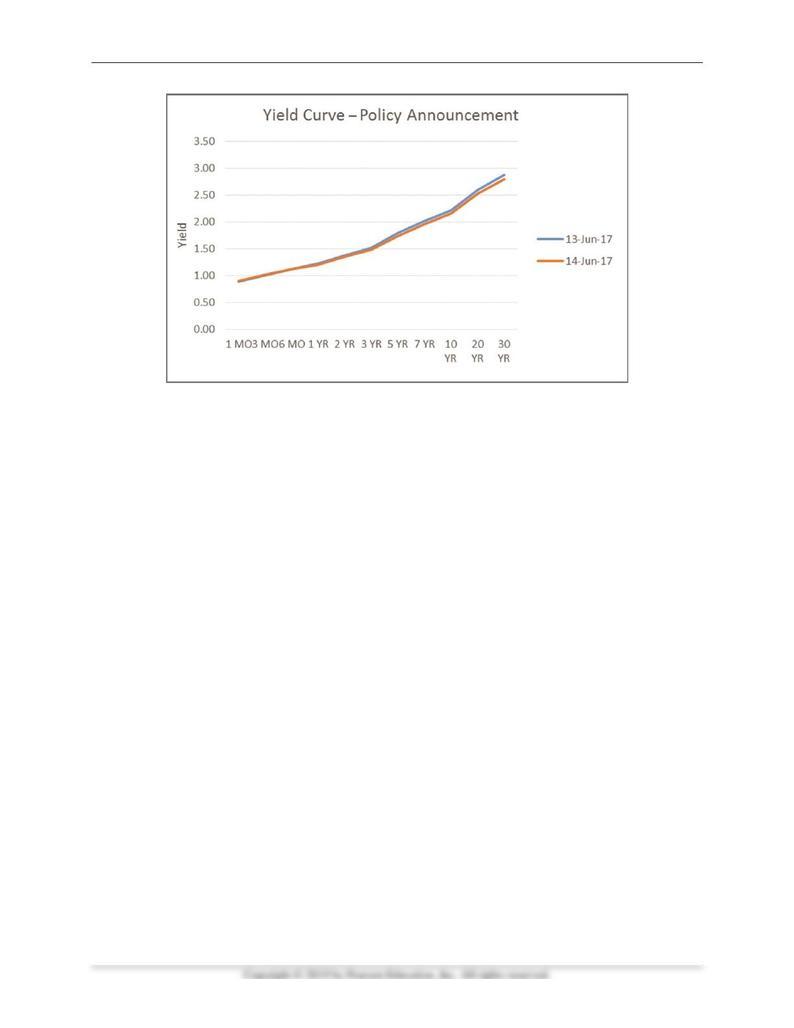
Mishkin • Instructor’s Manual for The Economics of Money, Banking, and Financial Markets, Twelfth Edition 101
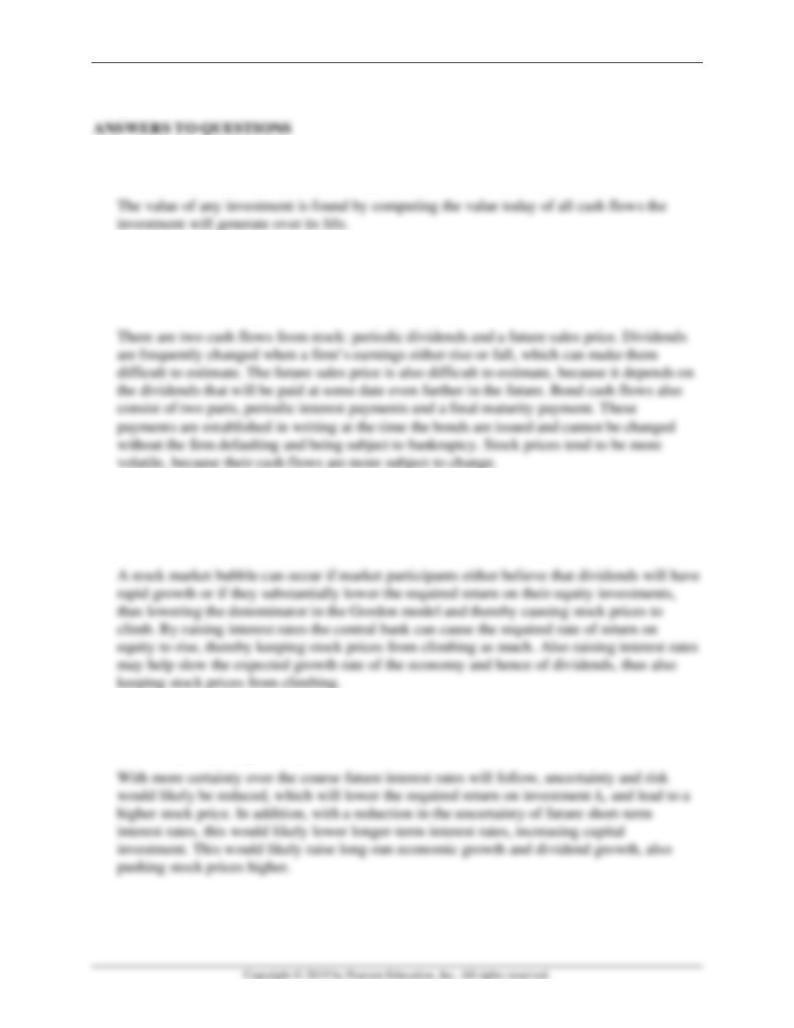
Mishkin • Instructor’s Manual for The Economics of Money, Banking, and Financial Markets, Twelfth Edition 102
Chapter 7
1. What basic principle of finance can be applied to the valuation of any investment asset?
2. What are the two main sources of cash flows for a stockholder? How reliably can these cash
flows be estimated? Compare the problem of estimating stock cash flows to the problem of
estimating bond cash flows. Which security would you predict to be more volatile?
3. Some economists think that central banks should try to prick bubbles in the stock market
before they get out of hand and cause later damage when they burst. How can monetary
policy be used to prick a market bubble? Explain using the Gordon growth model.
4. If monetary policy becomes more transparent about the future course of interest rates, how
will stock prices be affected, if at all?
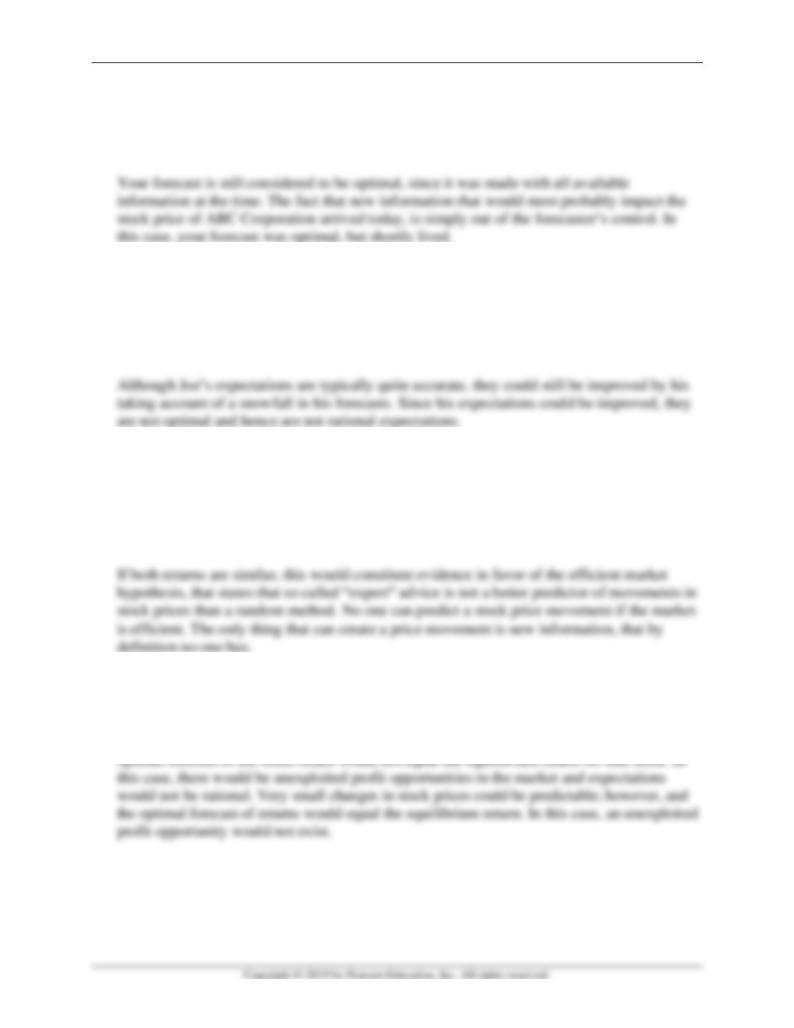
Mishkin • Instructor’s Manual for The Economics of Money, Banking, and Financial Markets, Twelfth Edition 103
5. Suppose that you are asked to forecast future stock prices of ABC Corporation, so you
proceed to collect all available information. The day you announce your forecast,
competitors of ABC Corporation announce a brand new plan to merge and reshape the
structure of the industry. Would your forecast still be considered optimal?
6. “Anytime it is snowing when Joe Commuter gets up in the morning, he misjudges how long it
will take him to drive to work. When it is not snowing, his expectations of the driving time are
perfectly accurate. Considering that it snows only once every ten years where Joe lives, Joe’s
expectations are almost always perfectly accurate.” Are Joe’s expectations rational? Why or
why not?
7. If Suppose that you decide to play a game. You buy stock by throwing a dice a few times,
using that method to select which stock to buy. After ten months you calculate the return on
your investment and the return earned by someone who followed “expert” advice during the
same period. If both returns are similar, would this constitute evidence in favor of or against
the efficient market hypothesis?
8. “If stock prices did not follow a random walk, there would be unexploited profit
opportunities in the market.” Is this statement true, false, or uncertain? Explain your answer.
True, as an approximation. If large changes in a stock price could be predicted, then the
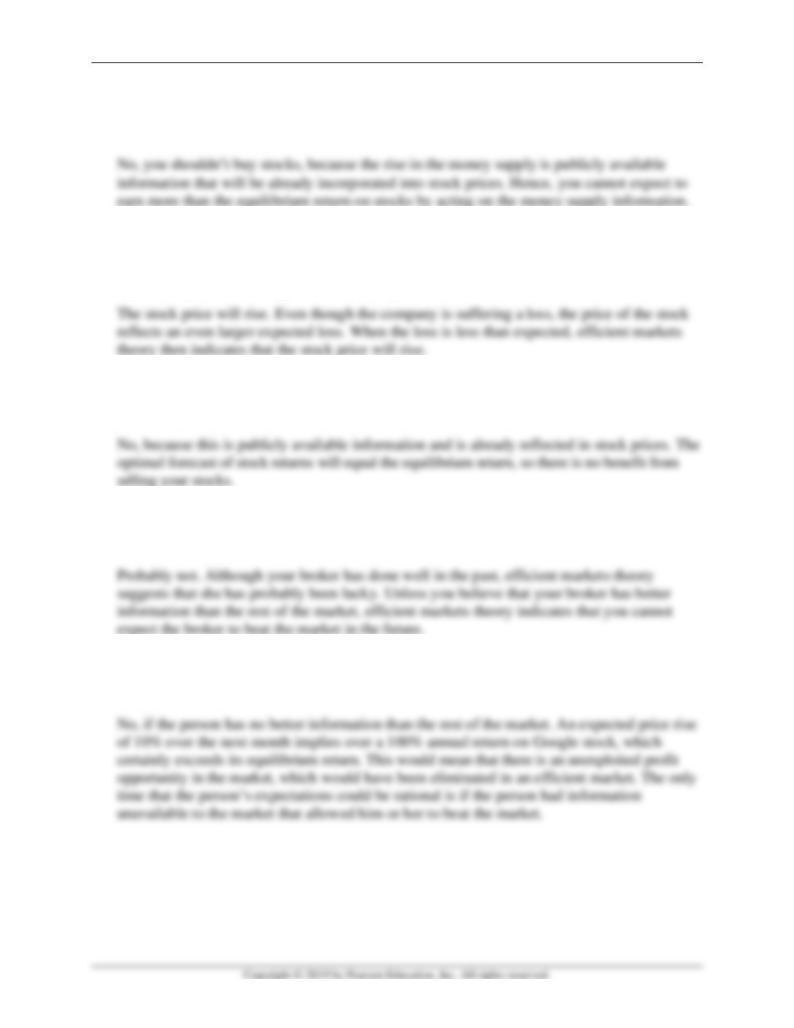
Mishkin • Instructor’s Manual for The Economics of Money, Banking, and Financial Markets, Twelfth Edition 104
9. Suppose that increases in the money supply lead to a rise in stock prices. Does this mean that
when you see that the money supply has sharply increased in the past week, you should go
out and buy stocks? Why or why not?
10. If the public expects a corporation to lose $5 per share this quarter and it actually loses $4,
which is still the largest loss in the history of the company, what does the efficient market
hypothesis predict will happen to the price of the stock when the $4 loss is announced?
11. If you read in the Wall Street Journal that the “smart money” on Wall Street expects stock
prices to fall, should you follow that lead and sell all your stocks?
12. If your broker has been right in her five previous buy and sell recommendations, should you
continue listening to her advice?
13. Can a person with rational expectations expect the price of a share of Google to rise by 10%
in the next month?
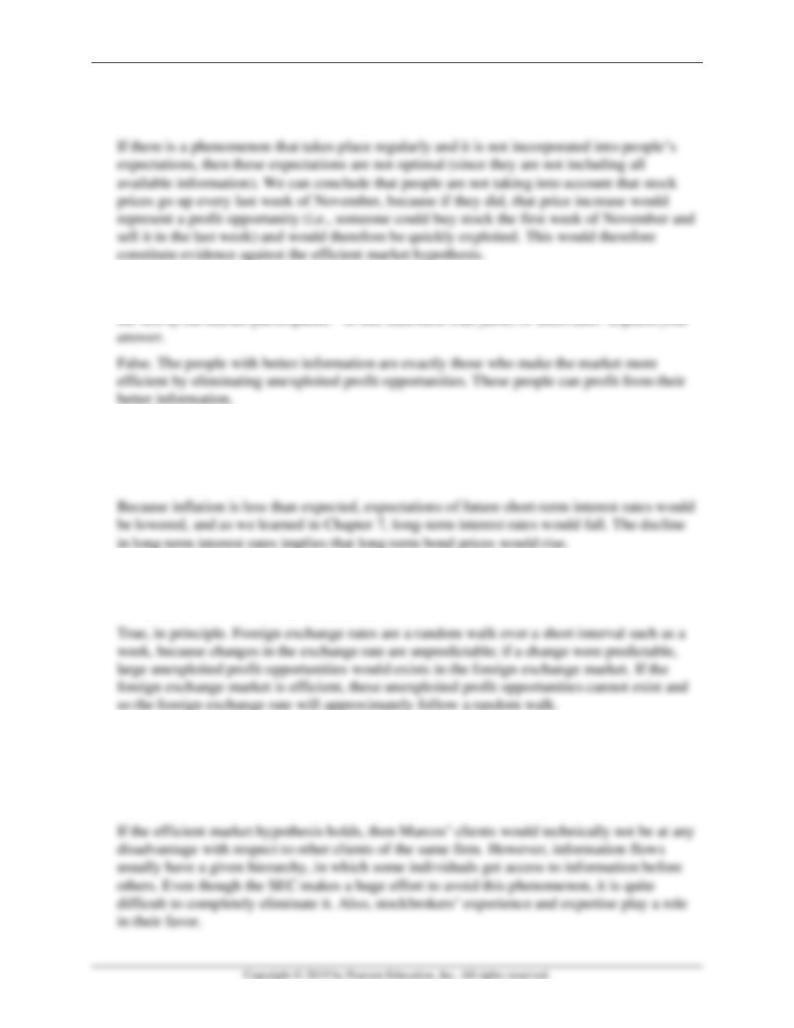
Mishkin • Instructor’s Manual for The Economics of Money, Banking, and Financial Markets, Twelfth Edition 105
14. Suppose that in every last week of November stock prices go up by an average of 3%. Would
this constitute evidence in favor of or against the efficient market hypothesis?
15. “An efficient market is one in which no one ever profits from having better information than
16. If higher money growth is associated with higher future inflation, and if announced money
growth turns out to be extremely high but is still less than the market expected, what do you
think will happen to long-term bond prices?
17. “Foreign exchange rates, like stock prices, should follow a random walk.” Is this statement
true, false, or uncertain? Explain your answer.
18. Assume that the efficient market hypothesis holds. Marcos has been recently hired by a
brokerage firm and claims that he now has access to the best market information. However,
he is the “new guy,” and no one at the firm tells him much about the business. Would you
expect Marcos’s clients to be better or worse off than the rest of the firm’s clients?
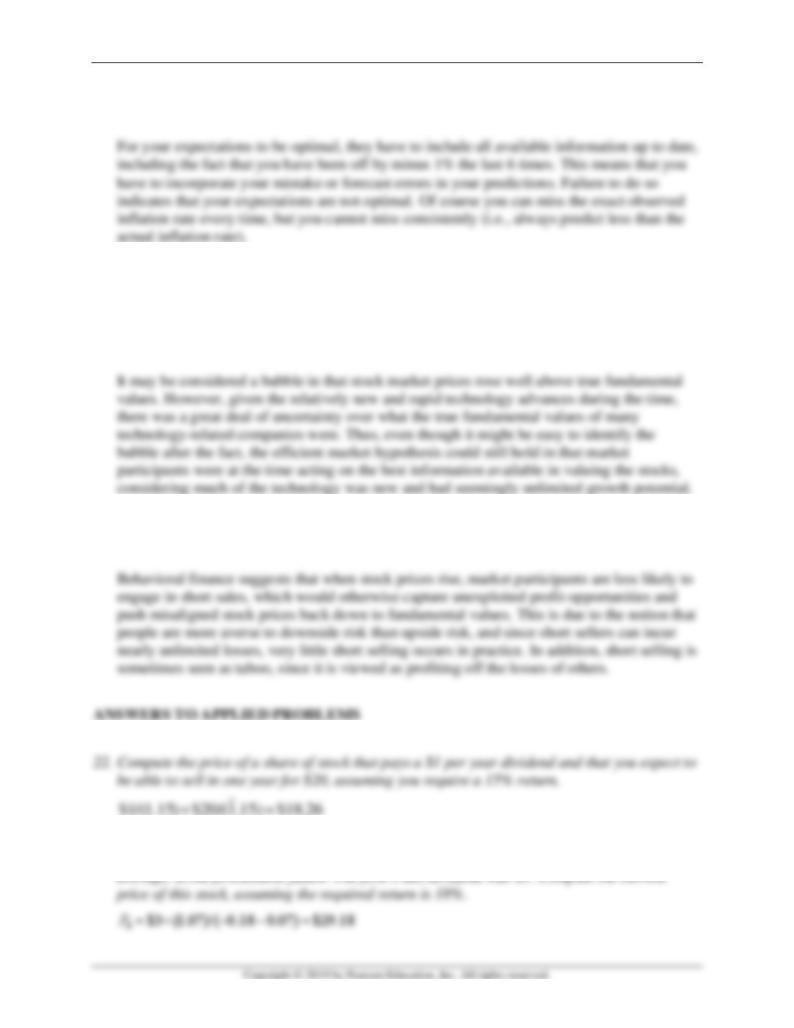
Mishkin • Instructor’s Manual for The Economics of Money, Banking, and Financial Markets, Twelfth Edition 106
19. Suppose that you work as a forecaster of future monthly inflation rates and that your last six
forecasts have been off by minus 1%. Is it likely that your expectations are optimal?
20. In the late 1990s, as information technology advanced rapidly and the Internet was widely
developed, U.S. stock markets soared, peaking in early 2001. Later that year, these markets
began to unwind and then crashed, with many commentators identifying the previous few
years as a “stock market bubble.” How might it be possible for this episode to be a bubble
but still adhere to the efficient market hypothesis?
21. Why might the efficient market hypothesis be less likely to hold when fundamentals suggest
stocks should be at a lower level?
23. After careful analysis, you have determined that a firm’s dividends should grow at 7%, on
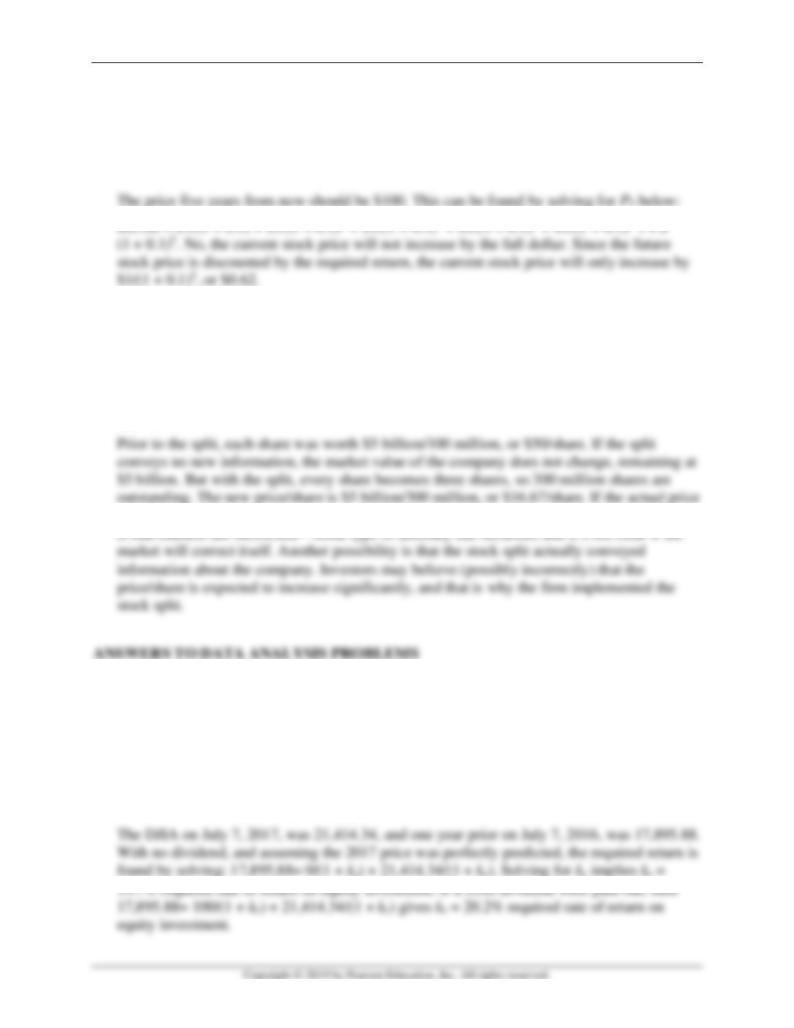
Mishkin • Instructor’s Manual for The Economics of Money, Banking, and Financial Markets, Twelfth Edition 107
24. The current price of a stock is $65.88. If dividends are expected to be $1 per share for the
next five years, and the required return is 10%, then what should the price of the stock be in
5 years when you plan to sell it? If the dividend and required return remain the same, and
the stock price is expected to increase by $1 five years from now, does the current stock price
also increase by $1? Why or why not?
25. A company has just announced a 3-for-1 stock split, effective immediately. Prior to the split,
the company had a market value of $5 billion with 100 million shares outstanding. Assuming
the split conveys no new information about the company, what are the value of the company,
the number of shares outstanding, and the price per share after the split? If the actual market
price immediately following the split is $17.00 per share, what does this tell us about market
efficiency?
is $17.00/share, the price appears too high. This can be viewed in two ways. One possibility
1. Go to the St. Louis Federal Reserve FRED database and find data on the Dow Jones
Industrial Average (DJIA). Assume the DJIA is a stock that pays no dividends. Apply the one-
period valuation model, using the data from one year prior up to the most current date
available, to determine the required return on equity investment. In other words, assume the
most recent stock price of DJIA is known one year prior. What rate of return would be
required in order to “buy” a share of DJIA? Suppose that a $100 dividend is paid out
instead. How does this change the required rate of return?
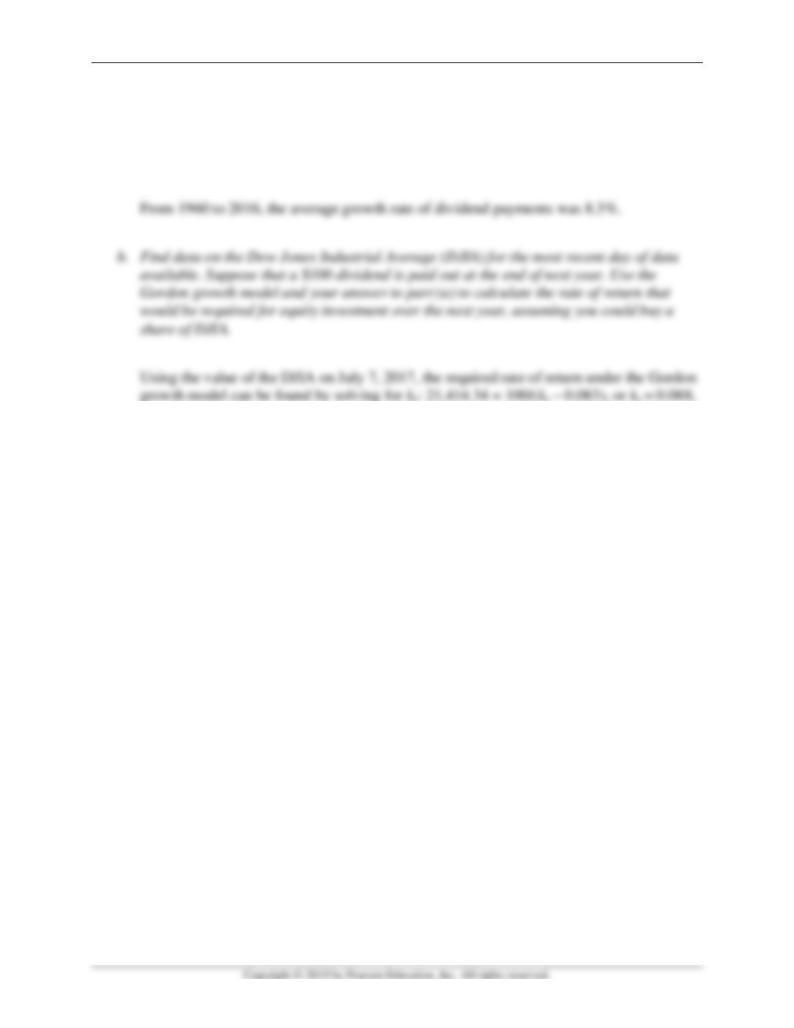
Mishkin • Instructor’s Manual for The Economics of Money, Banking, and Financial Markets, Twelfth Edition 108
2. Go to the St. Louis Federal Reserve FRED database and find data on net corporate dividend
payments (B056RC1A027NBEA). Adjust the units setting to “Percent Change from Year
Ago,” and download the data into a spreadsheet.
a. Calculate the average annual growth rate of dividends from 1960 to the most recent year
of data available.
or 8.8%.
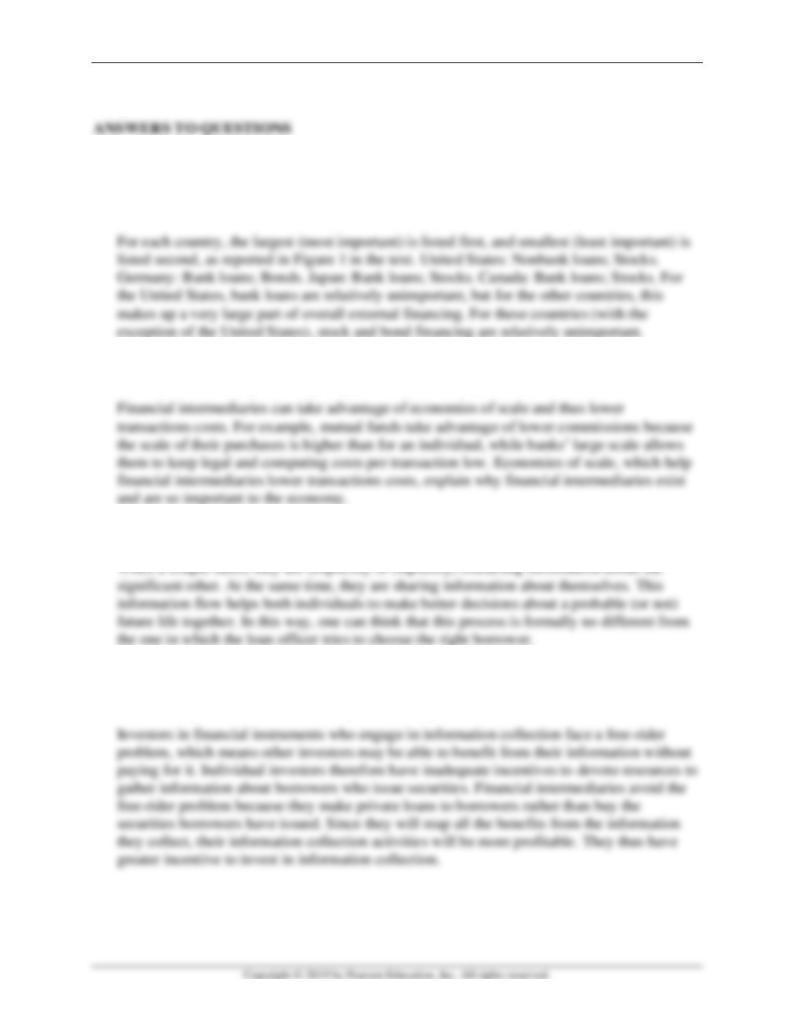
Mishkin • Instructor’s Manual for The Economics of Money, Banking, and Financial Markets, Twelfth Edition 109
Chapter 8
1. For each of the following countries, identify the single most important (largest) and least
important (smallest) source of external funding: United States; Germany; Japan; Canada.
Comment on the similarities and differences among the countries’ funding sources.
2. How can economies of scale help explain the existence of financial intermediaries?
3. Explain why dating can be considered a method to solve the adverse selection problem.
4. Why are financial intermediaries willing to engage in information collection activities when
investors in financial instruments may be unwilling to do so?
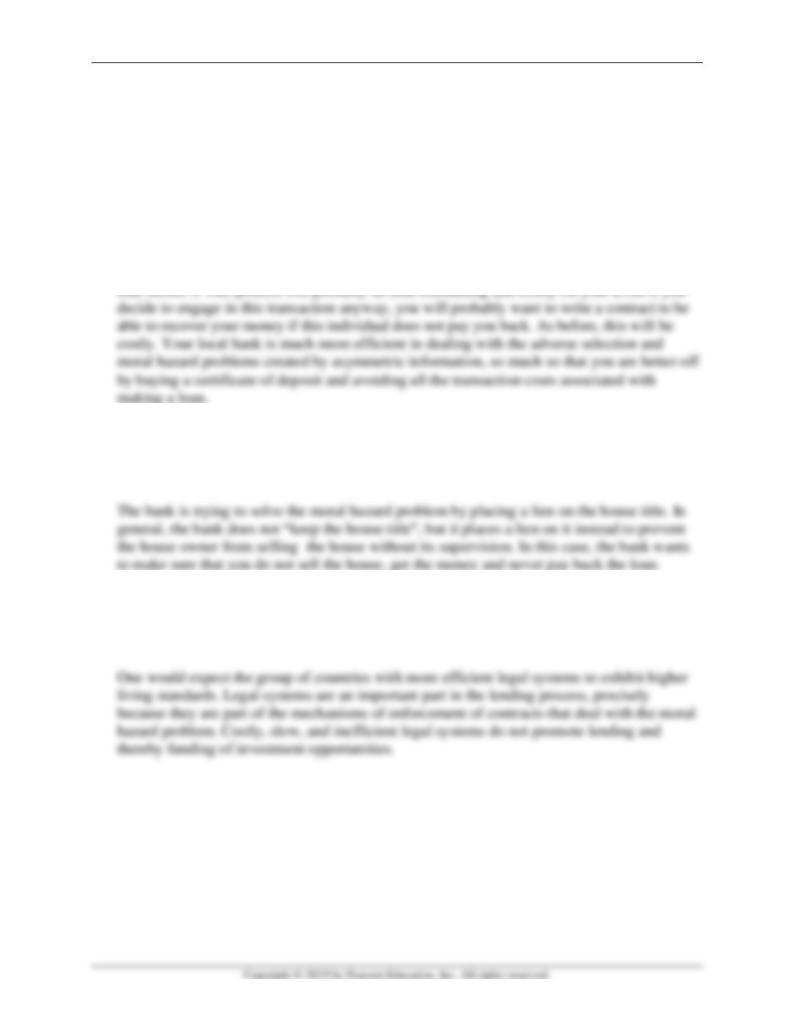
Mishkin • Instructor’s Manual for The Economics of Money, Banking, and Financial Markets, Twelfth Edition 110
5. Suppose you go to your local bank, intending to buy a certificate of deposit with your
savings. Explain why you would not offer a loan, at an interest rate that is higher than the
rate the bank pays on certificates of deposit (but lower than the rate the bank charges for car
loans), to the next individual who enters the bank and applies for a car loan.
During your visit at the bank, you will probably realize that you will receive an annual
interest rate of 1% or 2% if you buy a certificate of deposit, while an individual asking for a
car loan will be required to pay an annual interest rate of 7% or 8%. At the beginning, it
seems tempting for you to offer an interest rate of 4%, which would make both of you better
off. However, you would probably like to know that individual better, in particular, his net
worth (to assess his ability to pay you back), or his credit history (has he or she defaulted on a
6. Suppose you are applying for a mortgage loan. The loan officer tells you that if you get the
loan, the bank will keep the house title until you pay back the loan. Which problem of
asymmetric information is the bank trying to solve?
7. Suppose you have data about two groups of countries, one with efficient legal systems and
the other with slow, costly, and inefficient legal systems. Which group of countries would you
expect to exhibit higher living standards?
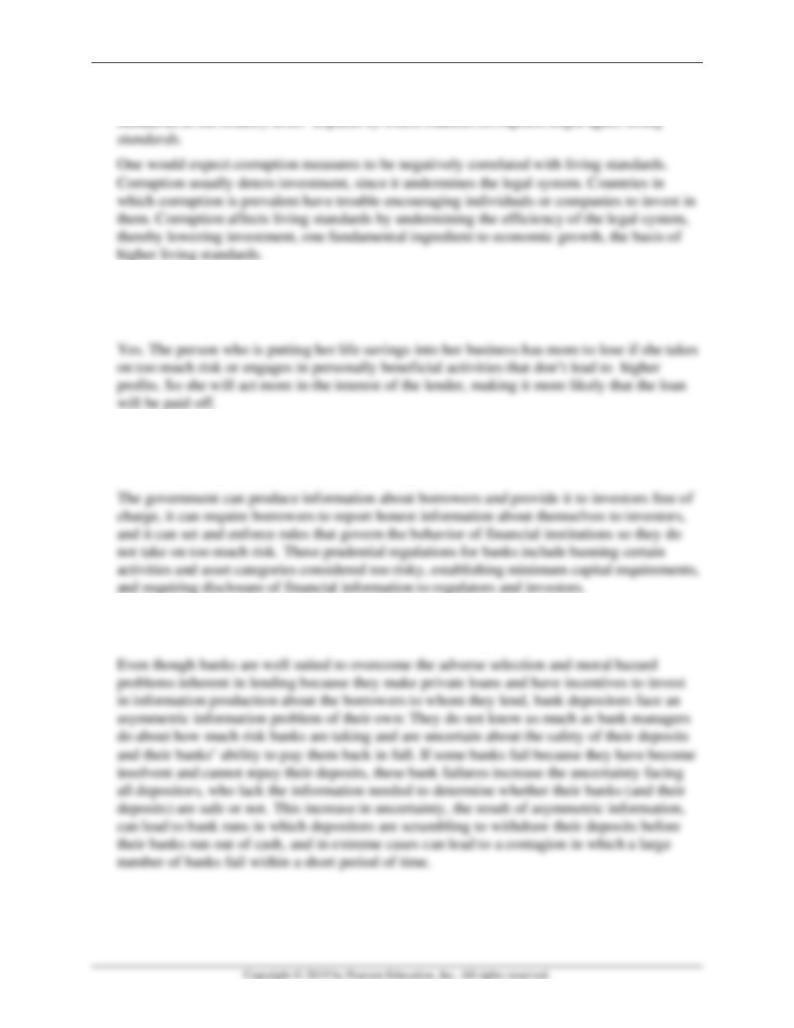
Mishkin • Instructor’s Manual for The Economics of Money, Banking, and Financial Markets, Twelfth Edition 111
8. Which relationship would you expect to exist between measures of corruption and living
9. Would you be more willing to lend to a friend if she had put all of her life savings into her
business than you would be if she had not done so? Why?
10. What steps can the government take to reduce asymmetric information problems and help the
financial system function more smoothly and efficiently?
11. How can asymmetric information problems lead to a bank panic?

Mishkin • Instructor’s Manual for The Economics of Money, Banking, and Financial Markets, Twelfth Edition 112
12. In December 2001, Argentina announced it would not honor its sovereign (government-
issued) debt. Many investors were left holding Argentinean bonds priced at a fraction of their
previous value. A few years later, Argentina announced it would pay back 25% of the face
value of its debt. Comment on the effects of information asymmetries on government bond
markets. Do you think investors are currently willing to buy bonds issued by the government
of Argentina?
13. How does the free-rider problem aggravate adverse selection and moral hazard problems in
financial markets?
14. Suppose that in a given bond market, there is currently no information that can help potential
bond buyers to distinguish between bonds. Which bond issuers have an incentive to disclose
information about their companies? Explain why.
15. How do standardized accounting principles help financial markets work more efficiently?
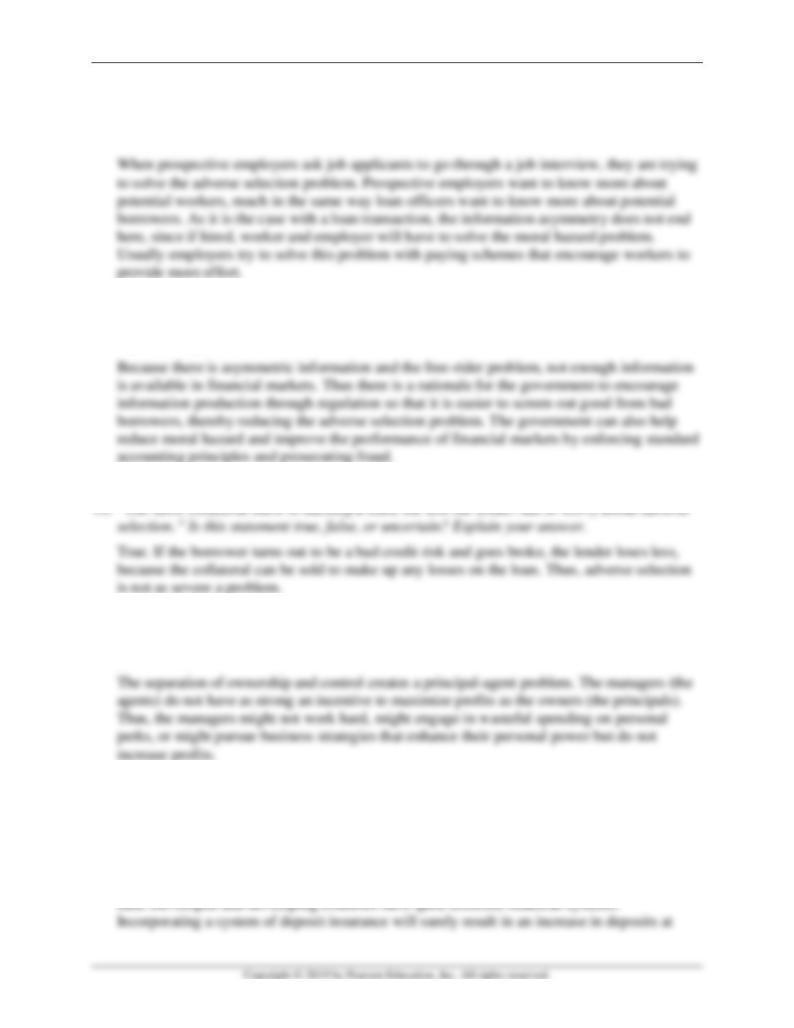
Mishkin • Instructor’s Manual for The Economics of Money, Banking, and Financial Markets, Twelfth Edition 113
16. Which problem of asymmetric information are prospective employers trying to solve when
they ask applicants to go through a job interview. Is that the end of the information
asymmetry?
17. How can the existence of asymmetric information provide a rationale for government
regulation of financial markets?
19. Explain how the separation of ownership and control in American corporations might lead to
poor management.
20. Many policymakers in developing countries have proposed the implementation of a system of
deposit insurance similar to the system that exists in the United States. Explain why this
might create more problems than solutions in the financial system of a developing country.
Although it might seem a good idea to “copy and paste” regulatory frameworks that ensure
the soundness of a financial system from one country to the other, this is usually not a good
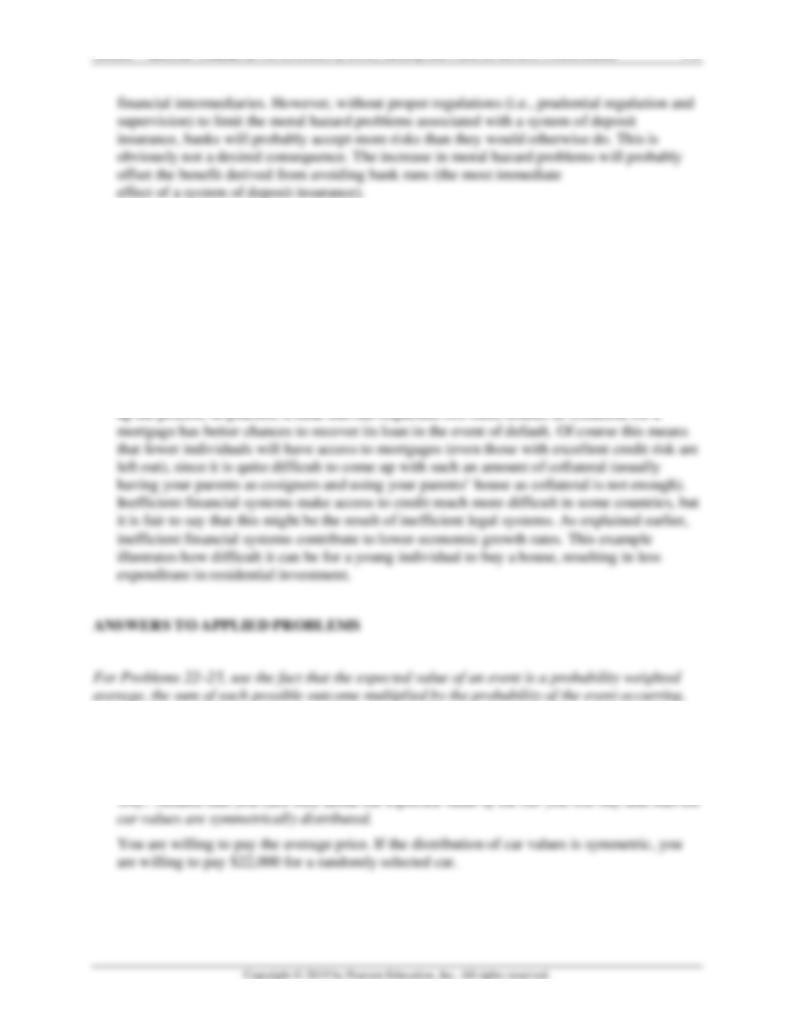
Mishkin • Instructor’s Manual for The Economics of Money, Banking, and Financial Markets, Twelfth Edition 114
21. Gustavo is a young doctor who lives in a country with a relatively inefficient legal and
financial system. When Gustavo applied for a mortgage, he found that banks usually
required collateral for up to 300% of the amount of the loan. Explain why banks might
require that much collateral in such a financial system. Comment on the consequences of
such a system for economic growth.
Financial intermediaries operating in countries with relatively weak property rights and legal
systems usually require a lot of collateral when making loans. The rationale for that behavior is
that in the event that the borrower defaults, the bank knows that it will be quite difficult and
expensive to recover its loan. Therefore, requesting extra collateral might help the bank speed
22. You are in the market for a used car and decide to visit a used car dealership. You know that
the Blue Book value of the car you are looking at is between $20,000 and $24,000. If you
believe the dealer knows as much about the car as you do, how much are you willing to pay?

Mishkin • Instructor’s Manual for The Economics of Money, Banking, and Financial Markets, Twelfth Edition 115
23. Refer to Problem 22. Now you believe the dealer knows more about the car than you do.
How much are you willing to pay? Why? How can this asymmetric information problem be
resolved in a competitive market?
24. You wish to hire Ron to manage your Dallas operations. The profits from the operations
depend partially on how hard Ron works, as follows.
Profit Probabilities
Profit = $10,000
Profit = $50,000
Lazy
60%
40%
Hard worker
20%
80%
If Ron is lazy, he will surf the Internet all day, and he views this as a zero cost opportunity.
However, Ron views working hard as a “personal cost” valued at $1,000. What fixed
0.60 10,000 P + 0.40 50,000 P = 26,000 P
If Ron works hard, his expected payment is
=
0.0625
P
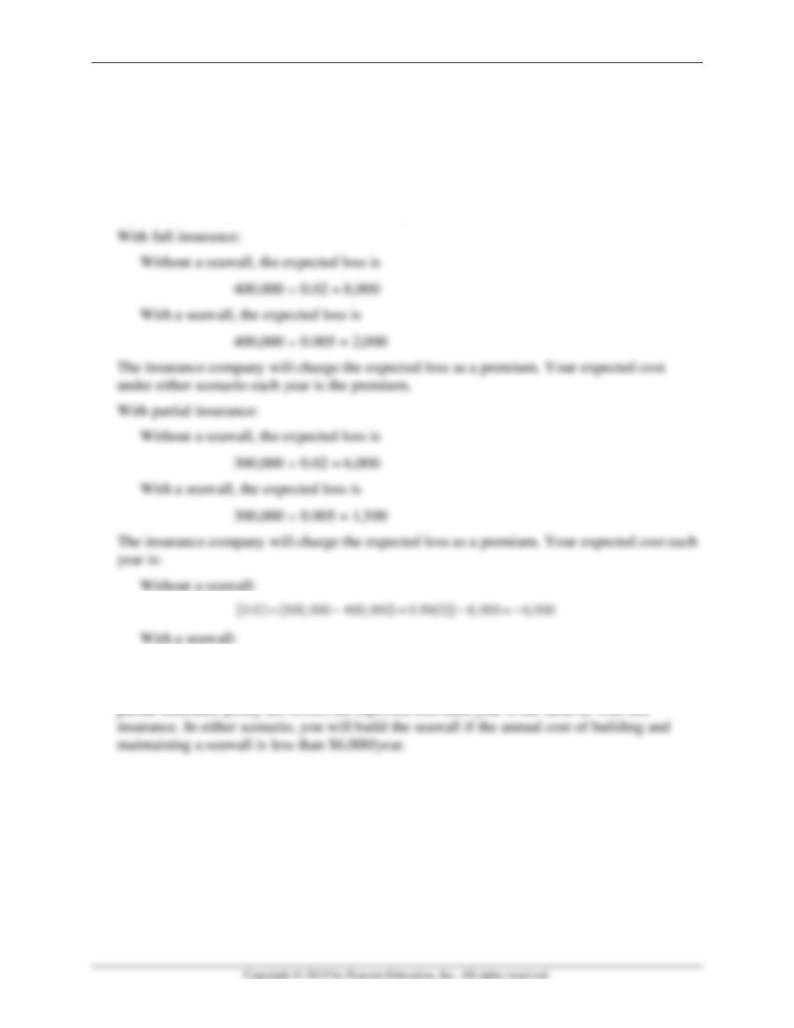
Mishkin • Instructor’s Manual for The Economics of Money, Banking, and Financial Markets, Twelfth Edition 116
25. You own a house worth $400,000 that is located on a river. If the river floods moderately, the
house will be completely destroyed. Moderate flooding happens about once every 50 years. If
you build a seawall, the river would have to flood heavily to destroy your house, and such
heavy flooding happens only about once every 200 years. What would be the annual
premium for a flood insurance policy that offers full insurance? For a policy that pays only
75% of the home value, what are your expected costs with and without a seawall? Do the
different policies provide an incentive to be safer (i.e., to build the seawall)?
[0.005 (300,000 400,000) 0.98(0)] 1,500 2,000 − + − = −
Unfortunately, neither insurance policy is better nor worse. Although the premiums under the
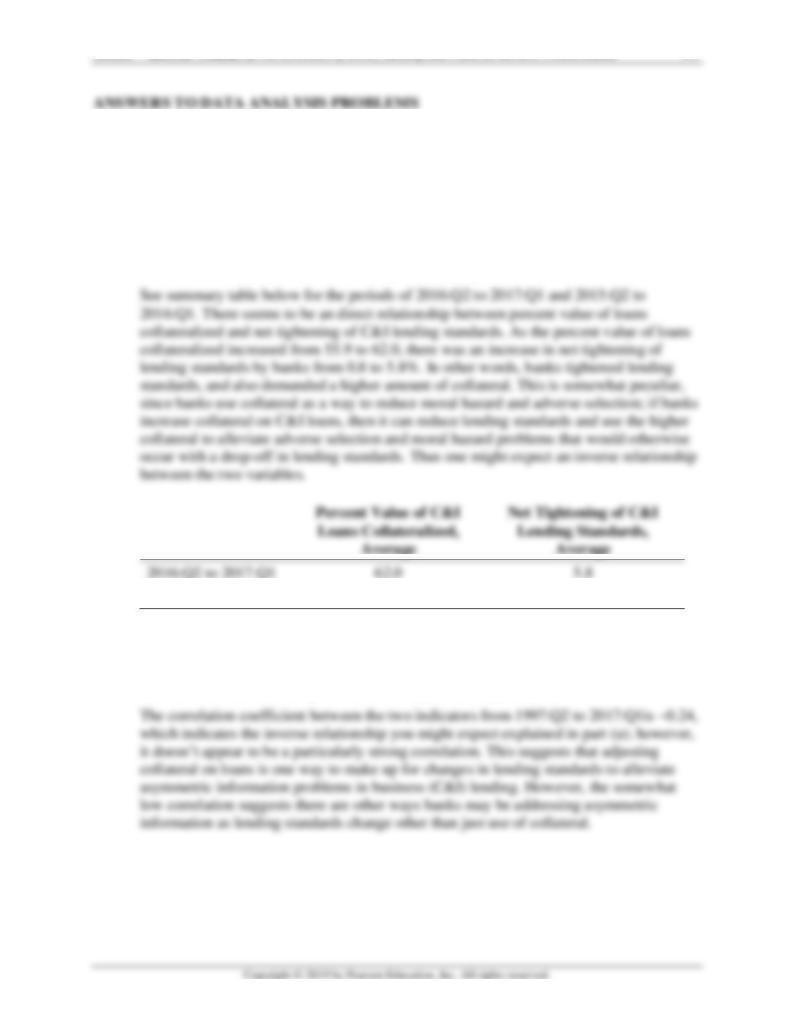
Mishkin • Instructor’s Manual for The Economics of Money, Banking, and Financial Markets, Twelfth Edition 117
1. Go to the St. Louis Federal Reserve FRED database and find data on the percent of value of
loans secured by collateral for all commercial and industrial loans (ESANQ) and the net
percentage of domestic banks tightening standards for commercial and industrial loans to
large and middle-market firms (DRTSCILM). Download the data into a spreadsheet.
a. Calculate the average, over the most recent four quarters and the four quarters prior to
that, for the bank standards indicator and the “percent of loans secured by collateral”
indicator. Do these averages behave as you would expect?
2015:Q2 to 2016:Q1
55.9
0.8
b. Use the Data Analysis tool in Excel to calculate the correlation coefficient for the two
data series from 1997:Q3 to the most recent quarter of data available. What can you
conclude about the relationship between collateral and bank C&I lending standards? Is
this result consistent with efforts to reduce asymmetric information?
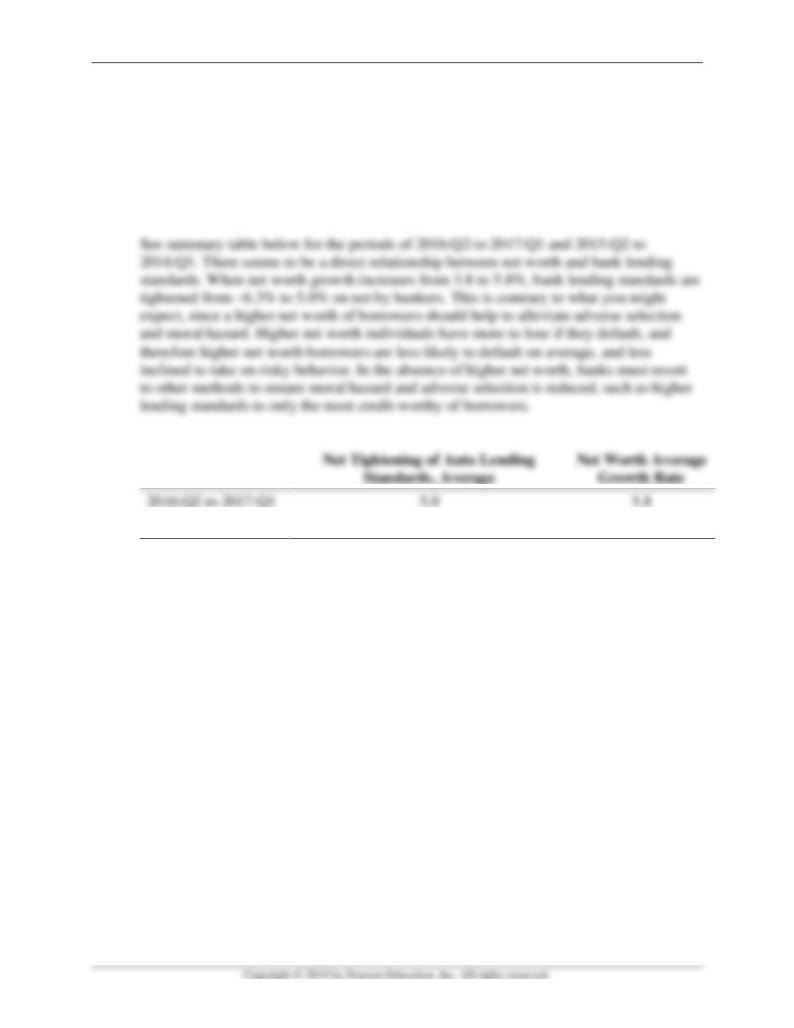
Mishkin • Instructor’s Manual for The Economics of Money, Banking, and Financial Markets, Twelfth Edition 118
2. Go to the St. Louis Federal Reserve FRED database and find data on net worth of
households (TNWBSHNO) and the net percentage of domestic banks tightening standards for
prime mortgage loans (DRTSPM). Adjust the units setting for the net worth indicator to
“Percent Change from Year Ago,” and download the data into a spreadsheet.
a. Calculate the average, over the most recent four quarters and the four quarters prior to
that, for the bank standards indicator and the “percent change in net worth” indicator.
Do these averages behave as you would expect?
2015:Q2 to 2016:Q1
−6.3
3.8
b. Use the Data Analysis tool in Excel to calculate the correlation coefficient for the two
data series from 2007:Q3 to the most recent quarter of data available. What can you
conclude about the relationship between the net worth of households and bank mortgage
lending standards? Is this result consistent with efforts to reduce asymmetric
information?
The correlation coefficient for the two data series over that time is –0.09, which indicates
almost no relationship between household net worth and lending standards. This is
inconsistent with what one might expect since banks use higher lending standards in
mortgage markets to alleviate moral hazard and adverse selection when net worth is low.
Thus, you would expect a stronger inverse relationship between the two.
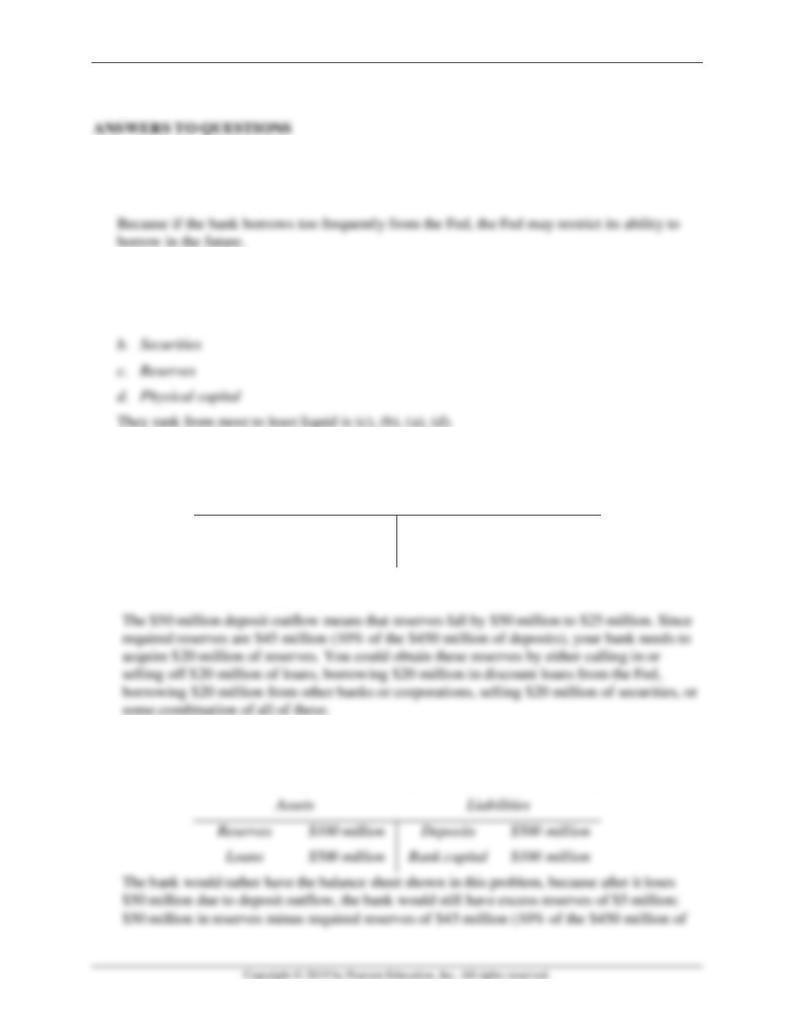
Mishkin • Instructor’s Manual for The Economics of Money, Banking, and Financial Markets, Twelfth Edition 119
Chapter 9
1. Why might a bank be willing to borrow funds from other banks at a higher rate than the rate
at which it can borrow from the Fed?
2. Rank the following bank assets from most to least liquid:
a. Commercial loans
3. The bank you own has the following balance sheet:
Assets
Liabilities
Reserves
$75 million
Deposits
$500 million
Loans
$525 million
Bank capital
$100 million
If the bank suffers a deposit outflow of $50 million with a required reserve ratio on deposits of
10%, what actions should you take?
4. If a deposit outflow of $50 million occurs, which balance sheet would a bank rather have
initially, the balance sheet in Question 3 or the following balance sheet? Why?

Mishkin • Instructor’s Manual for The Economics of Money, Banking, and Financial Markets, Twelfth Edition 120
5. If no decent lending opportunity arises in the economy, and the central bank pays an interest
rate on reserves that is similar to other low-risk investments, do you think banks will be
willing to hold large amounts of excess reserves?
6. If the bank you own has no excess reserves and a sound customer comes in asking for a loan,
should you automatically turn the customer down, explaining that you don’t have any excess
reserves to lend out? Why or why not? What options are available that will enable you to
provide the funds your customer needs?
7. If a bank finds that its ROE is too low because it has too much bank capital, what can it do to
raise its ROE?
8. If a bank is falling short of meeting its capital requirements by $1 million, what three things
can it do to rectify the situation?

Mishkin • Instructor’s Manual for The Economics of Money, Banking, and Financial Markets, Twelfth Edition 121
9. Why do equity holders care more about ROE than about ROA?
10. If a bank doubles the amount of its capital and ROA stays constant, what will happen to
ROE?
11. What are the benefits and costs for a bank when it decides to increase the amount of its bank
capital?
12. Why is being nosy a desirable trait for a banker?
13. A bank almost always insists that the firms it lends to keep compensating balances at the
bank. Why?
14. If the president of a bank told you that the bank was so well run that it has never had to call
in loans, sell securities, or borrow as a result of a deposit outflow, would you be willing to
buy stock in that bank? Why or why not?
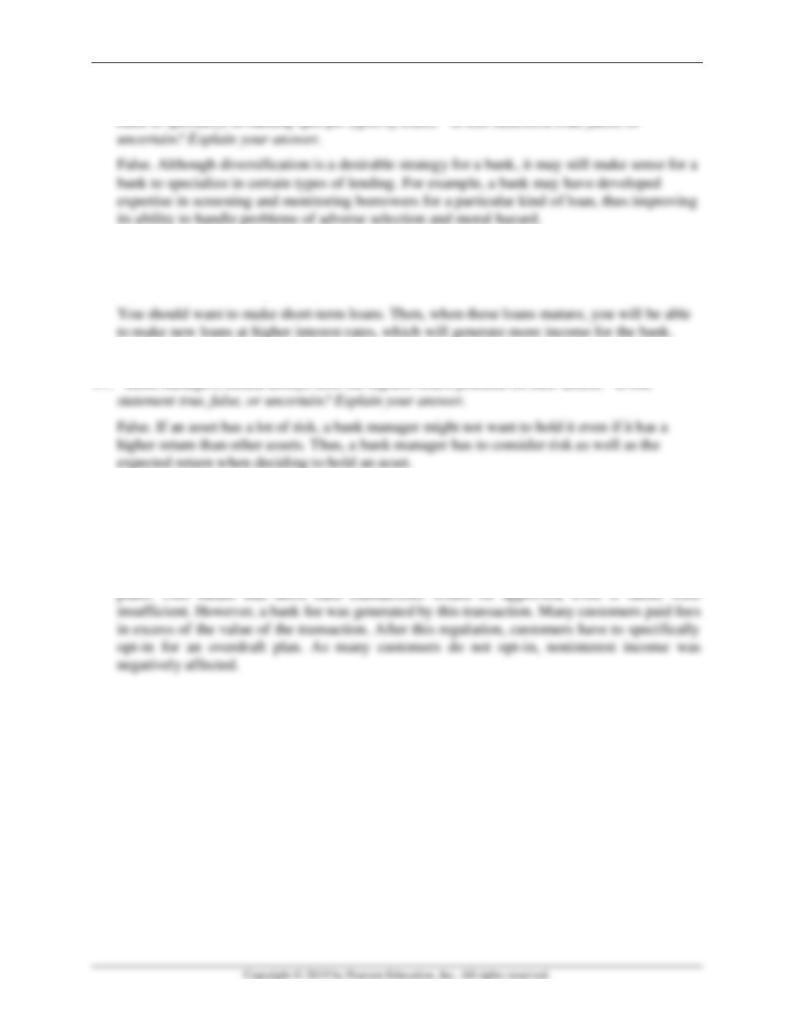
Mishkin • Instructor’s Manual for The Economics of Money, Banking, and Financial Markets, Twelfth Edition 122
15. “Because diversification is a desirable strategy for avoiding risk, it never makes sense for a
16. If you are a banker and expect interest rates to rise in the future, would you prefer to make
short-term loans or long-term loans?
18. After July 2010, bank customers using a debit card had to specifically opt-in to the bank’s
overdraft protection plan. Explain the effect of this regulation on a bank’s noninterest
income.
Before this regulation, customers were automatically enrolled in bank’s overdraft protection
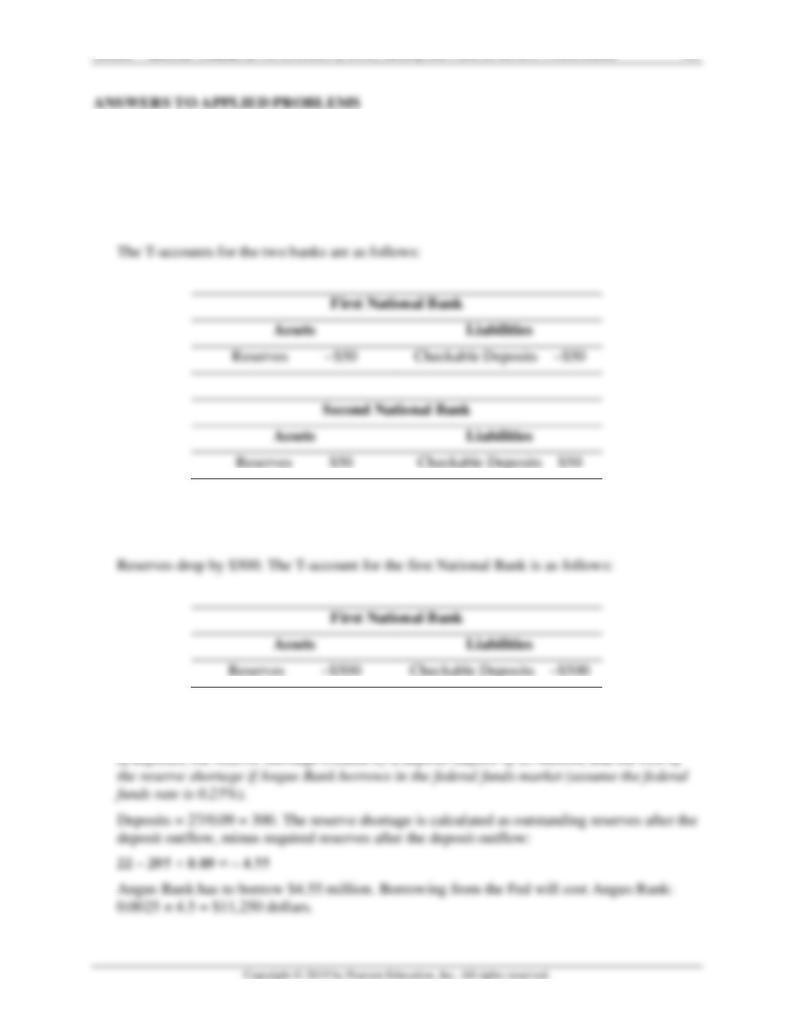
Mishkin • Instructor’s Manual for The Economics of Money, Banking, and Financial Markets, Twelfth Edition 123
19. Using the t-accounts of the first national bank and the second national bank given in this
chapter, describe what happens when jane brown writes a $50 check on her account at the
first national bank to pay her friend Joe Green, who in turn deposits the check in his account
at the second national bank.
20. What happens to reserves at the First National Bank if one person withdraws $1,000 of cash
and another person deposits $500 of cash? Use T-accounts to explain your answer.
21. Angus Bank holds no excess reserves but complies with the reserve requirement. The
required reserves ratio is 9%, and reserves are currently $27 million. Determine the amount
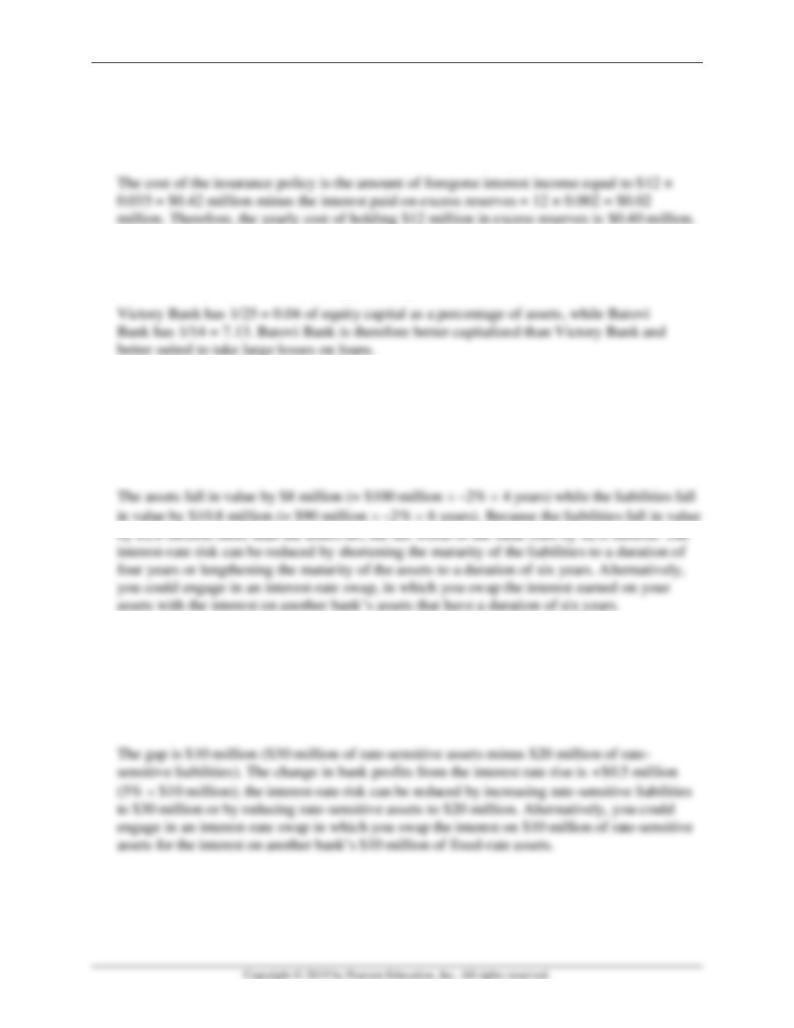
Mishkin • Instructor’s Manual for The Economics of Money, Banking, and Financial Markets, Twelfth Edition 124
22. Excess reserves act as insurance against deposit outflows. Suppose that on a yearly basis
Malcom Bank holds $12 million in excess reserves and $88 million in required reserves.
Suppose that Malcom Bank can earn 3.5% on its loans and that the interest paid on (total)
reserves is 0.2%. What would be the cost of this insurance policy?
23. Victory Bank reports an EM of 25, while Batovi Bank reports an EM equal to 14. Which
bank is better prepared to respond against large losses on loans?
24. Suppose you are the manager of a bank whose $100 billion of assets have an average
duration of four years and whose $90 billion of liabilities have an average duration of six
years. Conduct a duration analysis for the bank, and show what will happen to the net worth
of the bank if interest rates rise by 2 percentage points. What actions could you take to
reduce the bank’s interest-rate risk?
25. Suppose you are the manager of a bank that has $15 million of fixed-rate assets, $30 million
of rate-sensitive assets, $25 million of fixed-rate liabilities, and $20 million of rate-sensitive
liabilities. Conduct a gap analysis for the bank, and show what will happen to bank profits if
interest rates rise by 5 percentage points. What actions could you take to reduce the bank’s
interest-rate risk?

Mishkin • Instructor’s Manual for The Economics of Money, Banking, and Financial Markets, Twelfth Edition 125
1. Go to the St. Louis Federal Reserve FRED database and find data for all commercial banks
on total liabilities (TLBACBM027SBOG), total deposits (DPSACBM027SBOG), and residual
of assets less liabilities (RALACBM027SBOG).
a. What is the balance sheet interpretation of the residual of assets less liabilities?
2. Go to the St. Louis Federal Reserve FRED database and find data for all commercial banks
on total assets (TLAACBM027SBOG), U.S. government and agency securities held
(USGSEC), other securities held (OTHSEC), commercial and industrial loans (BUSLOANS),
real estate loans (REALLN), consumer loans (CONSUMER), interbank loans
(IBLACBM027S-BOG), other loans (OLLACBM027SBOG), and other assets
(OATACBM027SBOG). Use the most recent month of data available across all indicators.
a. What is the total amount of loans held by banks? What is this number as a percentage of
total bank assets?
Total Loans
9308.3
b. What is the total amount of securities held by banks? What is this number as a
percentage of total bank assets?
For May 2017, total securities held are $2,464.3 Bil. + $914.6 Bil = $3,378.9 Billion,
representing 20.8% of total assets held by banks.
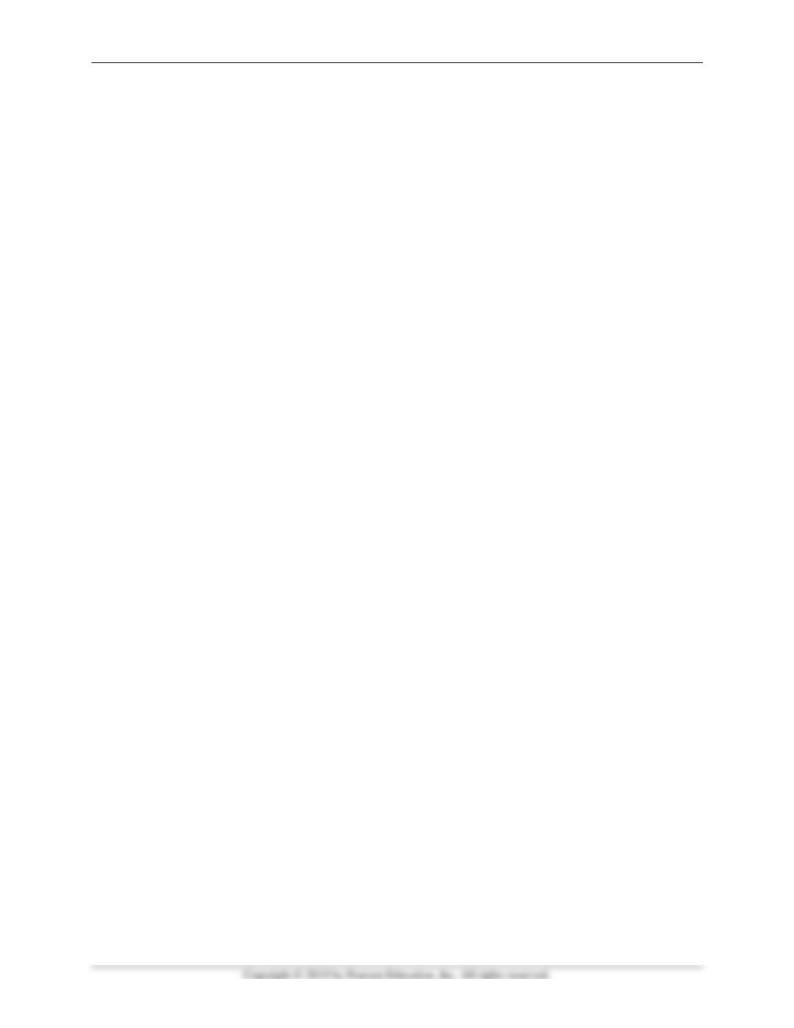
Mishkin • Instructor’s Manual for The Economics of Money, Banking, and Financial Markets, Twelfth Edition 126
c. What is the total amount of reserves and cash items? What is this number as a percentage
of total bank assets?
Reserves and cash items equal total assets minus securities, loans, and other assets. Thus,
using answers from parts (a) and (b), Reserves and cash items = $16,236.3 Bil. –
$3,378.9Bil. – $9,308.3 Bil. – $1,194.5 Bil. = $2,354.6 Billion, or 14.5% of total bank
assets.

Mishkin • Instructor’s Manual for The Economics of Money, Banking, and Financial Markets, Twelfth Edition 127
Chapter 10
1. Why are deposit insurance and other types of government safety nets important to the health
of the economy?
2. If casualty insurance companies provided fire insurance without any restrictions, what kind
of adverse selection and moral hazard problems might result?
3. Do you think that eliminating or limiting the amount of deposit insurance would be a good
idea? Explain your answer.
4. How could higher deposit insurance premiums for banks with riskier assets benefit the
economy?
5. What are the costs and benefits of a too-big-to-fail policy?
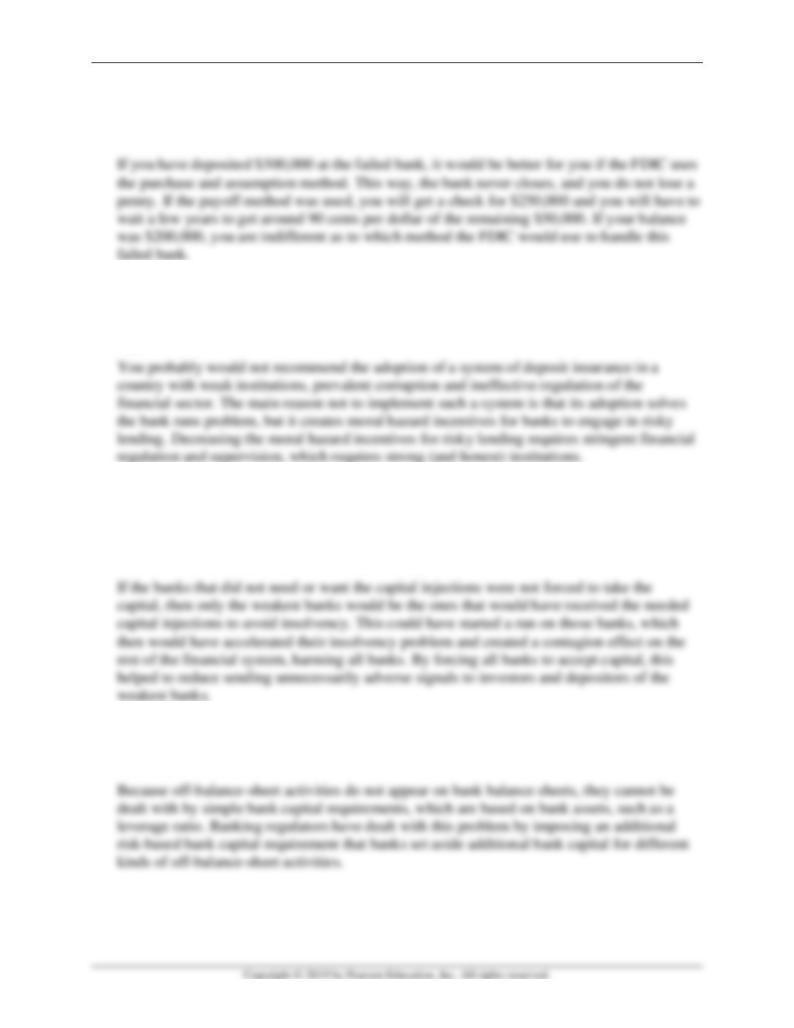
Mishkin • Instructor’s Manual for The Economics of Money, Banking, and Financial Markets, Twelfth Edition 128
6. Suppose that you have $300,000 in deposits at a bank. After careful consideration, the FDIC
decides that this bank is now insolvent. Which method would you like to see the FDIC apply?
What if your deposit were $200,000?
7. Would you recommend the adoption of a system of deposit insurance, like the FDIC in the
United States, in a country with weak institutions, prevalent corruption, and ineffective
regulation of the financial sector?
8. At the height of the global financial crisis in October 2008, the U.S. Treasury forced nine of
the largest U.S. banks to accept capital injections in exchange for nonvoting ownership
stock, even though some of the banks did not need the capital and did not want to participate.
What could be the Treasury’s rationale for doing this?
9. What special problem do off-balance-sheet activities present to bank regulators, and what
have they done about it?
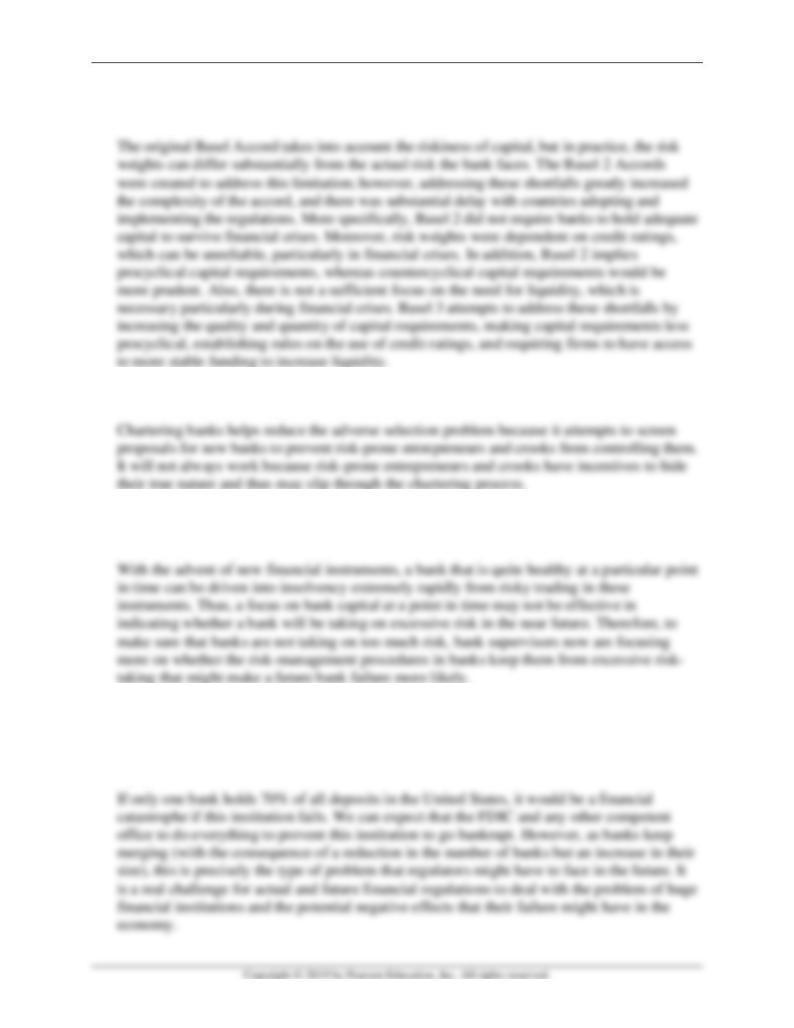
Mishkin • Instructor’s Manual for The Economics of Money, Banking, and Financial Markets, Twelfth Edition 129
10. What are some of the limitations to the Basel and Basel 2 Accords? How does the Basel 3
Accord attempt to address these limitations?
11. How does bank chartering reduce adverse selection problems? Does it always work?
12. Why has the trend in bank supervision moved away from a focus on capital requirements to a
focus on risk management?
13. Suppose that after a few mergers and acquisitions, only one bank holds 70% of all deposits
in the United States. Would you say that this bank would be considered too big to fail? What
does this tell you about the ongoing process of financial consolidation and the government
safety net?
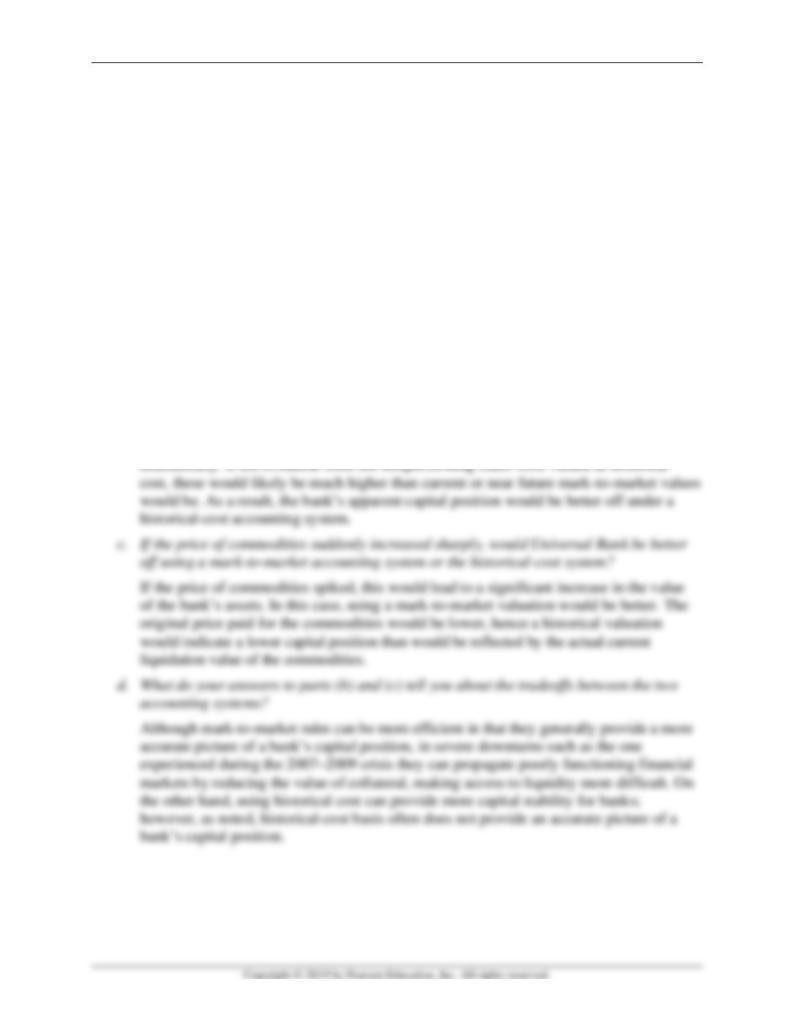
Mishkin • Instructor’s Manual for The Economics of Money, Banking, and Financial Markets, Twelfth Edition 130
14. Suppose Universal Bank holds $100 million in assets, which are composed of the following:
Required reserves: $10 million
Excess
reserves: $ 5 million
Mortgage
loans: $20 million
Corporate bonds: $15 million
Stocks: $25 million
Commodities: $25 million
a. Do you think it is a good idea for Universal Bank to hold stocks, corporate bonds, and
commodities as assets? Why or why not?
Probably not. Since these assets are relatively high risk, the bank is subject to fluctuations
in the values of these assets, which can be substantial. This could result in a significant
decrease in the value of its assets to the point where it can no longer cover its immediate
liabilities, and would become insolvent. It is for this reason that the government places
restrictions on the types and amounts of assets that financial institutions can hold.
b. If the housing market suddenly crashed, would Universal Bank be better off using a
mark-to-market accounting system or the historical-cost system?
If the housing market crashed, it is likely that many of the mortgage loans would default,
and the value of collateral on those loans (the market price of the house) would decline
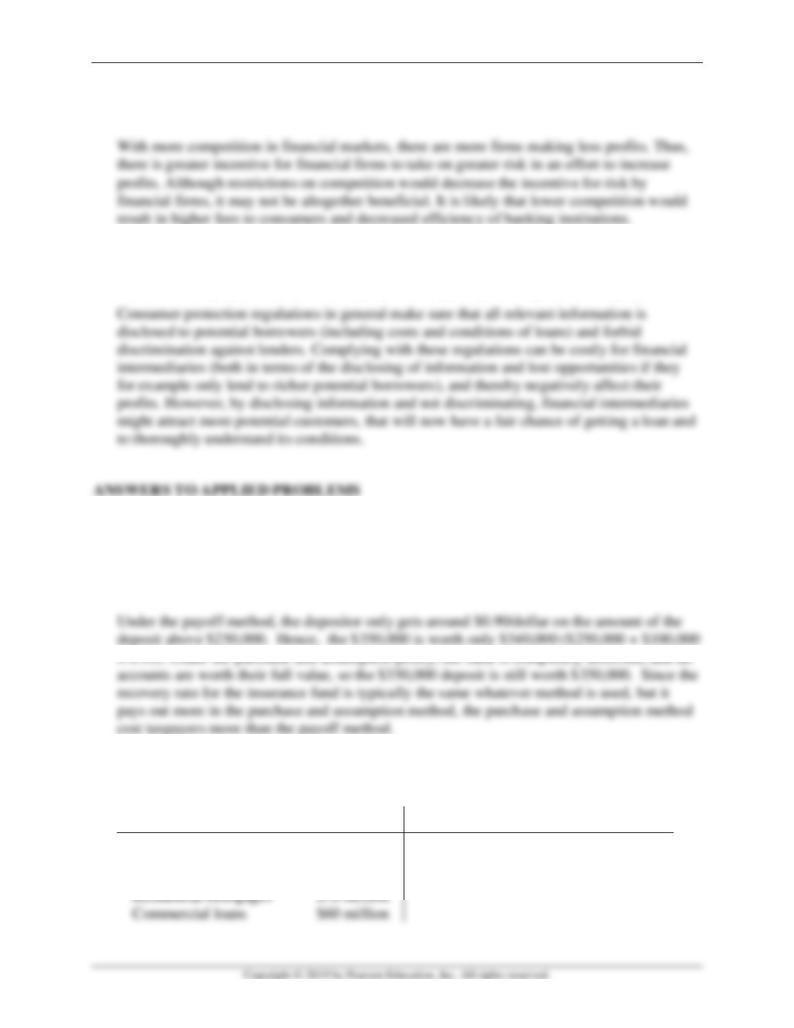
Mishkin • Instructor’s Manual for The Economics of Money, Banking, and Financial Markets, Twelfth Edition 131
15. Why might more competition in financial markets be a bad idea? Would restrictions on
competition be a better idea? Why or why not?
16. In what way might consumer protection regulations negatively affect a financial
intermediary’s profits? Can you think of a positive effect of such regulations on profits?
17. Consider a failing bank. A deposit of $350,000 is worth how much to the depositor if the
FDIC uses the payoff method given the typical recovery rate? How much is the same deposit
worth to the depositor if the purchase-and-assumption method is used? Which is more costly
to taxpayers?
18. Consider a bank with the following balance sheet:
Assets
Liabilities
Required reserves
$17 million
Checkable deposits
$205 million
Excess reserves
$3 million
Bank capital
$10 million
Municipal bonds
$65 million
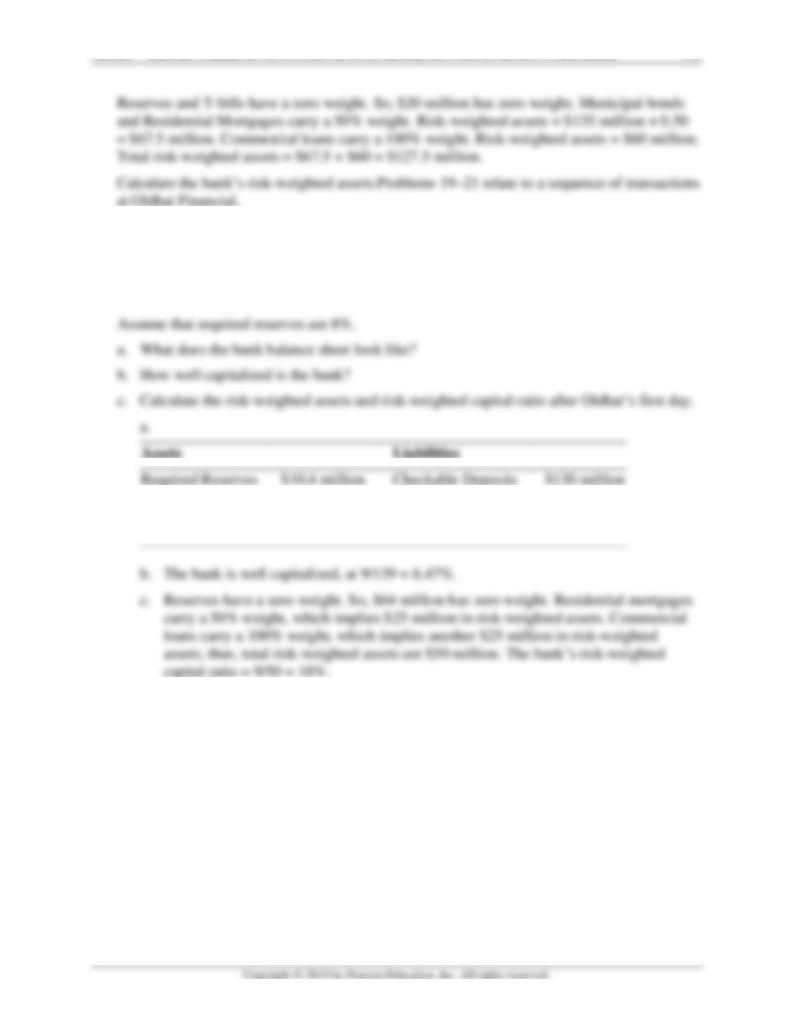
Mishkin • Instructor’s Manual for The Economics of Money, Banking, and Financial Markets, Twelfth Edition 132
19. Oldhat Financial starts its first day of operations with $9 million in capital. A total of $130
million in checkable deposits is received. The bank makes a $25 million commercial loan and
another $50 million in mortgages with the following terms: 200 standard, 30-year, fixed-rate
mortgages with a nominal annual rate of 5.25%, each for $250,000.
Excess Reserves
Loans
$53.6 million
$75 million
Bank Capital
$9 million
20. Early the next day, the bank invests $50 million of its excess reserves in commercial loans.
Later that day, terrible news hits the mortgage markets, and mortgage rates jump to 13%,
implying a present value of Oldhat’s current mortgage holdings of $124,798 per mortgage.
Bank regulators force Oldhat to sell its mortgages to recognize the fair market value. What
does Oldhat’s balance sheet look like? How do these events affect its capital position?
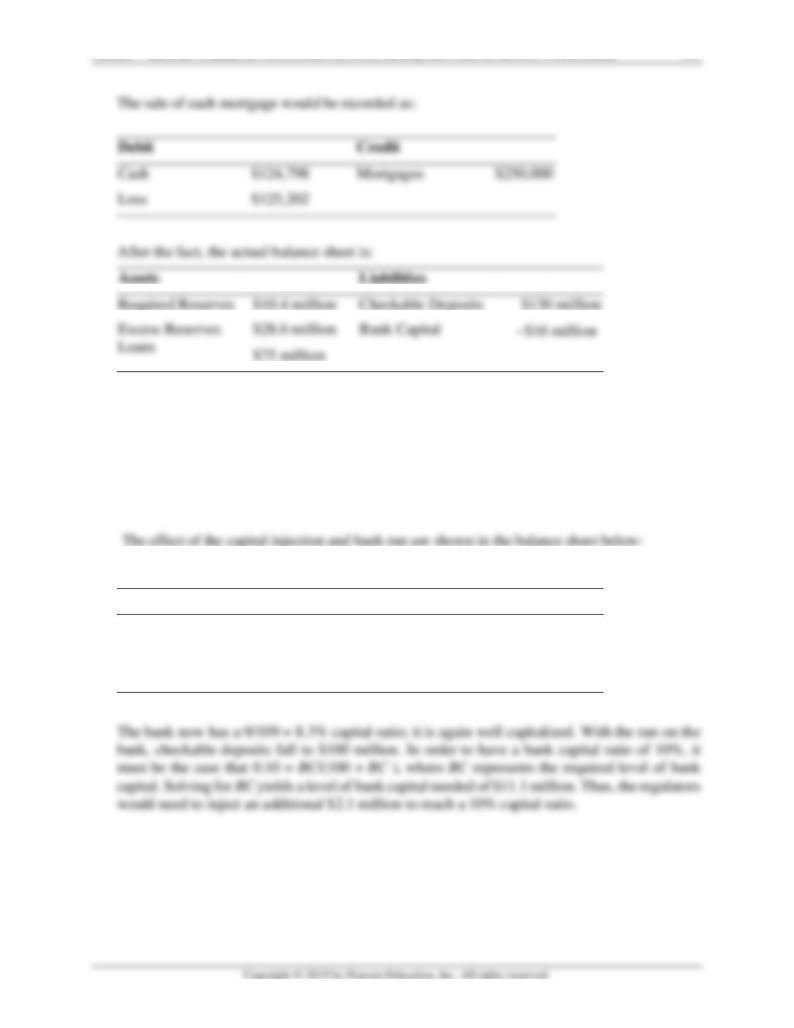
Mishkin • Instructor’s Manual for The Economics of Money, Banking, and Financial Markets, Twelfth Edition 133
21. To avoid insolvency, regulators decide to provide the bank with $25 million in bank capital.
However, the bad news about the mortgages is featured in the local newspaper, causing a
bank run. As a result, $30 million in deposits is withdrawn. Show the effects of the capital
injection and the bank run on the balance sheet. Was the capital injection enough to stabilize
the bank? If the bank regulators decide that the bank needs a capital ratio of 10% to prevent
further runs on the bank, how much of an additional capital injection is required to reach a
10% capital ratio?
22.
Assets
Liabilities
Required Reserves
$ 8 million
Checkable Deposits
$100 million
Excess Reserves
Loans
$26 million
$75 million
Bank Capital
$ 9 million
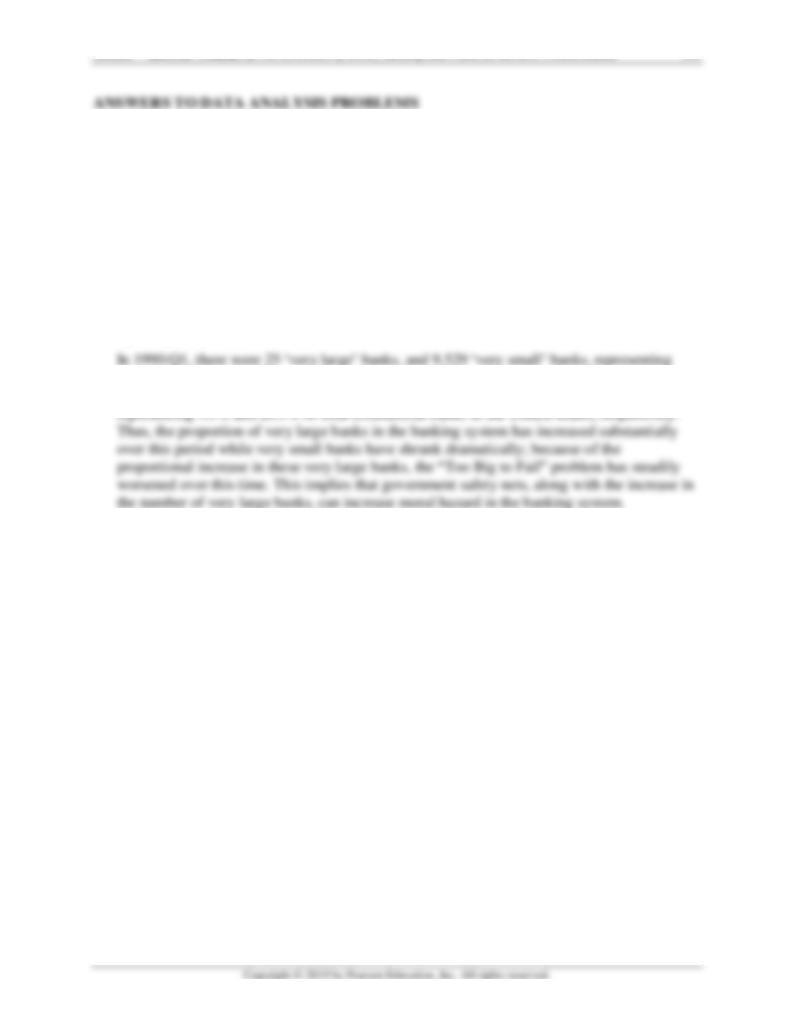
Mishkin • Instructor’s Manual for The Economics of Money, Banking, and Financial Markets, Twelfth Edition 134
1. Go to the St. Louis Federal Reserve FRED database and find data on the number of
commercial banks in the United States in each of the following categories: average assets
less than $100 million (US100NUM), average assets between $100 million and $300 million
(US13NUM), average assets between $300 million and $1 billion (US31NUM), average
assets between $1 billion and $15 billion (US115NUM), and average assets greater than $15
billion (USG15NUM). Download the data into a spreadsheet. Calculate the percentage of
banks in the smallest (less than $100 million) and largest (greater than $15 billion)
categories, as a percentage of the total number of banks, for the most recent quarter of data
available and for 1990:Q1. What has happened to the proportion of very large banks? What
has happened to the proportion of very small banks? What does this say about the “too-big-
to-fail” problem and moral hazard?
0.2% and 76.5% of total commercial banks in the United States, respectively. For the most
recent quarter of 2017:Q1, there were 77 ‘very large’ banks, and 1,324 ‘very small’ banks,
2. Go to the St. Louis Federal Reserve FRED database and find data on the residual of assets
less liabilities, or bank capital (RALACBM027SBOG), and total assets of commercial banks
(TLAACBM027SBOG). Download the data from January 1990 through the most recent
month available into a spreadsheet. For each monthly observation, calculate the bank
leverage ratio as the ratio of bank capital to total assets. Create a line graph of the leverage
ratio over time. All else being equal, what can you conclude about leverage and moral
hazard in commercial banks over time?
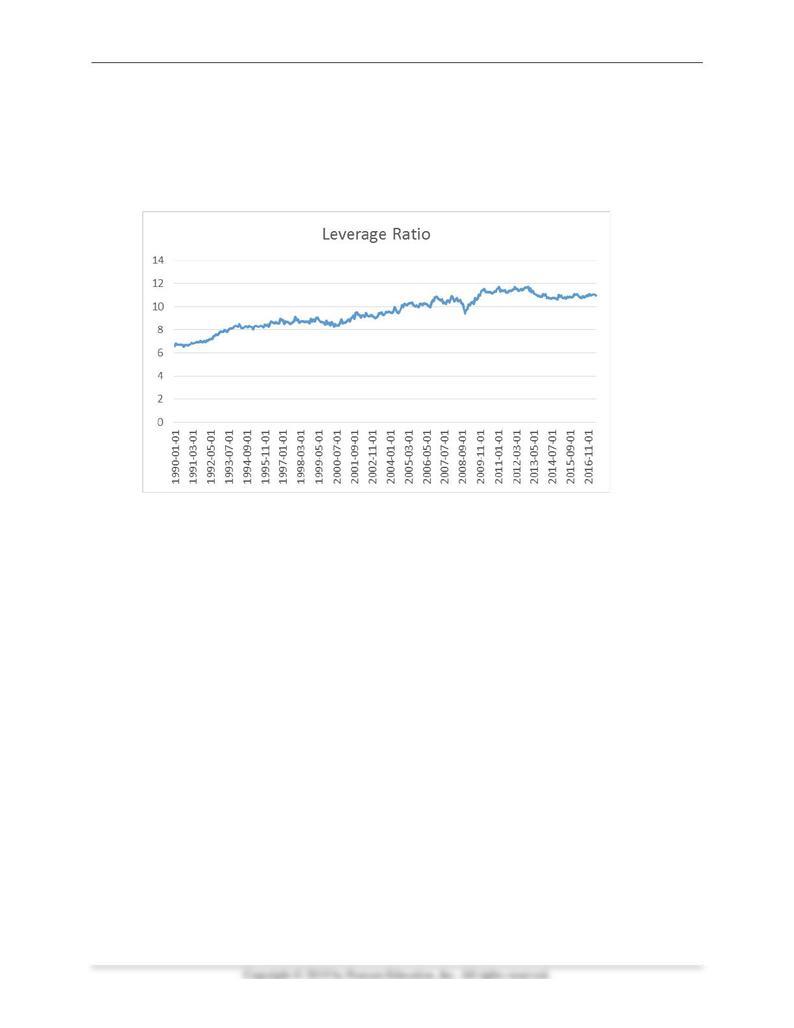
Mishkin • Instructor’s Manual for The Economics of Money, Banking, and Financial Markets, Twelfth Edition 135
See graph below. In January 1990, the leverage ratio was 6.6%, and the most recent month of
May 2017, the leverage ratio was 10.9%. The graph clearly illustrates a gradual increase in
the leverage ratio over time for commercial banks, indicating that, holding everything else
constant, moral hazard in the banking system should have gradually declined over that
period.
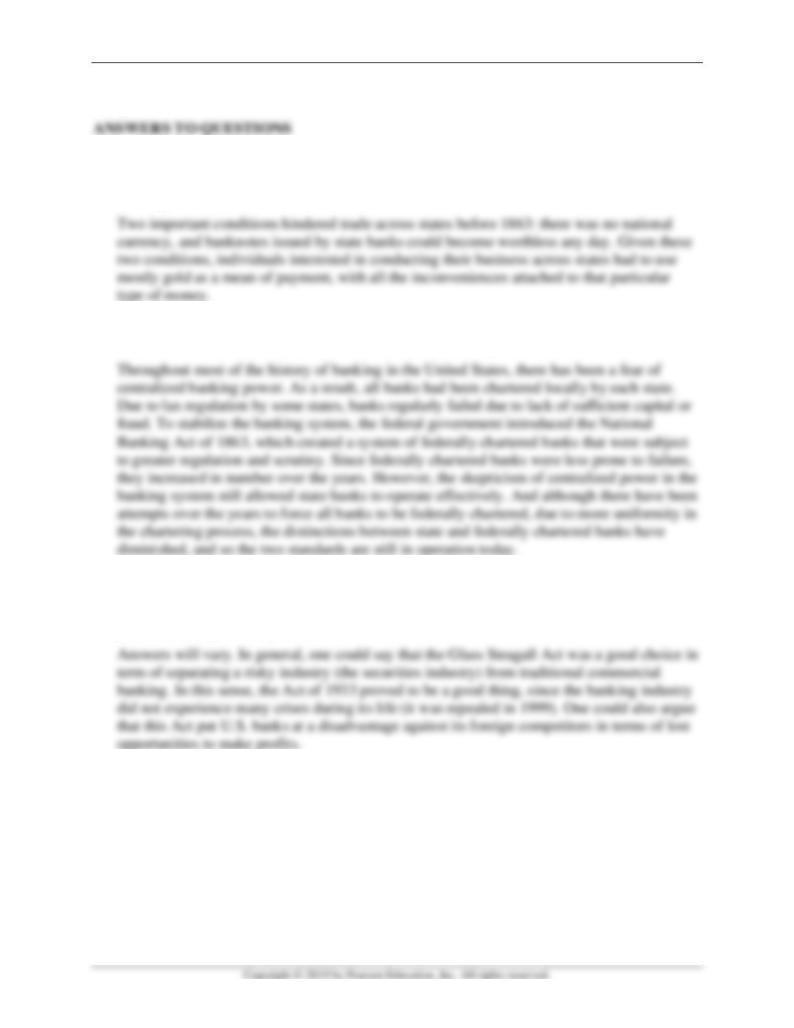
Mishkin • Instructor’s Manual for The Economics of Money, Banking, and Financial Markets, Twelfth Edition 136
Chapter 11
1. Do you think that before the National Bank Act of 1863 the prevailing conditions in the
banking industry fostered or hindered trade across states in the United States?
2. Why does the United States operate under a dual banking system?
3. In light of the recent financial crisis of 2007–2009, do you think that the firewall created by
the Glass-Steagall Act of 1933 between commercial banking and the securities industry
proved to be a good thing or not?
4. Which regulatory agency has the primary responsibility for supervising the following
categories of commercial banks?
a. National banks
b. Bank holding companies
c. Nonfederal Reserve member state banks
d. Federal Reserve member state banks

5. How does the emergence of interest-rate risk help explain financial innovation?
6. Why did new technology make it harder to enforce limitations on bank branching?
7. “The invention of the computer is the major factor behind the decline of the banking
industry.” Is this statement true, false, or uncertain? Explain your answer.
Uncertain. The invention of the computer did help lower transaction costs and the costs of
8. “If inflation had not risen in the 1960s and 1970s, the banking industry might be healthier
today.” Is this statement true, false, or uncertain? Explain your answer.
True. Higher inflation helped raise interest rates, which caused the disintermediation process
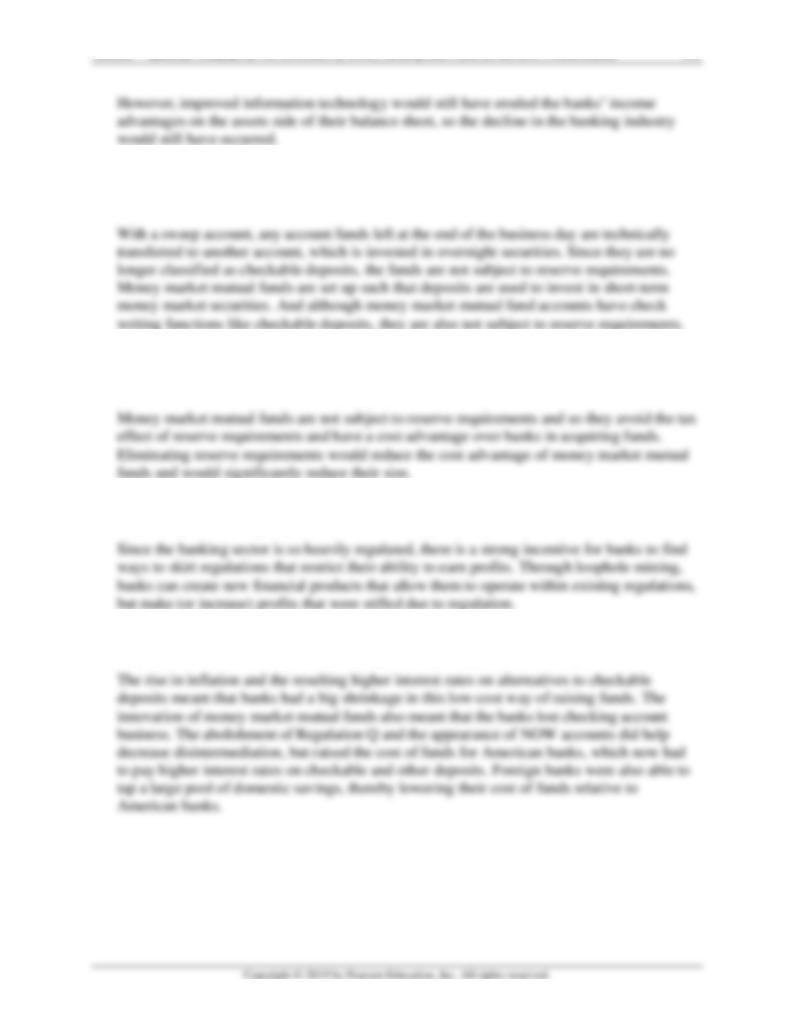
Mishkin • Instructor’s Manual for The Economics of Money, Banking, and Financial Markets, Twelfth Edition 138
9. How do sweep accounts and money market mutual funds allow banks to avoid reserve
requirements?
10. If reserve requirements were eliminated in the future, as some economists advocate, what
effects would this have on the size of money market mutual funds?
11. Why is loophole mining so prevalent in the banking industry in the United States?
12. Why have banks been losing cost advantages in acquiring funds in recent years?
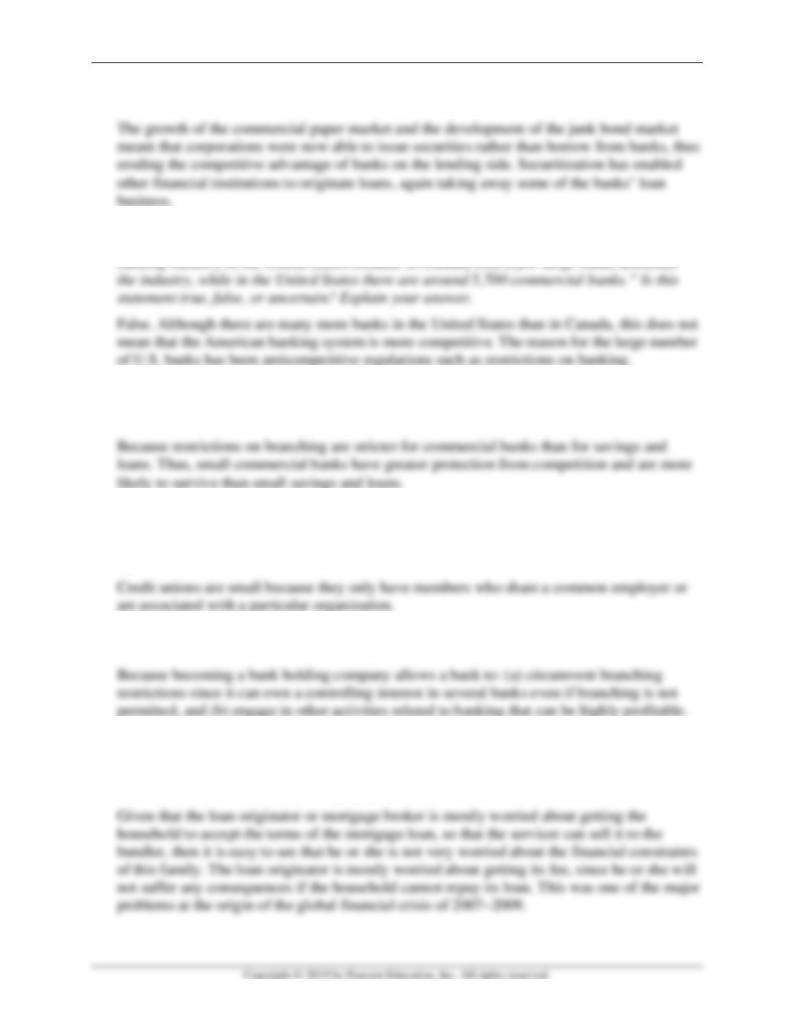
Mishkin • Instructor’s Manual for The Economics of Money, Banking, and Financial Markets, Twelfth Edition 139
13. Why have banks been losing income advantages on their assets in recent years?
14. “The commercial banking industry in Canada is less competitive than the commercial
15. Why is there a higher percentage of banks with less than $25 million of assets among
commercial banks than among savings and loans and mutual savings banks?
16. Unlike commercial banks, savings and loans, and mutual savings banks, credit unions did
not have restrictions on setting up branches in other states. Why, then, are credit unions
typically smaller than the other depository institutions?
17. Why has the number of bank holding companies dramatically increased?
18. Given the role of the loan originator in the securitization process of a mortgage loan
described in the text, do you think the loan originator will be worried about the ability of a
household to meet its monthly mortgage payments?
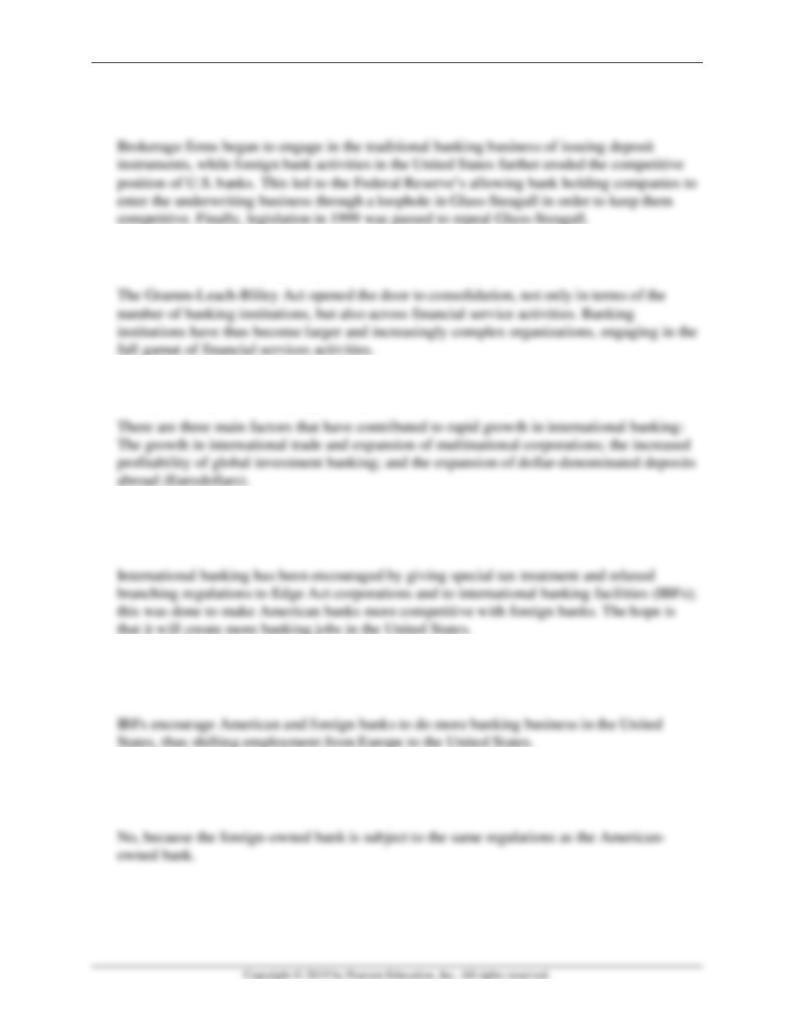
Mishkin • Instructor’s Manual for The Economics of Money, Banking, and Financial Markets, Twelfth Edition 140
19. How did competitive forces lead to the repeal of the Glass-Steagall Act’s separation of the
banking and securities industries?
20. What has been the likely effect of the Gramm-Leach-Bliley Act on financial consolidation?
21. What factors explain the rapid growth of international banking?
22. What incentives have regulatory agencies created to encourage international banking? Why
have they done this?
23. How could the approval of international banking facilities (IBFs) by the Fed in 1981 have
reduced employment in the banking industry in Europe?
24. If the bank at which you keep your checking account is owned by foreigners, should you
worry that your deposits are less safe than if the bank were owned by Americans?

Mishkin • Instructor’s Manual for The Economics of Money, Banking, and Financial Markets, Twelfth Edition 141
25. Why is there only two U.S. bank among the ten largest banks in the world?
1. Go to the St. Louis Federal Reserve FRED database and find data on the 30-year fixed rate
average mortgage rate (MORTGAGE30US) and the 5/1-year adjustable-rate mortgage
(MORTGAGE5US).
a. What are the mortgage rates reported for the most recent week of data available?
0.0321 = $64.20 per month.
c. Over a one-year period, how much would the difference in interest payments between the
two mortgage types amount to?
2. Go to the St. Louis Federal Reserve FRED database and find data on the level of money
market mutual fund assets (MMMFFAQ027S). Download the data into a spreadsheet.
a. When did assets start entering money market mutual funds? What was the total worth of
assets in money market mutual funds at the end of 1970?
Assets started entering money market mutual funds at the beginning of 1974 (Q1). By the
end of the decade in 1979:Q4 there were $45.2 billion in assets.
b. For each decade period, calculate the total percentage change in assets from the
beginning of the decade to the end of the decade: 1980:Q1–1990:Q1; 1990:Q1–
2000:Q1; 2000:Q1–2010:Q1. For each decade period, divide the total percentage
change by 10 to get the average yearly percentage increase. Which decade had the
largest average yearly growth in money market mutual funds?
Assets started entering money market mutual funds at the beginning of 1974 (Q1). By the
end of the decade in 1979:Q4 there were $45.2 billion in assets.
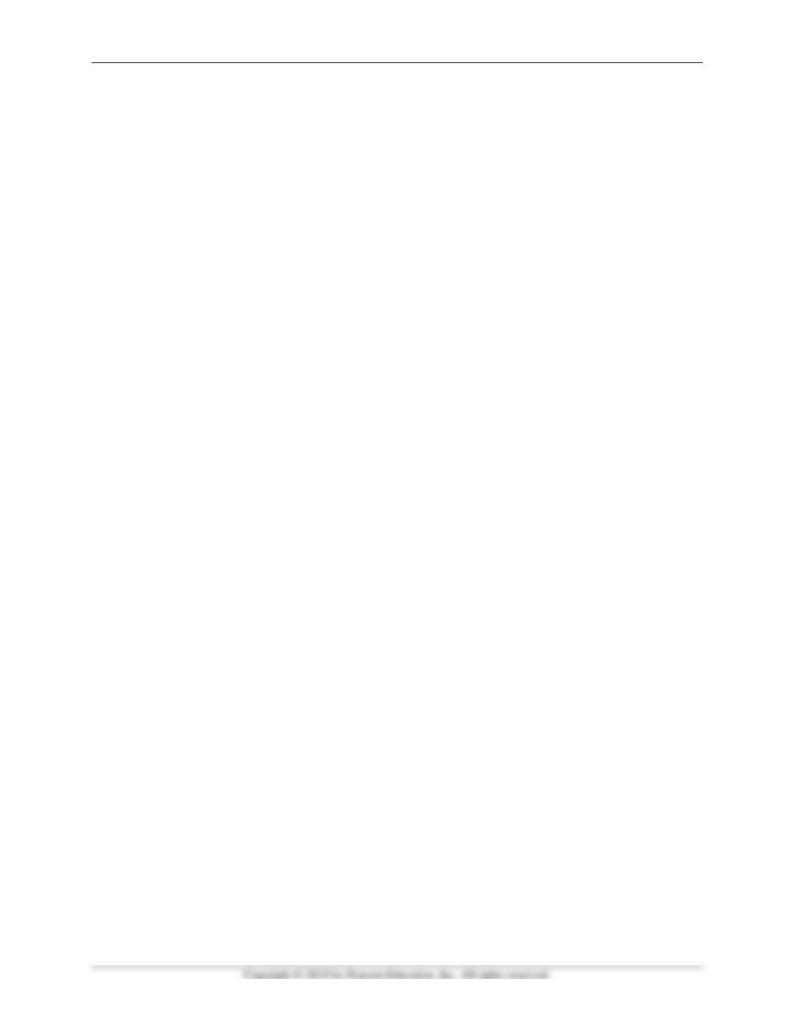
Mishkin • Instructor’s Manual for The Economics of Money, Banking, and Financial Markets, Twelfth Edition 142
c. Calculate the growth rate from the most recent quarter of data available to the same
quarter a year prior. How does this growth rate compare to the highest average yearly
growth rate for the decades from part (b)?
For the most recent one year period from 2016:Q1 to 2017:Q1, money market mutual
fund assets fell by 3.4%, which is much less than the peak average yearly growth rate of
about 66% per year in the 1980s.
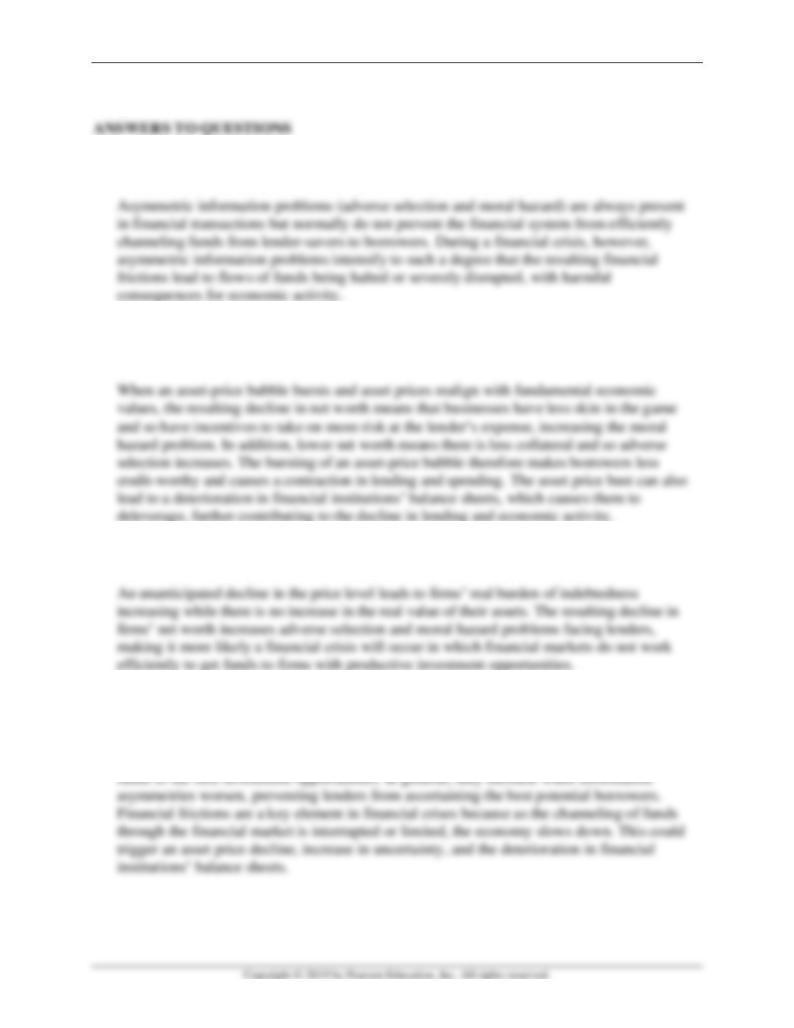
Mishkin • Instructor’s Manual for The Economics of Money, Banking, and Financial Markets, Twelfth Edition 143
Chapter 12
1. How does the concept of asymmetric information help to define a financial crisis?
2. How can the bursting of an asset-price bubble in the stock market help trigger a financial
crisis?
3. How does an unanticipated decline in the price level cause a drop in lending?
4. Define “financial frictions” in your own terms and explain why an increase in financial
frictions is a key element in financial crises.
Financial frictions are a set of conditions that prevent financial markets to effectively assign

Mishkin • Instructor’s Manual for The Economics of Money, Banking, and Financial Markets, Twelfth Edition 144
5. How does a deterioration in balance sheets of financial institutions and the simultaneous
failures of these institutions cause a decline in economic activity?
6. How does a general increase in uncertainty as a result of the failure of a major financial
institution lead to an increase in adverse selection and moral hazard problems?
7. What is a credit spread? Why do credit spreads rise significantly during a financial crisis?
8. Some countries do not advertise that a system of deposit insurance like the FDIC in the
United States exists in their banking system. Explain why some countries would want to do
that.

Mishkin • Instructor’s Manual for The Economics of Money, Banking, and Financial Markets, Twelfth Edition 145
9. Describe the process of “securitization” in your own words. Was this process solely
responsible for the Great Recession financial crisis of 2007–2009?
10. Provide one argument in favor of and one against the idea that the Fed was responsible for
the housing price bubble of the mid 2000s.
Supporters of the idea that the Fed was responsible for the Great Recession financial crisis
argue that it helped to create the conditions for a housing market bubble by setting the federal
11. What role does weak financial regulation and supervision play in causing financial crises?
12. Describe two similarities and two differences between the United States’ experiences during
the Great Depression and the Great Recession financial crisis of 2007–2009.
Answers may vary. Both the Great Depression and the Great Recession were preceded by
sharp increases in asset prices. During the two episodes, credit spreads widened, the
availability of credit shrank, and economic activity sharply declined. The two episodes differ
in the source of asset price increases: During the Great Depression, rising stock prices were
the trigger, whereas in the Great Recession a housing bubble was the primary trigger. During
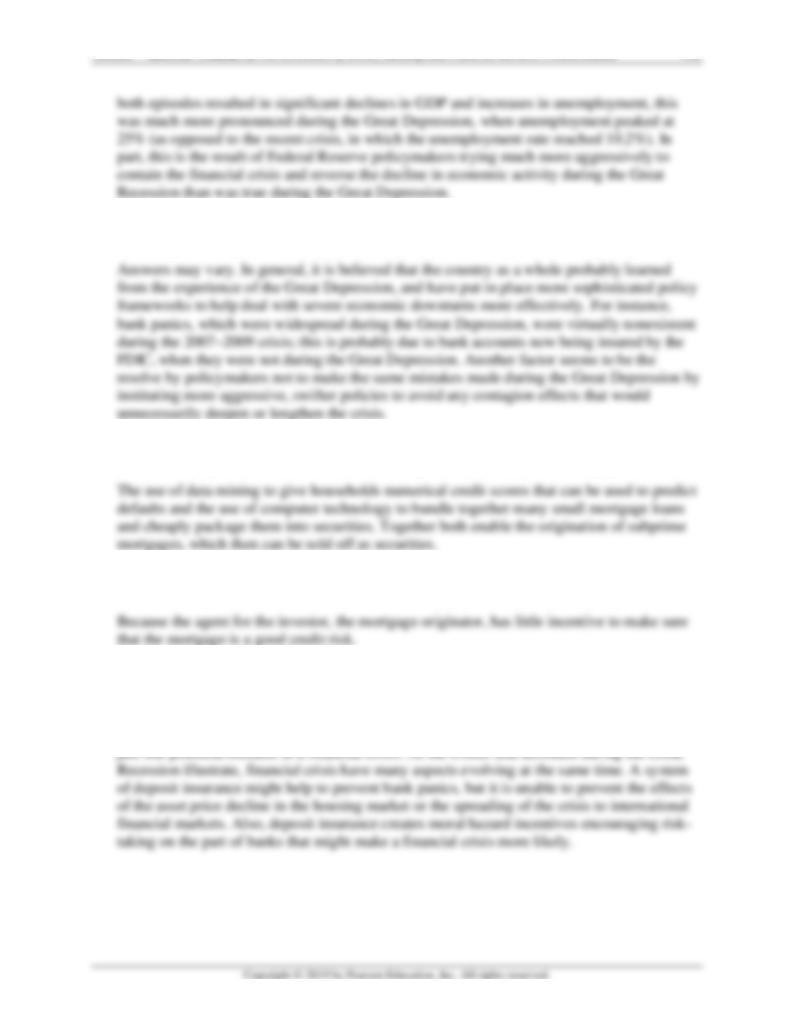
Mishkin • Instructor’s Manual for The Economics of Money, Banking, and Financial Markets, Twelfth Edition 146
13. What do you think prevented the financial crisis of 2007–2009 from becoming a depression?
14. What technological innovations led to the development of the subprime mortgage market?
15. Why is the originate-to-distribute business model subject to the principal–agent problem?
16. True, false, or uncertain: Deposit insurance always and everywhere prevents financial
crises.
False. Deposit insurance is a very good system to prevent bank panics, but these events are
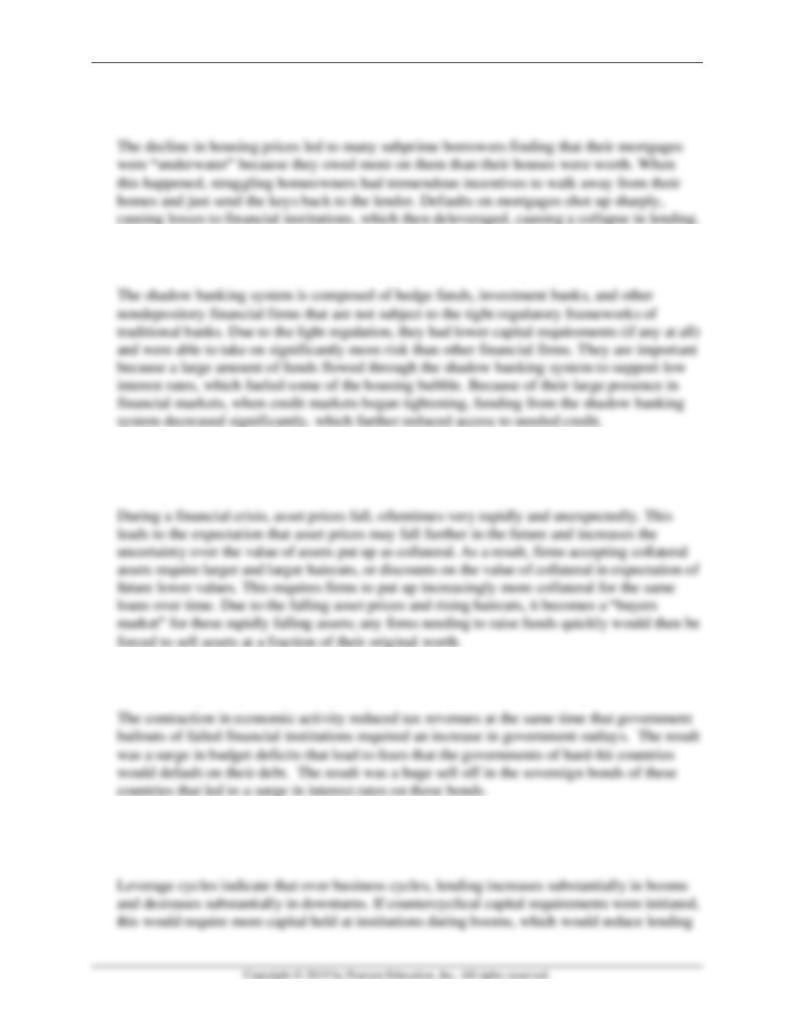
Mishkin • Instructor’s Manual for The Economics of Money, Banking, and Financial Markets, Twelfth Edition 147
17. How did a decline in housing prices help trigger the subprime financial crisis that began in
2007?
18. What role did the shadow banking system play in the 2007–2009 financial crisis?
19. Why would haircuts on collateral increase sharply during a financial crisis? How would this
lead to fire sales on assets?
20. How did the global financial crisis promote a sovereign debt crisis in Europe?
21. Why is it a good idea for macroprudential policies to require countercyclical capital
requirements?
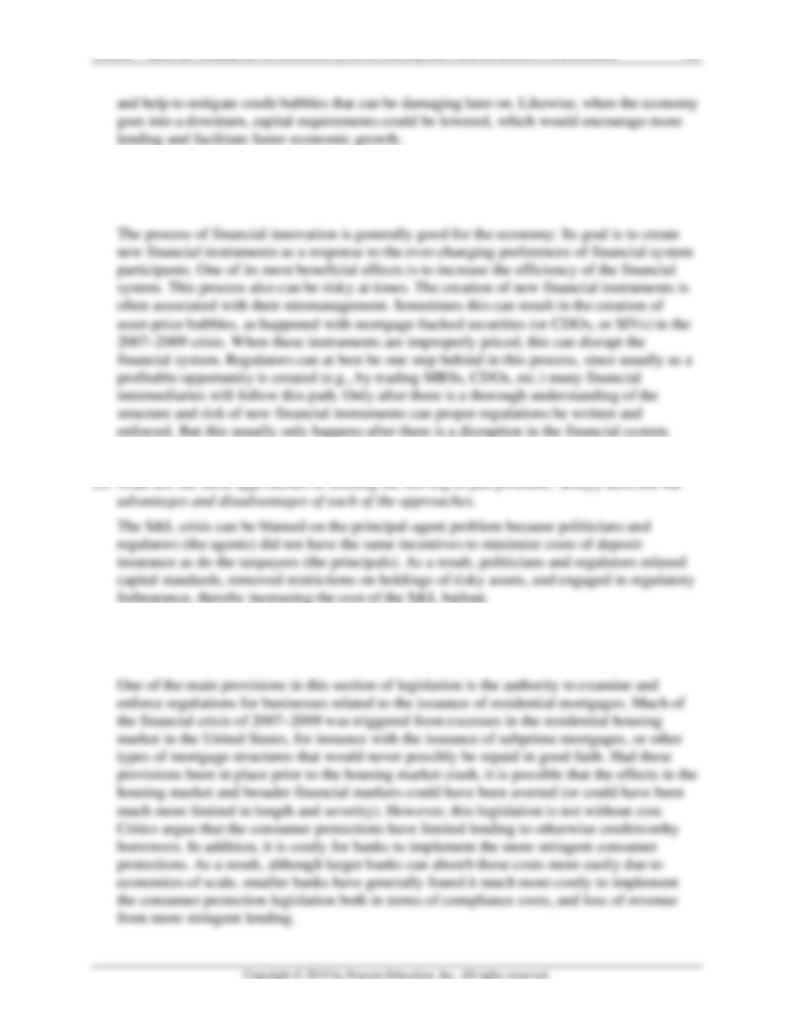
Mishkin • Instructor’s Manual for The Economics of Money, Banking, and Financial Markets, Twelfth Edition 148
22. How does the process of financial innovation impact the effectiveness of macroprudential
regulation?
24. Why were consumer protection provisions included in the Dodd-Frank bill, a bill designed to
strengthen the financial system? What are some of the problems with these regulations?
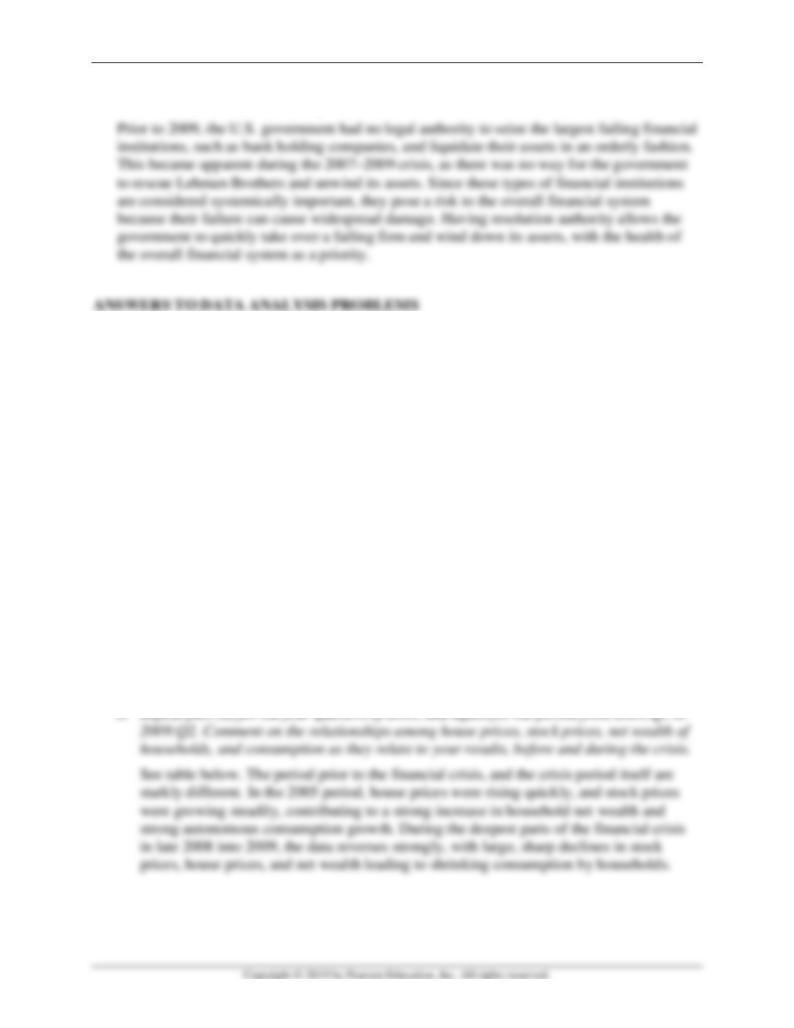
Mishkin • Instructor’s Manual for The Economics of Money, Banking, and Financial Markets, Twelfth Edition 149
25. Why is it important for the U.S. government to have resolution authority?
1. Go to the St. Louis Federal Reserve FRED database and find data on house prices
(SPCS20RSA), stock prices (SP500), a measure of the net wealth of households
(TNWBSHNO), and personal consumption expenditures (PCEC). For all four measures, be
sure to convert the frequency setting to “Quarterly.” Download the data into a spreadsheet,
and make sure the data align correctly with the appropriate dates. For all four series, for
each quarter, calculate the annualized growth rate from quarter to quarter. To do this, take
the current-period data minus the previous-quarter data, and then divide by the previous
quarter data. Multiply by 100 to change each result to a percent, and multiply by 4 to
annualize the data.
a. For the four series, calculate the average growth rates over the most recent four quarters
of data available. Comment on the relationships among house prices, stock prices, net
wealth of households, and consumption as they relate to your results.
See table below. From the most recent available data from 2016:Q2 to 2017:Q1, all four
data series are showing healthy gains, and are sensibly related to each other. Since
homeowner’s equity and retirement or stock portfolios are the two biggest sources of
wealth for households, you would expect those to be closely related to net wealth of
households. And since net wealth grew substantially, you would expect autonomous
consumption to rise, which appears evident in the growth in consumption of almost 5%.
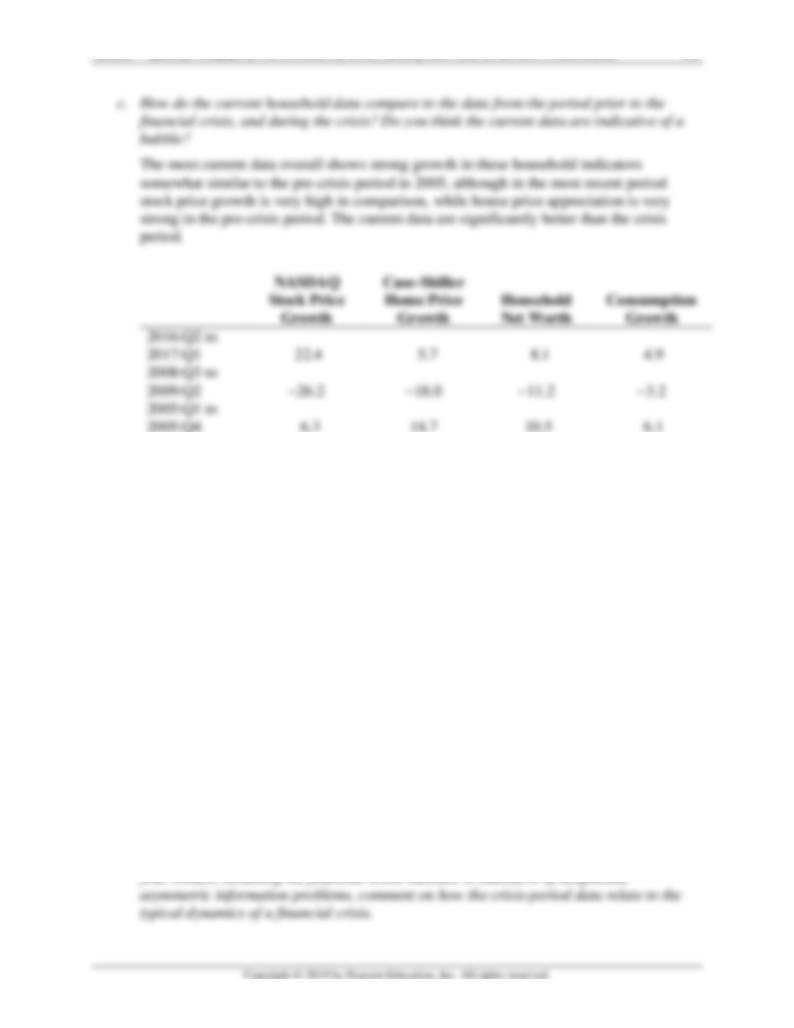
Mishkin • Instructor’s Manual for The Economics of Money, Banking, and Financial Markets, Twelfth Edition 150
2. Go to the St. Louis Federal Reserve FRED database and find data on corporate net worth of
nonfinancial businesses (TNWMVBSNNCB), private domestic investment (GPDIC1), and a
measure of financial frictions, the St. Louis Fed financial stress index (STLFSI). For all three
measures, be sure to convert the frequency setting to “Quarterly.” Download the data into a
spreadsheet, and make sure the data align correctly with the appropriate dates. For
corporate net worth and private domestic investment, calculate the annualized growth rates
from quarter to quarter. To do this, take the current-period data minus the previous-quarter
data, then divide by the previous quarter data. Multiply by 100 to change the results to
percentage form, and then multiply by 4 to annualize the data.
a. Calculate the average growth rates over the most recent four quarters of data available
for the corporate net worth and private domestic investment variables. Calculate the
difference between the value of the stress index during the most recent quarter and the
value of the stress index one year earlier. Comment on the relationships among financial
stress, net wealth of corporate businesses, and private domestic investment.
See table below. The most recent four quarters available from 2016:Q2 to 2017:Q1
indicates that financial frictions as measured by the stress index have fallen slightly, and
corporate net worth is growing at 6.8%; both of these factors should lead to an improving
lending and investment environment; however, in the most recent period investment grew
by a relatively moderate rate of 1.9%.
b. Repeat part (a) for the four quarters of 2005 and for the period from 2008:Q3 to
2009:Q2. Comment on the relationships among financial stress, net wealth of corporate
businesses, and private domestic investment before and during the crisis as they relate to
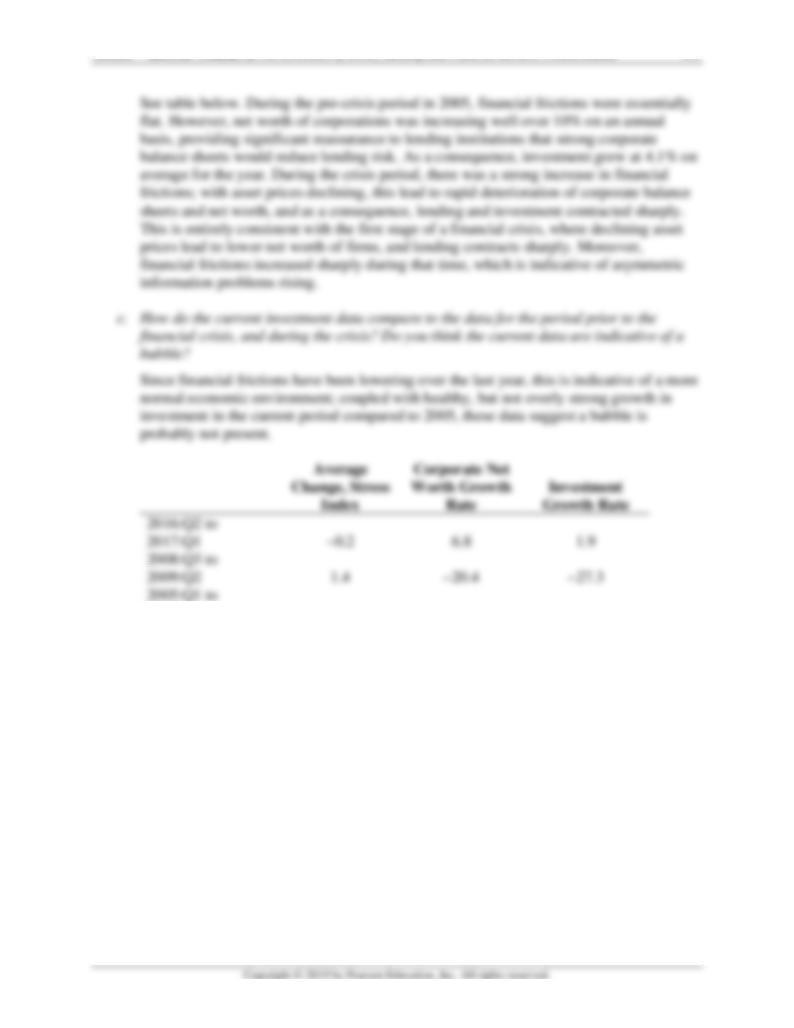
Mishkin • Instructor’s Manual for The Economics of Money, Banking, and Financial Markets, Twelfth Edition 151
2005:Q4
0.0
11.4
4.1

Mishkin • Instructor’s Manual for The Economics of Money, Banking, and Financial Markets, Twelfth Edition 152
Chapter 13
1. Why was the Federal Reserve System set up with twelve regional Federal Reserve Banks,
rather than one central bank as in other countries?
2. Why is the Twelfth Federal Reserve district (San Francisco) so geographically large, while the
Second Federal Reserve district (New York) is so small by comparison?
3. Should the Federal Reserve redraw its district boundaries, similar to the manner in which
congressional districts are periodically realigned? Why or why not?
4. “The Federal Reserve System resembles the U.S. Constitution in that it was designed with
many checks and balances.” Is this statement true, false, or uncertain? Explain your answer.
True. Like the U.S. Constitution, the Federal Reserve System, originally established by the
Federal Reserve Act, has many checks and balances and is a peculiarly American institution.
5. Which entities in the Federal Reserve System control the discount rate? Reserve requirements?
Open market operations?
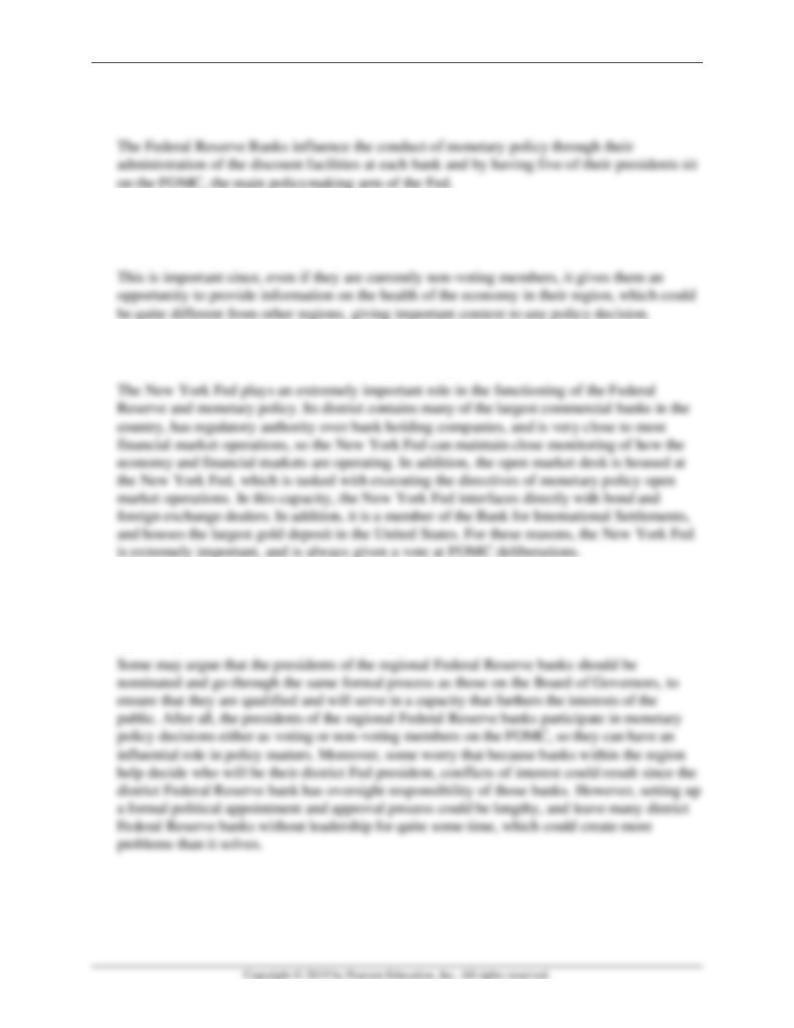
Mishkin • Instructor’s Manual for The Economics of Money, Banking, and Financial Markets, Twelfth Edition 153
6. In what ways can the regional Federal Reserve Banks influence the conduct of monetary
policy?
7. Why is it important for the regional Federal Reserve Bank presidents to attend the FOMC
meetings, even if they are nonvoting members?
8. Why is the New York Federal Reserve always a voting member of the FOMC?
9. The presidents of each of the district Federal Reserve Banks (including the New York Federal
Reserve Bank) are currently not required to undergo a formal political appointment and
approval process. Do you think this is appropriate? Why or why not?
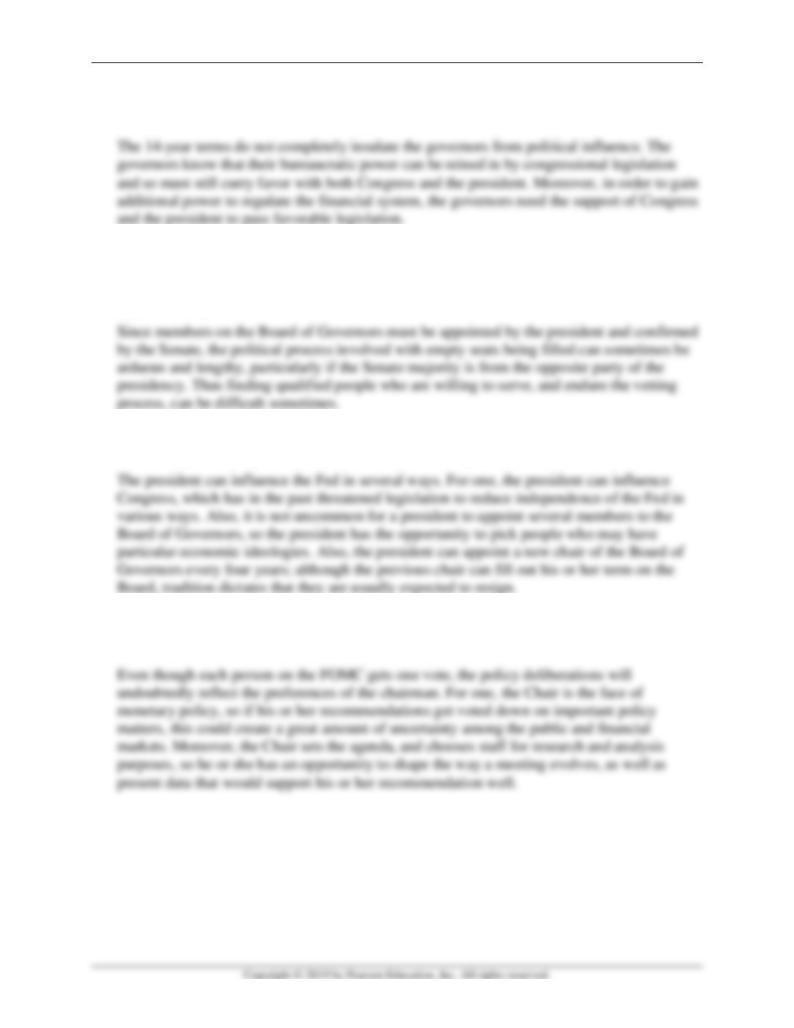
Mishkin • Instructor’s Manual for The Economics of Money, Banking, and Financial Markets, Twelfth Edition 154
10. Do you think that the fourteen-year, nonrenewable terms for governors effectively insulate
the Board of Governors from political pressure?
11. Despite the important role played by the Board of Governors in setting monetary policy,
seats to serve on the Board of Governors can sometimes be empty for several years. How
might this happen?
12. How is the president of the United States able to exert influence over the Federal Reserve?
13. Why is it unlikely that the policy recommendation put forth by the chair of the Board of
Governors would ever be voted down by the rest of the FOMC?
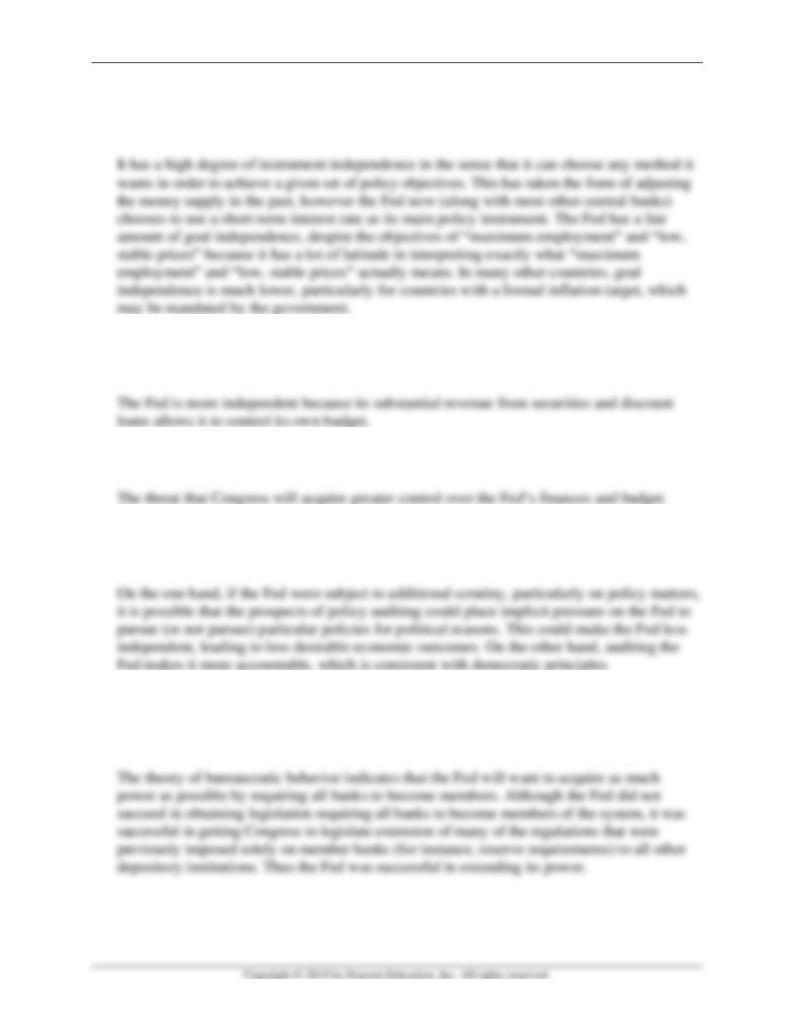
Mishkin • Instructor’s Manual for The Economics of Money, Banking, and Financial Markets, Twelfth Edition 155
14. In what way does the Federal Reserve have a high degree of instrument independence? If it
has a specific mandate from Congress to achieve “maximum employment and low, stable
prices,” then how does the Fed have goal independence?
15. The Fed is the most independent of all U.S. government agencies. What is the main difference
between it and other government agencies that explains the Fed’s greater independence?
16. What is the primary tool that Congress uses to exercise some control over the Fed?
17. Should the Federal Reserve be subject to periodic auditing of its policies, procedures, and
finances? Why or why not?
18. In the 1960s and 1970s, the Federal Reserve System lost member banks at a rapid rate. How
can the theory of bureaucratic behavior explain the Fed’s campaign for legislation to require
all commercial banks to become members? Was the Fed successful in this campaign?

Mishkin • Instructor’s Manual for The Economics of Money, Banking, and Financial Markets, Twelfth Edition 156
20. Why might eliminating the Fed’s independence lead to a more pronounced political business
cycle?
22. “The independence of the Fed means that it takes the long view and not the short view.”
Is this statement true, false, or uncertain? Explain your answer.
23. The Fed promotes secrecy by not releasing the minutes of FOMC meetings to Congress or the
public immediately. Discuss the arguments for and against this policy.
24. Which is more independent, the Federal Reserve or the European Central Bank? Why?
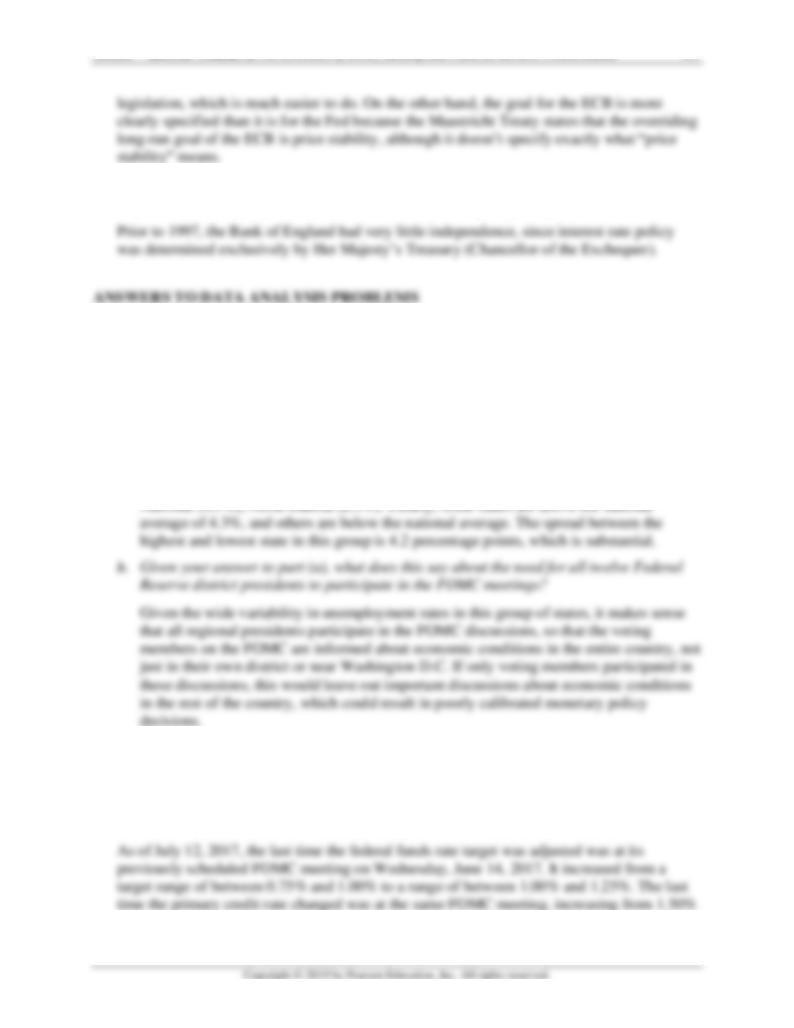
Mishkin • Instructor’s Manual for The Economics of Money, Banking, and Financial Markets, Twelfth Edition 157
25. Why did the Bank of England up until 1997 have a low degree of independence?
1. Go to the St. Louis Federal Reserve FRED database and find data on the unemployment rate
in the following states: Kentucky (KYUR), North Dakota (NDUR), Alaska (AKUR), New York
(NYUR), Alabama (ALUR), Texas (TXUR), and the national unemployment rate (UNRATE)
a. For the most recent month of data available, determine which of those states had the
highest, and which had the lowest, unemployment rate; how do these compare to the
national average?
For May 2017, the unemployment rates for the states are listed from highest to lowest:
Alaska (6.7%), Kentucky (5%), Alabama (4.9%), Texas (4.8%), New York (4.4%),
2. Go to the St. Louis Federal Reserve FRED database and find data on the federal funds rate
target (DFEDTAR, DFEDTARU, and DFEDTARL) and the discount, or primary credit rate
(DPCREDIT). When was the last time the federal funds rate target was changed? When was
the last time the primary credit rate was changed? Did the rates increase or decrease?
to 1.75%.
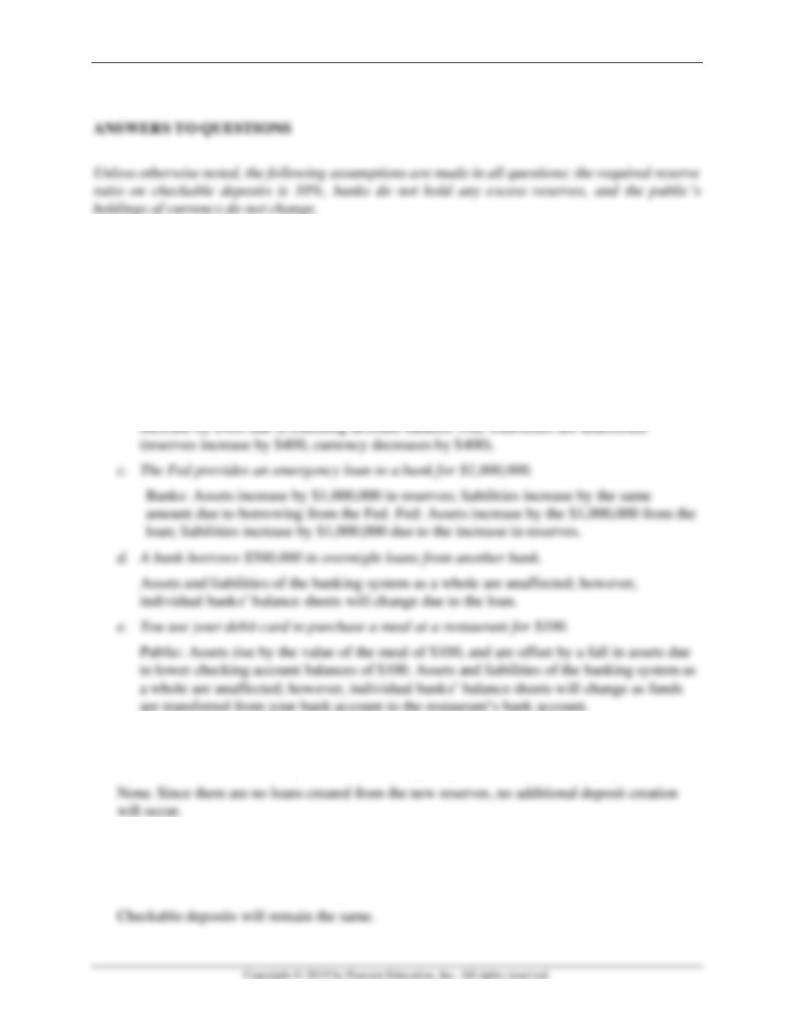
Mishkin • Instructor’s Manual for The Economics of Money, Banking, and Financial Markets, Twelfth Edition 158
Chapter 14
1. Classify each of these transactions as an asset, a liability, or neither for each of the
“players” in the money supply process—the federal reserve, banks, and depositors.
a. You get a $10,000 loan from the bank to buy an automobile.
Public: Assets rise by $10,000 due to automobile purchase, liabilities rise by $10,000 due
to loan. Banks: Assets rise by $10,000 due to loan; this is offset by a decrease in reserves
assets of $10,000.
b. You deposit $400 into your checking account at the local bank.
Public: Assets are unaffected ($400 increase in checking deposits is offset by a $400
decrease in currency holdings). Banks: Assets increase by $400 from reserves; liabilities
2. The First National Bank receives an extra $100 of reserves but decides not to lend out any of
these reserves. How much deposit creation takes place for the entire banking system?
3. Suppose the Fed buys $1 million of bonds from the First National Bank. If the First National
Bank and all other banks use the resulting increase in reserves to purchase securities only
and not to make loans, what will happen to checkable deposits?
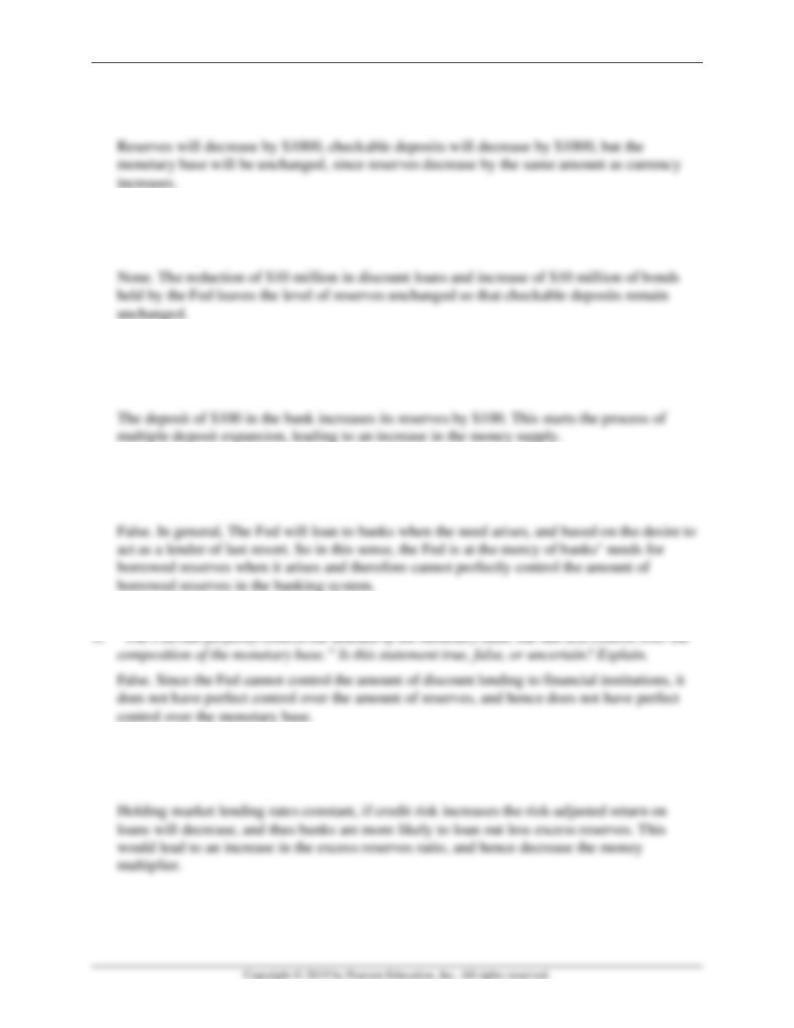
Mishkin • Instructor’s Manual for The Economics of Money, Banking, and Financial Markets, Twelfth Edition 159
4. If a bank depositor withdraws $1,000 of currency from an account, what happens to
reserves, checkable deposits, and the monetary base?
5. If a bank sells $10 million of bonds to the Fed to pay back $10 million on the loan it owes,
what is the effect on the level of checkable deposits?
6. If you decide to hold $100 less cash than usual and therefore deposit $100 more cash in the
bank, what effect will this have on checkable deposits in the banking system if the rest of the
public keeps its holdings of currency constant?
7. “The Fed can perfectly control the amount of borrowed reserves in the banking system” Is
this statement true, false, or uncertain?
9. If credit risk in the banking system increases, all else equal what effect, if at all, will this
have on the money multiplier?
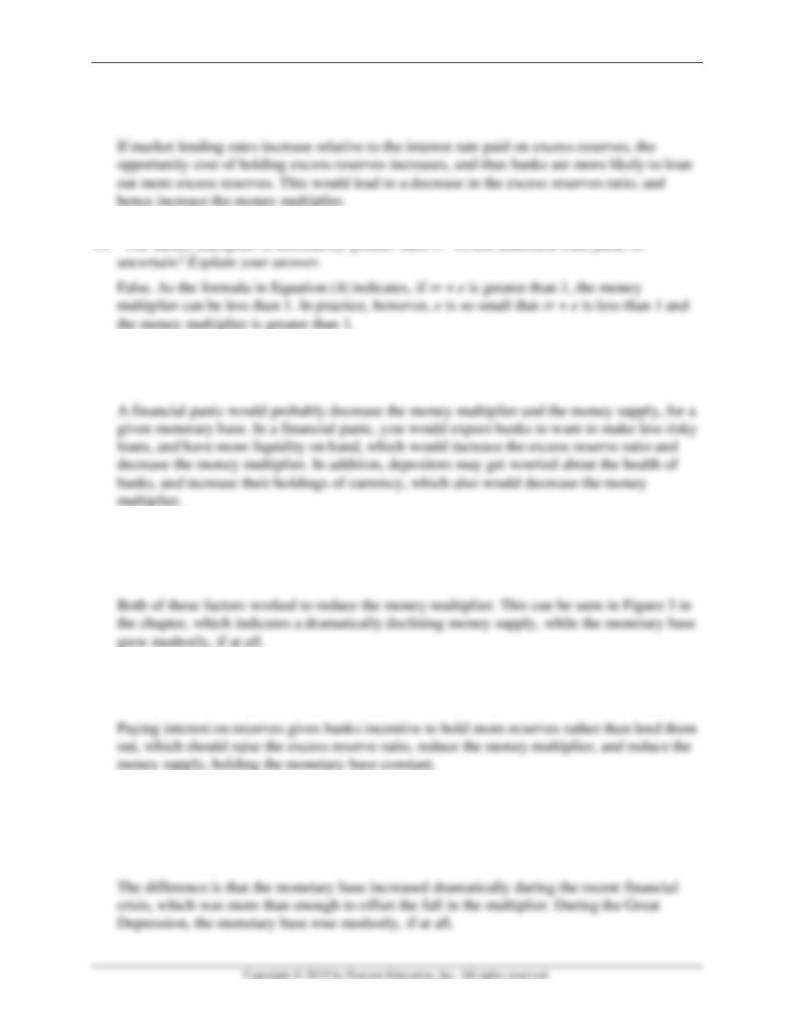
Mishkin • Instructor’s Manual for The Economics of Money, Banking, and Financial Markets, Twelfth Edition 160
10. If lending rates that banks can charge increase, all else equal what effect, if at all, will this
have on the money multiplier?
12. What effect might a financial panic have on the money multiplier and the money supply?
Why?
13. During the Great Depression years from 1930–1933, both the currency ratio c and the
excess reserves ratio e rose dramatically. What effect did these factors have on the money
multiplier?
14. In October 2008, the Federal Reserve began paying interest on the amount of excess reserves
held by banks. How, if at all, might this affect the multiplier process and the money supply?
15. The money multiplier declined significantly during the period 1930–1933 and also during the
recent financial crisis of 2008–2010. Yet the M1 money supply decreased by 25% in the
Depression period but increased by more than 20% during the recent financial crisis. What
explains the difference in outcomes?
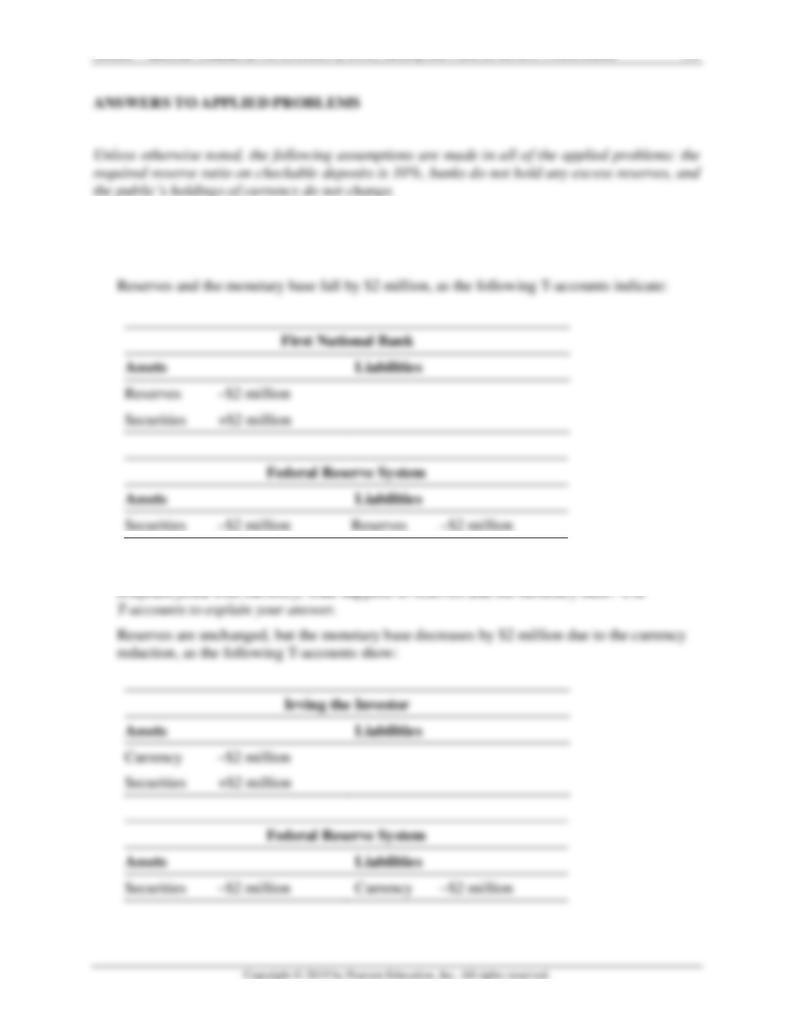
Mishkin • Instructor’s Manual for The Economics of Money, Banking, and Financial Markets, Twelfth Edition 161
16. If the Fed sells $2 million of bonds to the First National Bank, what happens to reserves and
the monetary base? Use T-accounts to explain your answer.
17. If the Fed sells $2 million of bonds to Irving the Investor, who pays for the bonds with a
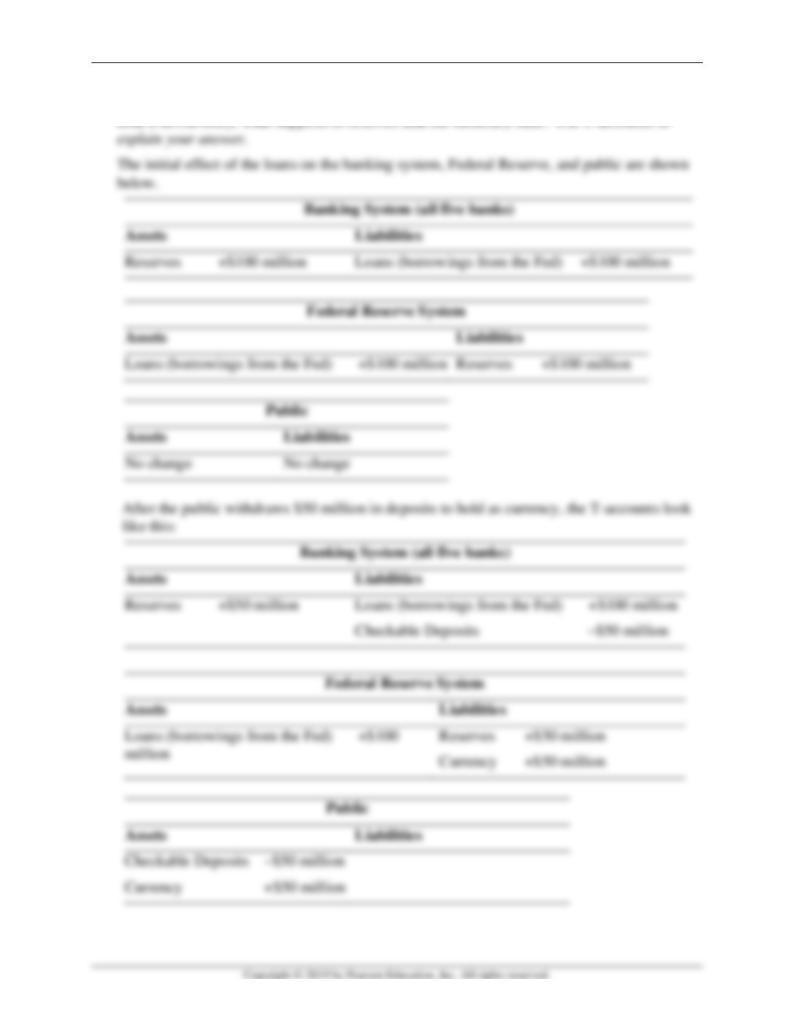
Mishkin • Instructor’s Manual for The Economics of Money, Banking, and Financial Markets, Twelfth Edition 162
18. If the Fed lends five banks a total of $100 million but depositors withdraw $50 million and

Mishkin • Instructor’s Manual for The Economics of Money, Banking, and Financial Markets, Twelfth Edition 163
19. Using T-accounts, show what happens to checkable deposits in the banking system when the
Fed lends $1 million to the First National Bank.
The initial effect of the loans provided by the Fed is shown in the T-accounts below:
Federal Reserve System
Assets
Liabilities
Loans (borrowings from the Fed) +$1 million
Reserves +$1 million
Banking System
Assets
Liabilities
Reserves +$1 million
Loans (borrowings from the Fed) +$1 million
20. Using T-accounts, show what happens to checkable deposits in the banking system when the
Fed sells $2 million of bonds to the First National Bank.
The Fed sale of bonds to the First National Bank reduces reserves by $2 million. The net
result is that checkable deposits in the banking system decline by $20 million. The initial
effect on the Fed and the banking system is shown below:
Federal Reserve System
Assets
Liabilities
Securities –$2 million
Reserves –$2 million
Banking System
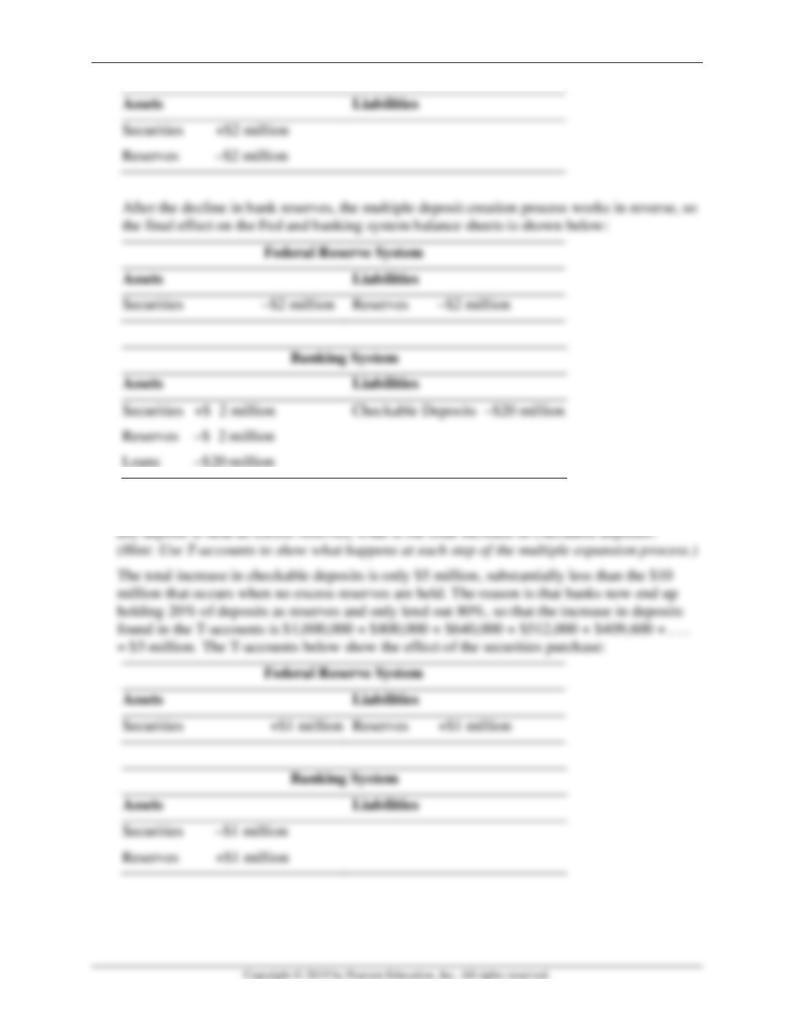
Mishkin • Instructor’s Manual for The Economics of Money, Banking, and Financial Markets, Twelfth Edition 164
21. If the Fed buys $1 million of bonds from the First National Bank, but an additional 10% of
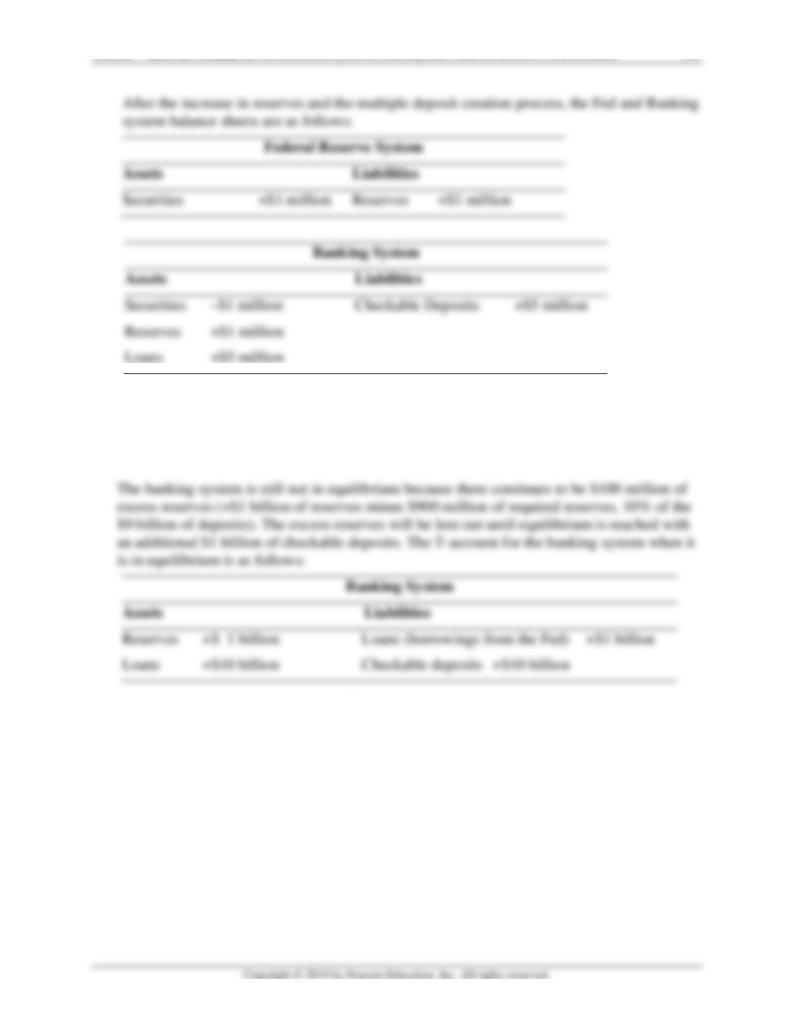
Mishkin • Instructor’s Manual for The Economics of Money, Banking, and Financial Markets, Twelfth Edition 165
22. If reserves in the banking system increase by $1 billion because the Fed lends $1 billion to
financial institutions, and checkable deposits increase by $9 billion, why isn’t the banking
system in equilibrium? What will continue to happen in the banking system until equilibrium
is reached? Show the T-account for the banking system in equilibrium.
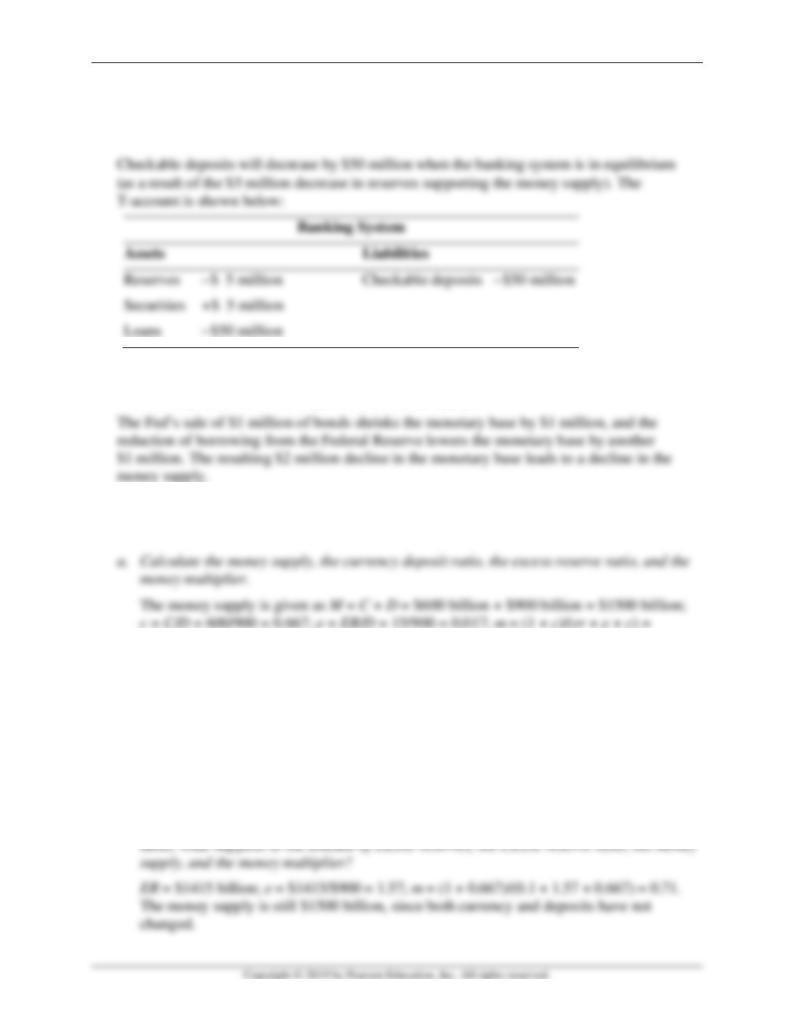
Mishkin • Instructor’s Manual for The Economics of Money, Banking, and Financial Markets, Twelfth Edition 166
23. If the Fed reduces reserves by selling $5 million worth of bonds to the banks, what will the
T-account of the banking system look like when the banking system is in equilibrium? What
will have happened to the level of checkable deposits?
24. If the Fed sells $1 million of bonds and banks reduce their borrowings from the Fed by
$1 million, predict what will happen to the money supply.
25. Suppose that currency in circulation is $600 billion, the amount of checkable deposits is
$900 billion, and excess reserves are $15 billion.
1.667/0.783 = 2.13.
b. Suppose the central bank conducts an unusually large open market purchase of bonds
held by banks of $1400 billion due to a sharp contraction in the economy. Assuming the
ratios you calculated in part (a) remain the same, predict the effect on the money supply.
The monetary base will increase to $600 + $90 + $15 + $1400 = $2105 billion; given the
money multiplier calculated in part (a), this implies the money supply should increase to
$2105 2.13 = $4483.65 billion
c. Suppose the central bank conducts the same open market purchase as in part (b), except
that banks choose to hold all of these proceeds as excess reserves rather than loan them
out, due to fear of a financial crisis. Assuming that currency and deposits remain the

Mishkin • Instructor’s Manual for The Economics of Money, Banking, and Financial Markets, Twelfth Edition 167
1. Go to the St. Louis Federal Reserve FRED database, and find the most current data
available on Currency (CURRNS), Total Checkable Deposits (TCDNS), Total Reserves
(RESBALNS), and Required Reserves (RESBALREQ).
a. Calculate the value of the currency deposit ratio c.
c = CURRNS/TCDNS = 1473.7/2020.0 = 0.73 as of May 2017.
is 2257.6/2635.1 = 0.86.
b. Based on your answer to part (a), how much would a $100 million open market purchase
of securities affect the M1 money supply today and five years ago?
0.68 $100 million = $68 million increase in M1 in May 2012.
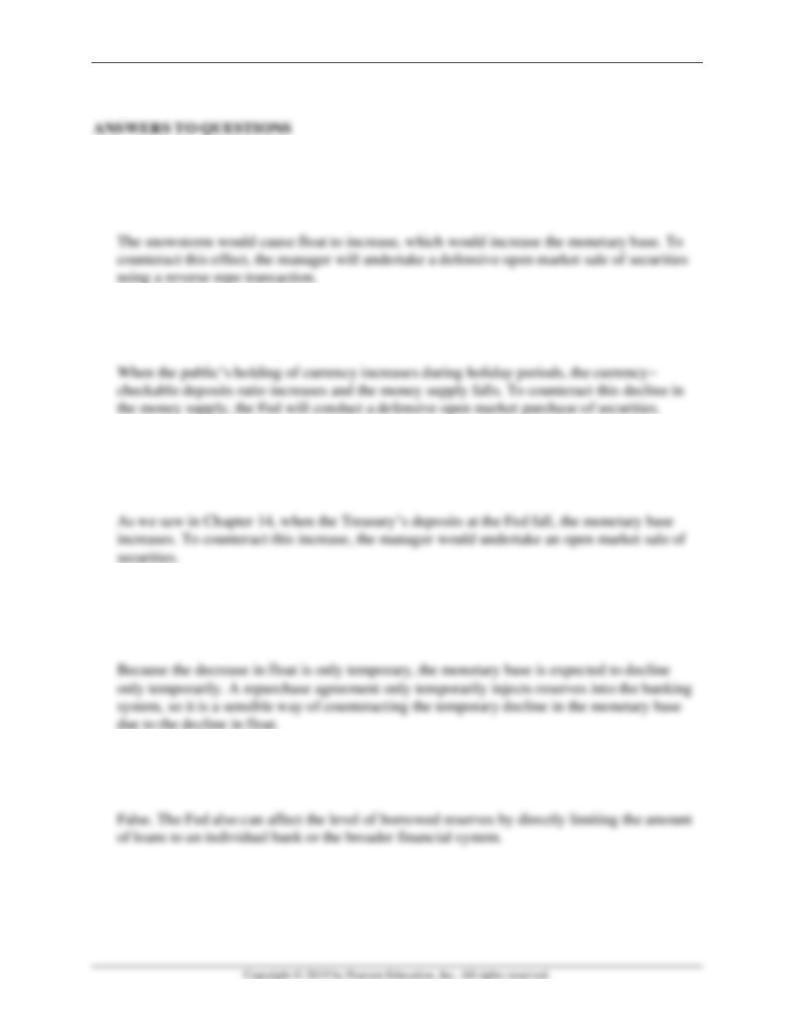
Mishkin • Instructor’s Manual for The Economics of Money, Banking, and Financial Markets, Twelfth Edition 168
Chapter 15
1. If the manager of the open market desk hears that a snowstorm is about to strike New York
City, making it difficult to present checks for payment there and so raising the float, what
defensive open market operations will the manager undertake?
2. During the holiday season, when the public’s holdings of currency increase, what defensive
open market operations typically occur? Why?
3. If the Treasury pays a large bill to defense contractors and as a result its deposits with the
Fed fall, what defensive open market operations will the manager of the open market desk
undertake?
4. If float decreases to below its normal level, why might the manager of domestic operations
consider it more desirable to use repurchase agreements to affect the monetary base, rather
than an outright purchase of bonds?
5. “The only way that the Fed can affect the level of borrowed reserves is by adjusting the
discount rate.” Is this statement true, false, or uncertain? Explain your answer.
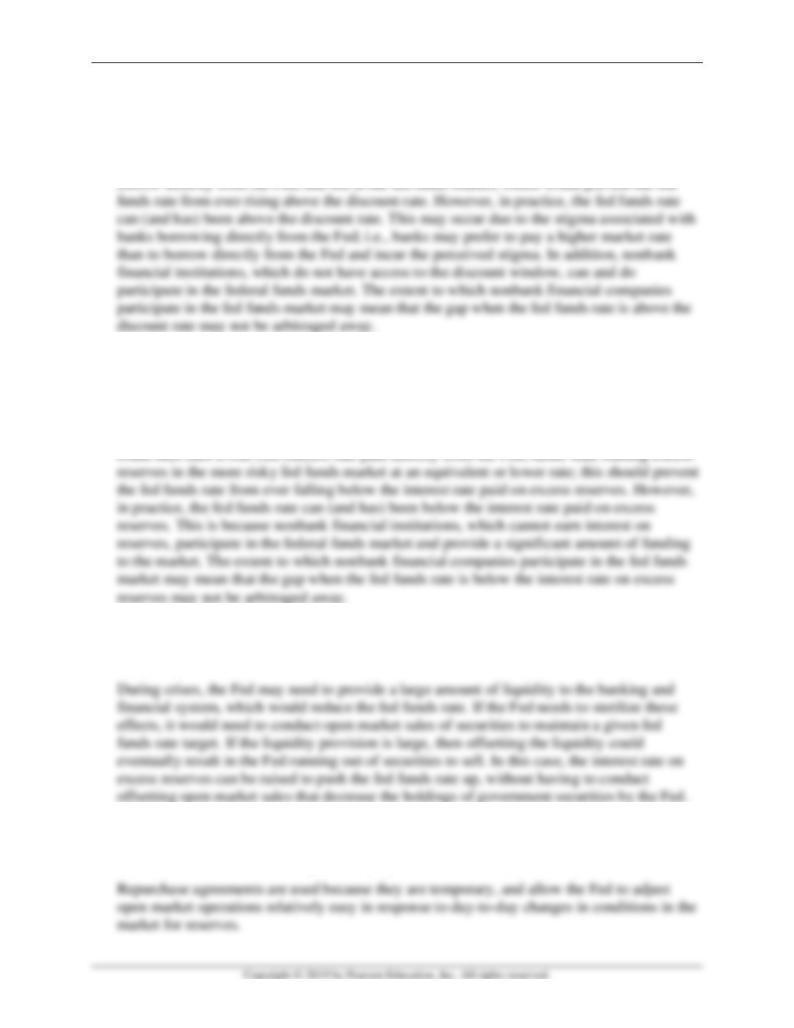
Mishkin • Instructor’s Manual for The Economics of Money, Banking, and Financial Markets, Twelfth Edition 169
6. “The federal funds rate can never be above the discount rate.” Is this statement true, false,
or uncertain? Explain your answer.
Uncertain. In theory, the market for reserves model indicates that once the fed funds rate
reaches the discount rate, it would never surpass the discount rate since banks would then
7. “The federal funds rate can never be below the interest rate paid on excess reserves.” Is this
statement true, false, or uncertain? Explain your answer.
Uncertain. In theory, the market for reserves model indicates that once the fed funds rate
reaches the interest rate on excess reserves, it would never go below this rate since banks
8. Why is paying interest on excess reserves an important tool for the Federal Reserve in
managing crises?
9. Why are repurchase agreements used to conduct most short-term monetary policy
operations, rather than the simple, outright purchase and sale of securities?
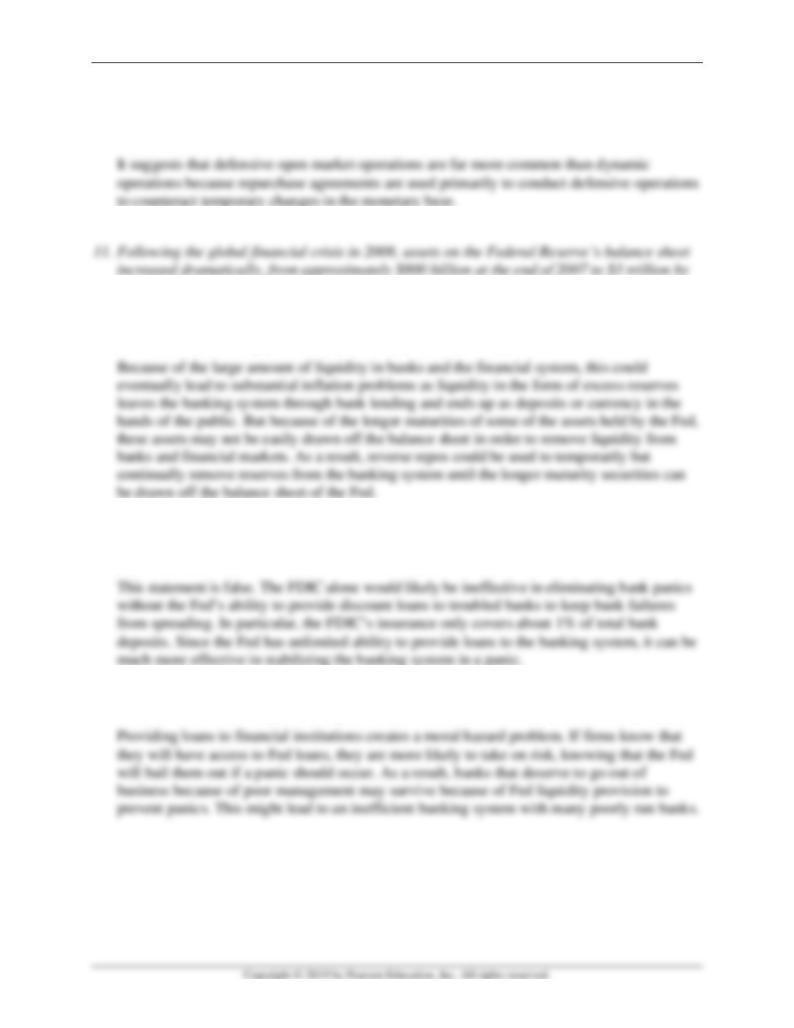
Mishkin • Instructor’s Manual for The Economics of Money, Banking, and Financial Markets, Twelfth Edition 170
10. Open market operations are typically repurchase agreements. What does this tell you about
the likely volume of defensive open market operations relative to the volume of dynamic open
market operations?
2011. Many of the assets held are longer-term securities acquired through various loan
programs instituted as a result of the crisis. In this situation, how could reverse repos
(matched sale–purchase transactions) help the Fed reduce its assets held in an orderly
fashion, while reducing potential inflationary problems in the future?
12. “Discount loans are no longer needed because the presence of the FDIC eliminates the
possibility of bank panics.” Is this statement true, false, or uncertain?
13. What are the disadvantages of using loans to financial institutions to prevent bank panics?
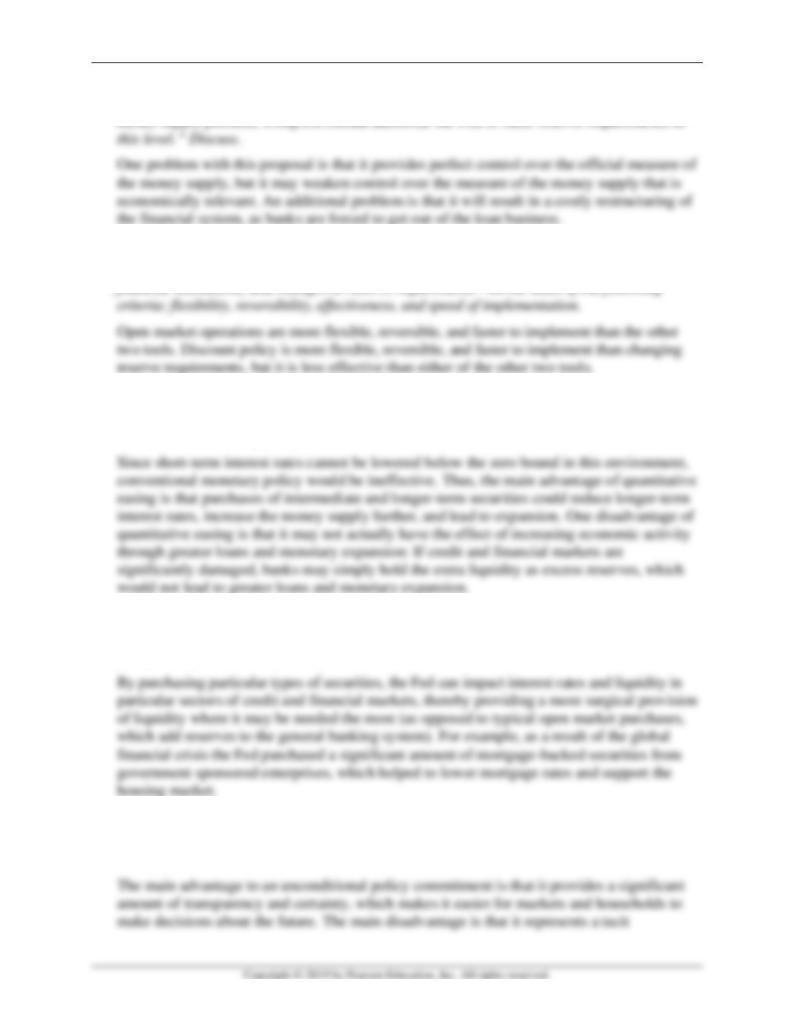
Mishkin • Instructor’s Manual for The Economics of Money, Banking, and Financial Markets, Twelfth Edition 171
14. “Considering that raising reserve requirements to 100% makes complete control of the
15. Compare the methods of controlling the money supply—open market operations, loans to
16. What are the advantages and disadvantages of quantitative easing as an alternative to
conventional monetary policy when short-term interest rates are at the zero lower bound?
17. Why is the composition of the Fed’s balance sheet a potentially important aspect of monetary
policy during an economic crisis?
18. What is the main advantage and the main disadvantage of an unconditional policy
commitment?
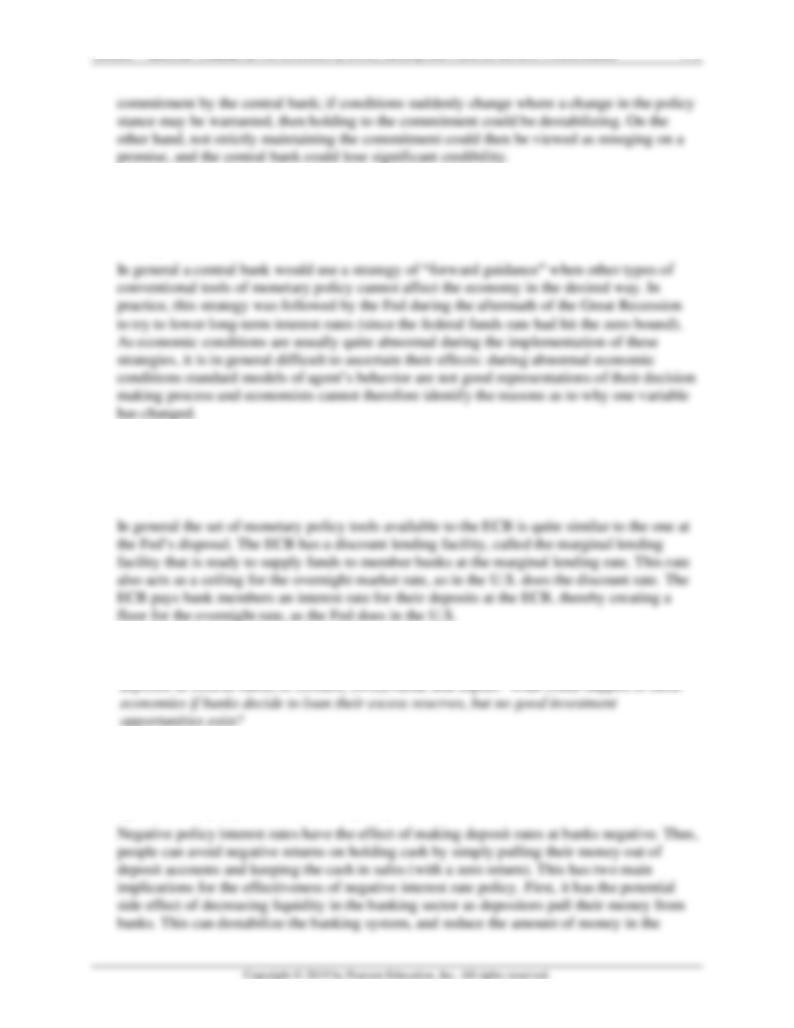
Mishkin • Instructor’s Manual for The Economics of Money, Banking, and Financial Markets, Twelfth Edition 172
19. In which economic conditions would a central bank want to use a “forward-guidance”
strategy? Based on your previous answer, can we easily measure the effects of such a
strategy?
20. How do the monetary policy tools of the European System of Central Banks compare to the
monetary policy tools of the Fed? Does the ECB have a discount lending facility? Does the
ECB pay banks an interest rate on their deposits?
21. What is the main rationale behind paying negative interest rates to banks for keeping their
22. In early 2016 as the Bank of Japan began to push policy interest rates negative, there was a
sharp increase in sales for home in Japan. Why might this be, and what does it mean for the
effectiveness of negative interest rate policy?
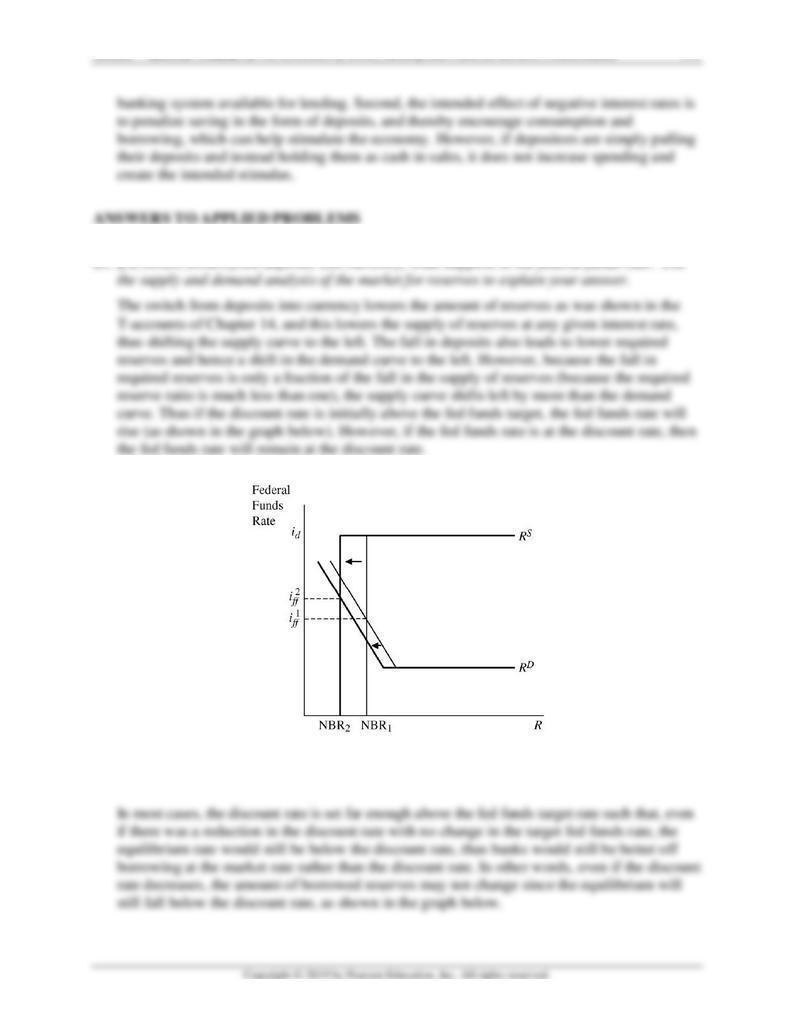
Mishkin • Instructor’s Manual for The Economics of Money, Banking, and Financial Markets, Twelfth Edition 173
24. Why is it that a decrease in the discount rate does not normally lead to an increase in
borrowed reserves? Use the supply and demand analysis of the market for reserves to explain.
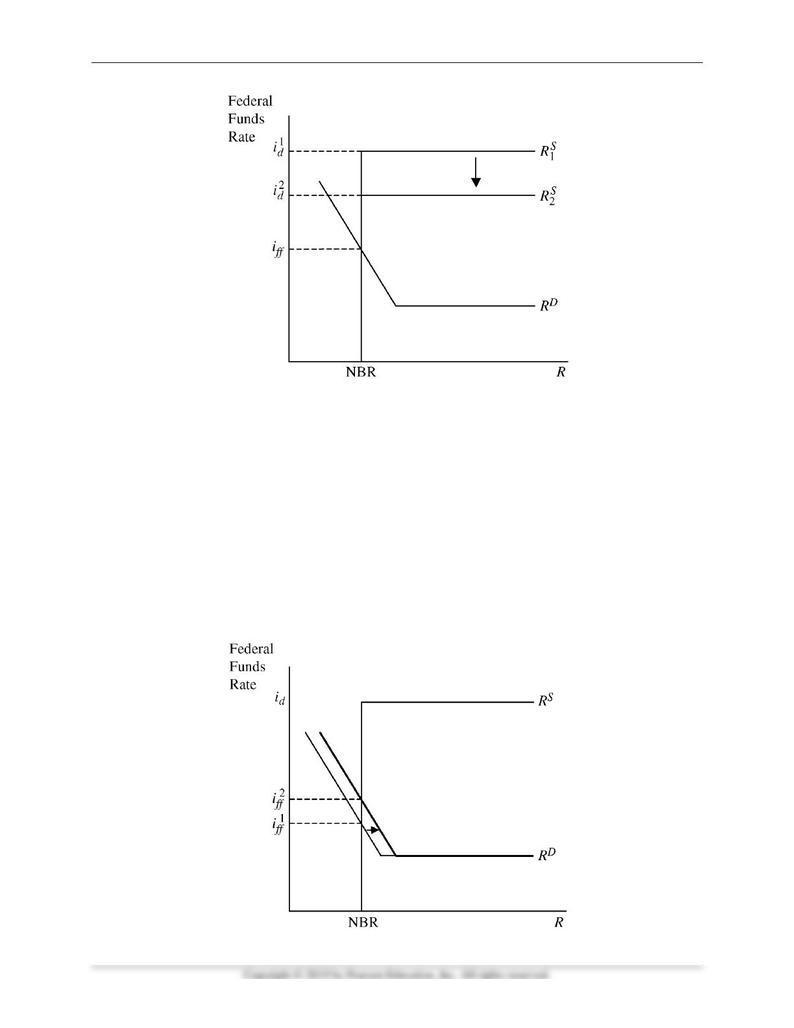
Mishkin • Instructor’s Manual for The Economics of Money, Banking, and Financial Markets, Twelfth Edition 174
25. Using the supply and demand analysis of the market for reserves, indicate what happens to
the federal funds rate, borrowed reserves, and nonborrowed reserves, holding everything
else constant, under the following situations.
a. The economy is surprisingly strong, leading to an increase in the amount of checkable
deposits.
A rise in checkable deposits leads to a rise in required reserves at any given interest rate,
and thus shifts the demand curve to the right. If the federal funds rate is initially below the
discount rate, this then leads to a rise in the federal funds rate. As shown below, borrowed
reserves and non-borrowed reserves do not change. If the federal funds rate is initially at
the discount rate, then the federal funds rate will just remain at the discount rate, but
borrowed reserves will increase.

Mishkin • Instructor’s Manual for The Economics of Money, Banking, and Financial Markets, Twelfth Edition 175
b. Banks expect an unusually large increase in withdrawals from checking deposit accounts
in the future.
If banks expect that an unusually large increase in withdrawals will occur in the future,
they will want to hold more excess reserves today, meaning the demand for reserves will
increase at any given interest rate. This will have the same effect on the fed funds rate,
NBR, and BR as in part (a) above.
c. The Fed raises the target federal funds rate.
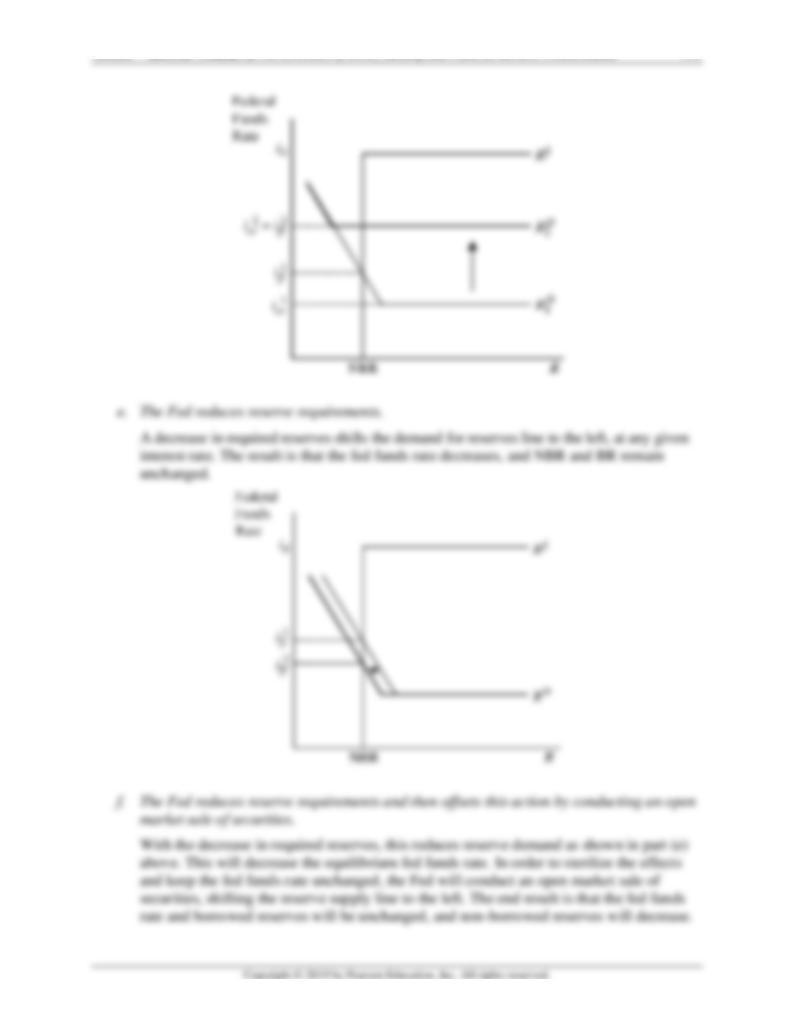
Mishkin • Instructor’s Manual for The Economics of Money, Banking, and Financial Markets, Twelfth Edition 176
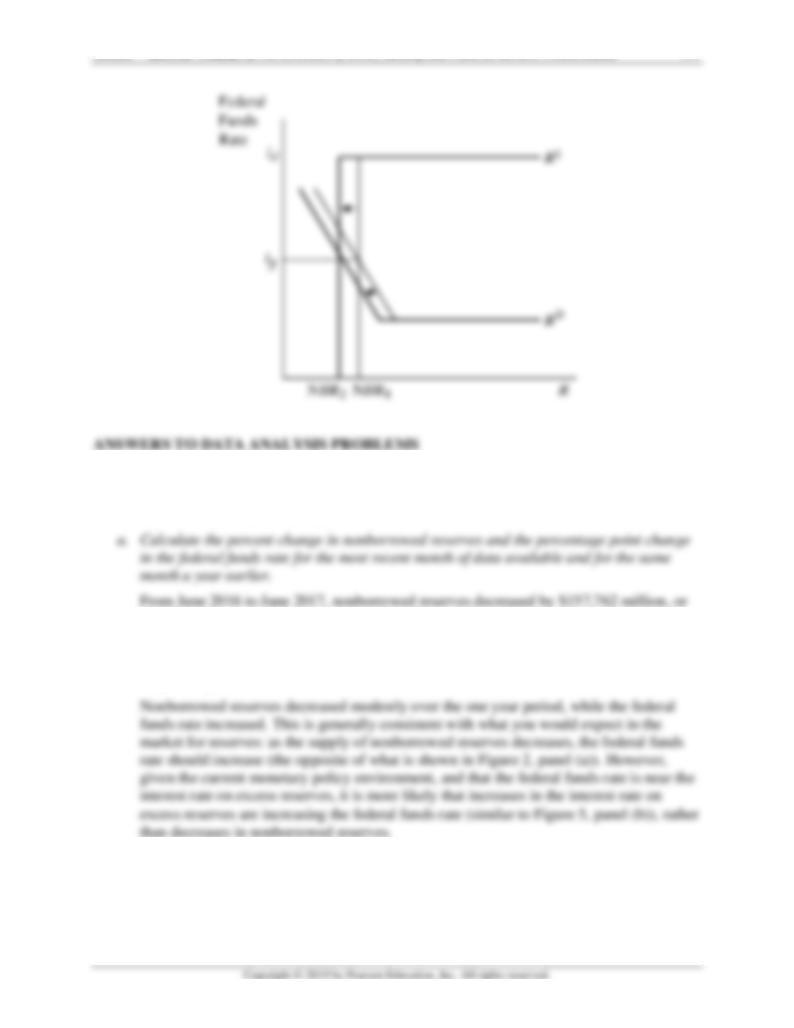
Mishkin • Instructor’s Manual for The Economics of Money, Banking, and Financial Markets, Twelfth Edition 177
1. Go to the St. Louis Federal Reserve FRED database, and find data on nonborrowed reserves
(NONBORRES) and the federal funds rate (FEDFUNDS).
–6.5% and the federal funds rate increased from 0.38% to 1.04%, or an increase of 66
basis points.
b. Is your answer to part (a) consistent with what you expect from the market for reserves?
Why or why not?
2. In December 2008, the Fed switched from a point federal funds target to a range target
(and it’s possible that it will switch back to a point target in the future). Go to the St. Louis
Federal Reserve FRED database, and find data on the federal funds targets/ ranges
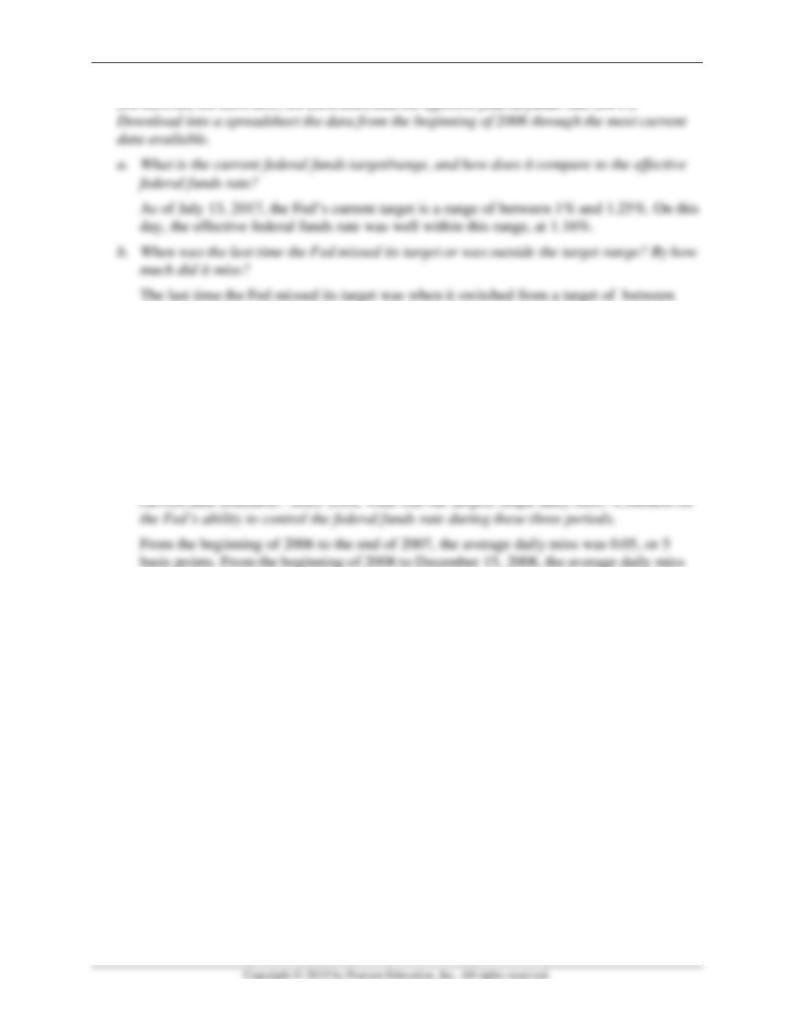
Mishkin • Instructor’s Manual for The Economics of Money, Banking, and Financial Markets, Twelfth Edition 178
0.25 and 0.5%% to a target of between 0.5% and 0.75% which occurred on December
14, 2016. At that time, the effective federal funds rate was 0.41% compared to the target
of between 0.5% and 0.75%. This represents a miss of 9 basis points.
c. For each daily observation, calculate the “miss” by taking the absolute value of the
difference between the effective federal funds rate and the target (use the abs(.) function).
For the periods in which the rate was a range, calculate the absolute value of the “miss”
as the amount by which the effective federal funds rate was above or below the range.
What was the average daily miss between the beginning of 2006 and the end of 2007?
What was the average daily miss between the beginning of 2008 and December 15,
2008? What is the average daily miss for the period from December 16, 2008, to the most
was 0.22, or 22 basis points. From December 16, 2008 through July 13, 2017, the federal
funds target was specified as a range, and the effective federal funds rate was outside of
that range only a few times for brief periods by very small amounts, thus the average
miss during that time is essentially zero. The largest single daily miss occurred on
October 2, 2008, representing a miss of 1.33, or 133 basis points. In the earlier period,
and the most recent period, the Fed has demonstrated relatively good precision in
maintaining the federal funds rate close to target, but for somewhat different reasons. In
the 2006-2007 period, reserve demand was relatively stable, so it was relatively easier to
conduct defensive open market operations to keep the effective federal funds rate close to
target. In the most recent period, because a range is specified, it is somewhat easier to
keep the federal funds rate within target range. In addition, given the large size of the
balance sheet, any variation in reserve demand won’t affect the effective federal funds
rate much since it is pinned by the interest rate on excess reserves. The period in 2008
represented a much more volatile period where the Fed missed its target often, and
sometimes by large amounts. Due to the effects of the global financial crisis and
uncertainty in financial markets, large unpredictable swings in reserve demand meant
greater fluctuations in the effective federal funds rate, and due to the unpredictable nature
of these events, made it harder for the Fed to conduct defensive open market operations
as effectively to maintain the federal funds rate at target.
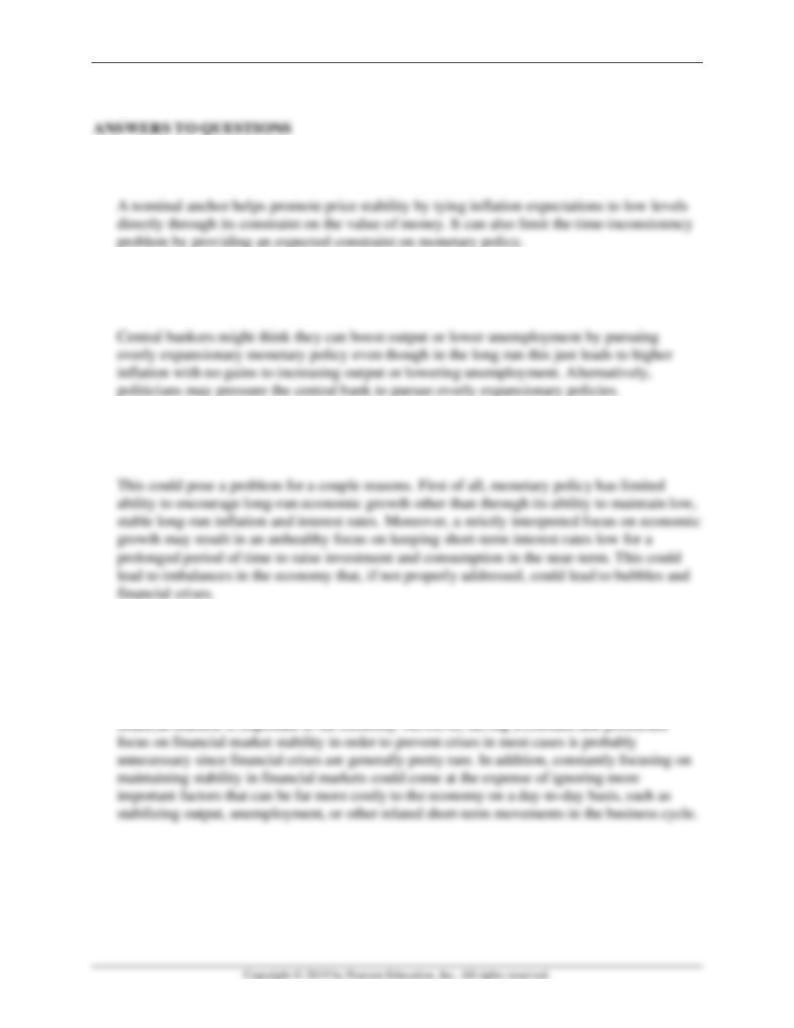
Mishkin • Instructor’s Manual for The Economics of Money, Banking, and Financial Markets, Twelfth Edition 179
Chapter 16
1. What are the benefits of using a nominal anchor for the conduct of monetary policy?
2. What incentives arise for a central bank to fall into the time-inconsistency trap of pursuing
overly expansionary monetary policy?
3. Why would it be problematic for a central bank to have a primary goal of maximizing
economic growth?
4. “Since financial crises can impart severe damage to the economy, a central bank’s primary
goal should be to ensure stability in financial markets.” Is this statement true, false, or
uncertain? Explain.
Uncertain. Most economists probably would not dispute that trying to maintain stability in
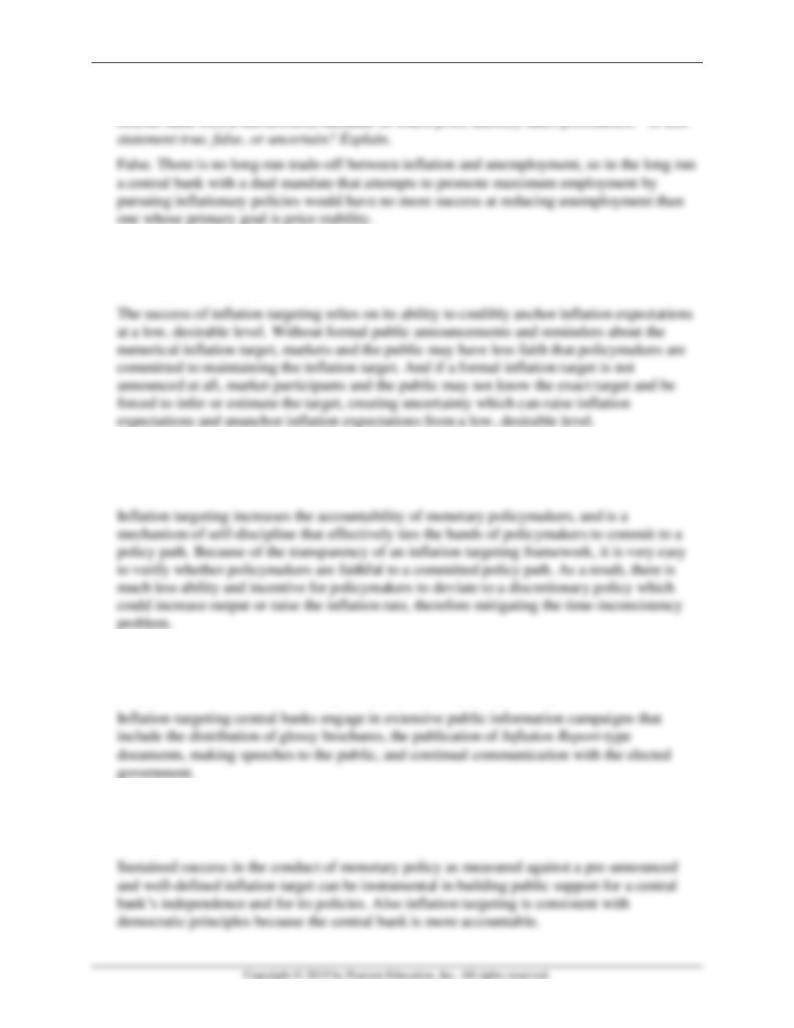
Mishkin • Instructor’s Manual for The Economics of Money, Banking, and Financial Markets, Twelfth Edition 180
5. “A central bank with a dual mandate will achieve lower unemployment in the long run than a
6. Why is a public announcement of numerical inflation rate objectives important to the success
of an inflation-targeting central bank?
7. How does inflation targeting help reduce the time-inconsistency problem of discretionary
policy?
8. What methods have inflation-targeting central banks used to increase communication with
the public and to increase the transparency of monetary policymaking?
9. Why might inflation targeting increase support for the independence of the central bank in
conducting monetary policy?
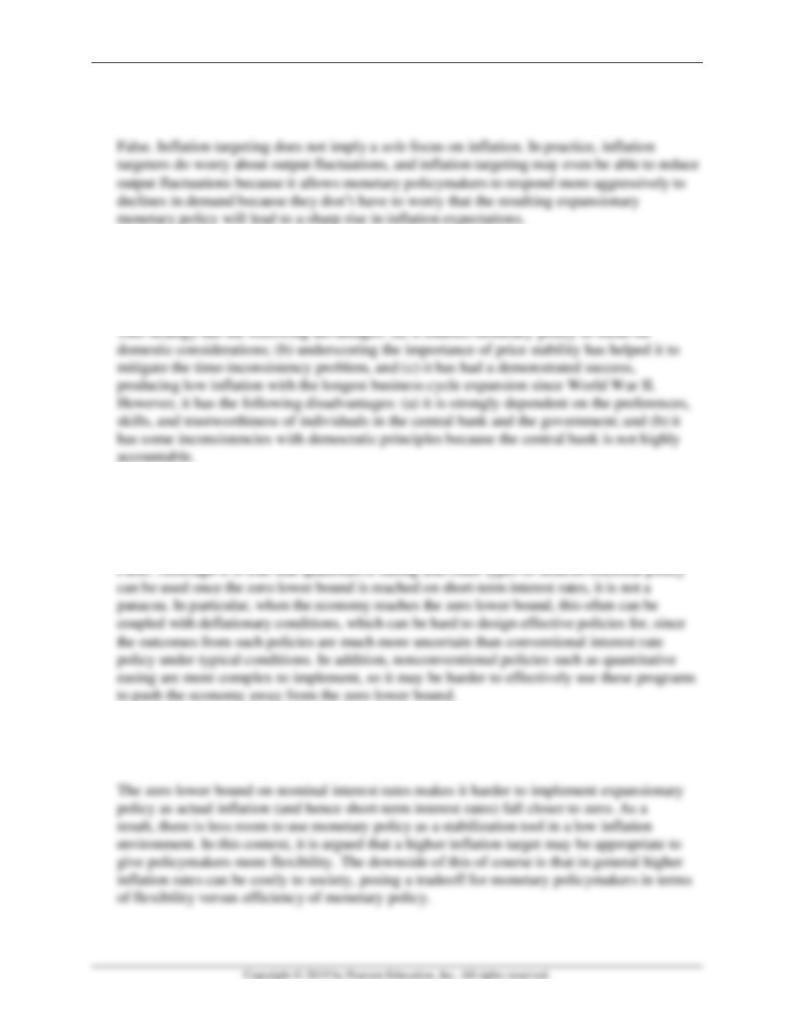
Mishkin • Instructor’s Manual for The Economics of Money, Banking, and Financial Markets, Twelfth Edition 181
10. “Because inflation targeting focuses on achieving the inflation target, it will lead to
excessive output fluctuations.” Is this statement true, false, or uncertain? Explain.
11. What are the key advantages and disadvantages of the monetary strategy used by the Federal
Reserve under Alan Greenspan and Ben Bernanke, in which the nominal anchor was implicit
rather than explicit?
12. “The zero lower bound on short-term interest rates is not a problem, since the central bank
can just use quantitative easing to lower intermediate and longer-term interest rates
instead.” Is this statement true, false, or uncertain? Explain.
13. If higher inflation is bad, then why might it be advantageous to have a higher inflation target
rather than a lower target that is closer to zero?
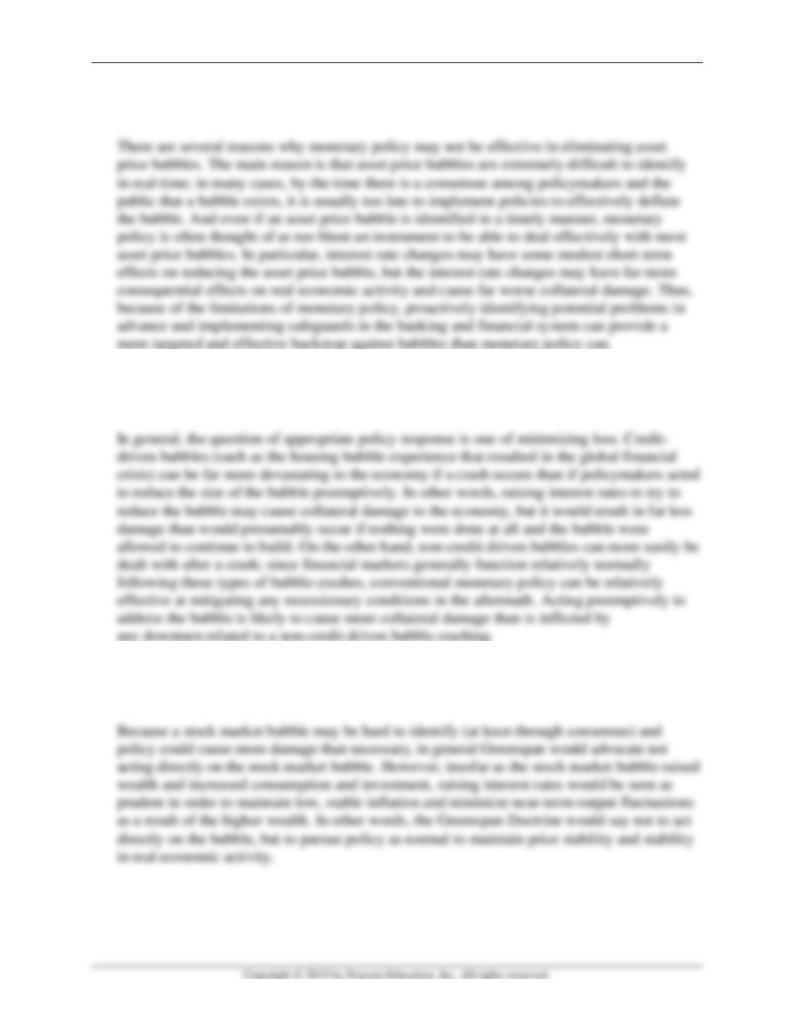
Mishkin • Instructor’s Manual for The Economics of Money, Banking, and Financial Markets, Twelfth Edition 182
14. Why might macroprudential regulation be more effective in managing asset price bubbles
than monetary policy?
15. Why might it be better to lean against credit-driven bubbles rather than just clean up after
other types of asset bubbles burst?
16. According to the Greenspan doctrine, under what conditions might a central bank respond to
a perceived stock market bubble?
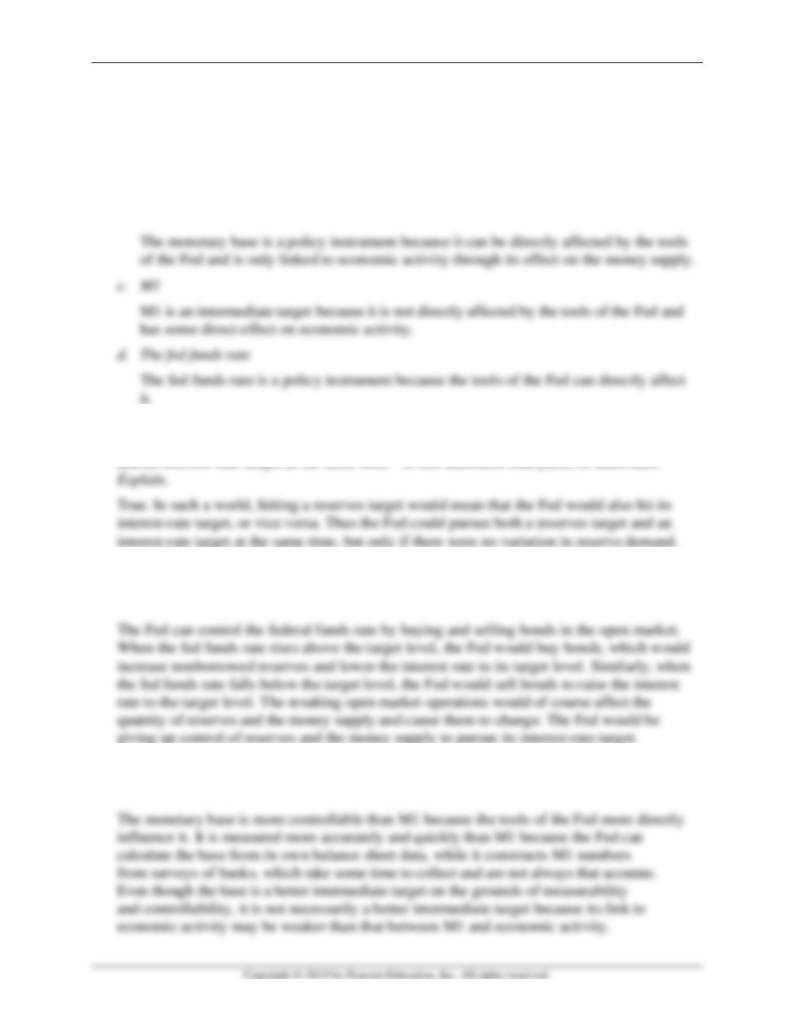
Mishkin • Instructor’s Manual for The Economics of Money, Banking, and Financial Markets, Twelfth Edition 183
17. Classify each of the following as either a policy instrument or an intermediate target, and
explain your choice.
a. The ten-year Treasury bond rate
The ten-year bond is an intermediate target because it is not directly affected by the tools of
the Fed, but is linked to economic activity.
b. The monetary base
18. “If the demand for reserves did not fluctuate, the Fed could pursue both a reserves target
19. What procedures can the Fed use to control the federal funds rate? Why does control of this
interest rate imply that the Fed will lose control of nonborrowed reserves?
20. Compare the monetary base to M1 on the grounds of controllability and measurability.
Which do you prefer as an intermediate target? Why?

Mishkin • Instructor’s Manual for The Economics of Money, Banking, and Financial Markets, Twelfth Edition 184
21. “Interest rates can be measured more accurately and quickly than reserve aggregates; hence
an interest rate is preferred to the reserve aggregates as a policy instrument.” Do you agree or
disagree? Explain your answer.
22. How can forward guidance as a tool of the central bank impact the policy instrument,
intermediate targets, and goals?
23. What does the Taylor rule imply that policymakers should do to the fed funds rate under the
following scenarios?
a. Unemployment rises due to a recession.
If unemployment rises, this would lower the output gap, and trigger a lower fed funds rate
according to the Taylor rule.
b. An oil price shock causes the inflation rate to rise by 1% and output to fall by 1%.
If inflation rises by 1%, this alone would prompt the fed funds rate to rise by 1.5
percentage points. The decrease in the output gap alone would imply the fed funds rate
would fall by 0.5 percentage points. Thus, the two factors together imply a net effect of
increasing the fed funds rate by one percentage point according to the Taylor rule.
c. The economy experiences prolonged increases in productivity growth while actual output
growth is unchanged.

Mishkin • Instructor’s Manual for The Economics of Money, Banking, and Financial Markets, Twelfth Edition 185
24. If the Fed has an interest-rate target, why will an increase in the demand for reserves lead to a
rise in the money supply? Use a graph of the market for reserves to explain.
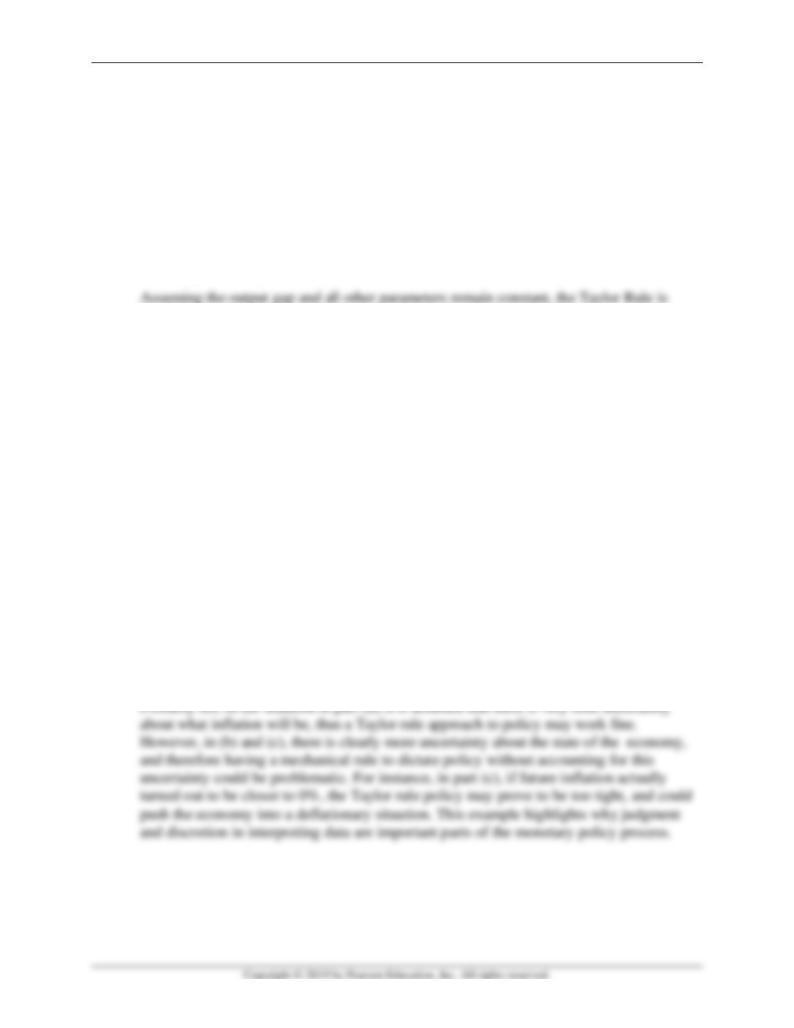
Mishkin • Instructor’s Manual for The Economics of Money, Banking, and Financial Markets, Twelfth Edition 186
25. Since monetary policy changes made through the fed funds rate occur with a lag,
policymakers are usually more concerned with adjusting policy according to changes in the
forecasted or expected inflation rate, rather than the current inflation rate. In light of this,
suppose that monetary policymakers employ the Taylor rule to set the fed funds rate, where
the inflation gap is defined as the difference between expected inflation and the target
inflation rate. Assume that the weights on both the inflation and output gaps are ½ the
equilibrium real fed funds rate is 2%, the inflation rate target is 2%, and the output gap is
1%.
a. If the expected inflation rate is 4%, then at what target should the fed funds rate be set
according to the Taylor rule?
ffr =
e + 2 + 0.5(
e – 2) + 0.5 (1) , where
e is expected inflation. Thus, if
e = 4%,
then the fed funds rate should be set to 4 + 2 + 0.5(2) + 0.5 = 7.5%.
b. Suppose half of Fed economists forecast inflation to be 3%, and half of Fed economists
forecast inflation to be 5%. If the Fed uses the average of these two forecasts as its
measure of expected inflation, then at what target should the fed funds rate be set
according to the Taylor rule?
If the measure of expected inflation is the average of the two forecasts, then
e = 0.5
(3% + 5%) = 4%. In this case, again the Taylor rule would imply a setting of the fed
funds rate of 7.5%.
c. Now suppose half of Fed economists forecast inflation to be 0%, and half forecast
inflation to be 8%. If the Fed uses the average of these two forecasts as its measure of
expected inflation, then at what target should the fed funds rate be set according to the
Taylor rule?
If the measure of expected inflation is the average of the two forecasts, then
e = 0.5
(0% + 8%) = 4%. In this case, again the Taylor rule would imply a setting of the fed
funds rate of 7.5%.
d. Given your answers to parts (a)–(c) above, do you think it is a good idea for monetary
policymakers to use a strict interpretation of the Taylor rule as a basis for setting policy?
Why or why not?
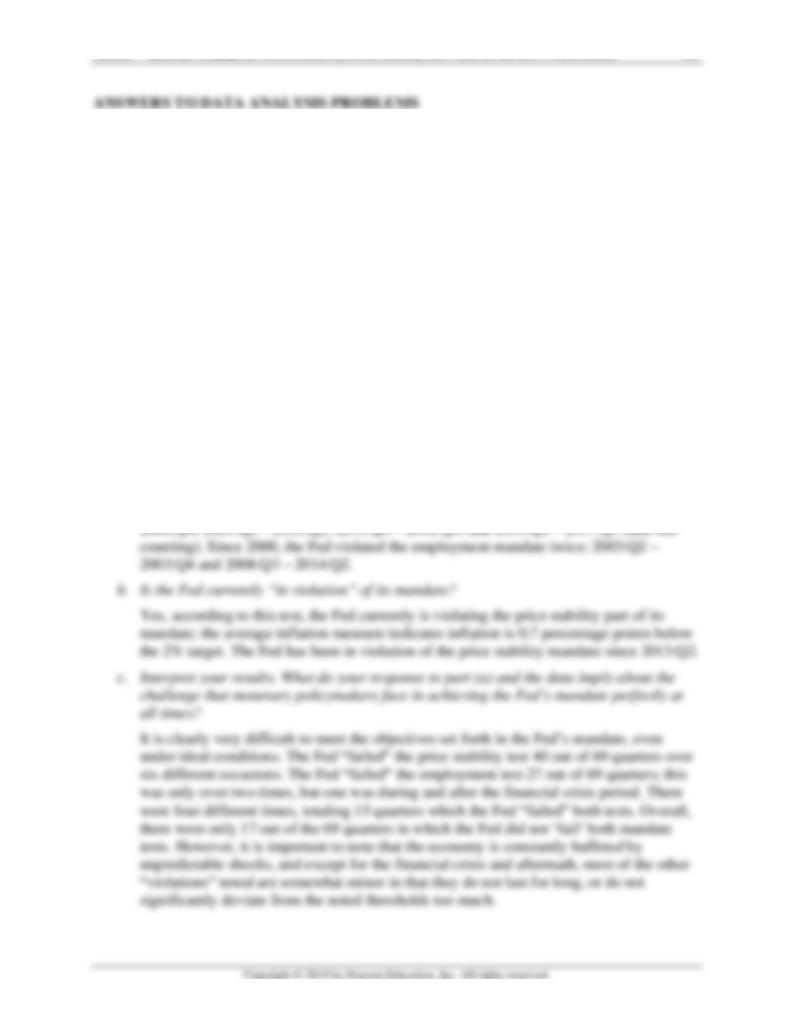
Mishkin • Instructor’s Manual for The Economics of Money, Banking, and Financial Markets, Twelfth Edition 187
1. The Fed’s maximum employment mandate is generally interpreted as an attempt to achieve
an unemployment rate that is as close as possible to the natural rate and inflation that is
close to its 2% goal for personal consumption expenditure price inflation. Go to the St. Louis
Federal Reserve FRED database and find data on the personal consumption expenditure
price index (PCECTPI), the unemployment rate (UNRATE), and a measure of the natural
rate of unemployment (NROU). For the price index, adjust the units setting to “Percent
Change From Year Ago” to convert the data to the inflation rate; for the unemployment rate,
change the frequency setting to “Quarterly.” Download the data into a spreadsheet.
Calculate the unemployment gap and inflation gap for each quarter. Then, using the inflation
gap, create an average inflation gap measure by taking the average of the current inflation
gap and the gaps for the previous three quarters. Now apply the following (admittedly
arbitrary and ad hoc) test to the data from 2000:Q1 through the most recent data available:
If the unemployment gap is larger than 1.0 for two or more consecutive quarters, and/ or the
average inflation gap is larger in absolute value than 0.5 for two or more consecutive
quarters, consider the mandate “violated.”
a. Based on this ad hoc test, in which quarters has the Fed “violated” the price stability
portion of its mandate? In which quarters has the Fed “violated” the maximum
employment mandate?
See table below. As of 2017:Q1, the Fed violated the price stability mandate according
to this test six times since 2000: 2002:Q2 – 2002:Q4; 2005:Q1 – 2007:Q1; 2007:Q4 –
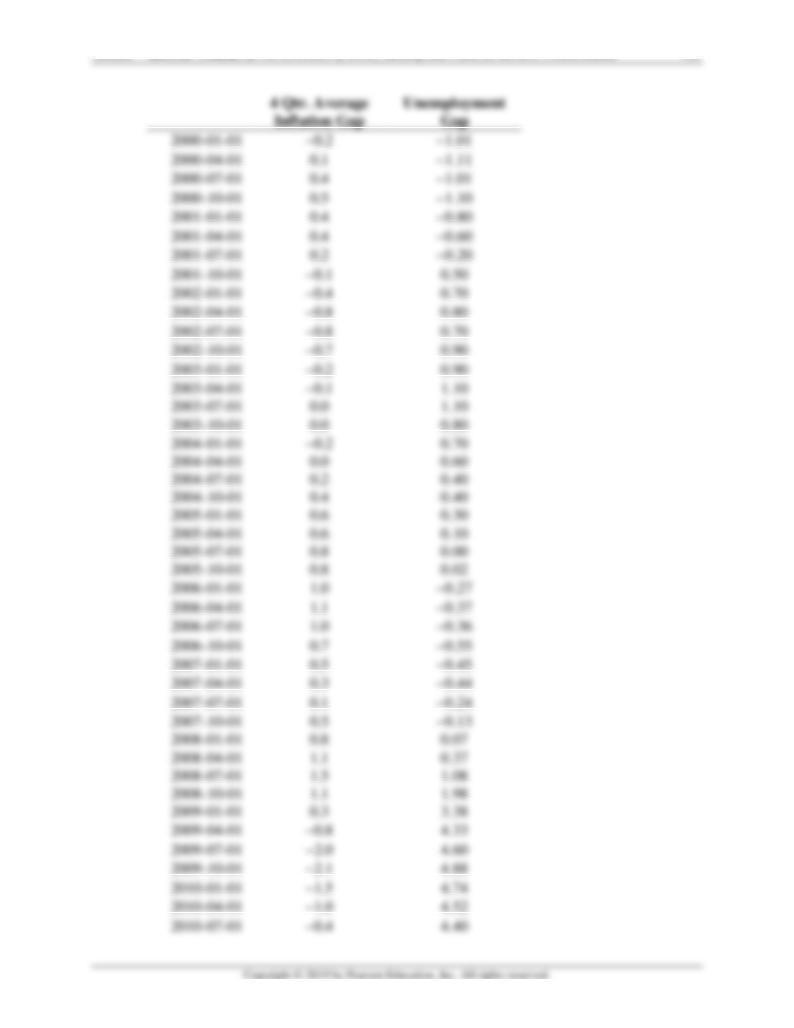
Mishkin • Instructor’s Manual for The Economics of Money, Banking, and Financial Markets, Twelfth Edition 188
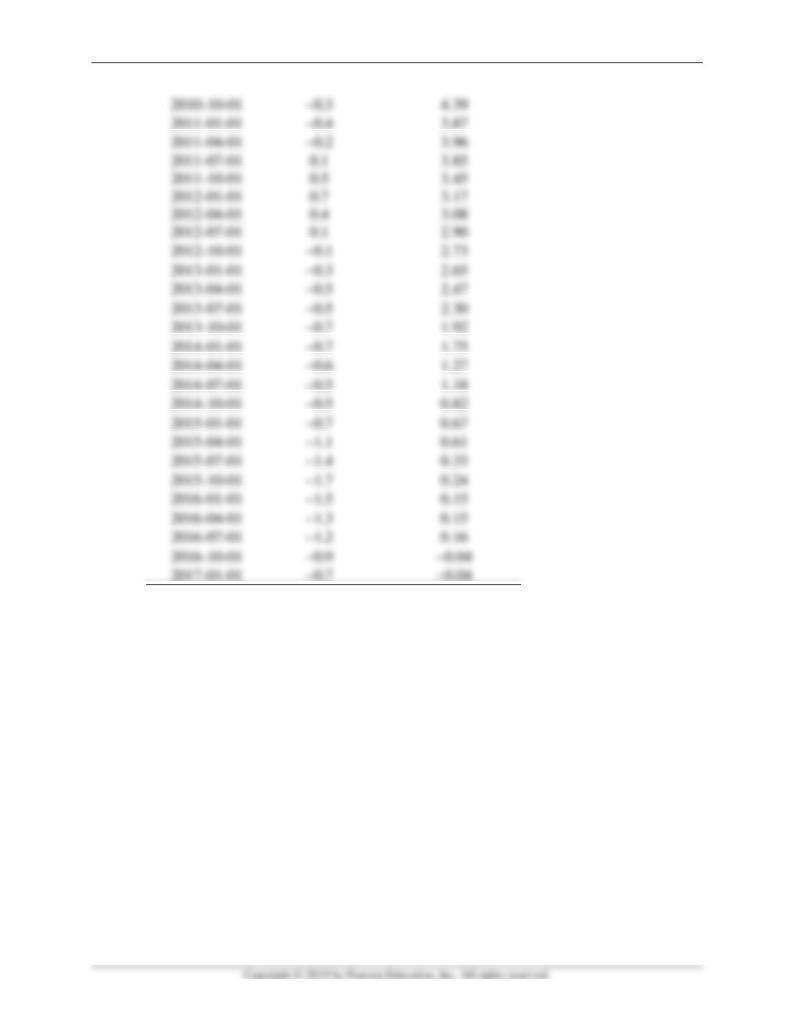
Mishkin • Instructor’s Manual for The Economics of Money, Banking, and Financial Markets, Twelfth Edition 189
2. Go to the St. Louis Federal Reserve FRED database and find data on the personal
consumption expenditure price index (PCECTPI), real GDP (GDPC1), an estimate of
potential GDP (GDPPOT), and the federal funds rate (DFF). For the price index, adjust the
units setting to “Percent Change From Year Ago” to convert the data to the inflation rate;
for the federal funds rate, change the frequency setting to “Quarterly.” Download the data
into a spreadsheet. Assuming the inflation target is 2% and the equilibrium real fed funds
rate is 2%, calculate the inflation gap and the output gap for each quarter, from 2000 until
the most recent quarter of data available. Calculate the output gap as the percentage
deviation of output from the potential level of output.
a. Use the output and inflation gaps to calculate, for each quarter, the fed funds rate
predicted by the Taylor rule. Assume that the weights on inflation stabilization and output
stabilization are both ½ (see the formula in the chapter). Compare the current (quarterly
average) federal funds rate to the federal funds rate prescribed by the Taylor rule. Does
the Taylor rule accurately predict the current rate? Briefly comment.
For the most recent period in 2017:Q1, the federal funds rate is 0.70%, while the Taylor
Rule predicts 3.49%, overrepresenting actual policy by a gap of 2.79%. Compared to
other significant deviations, this is a fairly large departure from the baseline Taylor Rule.

Mishkin • Instructor’s Manual for The Economics of Money, Banking, and Financial Markets, Twelfth Edition 190
b. Create a graph that compares the predicted Taylor rule values with the actual quarterly
federal funds rate averages. How well, in general, does the Taylor rule prediction fit the
average federal funds rate? Briefly explain.
See graph below. The Taylor rule since 2000 has periods in which they are fairly closely
correlated, particularly from 2000 to 2002. However, there are significant gaps in other
times, or periods in which they do not seem to move together, such as the period from
3.71%, much higher than the current 0.70%.

Mishkin • Instructor’s Manual for The Economics of Money, Banking, and Financial Markets, Twelfth Edition 191
by 0.05 each quarter (i.e. 2009:Q1 is 1.95, then 1.90, etc.), and once it reaches zero, it
remains at zero thereafter. How does it affect the prescribed fed funds rate? Why might
this be important for policymakers to take into consideration?
A decline in the equilibrium real fed funds rate has the effect of reducing the implied
Taylor rule fed funds rate lower. In fact, under this policy rule, it would have implied the
fed funds rate to be negative during 2015, which also coincided with a period of low
inflation. Of all three of the variations, the declining equilibrium real rate rule is the
closest to the actual path of the fed funds rate since the crisis period. This may help
explain why the actual path of the fed funds rate was lower than standard Taylor Rules
would imply. Moreover, if the real equilibrium fed funds rate did decline, but was not
taken into account (for instance, by using the baseline rule in part (a)), this would imply
that monetary policy would be overly contractionary.
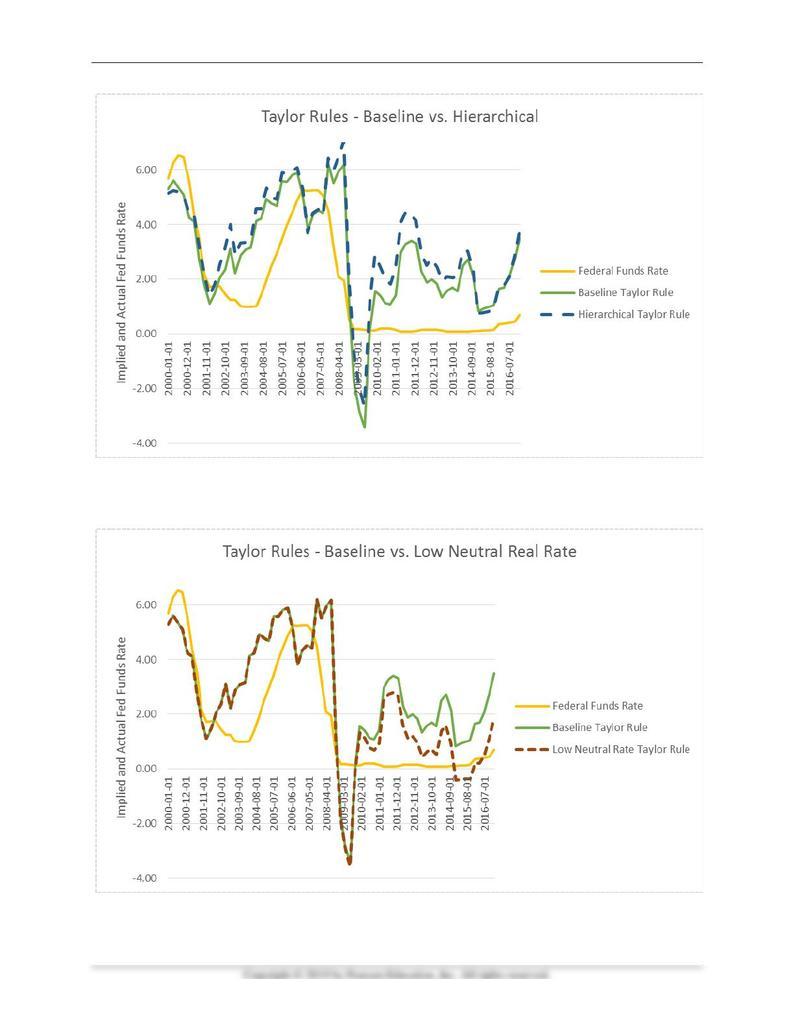
Mishkin • Instructor’s Manual for The Economics of Money, Banking, and Financial Markets, Twelfth Edition 192
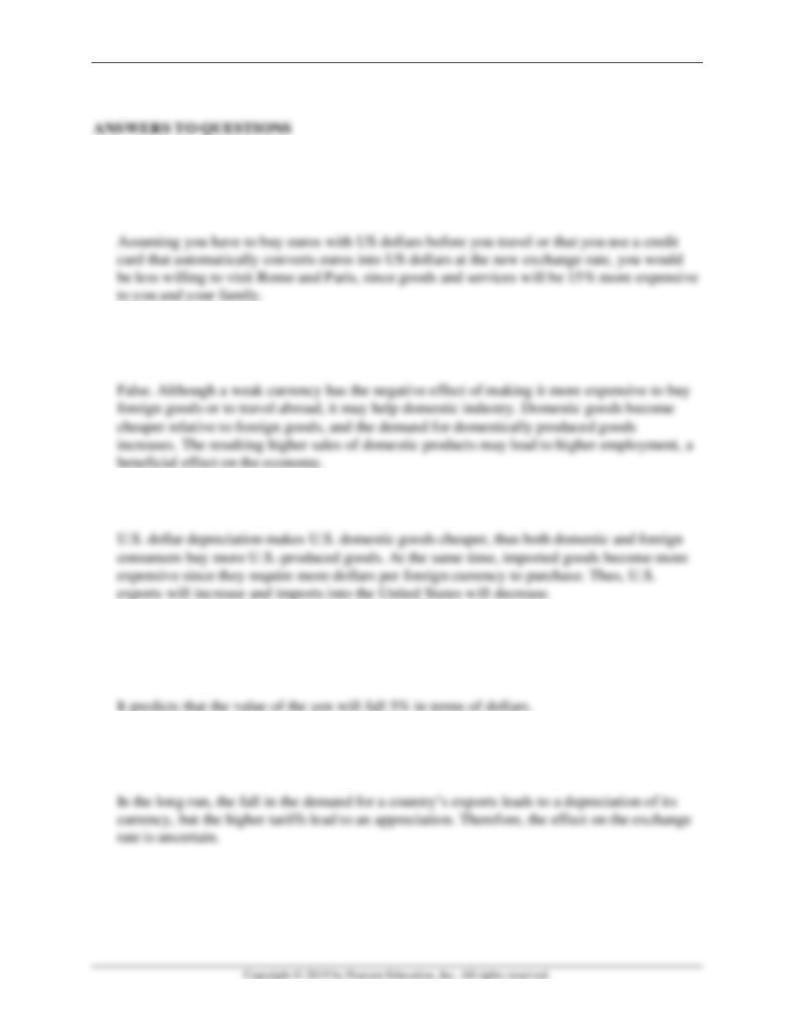
Mishkin • Instructor’s Manual for The Economics of Money, Banking, and Financial Markets, Twelfth Edition 193
Chapter 17
1. Suppose that you are considering going on vacation abroad and that the euro has
appreciated by 15% with respect to the U.S. dollar. Would you be more or less
willing to visit Rome and Paris?
2. “A country is always worse off when its currency is weak (falls in value).” Is this statement
true, false, or uncertain? Explain your answer.
3. When the U.S. dollar depreciates, what happens to exports and imports in the United States?
4. If the Japanese price level rises by 5% relative to the price level in the United States, what
does the theory of purchasing power parity predict will happen to the value of the Japanese
yen in terms of dollars?
5. If the demand for a country’s exports falls at the same time that tariffs on imports are raised,
will the country’s currency tend to appreciate or depreciate in the long run?
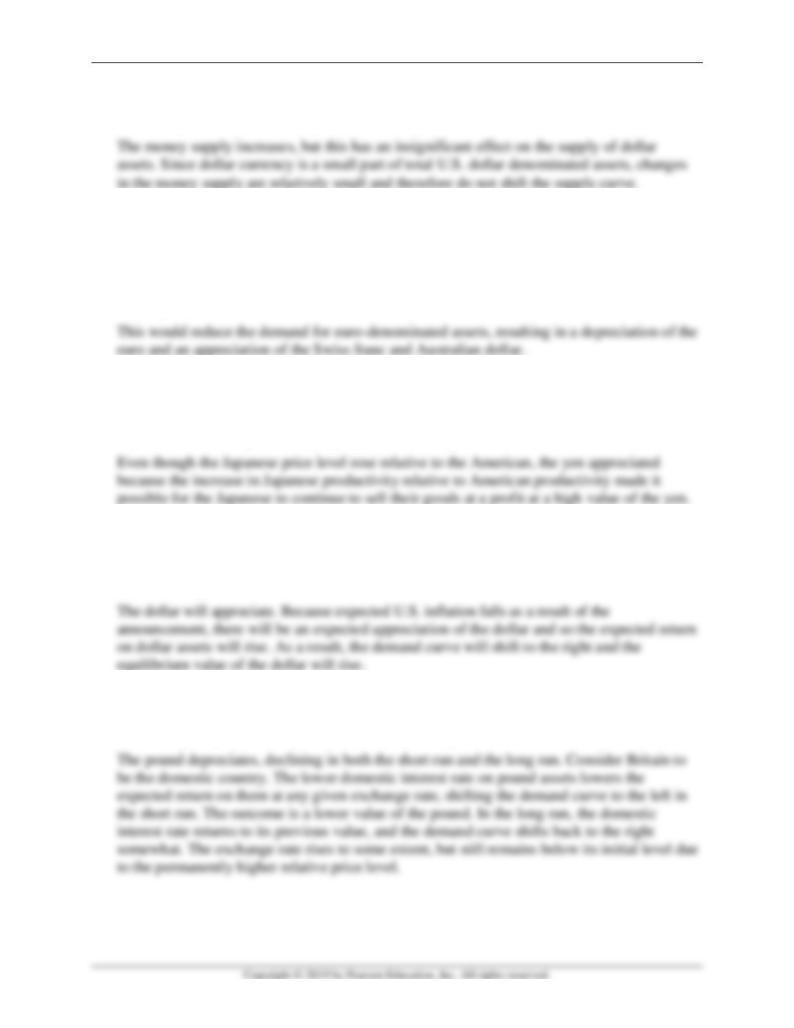
Mishkin • Instructor’s Manual for The Economics of Money, Banking, and Financial Markets, Twelfth Edition 194
6. When the Federal Reserve conducts an expansionary monetary policy, what happens to the
money supply? How does this affect the supply of dollar assets?
7. From 2009 to 2011, the economies of Australia and Switzerland suffered relatively mild
effects from the global financial crisis. At the same time, many countries in the euro area
were hit hard by high unemployment and burdened with unsustainably high government
debts. How should this have affected the euro/Swiss franc and euro/Australian dollar
exchange rates?
8. In the mid- to late 1970s, the yen appreciated in value relative to the dollar, even though
Japan’s inflation rate was higher than America’s. How can this be explained by
improvements in the productivity of Japanese industry relative to American industry?
9. Suppose the president of the United States announces a new set of reforms that includes a new
anti-inflation program. Assuming the announcement is believed by the public, what will happen
to the exchange rate on the U.S. dollar?
10. If the British central bank lowers interest rates to reduce unemployment, what will happen to
the value of the pound in the short run and in the long run?
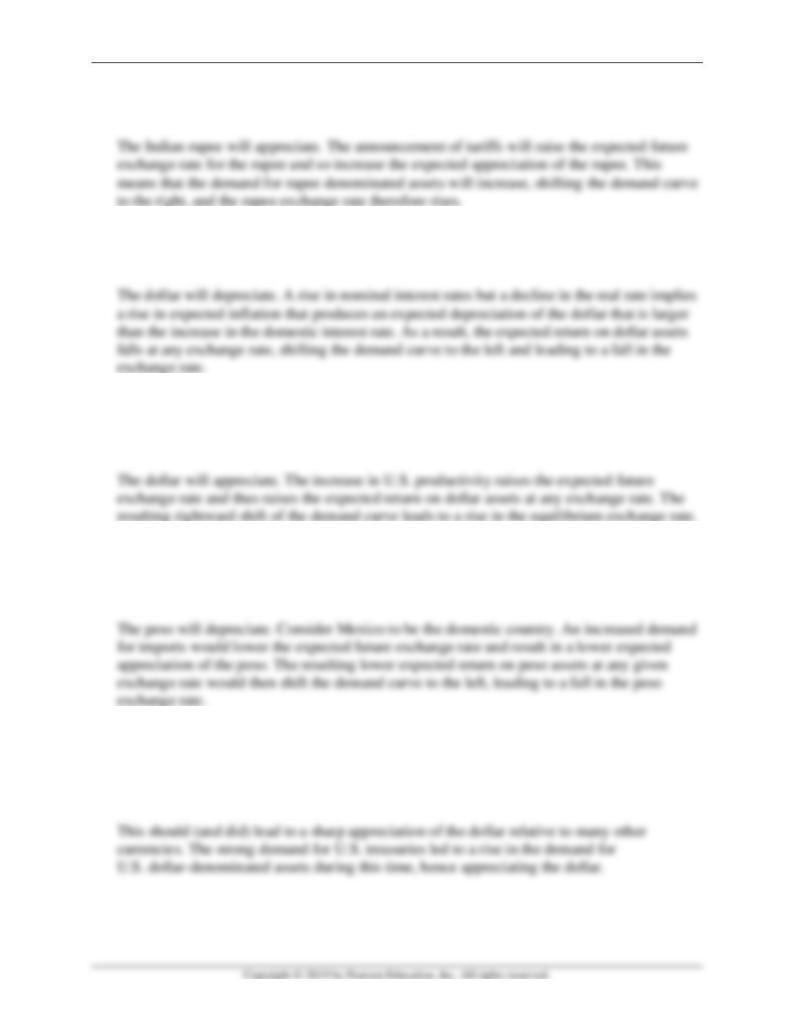
Mishkin • Instructor’s Manual for The Economics of Money, Banking, and Financial Markets, Twelfth Edition 195
11. If the Indian government unexpectedly announces that it will be imposing higher tariffs on
foreign goods one year from now, what will happen to the value of the Indian rupee today?
12. If nominal interest rates in America rise but real interest rates fall, predict what will happen
to the U.S. dollar exchange rate.
13. If American auto companies make a breakthrough in automobile technology and are able to
produce a car that gets 200 miles to the gallon, what will happen to the U.S. dollar exchange
rate?
14. If Mexicans go on a spending spree and buy twice as much French perfume and twice as
many Japanese TVs, English sweaters, Swiss watches, and bottles of Italian wine, what will
happen to the value of the Mexican peso?
15. Through the summer and fall of 2008, as the global financial crisis began to take hold,
international financial institutions and sovereign wealth funds significantly increased their
purchases of U.S. Treasury securities as a safe haven investment. How should this have
affected U.S. dollar exchange rates?
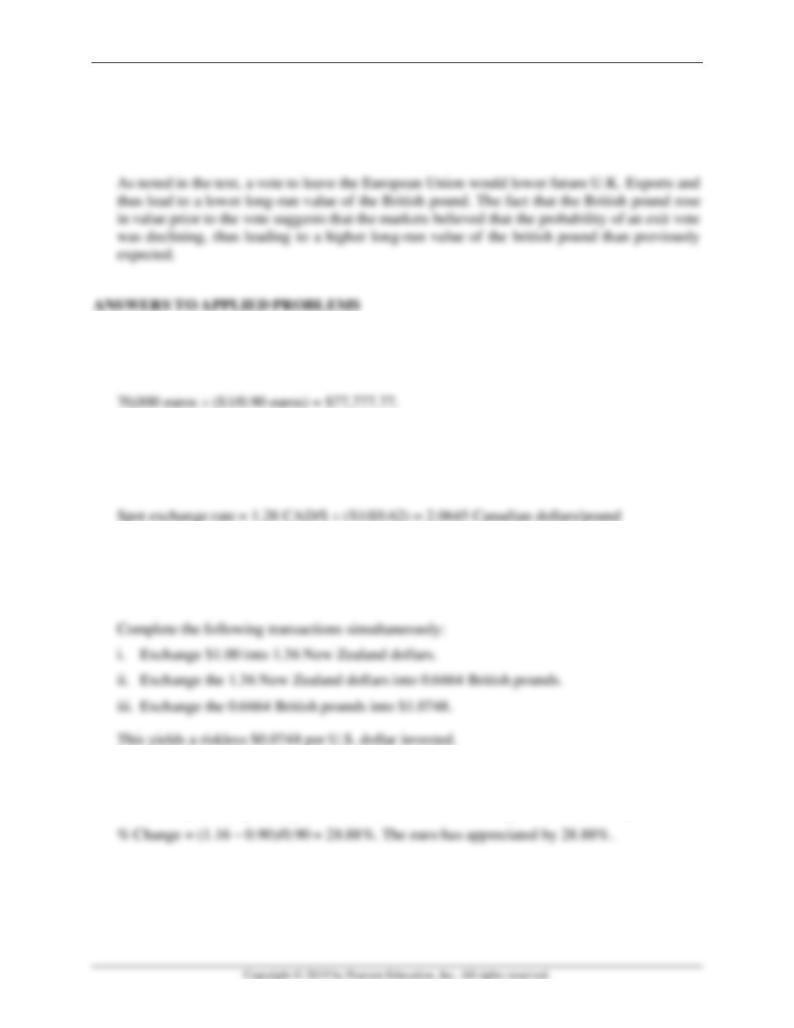
Mishkin • Instructor’s Manual for The Economics of Money, Banking, and Financial Markets, Twelfth Edition 196
16. On June 23, 2016, voters in the United Kingdom voted to leave the European Union. From
June 16 to June 23, 2016, the exchange rate between the British pound and the dollar
increased from 1.41 dollars per pound to 1.48 dollars per pound. What can you say about
market expectations regarding the result of the referendum?
17. A German sports car is selling for 70,000 euros. What is the dollar price in the United States
of the German car if the exchange rate is 0.90 euro per dollar?
18. If the Canadian dollar to U.S. dollar exchange rate is 1.28 and the British pound to U.S.
dollar exchange rate is 0.62, what must be the Canadian dollar to British pound exchange
rate?
19. The New Zealand dollar to U.S. dollar exchange rate is 1.36, and the British pound to U.S.
dollar exchange rate is 0.62. If you find that the British pound to New Zealand dollar is
trading at 0.49, what can you do to earn a riskless profit?
20. In 1999, the euro was trading at $0.90 per euro. If the euro is now trading at $1.16 per euro,
what is the percentage change in the euro’s value? Is this an appreciation or a depreciation?
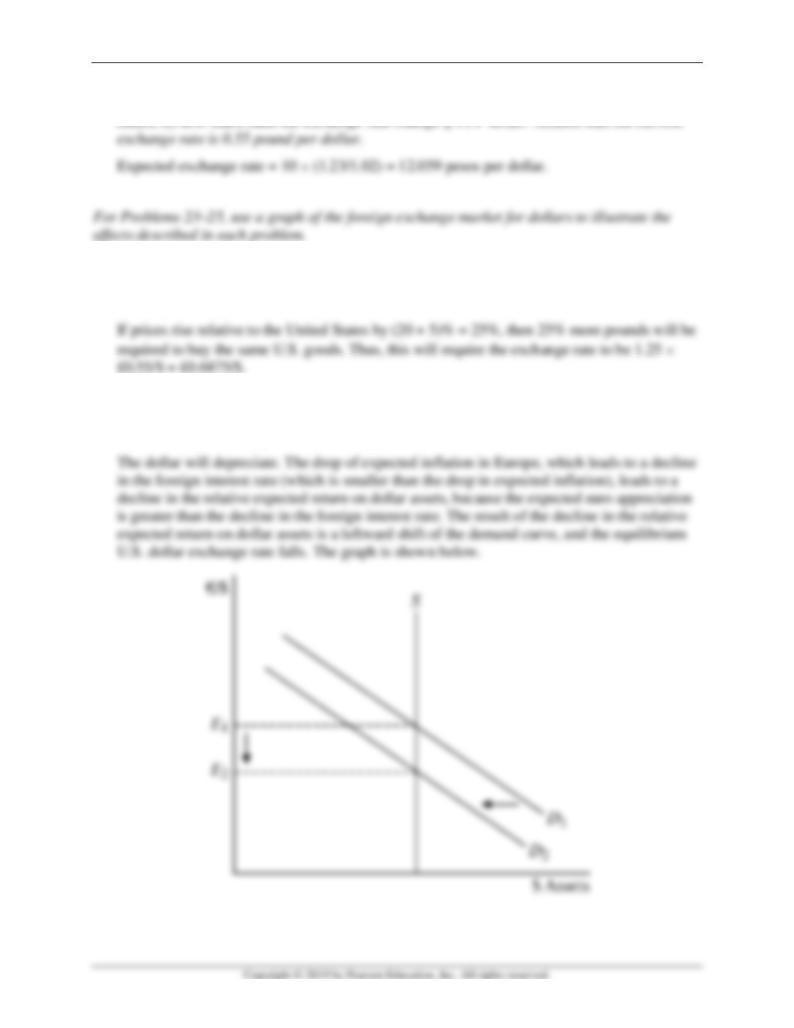
Mishkin • Instructor’s Manual for The Economics of Money, Banking, and Financial Markets, Twelfth Edition 197
21. If the price level recently increased by 20% in England while falling by 5% in the United
22. If expected inflation drops in Europe, so that interest rates fall there, what will happen to the
exchange rate on the U.S. dollar?
23. If the European Central Bank decides to pursue a contractionary monetary policy to fight
inflation, what will happen to the value of the U.S. dollar?
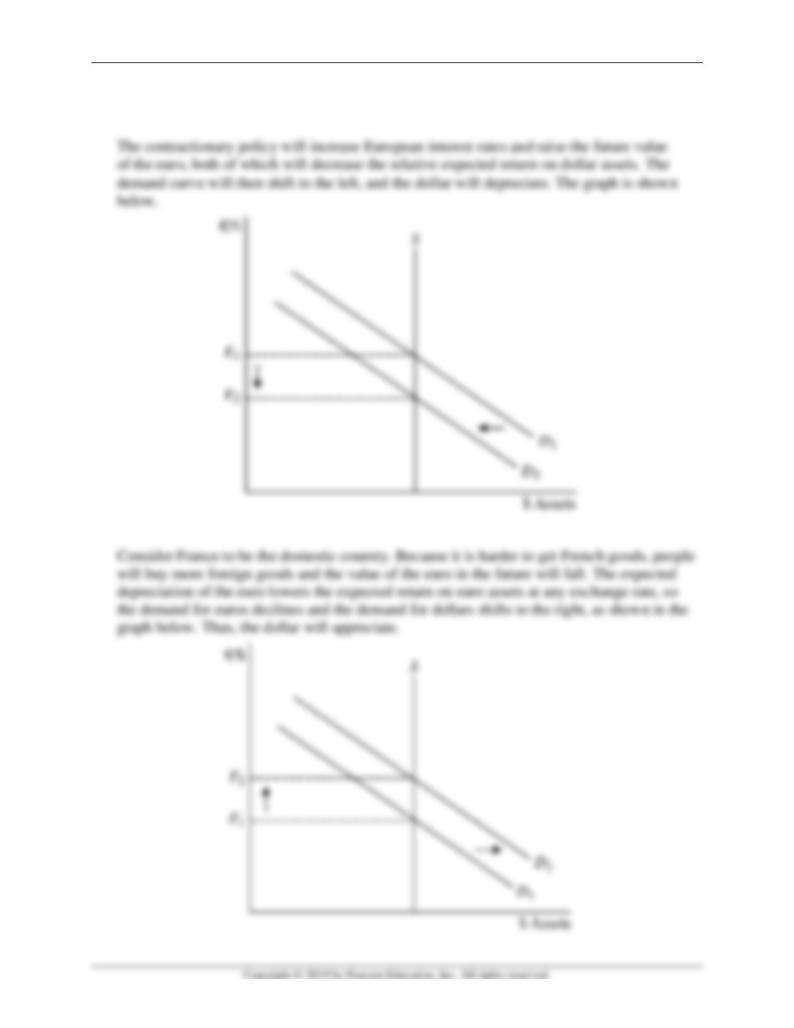
Mishkin • Instructor’s Manual for The Economics of Money, Banking, and Financial Markets, Twelfth Edition 198
24. If a strike takes place in France, making it harder to buy French goods, what will happen to
the value of the U.S. dollar?
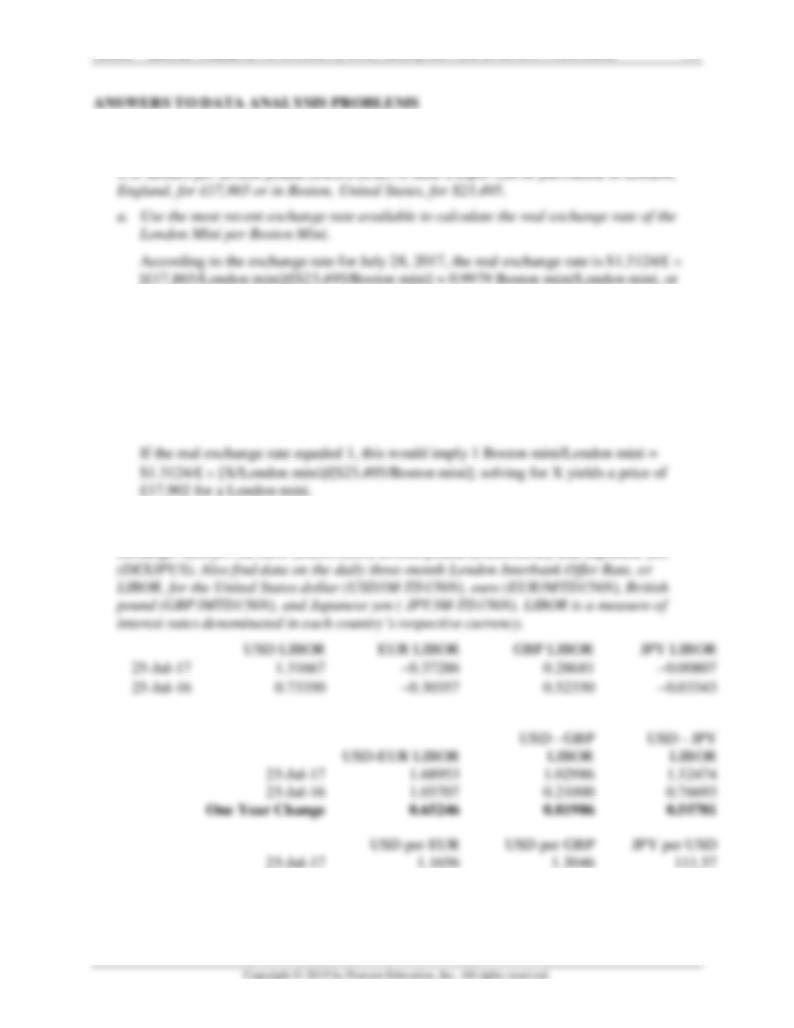
Mishkin • Instructor’s Manual for The Economics of Money, Banking, and Financial Markets, Twelfth Edition 199
1. Go to the St. Louis Federal Reserve FRED database and find data on the exchange rate of
1.002 London mini/Boston mini.
b. Based on your answer to part (a), are Mini Coopers relatively more expensive in Boston
or in London?
Since you can buy 1.002 minis in London for every one purchased in Boston, they are
slightly relatively less expensive in London.
c. What price in British pounds would make the Mini Cooper equally expensive in both
locations, all else being equal?
2. Go to the St. Louis Federal Reserve FRED database and find data on the daily dollar
25-Jul-16
1.0980
1.3130
106.02
EUR appreciated
GBP depreciated
JPY
depreciated
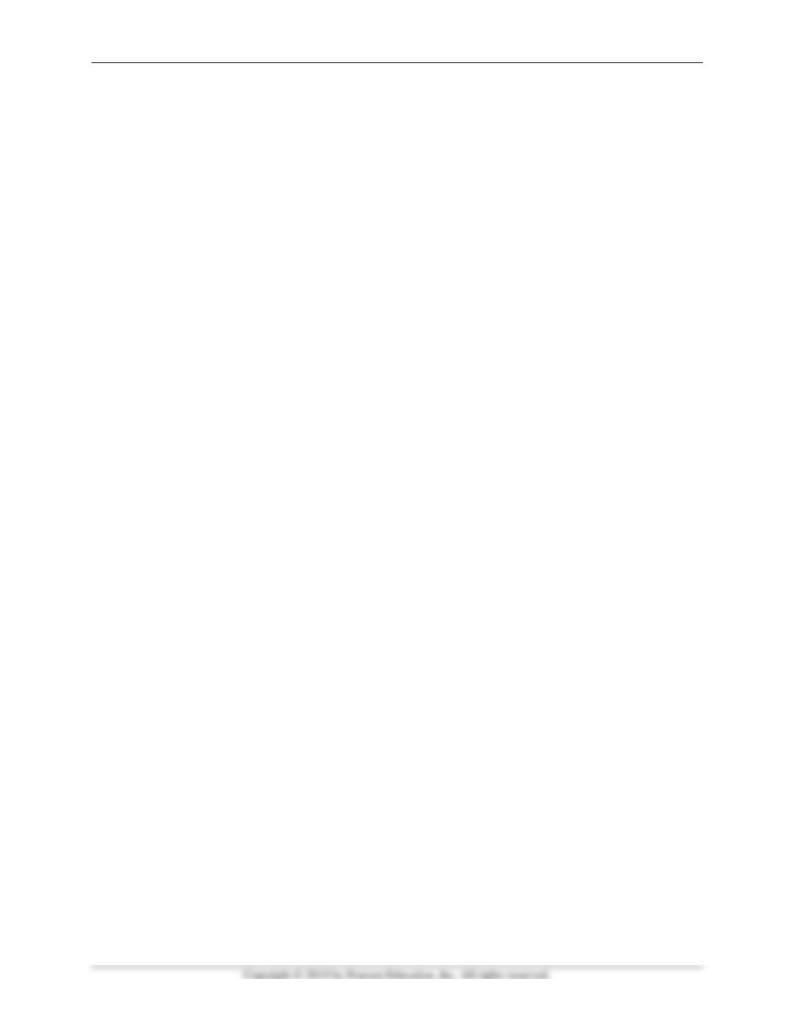
Mishkin • Instructor’s Manual for The Economics of Money, Banking, and Financial Markets, Twelfth Edition 200
a. Calculate the difference between the LIBOR rate in the United States and the LIBOR
rates in the three other countries using the data from one year ago and the most recent
data available.
See table above.
b. Based on the changes in interest rate differentials, do you expect the dollar to depreciate
or appreciate against the other currencies?
All three LIBOR rates for the euro currency area, United Kingdom, and Japan all
declined relative to LIBOR rates in the United States. Thus, you would expect all three
currencies should depreciate relative to the U.S. dollar.
c. Report the percentage change in the exchange rates over the past year. Are the results
you predicted in part (b) consistent with the actual exchange rate behavior?
See table above. The British pound and Japanese yen depreciatedaccording to prediction.
However, the euro actually appreciated, despite having relatively lower interest rates
compared to a year prior, indicating there are other factors affecting the exchange rate in
this case aside from interest rate differentials.
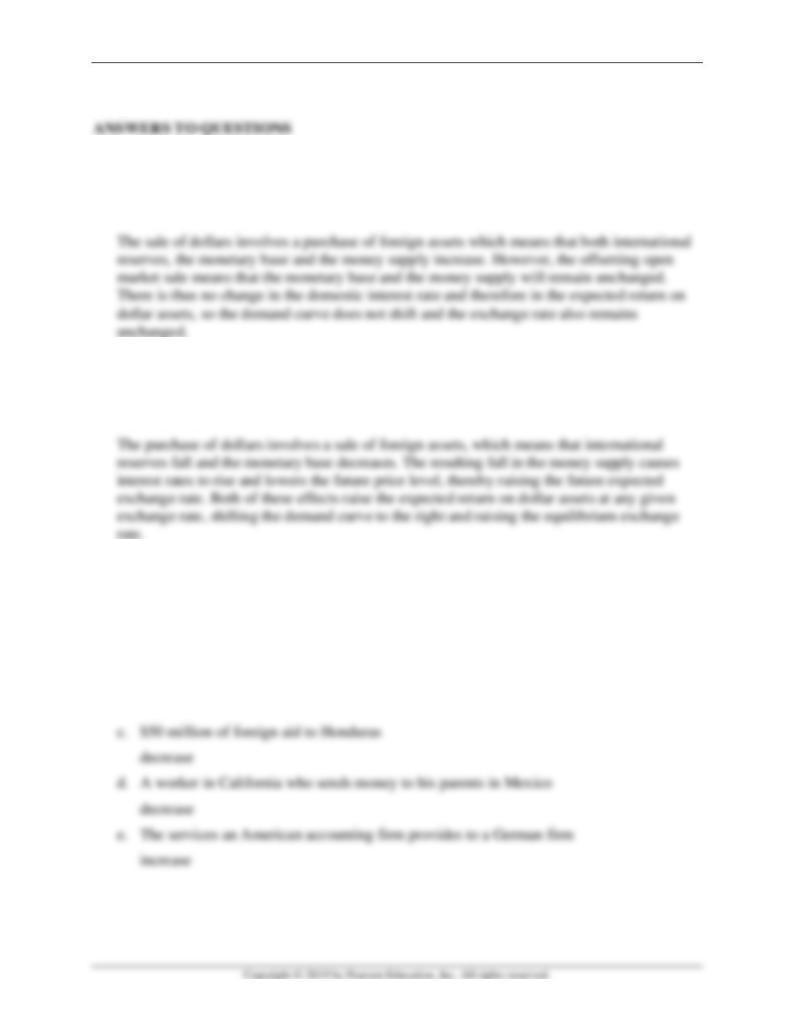
Mishkin • Instructor’s Manual for The Economics of Money, Banking, and Financial Markets, Twelfth Edition 201
Chapter 18
1. If the Federal Reserve sells dollars in the foreign exchange market but conducts an offsetting
open market operation to sterilize the intervention, what will be the effect on international
reserves, the money supply, and the exchange rate?
2. If the Federal Reserve buys dollars in the foreign exchange market but does not sterilize the
intervention, what will be the impact on international reserves, the money supply, and the
exchange rate?
3. For each of the following, identify whether they increase or decrease the current account
balance:
a. An American citizen’s purchase of an airline ticket from Air France
decrease
b. A Japanese citizen’s purchase of California oranges
increase
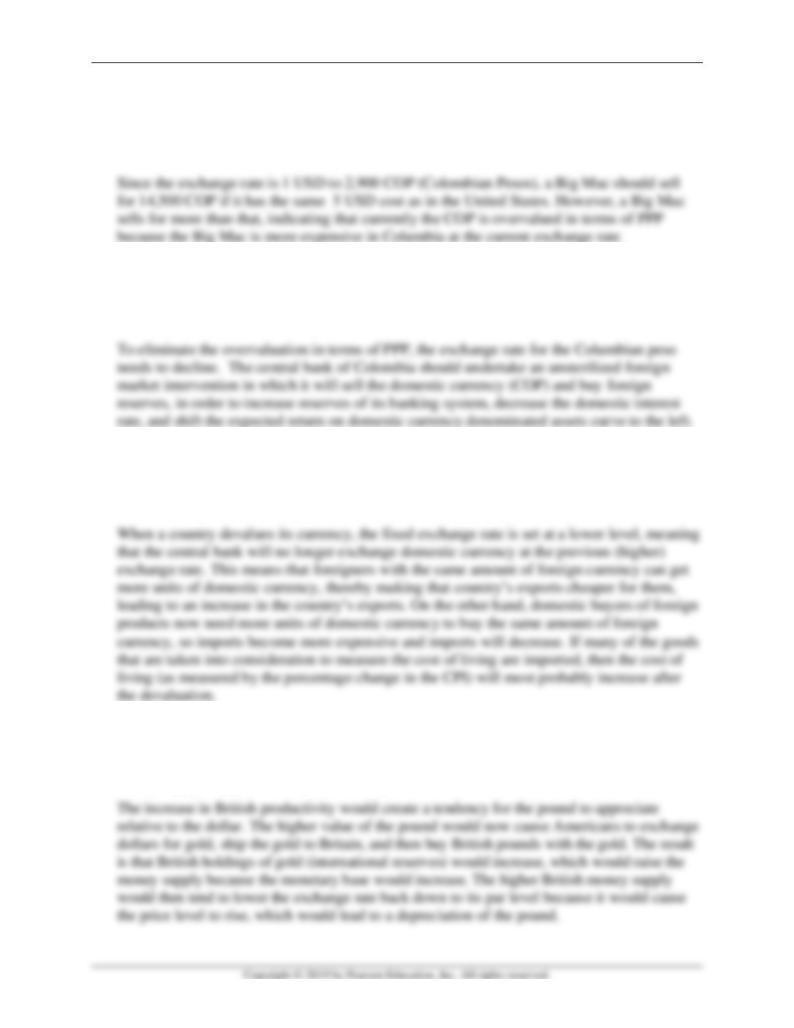
Mishkin • Instructor’s Manual for The Economics of Money, Banking, and Financial Markets, Twelfth Edition 202
4. Suppose that you travel to Cali (Colombia), where the exchange rate is 1 USD to 2,900
Colombian pesos. As you enter a McDonald’s restaurant, you realize you need 17,400
Colombian pesos to buy a Big Mac. Assuming a Big Mac sells for $5 in the United States,
would you say that the Colombian peso is over- or undervalued in terms of PPP?
5. Refer to the previous exercise. Which type of foreign market intervention must the central
bank of Colombia conduct to keep the exchange rate at a level where the currency is not
under- or overvalued in terms of PPP?
6. What would be the effect of a devaluation on a country’s imports and exports? If a country
imports most of the goods included in the basket of goods and services used to calculate the
CPI, what do you think the effect will be on this country’s inflation rate?
7. Under the gold standard, if Britain became more productive relative to the United States,
what would happen to the money supply in the two countries? Why would the changes in the
money supply help preserve a fixed exchange rate between the United States and Britain?

Mishkin • Instructor’s Manual for The Economics of Money, Banking, and Financial Markets, Twelfth Edition 203
8. What is the exchange rate between dollars and Swiss francs if one dollar is convertible into
1/20 ounce of gold and one Swiss franc is convertible into 1/40 ounce of gold?
9. “Inflation is not possible under the gold standard.” Is this statement true, false, or
uncertain? Explain your answer.
10. What are some of the disadvantages of China’s pegging the yuan to the dollar?
11. If a country’s par exchange rate was undervalued during the Bretton Woods fixed exchange
rate regime, what kind of intervention would that country’s central bank be forced to
undertake, and what effect would the intervention have on the country’s international reserves
and money supply?
12. Why might a country that is suffering a recession not want to intervene in the foreign
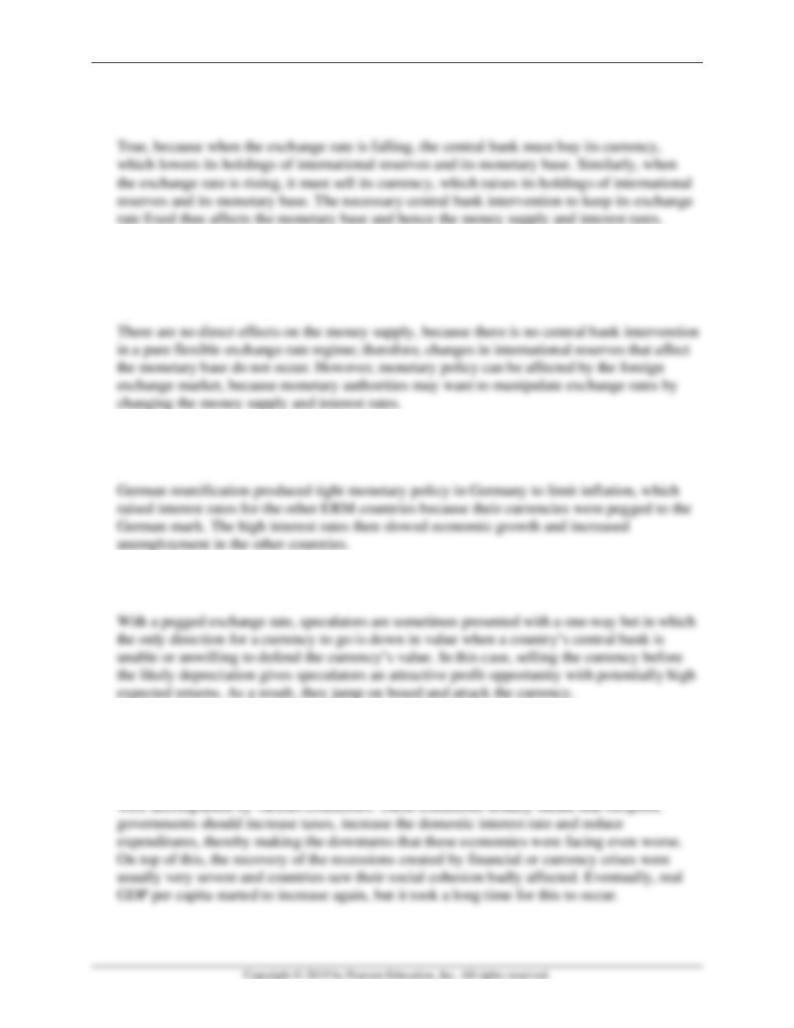
Mishkin • Instructor’s Manual for The Economics of Money, Banking, and Financial Markets, Twelfth Edition 204
13. “If a country wants to keep its exchange rate from changing, it must give up some control
over its monetary policy.” Is this statement true, false, or uncertain? Explain your answer.
14. Why is it that in a pure, flexible exchange rate system, the foreign exchange market has no
direct effect on the money supply? Does this mean that the foreign exchange market has no
effect on monetary policy?
15. Why did the exchange-rate peg lead to difficulties for the countries in the ERM after the
German reunification?
16. How can exchange-rate targets lead to a speculative attack on a currency?
17. The IMF does not enjoy a great reputation in many countries that were recipients of IMF
loans or bailouts. Explain why many citizens were not happy with the role played by the IMF.
In general, IMF loans provided to help countries cope with either financial or currency crises
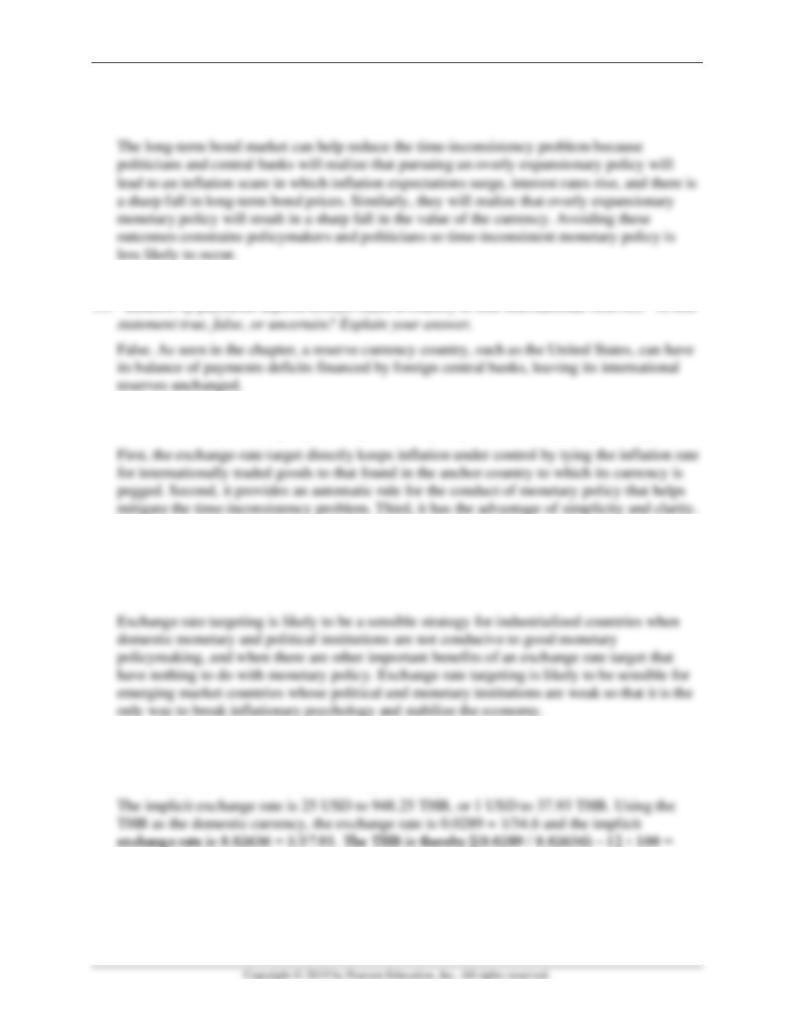
Mishkin • Instructor’s Manual for The Economics of Money, Banking, and Financial Markets, Twelfth Edition 205
18. How can the long-term bond market help reduce the time-inconsistency problem for
monetary policy? Can the foreign exchange market also perform this role?
20. What are the key advantages of exchange-rate targeting as a monetary policy strategy?
21. When is exchange-rate targeting likely to be a sensible strategy for industrialized countries?
When is exchange-rate targeting likely to be a sensible strategy for emerging market
countries?
22. What are the advantages and disadvantages of currency boards and dollarization over a
monetary policy that uses only an exchange-rate target?
9.64% overvalued.

Mishkin • Instructor’s Manual for The Economics of Money, Banking, and Financial Markets, Twelfth Edition 206
23. Suppose the Federal Reserve purchases $1,000,000 worth of foreign assets.
a. If the Federal Reserve purchases the foreign assets with $1,000,000 in currency, show
the effect of this open market operation, using T-accounts. What happens to the monetary
base?
The Fed’s assets increase by $1 million, and it increases currency in circulation by $1
million. This results in the monetary base increasing by $1 million.
Federal Reserve System
Assets
Liabilities
Foreign assets
(international reserves)
+$1 million
Currency in circulation
+$1 million
b. If the Federal Reserve purchases the foreign assets by selling $1,000,000 in T-bills, show
the effect of this open market operation, using T-accounts. What happens to the monetary
base?
24. Suppose the Mexican central bank chooses to peg the peso to the U.S. dollar and commits to
a fixed peso/dollar exchange rate. Use a graph of the market for peso assets (foreign
exchange) to show and explain how the peg must be maintained if a shock in the U.S.
economy forces the Fed to pursue contractionary monetary policy. What does this say about
the ability of central banks to address domestic economic problems while maintaining a
pegged exchange rate?
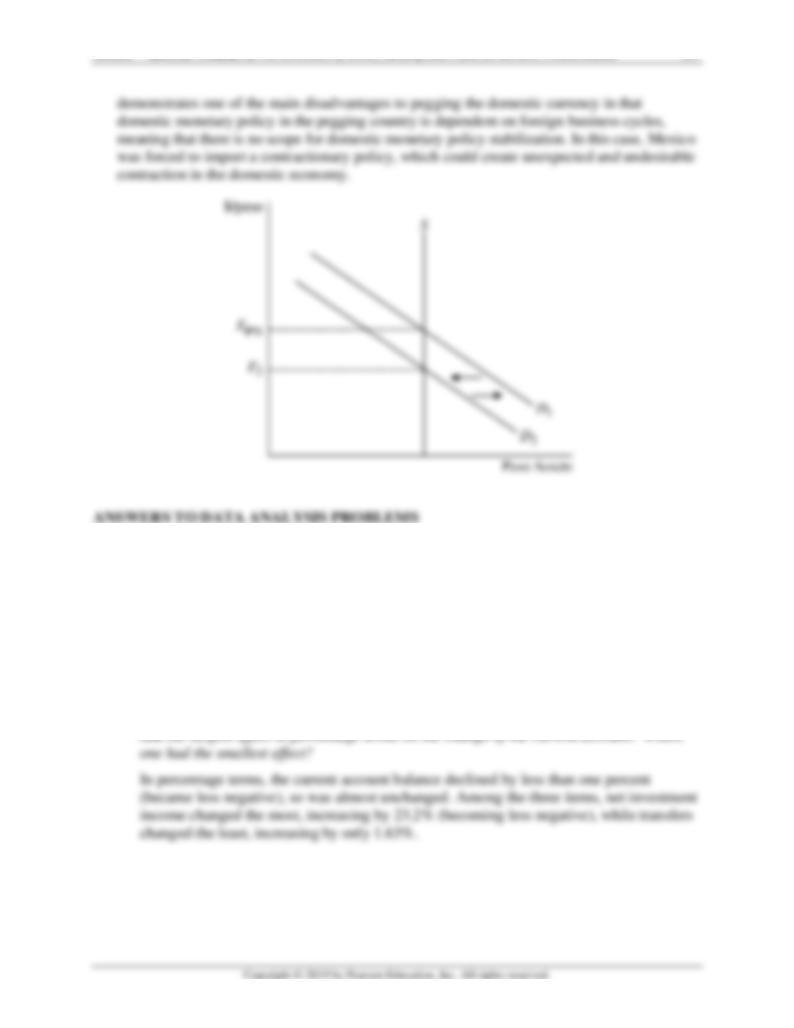
Mishkin • Instructor’s Manual for The Economics of Money, Banking, and Financial Markets, Twelfth Edition 207
1. Go to the St. Louis Federal Reserve FRED database, and find data on net exports
(NETEXP), transfers, (A123RC1Q027SBEA) and the current account balance (NETFI).
a. Calculate net investment income for the most recent quarter available, and for the same
quarter a year earlier.
See table below. Net investment income is equal to the current account – transfers – net
exports.
b. Calculate the percentage change in the current account balance from the same quarter
one year earlier. Which one of the three items making up the current account balance
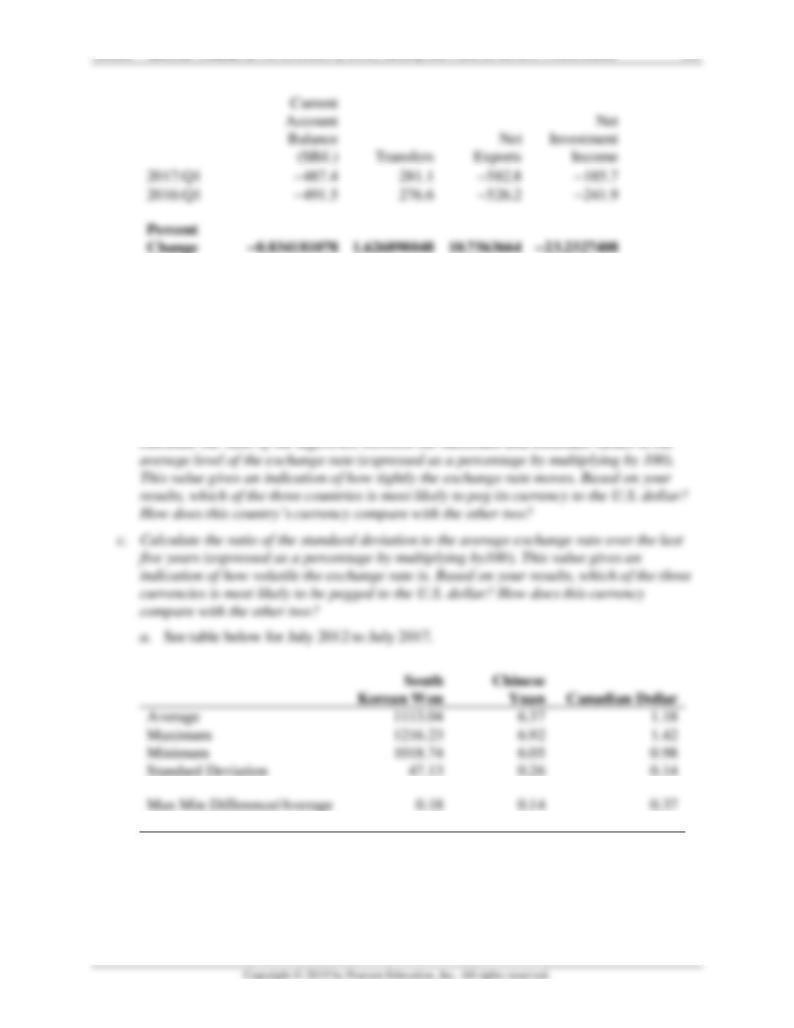
Mishkin • Instructor’s Manual for The Economics of Money, Banking, and Financial Markets, Twelfth Edition 208
2. Go to the St. Louis Federal Reserve FRED database and find data on the monthly U.S. dollar
exchange rate to the Chinese yuan (EXCHUS), the Canadian dollar (EXCAUS), and the
South Korean won (EXKOUS). Download the data into a spreadsheet.
a. For the most recent five-year period of data available, use the average, max, min, and
stdev functions in Excel to calculate the average, highest, and lowest exchange rate
values, as well as the standard deviation of the exchange rate to the dollar (this is an
absolute measure of the volatility of the exchange rate).
b. Using the maximum and minimum values of each exchange rate over the last five years,
SD/Average
0.04
0.04
0.12

Mishkin • Instructor’s Manual for The Economics of Money, Banking, and Financial Markets, Twelfth Edition 209
b. (b) See table above. The Chinese yuan has a much smaller band that it moves in
relative to the average value; at only 14% of the average, this is slightly smaller than
the South Korean Won, and more than half as much as the Canadian dollar bands that
they fluctuated in over the last five years. Hence the Chinese yuan is the most likely
to be pegged.
c. The results are largely consistent with part (b); China’s currency along with South
Korea’s is the least volatile relative to the U.S. dollar with a standard deviation three
times smaller than that of the Canadian dollar (as a percentage of the average).
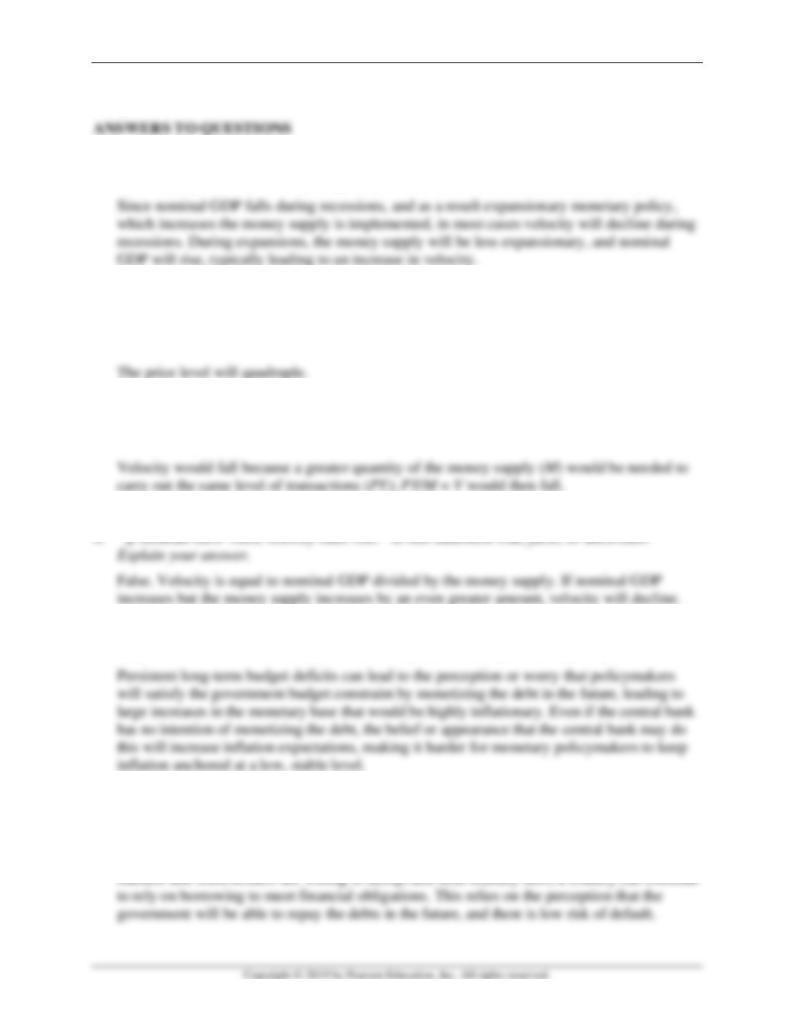
Mishkin • Instructor’s Manual for The Economics of Money, Banking, and Financial Markets, Twelfth Edition 210
Chapter 19
1. How would you expect velocity to typically behave over the course of the business cycle?
2. If velocity and aggregate output are reasonably constant (as the classical economists
believed), what will happen to the price level when the money supply increases from $1
trillion to $4 trillion?
3. If credit cards were made illegal by congressional legislation, what would happen to
velocity? Explain your answer.
5. Why would a central bank be concerned about persistent, long-term budget deficits?
6. “Persistent budget deficits always lead to higher inflation.” Is this statement true, false, or
uncertain? Explain your answer.
Uncertain. As long as a country (such as the United States) has reliable access to bond
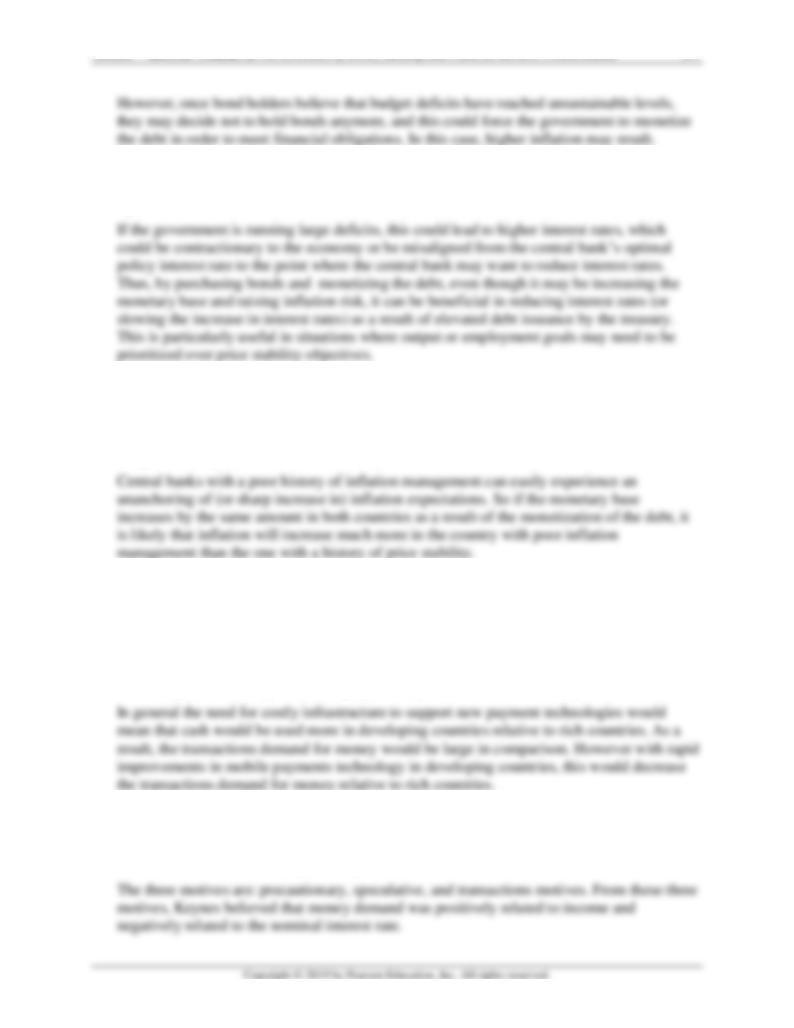
Mishkin • Instructor’s Manual for The Economics of Money, Banking, and Financial Markets, Twelfth Edition 211
7. Why might a central bank choose to monetize the debt, knowing that it could lead to higher
inflation?
8. Consider two central banks: one with a history of maintaining price stability and low
inflation, and the other with a history of high inflation and poor inflation management. All
else equal, if the same level of government budget deficit is monetized in both countries, how
is inflation likely to behave in each country?
9. Some payment technologies require infrastructure (e.g., merchants need to have access to
credit card swiping machines). In most developing countries historically this infrastructure
has either been nonexistent or very costly however recent mobile payment systems have
expanded rapidly in developing countries as they have become cheaper. Everything else
being equal, would you expect the transaction component of the demand for money to be
increasing or decreasing in a developing country relative to a rich country?
10. What three motives for holding money did Keynes consider in his liquidity preference theory
of the demand for real money balances? On the basis of these motives, what variables did he
think determined the demand for money?
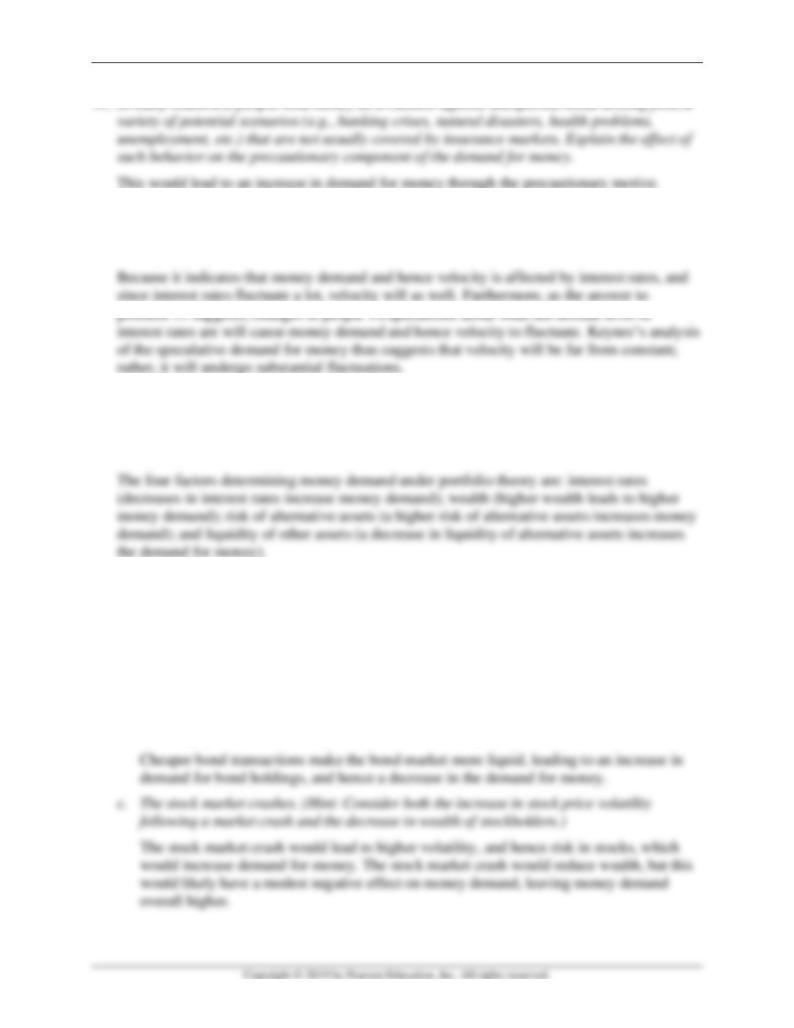
Mishkin • Instructor’s Manual for The Economics of Money, Banking, and Financial Markets, Twelfth Edition 212
12. Why is Keynes’s analysis of the speculative demand for money important to his view that
velocity will undergo substantial fluctuations and thus cannot be treated as constant?
13. According to the portfolio theories of money demand, what are the four factors that
determine money demand? What changes in these factors can increase the demand for
money?
14. Explain how the following events will affect the demand for money according to the portfolio
theories of money demand:
a. The economy experiences a business cycle contraction.
Since risk of alternative assets increases, liquidity of alternative assets likely decreases, and
interest rates likely will fall, this will lead to an increase in money demand. Note that
even though wealth decreases, this will have a modest negative effect on money demand.
b. Brokerage fees decline, making bond transactions cheaper.
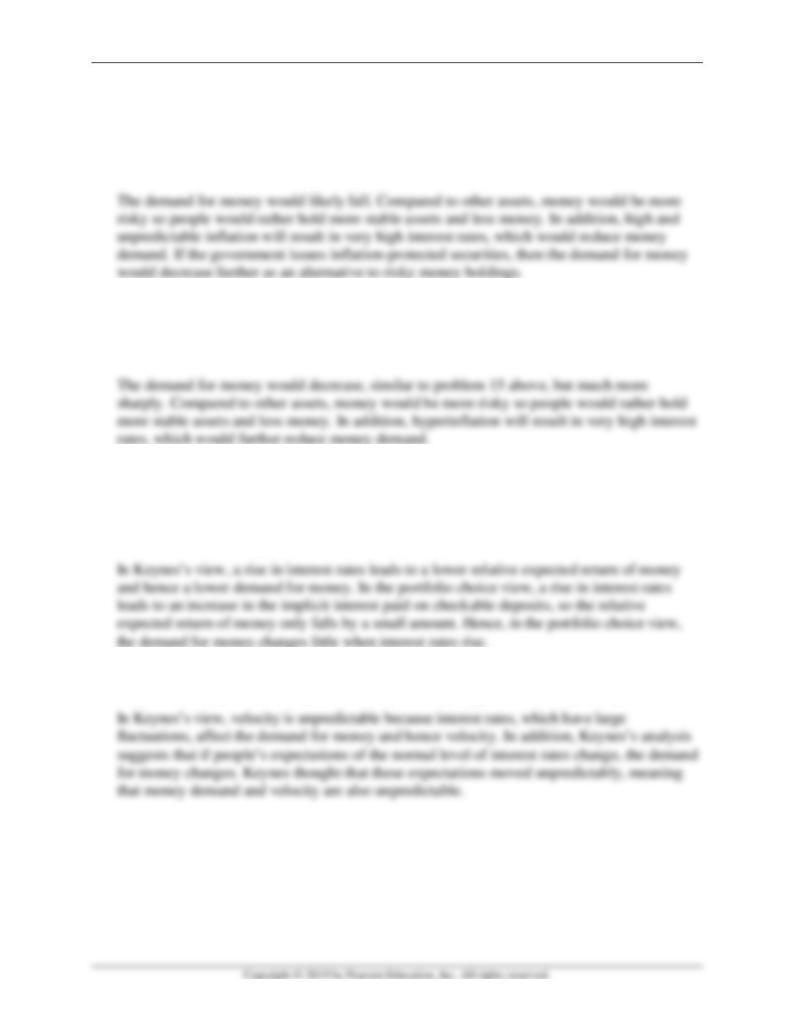
Mishkin • Instructor’s Manual for The Economics of Money, Banking, and Financial Markets, Twelfth Edition 213
15. Suppose a given country experienced low and stable inflation rates for quite some time, but
then inflation picked up and over the past decade has been relatively high and quite
unpredictable. Explain how this new inflationary environment would affect the demand for
money according to portfolio theories of money demand. What would happen if the
government decided to issue inflation-protected securities?
16. Consider the portfolio choice theory of money demand. How do you think the demand for
money would be affected during a hyperinflation (i.e., monthly inflation rates in excess of
50%)?
17. Both the portfolio choice and Keynes’s theories of the demand for money suggest that as the
relative expected return on money falls, demand for it will fall. Why does the portfolio choice
approach predict that money demand is affected by changes in interest rates? Why did
Keynes think that money demand is affected by changes in interest rates?
18. Why does the Keynesian view of the demand for money suggest that velocity is unpredictable?
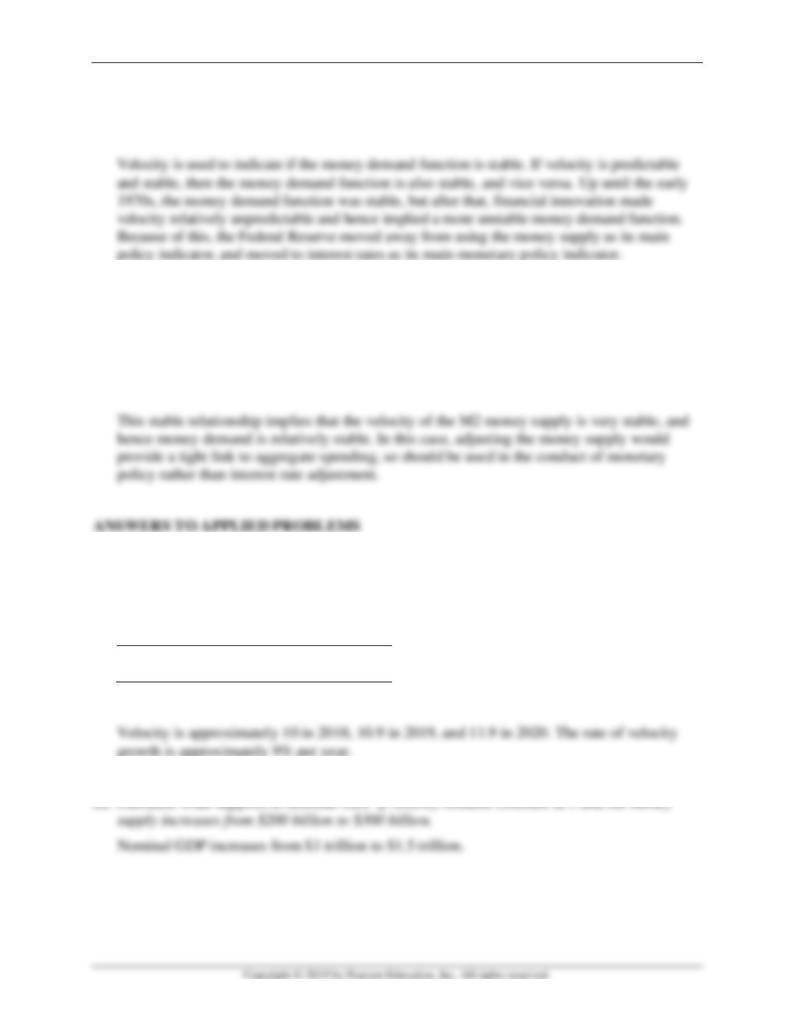
Mishkin • Instructor’s Manual for The Economics of Money, Banking, and Financial Markets, Twelfth Edition 214
19. What evidence is used to assess the stability of the money demand function? What does the
evidence suggest about the stability of money demand, and how has this conclusion affected
monetary policymaking?
20. Suppose that a plot of the values of M2 and nominal GDP for a given country over 40 years
shows that these two variables are very closely related. In particular, a plot of their ratio
(nominal GDP/M2) yields very stable and easy-to-predict values. On the basis of this
evidence, would you recommend that the monetary authorities of this country conduct
monetary policy by focusing mostly on the money supply rather than on setting interest
rates? Explain.
21. Suppose the money supply M has been growing at 10% per year, and nominal GDP, PY, has
been growing at 20% per year. The data are as follows (in billions of dollars):
2018
2019
2020
M
100
110
121
PY
1,000
1,200
1,440
Calculate the velocity for each year. At what rate is the velocity growing?
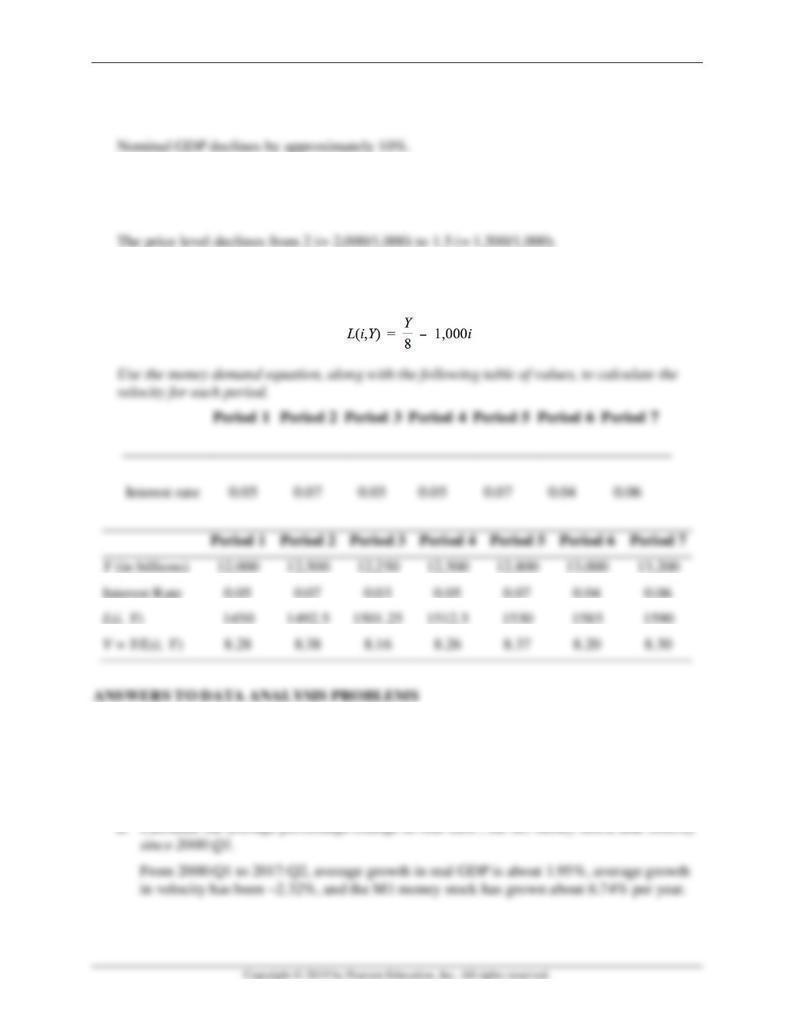
Mishkin • Instructor’s Manual for The Economics of Money, Banking, and Financial Markets, Twelfth Edition 215
23. What happens to nominal GDP if the money supply grows by 20% but velocity declines by
30%?
24. If velocity and aggregate output remain constant at 5 and $1,000 billion, respectively, what
happens to the price level if the money supply declines from $400 billion to $300 billion?
25. Suppose the liquidity preference function is given by
1. Go to the St. Louis Federal Reserve FRED database, and find data on the M1 Money Stock
(M1SL), M1 Money Velocity (M1V), and Real GDP (GDPC1). Convert the M1SL data series
to “quarterly” using the frequency setting, and for all three series, use the “Percent Change
from Year Ago” setting for units.

Mishkin • Instructor’s Manual for The Economics of Money, Banking, and Financial Markets, Twelfth Edition 216
– 2.32 – 1.95 = 2.46%.
2. Go to the St. Louis Federal Reserve FRED database and find data on the budget deficit
(FYFSD), the amount of federal debt held by the public (FYGFDPUN), and the amount of
federal debt held by the Federal Reserve (FDHBFRBN). Convert the two “debt held” series
to “Annual” using the frequency setting. Download all three series into a spreadsheet. Make
sure that the rows of data align properly to the correct dates. Note that for the deficit series,
a negative number indicates a deficit; multiply the series by –1 so that a deficit is indicated
by a positive number. Manipulate the three series so that all data are given in terms of the
same units (either millions or billions of dollars). To do this, if a series is in millions and you
are converting it to billions, divide the series by 1000. Finally, for each year, convert the two
“debt held” series into one “changes in debt holdings by the public and the Federal
Reserve” series by calculating, for each year, the difference in bond holdings from the
preceding year.
a. Create a scatter plot showing the deficit on the horizontal axis and the change in bond
holdings by the public on the vertical axis, using the data from 1980 through the most
recent period of data available. Insert a fitted line into the scatter plot, and comment on
the relationship between the deficit and the change in public bond holdings.
b. Create a scatter plot showing the deficit on the horizontal axis and the change in bond
holdings by the Federal Reserve on the vertical axis, using the data from 1980 through
the most recent period of data available. Insert a fitted line into the scatter plot, and
comment on the relationship between the deficit and the change in Federal Reserve
bond holdings.
c. Now repeat part (b), but create separate scatterplots for the period of 1980 to 2007, and
2008 to the most recent year. Comment on how, if at all, the monetizing of the debt is
exhibited in the data. Do you think the relationship between the deficit and the change in
bond holdings of the Federal Reserve has changed since 2008? Why or why not?
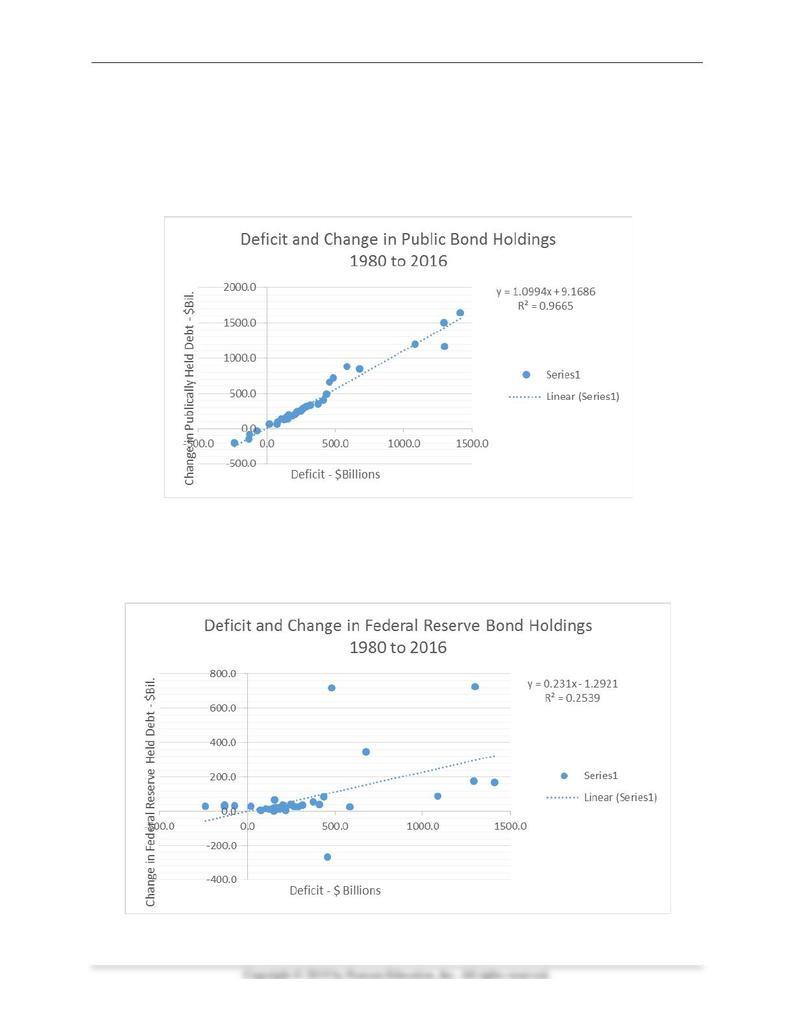
Mishkin • Instructor’s Manual for The Economics of Money, Banking, and Financial Markets, Twelfth Edition 217
a. See below. Not surprisingly, from 1980 to 2016, there appears to be a very strong
relationship between deficits and the change in bond holdings by the public, as the fitted
line is very steep (and has a high R-squared if using a regression line), and has close to a
one-to-one relationship. Thus, from this data it appears that the public absorbs all of the
new debt issued.
b. See graph below. For the change in holdings by the Federal Reserve, there appears to be a
positive relationship suggesting some monetization of the debt, but this is much less
obvious (and using a fitted regression line indicates a much smaller relationship, with less
predictive power). In particular, for each $1 of deficit, the Fed absorbs about 23 cents of
it in debt holdings.

Mishkin • Instructor’s Manual for The Economics of Money, Banking, and Financial Markets, Twelfth Edition 218
c. See graph below. There appears to be some amount of debt monetization in the
scatterplot data in the post-crisis period: in general, as the deficits get significantly larger
during 2008 to 2016, the change in bond holdings by the Fed gets larger, indicating the
central bank is facilitating higher deficits. Looking separately at the period of 1980 to
2007 shows virtually no relationship between Federal Reserve debt holdings and deficits
(see below; both the R-squared and the coefficient are close to zero). This is not
surprising, since the Federal Reserve instituted several large-scale asset purchase
programs during the post-crisis period, much of which was purchases of U.S. Treasuries,
at a time when the United States was running very large deficits.
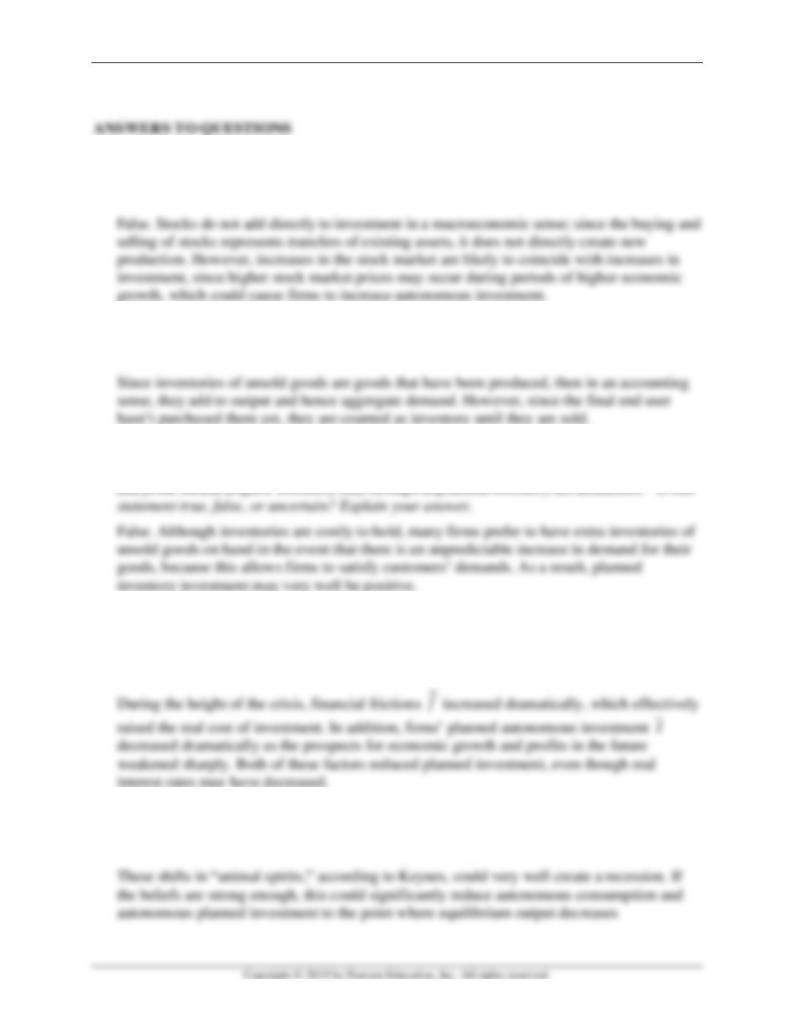
Mishkin • Instructor’s Manual for The Economics of Money, Banking, and Financial Markets, Twelfth Edition 219
Chapter 20
1. “When the stock market rises, investment spending is increasing.” Is this statement true, false,
or uncertain? Explain your answer.
2. Why is inventory investment counted as part of aggregate spending if it isn’t actually sold to
the final end user?
3. “Since inventories can be costly to hold, firms’ planned inventory investment should be zero,
4. During and in the aftermath of the financial crisis of 2007–2009, planned investment fell
substantially despite significant decreases in the real interest rate. What factors related to
the planned investment function could explain this?
5. If households and firms believe the economy will be in a recession in the future, will this
necessarily cause a recession, or have any impact on output at all?

Mishkin • Instructor’s Manual for The Economics of Money, Banking, and Financial Markets, Twelfth Edition 220
6. Why do increases in the real interest rate lead to decreases in net exports, and vice versa?
7. How would a decline in house prices, or decrease in stock market prices affect the IS curve?
8. If firms suddenly become more optimistic about the profitability of investment and planned
investment spending rises by $100 billion, while consumers become more pessimistic and
autonomous consumer spending falls by $100 billion, what happens to aggregate output?
9. If an increase in autonomous consumer expenditure is matched by an equal increase in taxes,
will aggregate output rise or fall?
10. If a change in the interest rate has no effect on planned investment spending or net exports,
what does this imply about the slope of the IS curve?
11. Inventories typically increase starting at the beginning of recessions, and begin to decline
near the end of recessions. What does this say about the relationship between planned
spending and aggregate output over the business cycle?
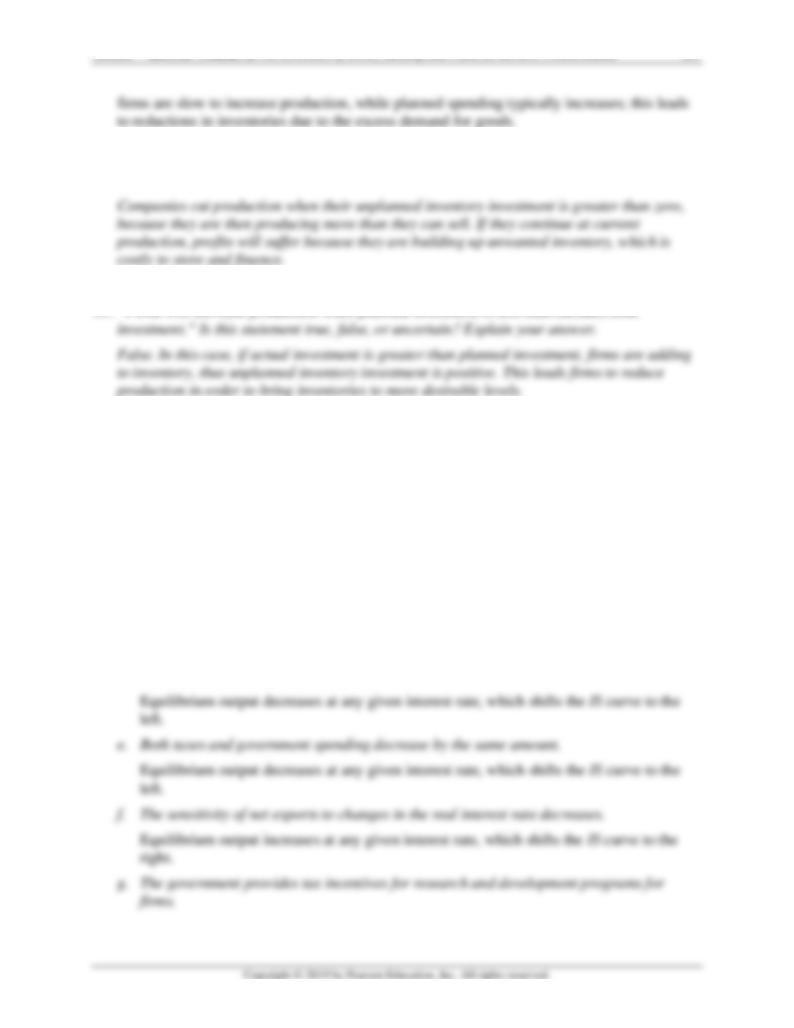
Mishkin • Instructor’s Manual for The Economics of Money, Banking, and Financial Markets, Twelfth Edition 221
12. Why do companies cut production when they find that their unplanned inventory investment
is greater than zero? If they didn’t cut production, what effect would this have on their
profits? Why?
14. In each of the cases below, determine whether the IS curve shifts to the right or left, does not
shift, or is indeterminate in the direction of shift.
a. The real interest rate rises.
This is a movement along the IS curve, and so does not shift the IS curve.
b. The marginal propensity to consume declines.
This results in a decrease in equilibrium output at any given interest rate, which shifts the
IS curve to the left.
c. Financial frictions increase.
Equilibrium output decreases at any given interest rate, which shifts the IS curve to the
left.
d. Autonomous consumption decreases.
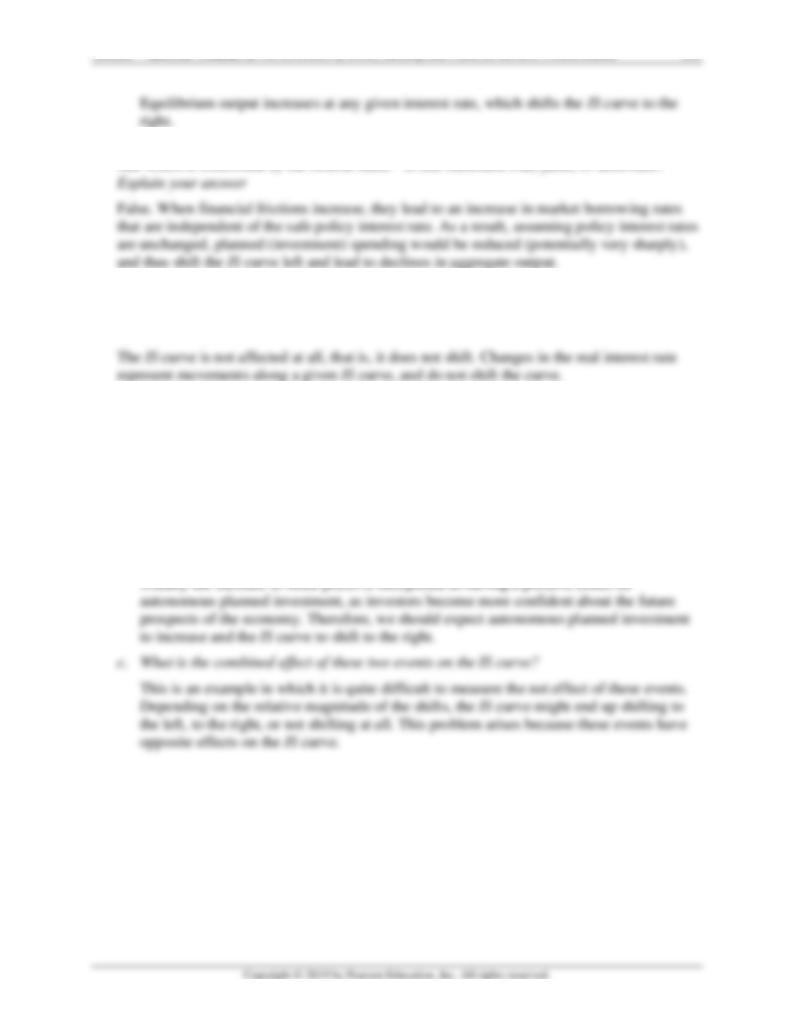
Mishkin • Instructor’s Manual for The Economics of Money, Banking, and Financial Markets, Twelfth Edition 222
15. Financial frictions are not a problem for the economy, since they do not affect the safe policy
16. When the Federal Reserve reduces its policy interest rate, how, if at all, is the IS curve
affected? Briefly explain.
17. Suppose you read that prospects for stronger future economic growth have led the dollar to
strengthen and stock prices to increase.
a. What effect does the strengthened dollar have on the IS curve?
A more expensive dollar will result in fewer U.S. exports and more U.S. imports
(everything else the same), therefore decreasing net exports. Graphically, this shifts the IS
curve to the left, decreasing aggregate output at every interest rate.
b. What effect does the increase in stock prices have on the IS curve?
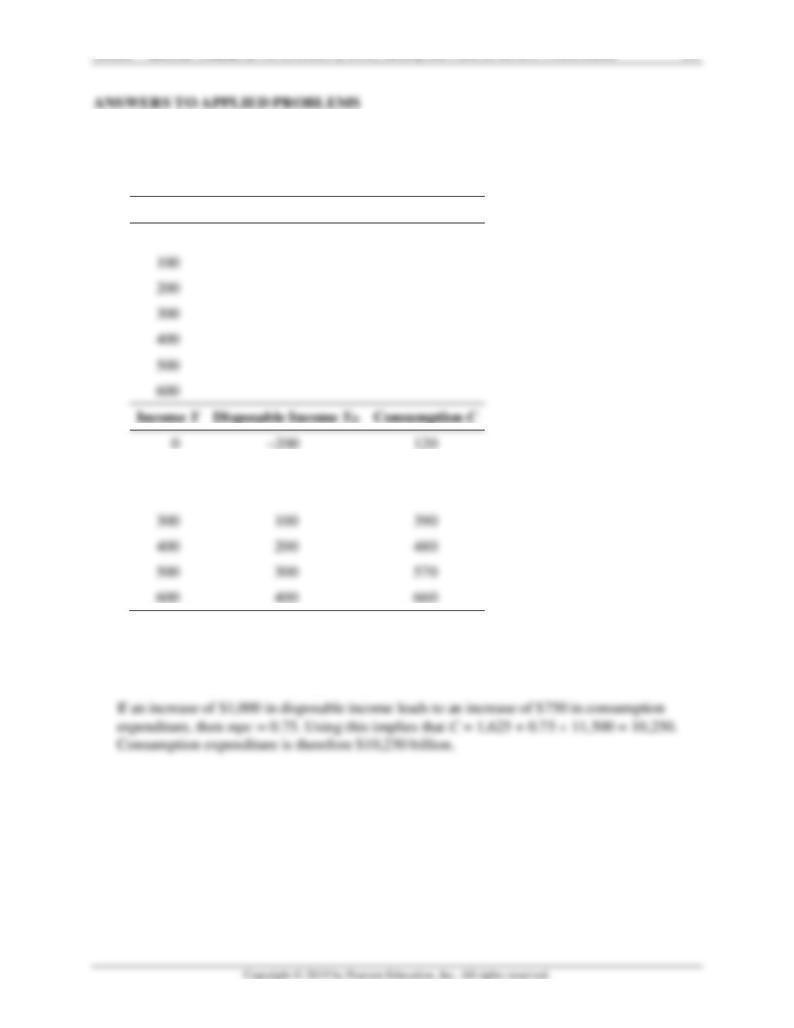
Mishkin • Instructor’s Manual for The Economics of Money, Banking, and Financial Markets, Twelfth Edition 223
18. Calculate the value of the consumption function at each level of income in the table below if
autonomous consumption = 300, taxes = 200, and mpc = 0.9.
Income Y
Disposable Income YD
Consumption C
0
100
–100
210
200
0
300
19. Assume that autonomous consumption is $1,625 billion and disposable income is $11,500
billion. Calculate consumption expenditure if an increase of $1,000 in disposable income leads
to an increase of $750 in consumption expenditure.
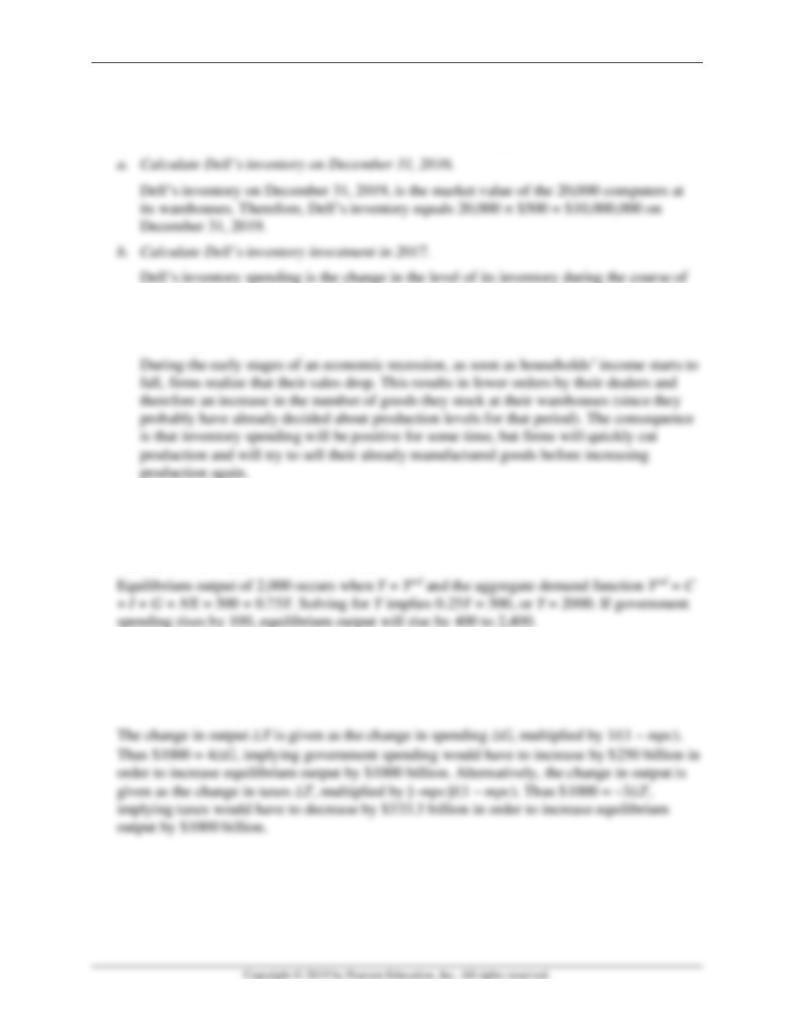
Mishkin • Instructor’s Manual for The Economics of Money, Banking, and Financial Markets, Twelfth Edition 224
20. Suppose that Dell Corporation has 20,000 computers in its warehouses on December 31,
2016, ready to be shipped to merchants (each computer is valued at $500). By December 31,
2017, Dell Corporation has 25,000 computers ready to be shipped, each valued at $450.
2020. On December 31, 2020, Dell’s inventory equals 25,000 × $450 = $11,250,000.
Therefore, Dell’s inventory spending in 2020 is $1,250,000 = $11,250,000 - $10,000,000.
c. What happens to inventory spending during the early stages of an economic recession?
21. If the consumption function is C = 100 + 0.75YD, I = 200, government spending is 200, and
net exports are zero, what will be the equilibrium level of output? What will happen to
aggregate output if government spending rises by 100?
22. If the marginal propensity to consume is 0.75, by how much would government spending
have to rise to increase output by $1,000 billion? By how much would taxes need to decrease
to increase output by $1,000 billion?
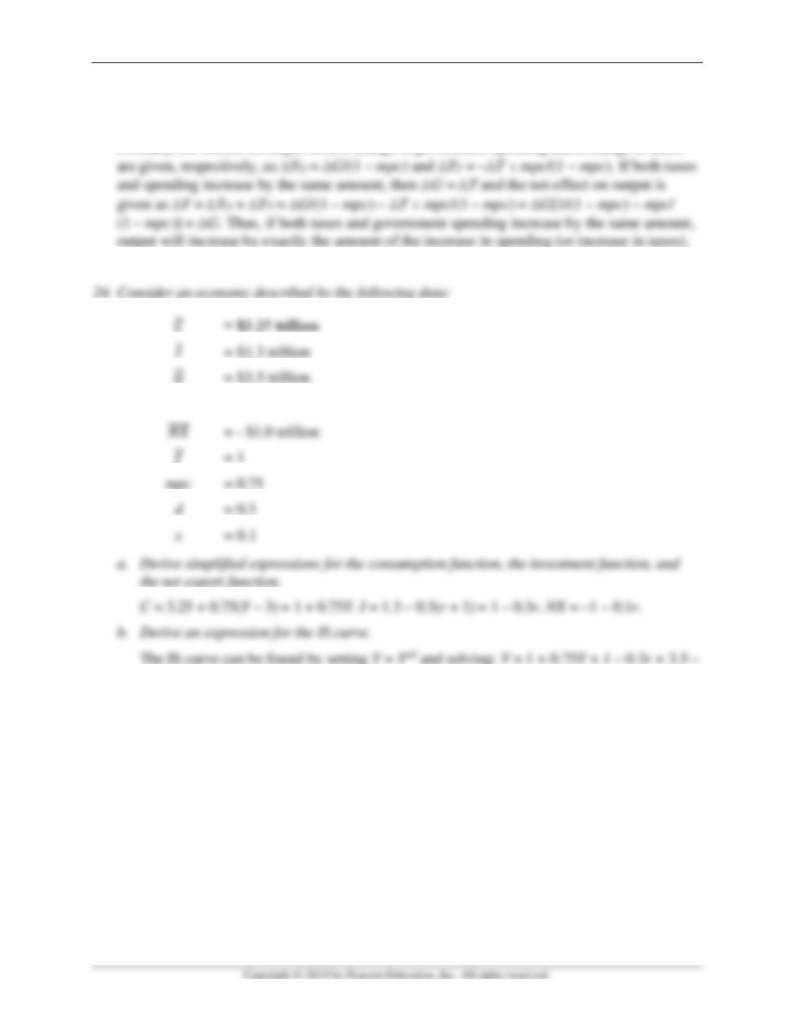
Mishkin • Instructor’s Manual for The Economics of Money, Banking, and Financial Markets, Twelfth Edition 225
23. Assuming both taxes and government spending increase by the same amount, derive an
expression for the effect on equilibrium output.
Formally, the effects on output from a change in government spending and a change in taxes
𝐶
𝐺
𝑇
= $3.0 trillion
𝑓
1 – 0.1r. This implies 0.25Y = 4.5 – 0.4r, or Y = 18 – 1.6r.
c. If the real interest rate is r = 2, what is equilibrium output? If r = 5, what is equilibrium
output?
At r = 2, equilibrium output is Y = 18 – 1.6(2) = $14.8 trillion; At r = 5, equilibrium output
is Y = 18 – 1.6(5) = $10 trillion.
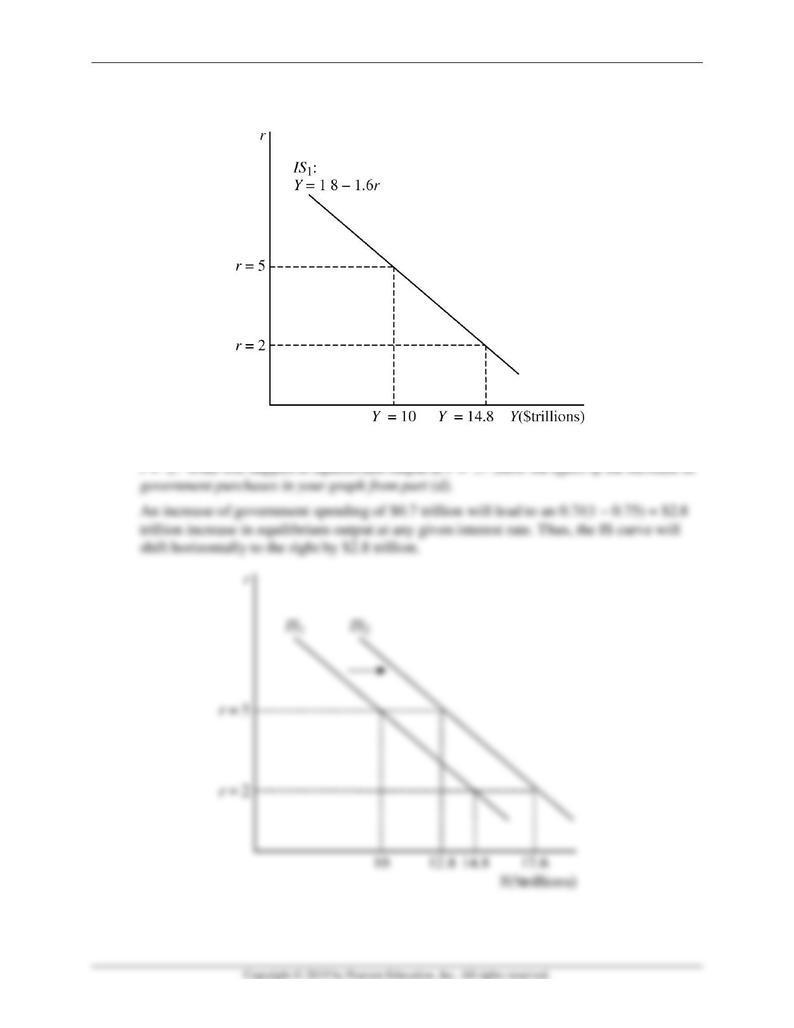
Mishkin • Instructor’s Manual for The Economics of Money, Banking, and Financial Markets, Twelfth Edition 226
d. Draw a graph of the IS curve showing the answers from part (c) above.
e. If government purchases increase to $4.2 trillion, what will happen to equilibrium output at

Mishkin • Instructor’s Manual for The Economics of Money, Banking, and Financial Markets, Twelfth Edition 227
𝐶
𝐺
𝑇
= $3.0 trillion
𝑓
x
= 0.1
4. What is the equilibrium level of output?
c. Suppose that a financial crisis begins, and 𝑓
increases to 𝑓
= 3. What will happen to
equilibrium output? If the Federal Reserve can set the interest rate, then at what level
should the interest rate be set to keep output from changing?
to r = 1.9.
d. Suppose the financial crisis causes 𝑓
to increase as indicated in part (c) and also causes
planned autonomous investment to decrease to 𝐼 = $1.1 trillion. Will the change in the
interest rate implemented by the Federal Reserve in part (c) be effective in stabilizing
output? If not, what additional monetary or fiscal policy changes could be implemented
to stabilize output at the original equilibrium output level given in part (b)?
= 1.9). All three of these policies separately would maintain output at Y = $25.5 trillion.
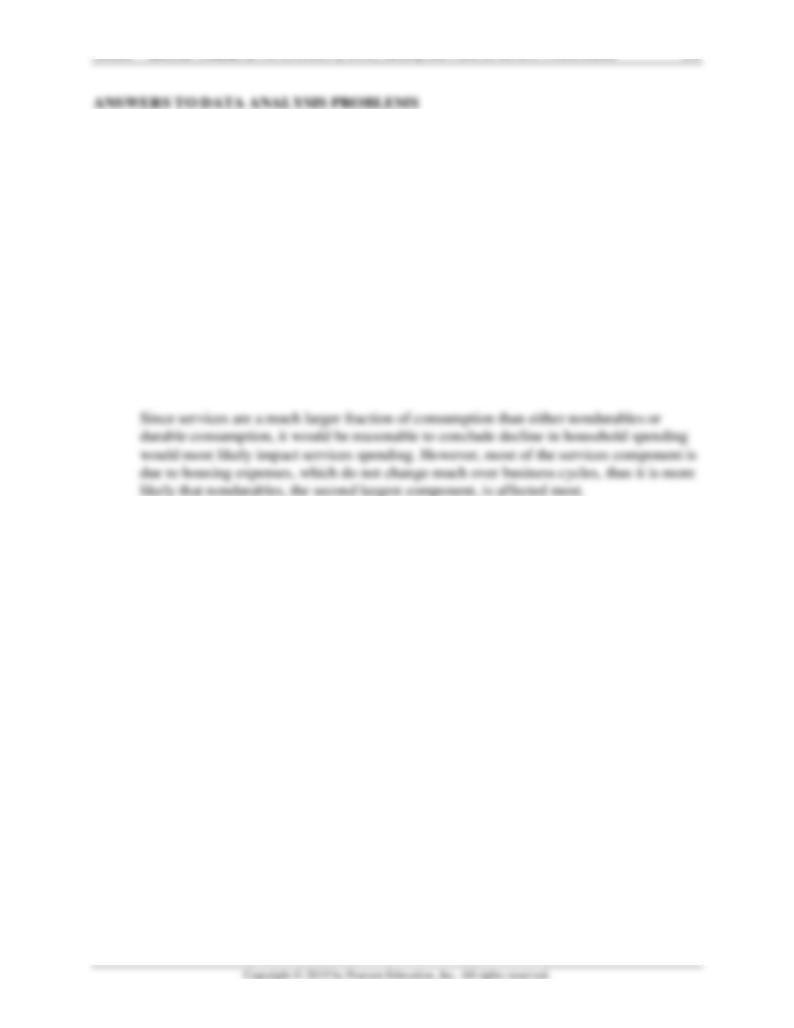
Mishkin • Instructor’s Manual for The Economics of Money, Banking, and Financial Markets, Twelfth Edition 228
1. Go to the St. Louis Federal Reserve FRED database and find data on Personal Consumption
Expenditures (PCEC), Personal Consumption Expenditures: Durable Goods (PCDG),
Personal Consumption Expenditures: Nondurable Goods (PCND), and Personal
Consumption Expenditures: Services (PCESV).
a. Using the most recent data: What percentage of total household expenditures is devoted
to the consumption of goods (both durable and nondurable goods)?
For 2017:Q1, total personal consumption expenditures are $13,191.6 billion, nondurable
consumption is $2787.6 billion, and durables consumption is $1443.2 billion. Thus,
nondurables represent 100*2787.6/13,191.6 = 21.1%, and durables represents
100*1443.2/13,191.6 = 10.9%. Services is the largest part of consumption, at
100*8960.7/13,191.6 = 67.9%
b. Given these data, which specific component of household expenditures would be most
impacted by a reduction in overall household spending? Explain.
2. Go to the St. Louis Federal Reserve FRED database and find data on Real Private Domestic
Investment (GPDIC1), a measure of the real interest rate; the 10-year Treasury Inflation-
Indexed Security, TIIS (FII10); and the spread between Baa corporate bonds and the 10-year
U.S. treasury (BAA10YM), a measure of financial frictions. For (FII10) and (BAA10YM),
convert the frequency setting to “quarterly,” and download the data into a spreadsheet. For
each quarter, add the (FII10) and (BAA10YM)series to create ri, the real interest rate for
investments for that quarter. Then calculate the change in both investment and ri as the
change in each variable from the previous quarter.
a. For the eight most recent quarters of data available, calculate the change in investment
from the previous quarter, and then calculate the average change over the eight most
recent quarters.
From 2015:Q2 to 2017:Q1, the average change in investment was –$1.05 (billion) per
quarter.
b. Assume there is a one-quarter lag between movements in ri and changes in investment; in
other words, if ri changes in the current quarter, it will affect investment in the next
quarter. For the eight most recent lagged quarters of data available, calculate the one-
quarter-lagged average change in ri.
From 2015:Q1 to 2016:Q4, the average change in ri was –0.01.
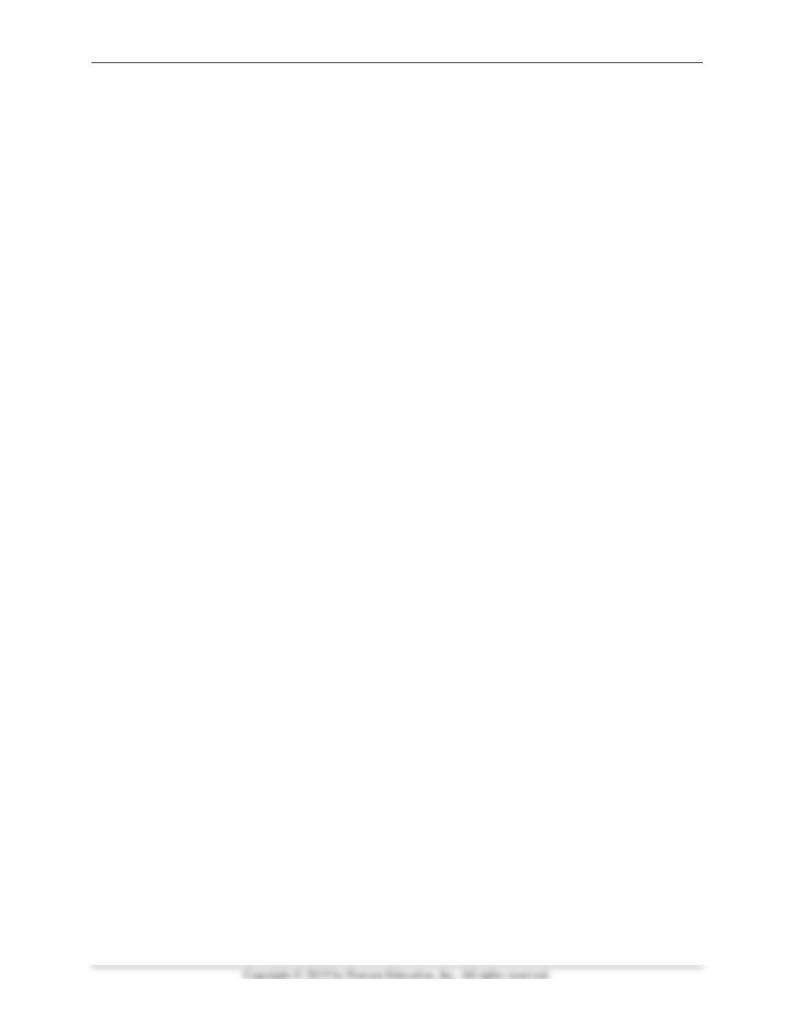
Mishkin • Instructor’s Manual for The Economics of Money, Banking, and Financial Markets, Twelfth Edition 229
c. Take the ratio of your answer from part (a) divided by your answer from part (b). What
does this value represent? Briefly explain.
The ratio of the changes is –1.05/–0.01 = 120; the absolute value of this represents the
coefficient on the investment function; that is, for every one percentage point increase in
ri, real private domestic investment increases by about $120 billion. Note that this is
contrary to what you should expect in theory.
d. Repeat parts (a) through (c) for the period 2008:Q3 to 2009:Q2. How do financial
frictions help explain the behavior of investment during the financial crisis? How do the
coefficients on investment compare between the current period and the financial crisis
period? Briefly explain.
From 2008:Q3 to 2009:Q2, the average change in investment was –$163.0 (billion), and
from 2008:Q2 to 2009:Q1, the average change in ri was 0.72. The coefficient on
investment, d during that period is the absolute value of –160.0/0.72, or d = 222.2. Thus,
for every one percentage point increase in ri, real private domestic investment would fall
by about $222.2 billion. The financial frictions component partly helps explain the
significant decline in investments during the financial crisis period despite real interest
rates being relatively low, however other factors are clearly at play that are affecting the
value of the two coefficients that can’t be captured by the financial frictions data series.
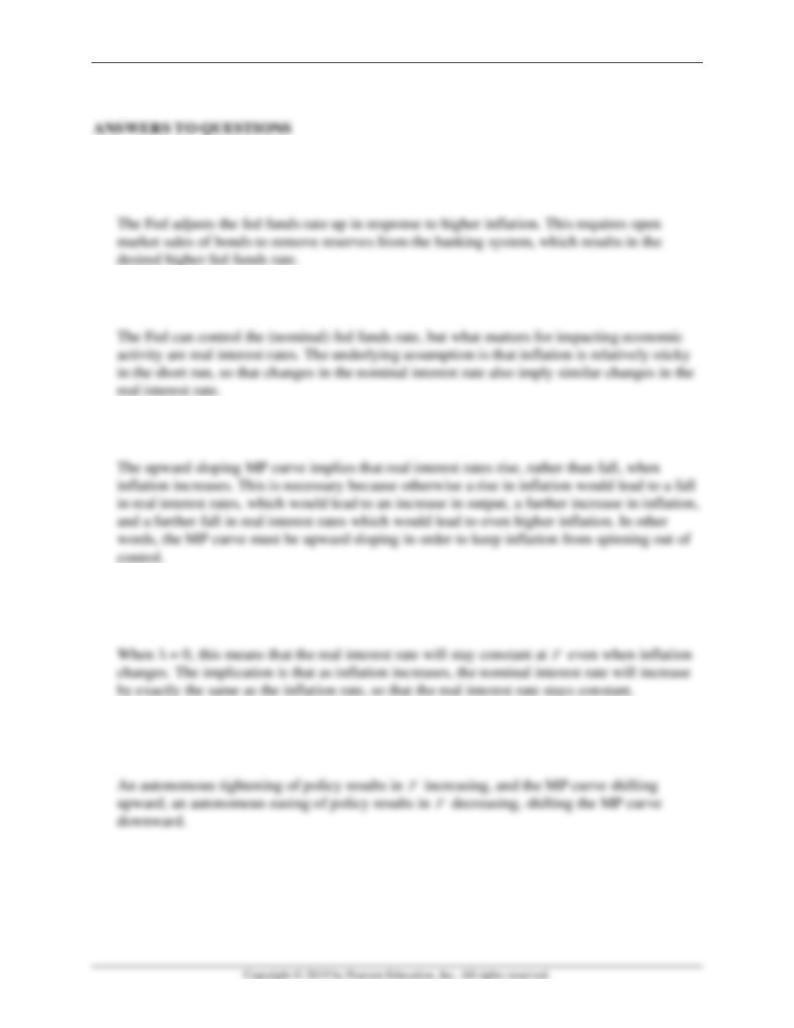
Mishkin • Instructor’s Manual for The Economics of Money, Banking, and Financial Markets, Twelfth Edition 230
Chapter 21
1. When the inflation rate increases, what happens to the federal funds rate? Operationally,
how does the Fed adjust the federal funds rate?
2. What is the key assumption underlying the Fed’s ability to control the real interest rate?
3. Why does the MP curve necessarily have an upward slope?
4. If = 0, what does this imply about the relationship between the nominal interest rate and
the inflation rate?
5. How does an autonomous tightening or easing of monetary policy by the Fed affect the MP
curve?
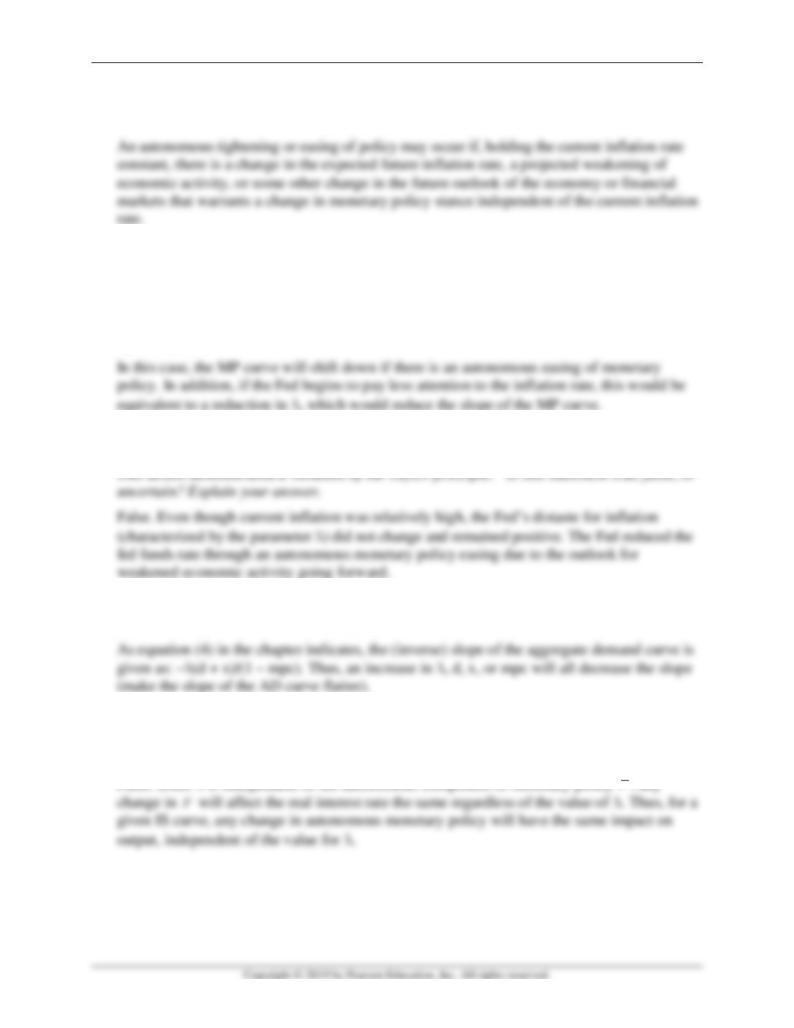
Mishkin • Instructor’s Manual for The Economics of Money, Banking, and Financial Markets, Twelfth Edition 231
6. How is an autonomous tightening or easing of monetary policy different from a change in the
real interest rate caused by a change in the current inflation rate?
7. Suppose that a new Fed chair is appointed and that his or her approach to monetary policy
can be summarized by the following statement: “I care only about increasing employment.
Inflation has been at very low levels for quite some time; my priority is to ease monetary
policy to promote employment.” How would you expect the monetary policy curve to be
affected, if at all?
8. “The Fed decreased the fed funds rate in late 2007, even though inflation was increasing.
9. What factors affect the slope of the aggregate demand curve?
10. “Autonomous monetary policy is more effective at changing output when is higher.” Is this
statement true, false, or uncertain? Explain your answer.
False. Since is independent of the autonomous component of monetary policy
r
, any
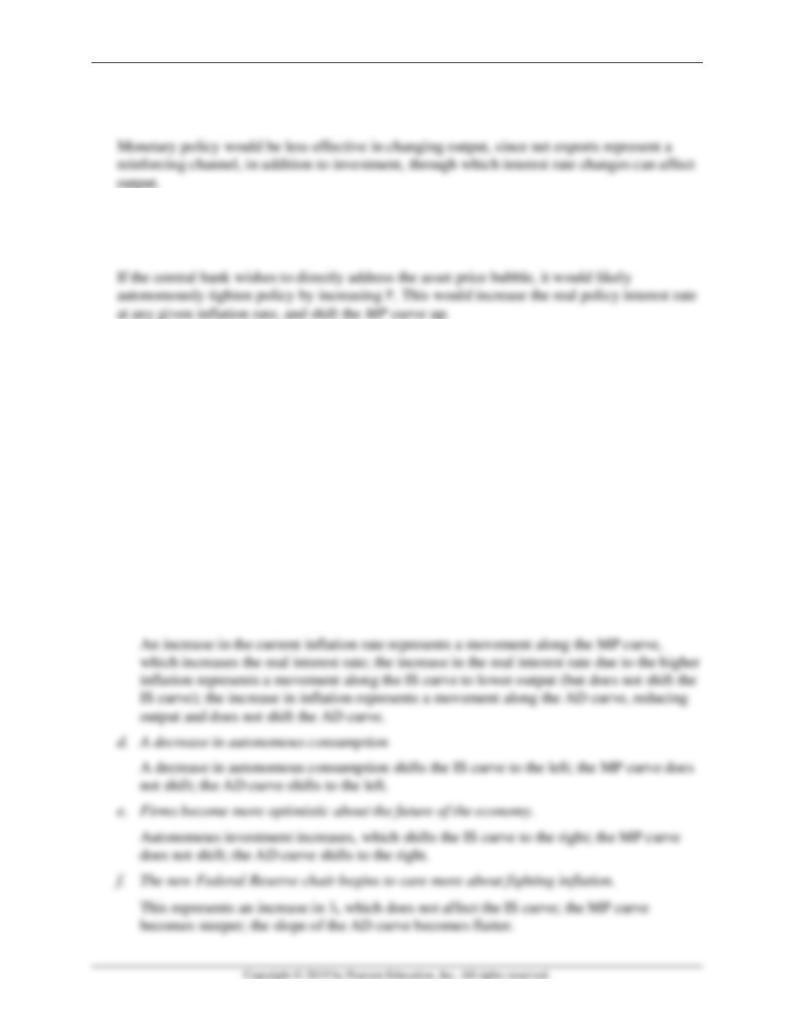
Mishkin • Instructor’s Manual for The Economics of Money, Banking, and Financial Markets, Twelfth Edition 232
11. If net exports were not sensitive to changes in the real interest rate, would monetary policy
be more or less effective in changing output?
12. If an asset price bubble begins to form, assuming the central bank responds, how is it likely
to respond, and what will be the effect on the MP curve?
13. For each of the following situations, describe how (if at all) the IS, MP, and AD curves are
affected.
a. A decrease in financial frictions
The IS curve shifts to the right; the MP curve does not shift; the AD curve shifts to the
right.
b. An increase in taxes and an autonomous easing of monetary policy
The increase in taxes shifts the IS curve to the left, and the easing of monetary policy
moves the economy along the IS curve; the tax change does not affect the MP curve, but
the monetary policy change shifts the MP curve down; the monetary policy easing shifts
the AD curve to the right, while the tax increase shifts the AD curve to the left; the net
effect on the AD curve cannot be determined without knowing the relative shifts due to
the tax and monetary easing effects.
c. An increase in the current inflation rate
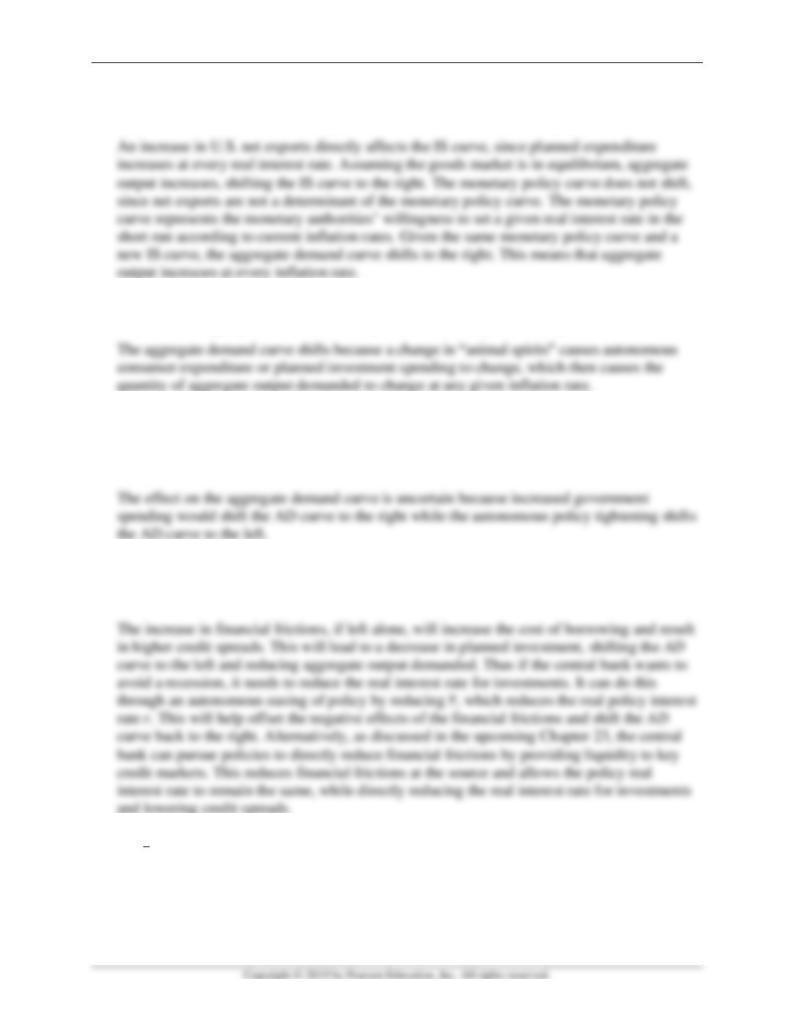
Mishkin • Instructor’s Manual for The Economics of Money, Banking, and Financial Markets, Twelfth Edition 233
14. What would be the effect of an increase in U.S. net exports on the aggregate demand curve?
Would an increase in net exports affect the monetary policy curve? Explain.
15. Why does the aggregate demand curve shift when “animal spirits” change?
16. Suppose that government spending is increased at the same time that an autonomous
monetary policy tightening occurs. What will happen to the position of the aggregate demand
curve?
17. If financial frictions increase, how will this affect credit spreads, and how might the central
bank respond? Why?
18. “If
f
increases, then the Fed can keep output constant by reducing the real interest rate by
the same amount as the increase in financial frictions.” Is this statement true, false, or
uncertain? Explain your answer.
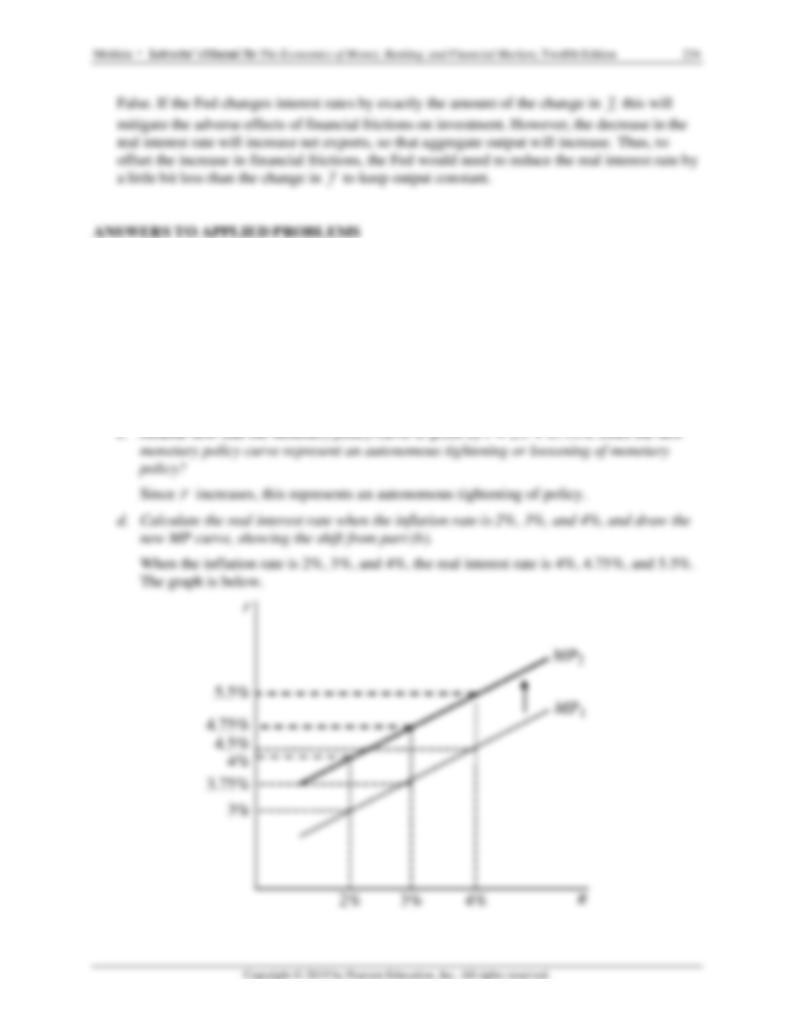
19. Assume that the monetary policy curve is given by r = 1.5 + 0.751
.
a. Calculate the real interest rate when the inflation rate is 2%, 3%, and 4%.
When the inflation rate is 2%, 3%, and 4%, the real interest rate is 3%, 3.75%, and 4.5%,
respectively.
b. Draw a graph of the MP curve, labeling the points from part (a).
See graph in (d) below.
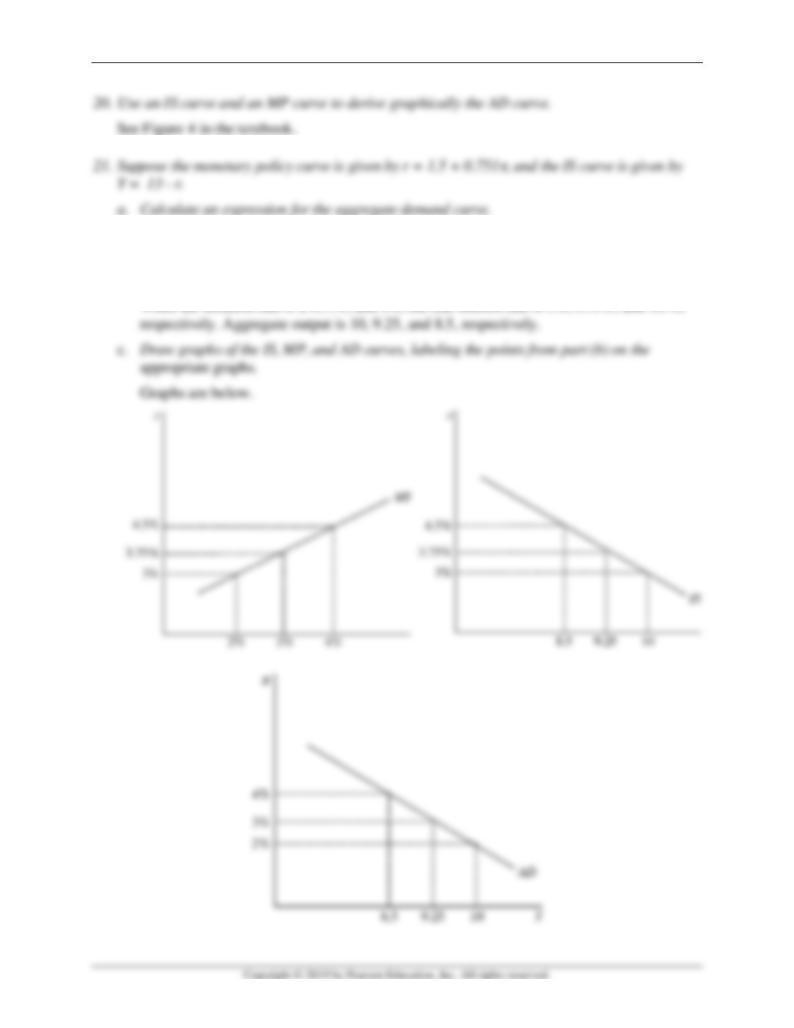
Mishkin • Instructor’s Manual for The Economics of Money, Banking, and Financial Markets, Twelfth Edition 235
Y = 11.5 – 0.75
.
b. Calculate the real interest rate and aggregate output when the inflation rate is 2%, 3%,
and 4%.
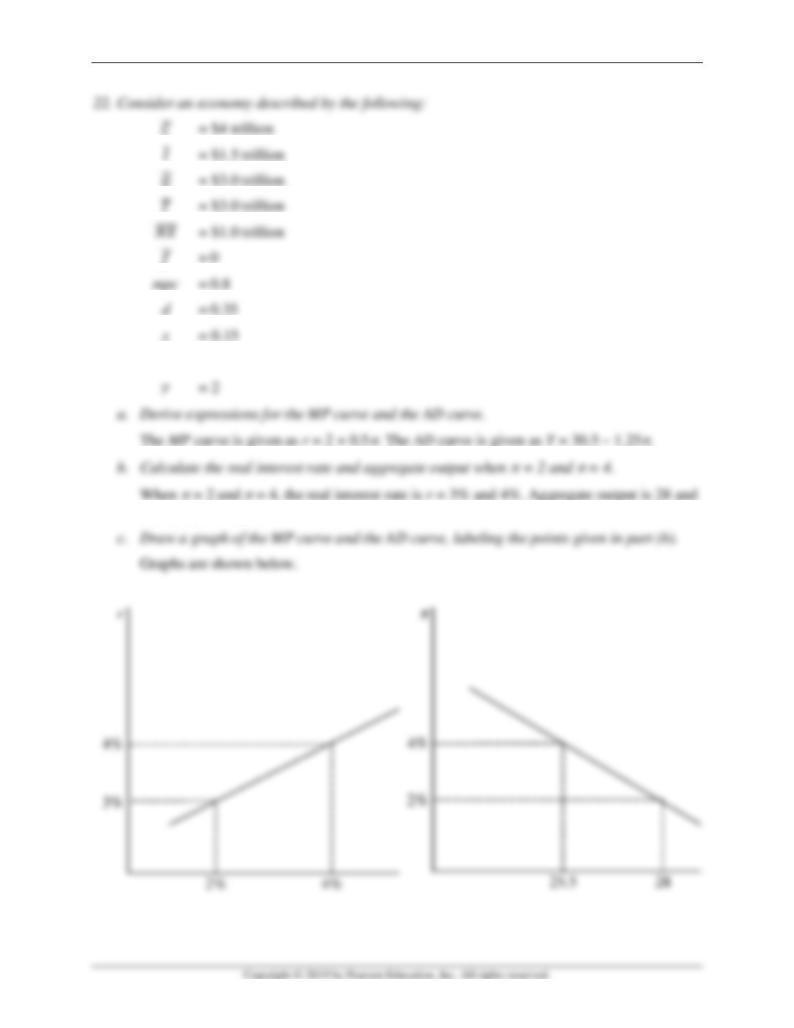
Mishkin • Instructor’s Manual for The Economics of Money, Banking, and Financial Markets, Twelfth Edition 236
𝐶
𝐺
𝑇
𝑓
= 0.5
25.5, respectively.
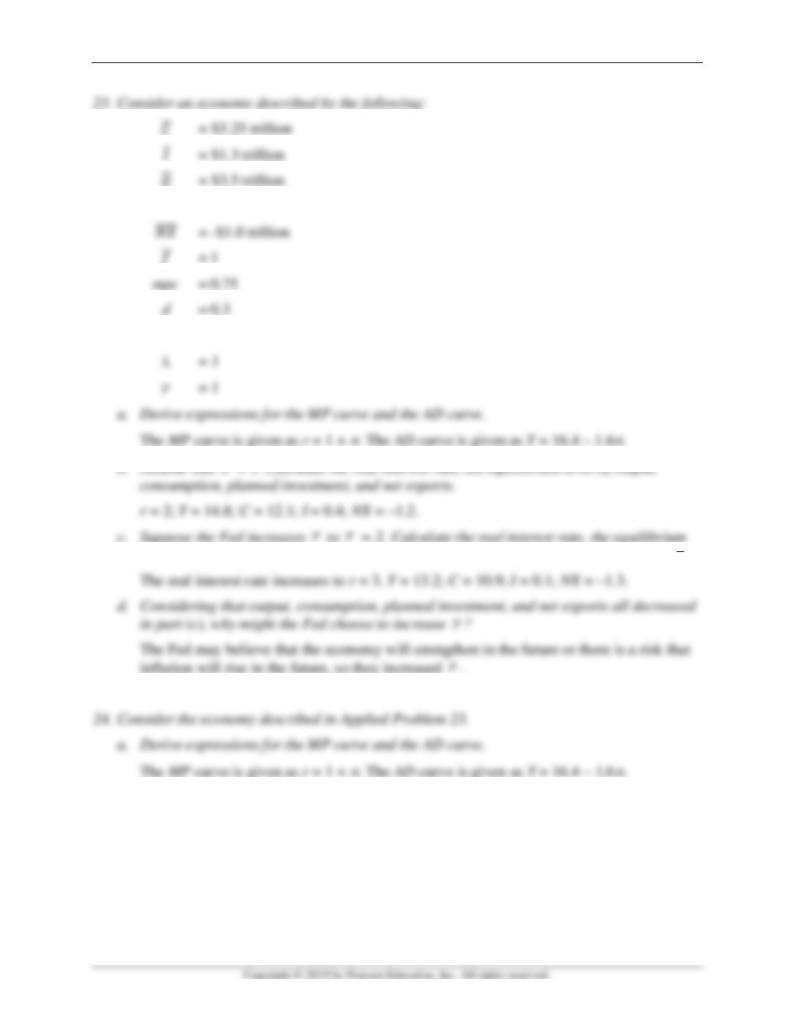
Mishkin • Instructor’s Manual for The Economics of Money, Banking, and Financial Markets, Twelfth Edition 237
𝐶
𝐺
𝑇
= $3.0 trillion
𝑓
x
= 0.1
r
to
r
= 2. Calculate the real interest rate, the equilibrium
level of output, consumption, planned investment, and net exports at this new level of
r
.
r
b. Assume that
= 2. What are the real interest rate and the equilibrium level of output?
r = 3; Y = $13.2 trillion.
c. Suppose government spending increases to $4 trillion. What happens to equilibrium
output?
When government spending increases by $0.5 trillion, output will increase by $2 trillion
to Y = $15.2 trillion.
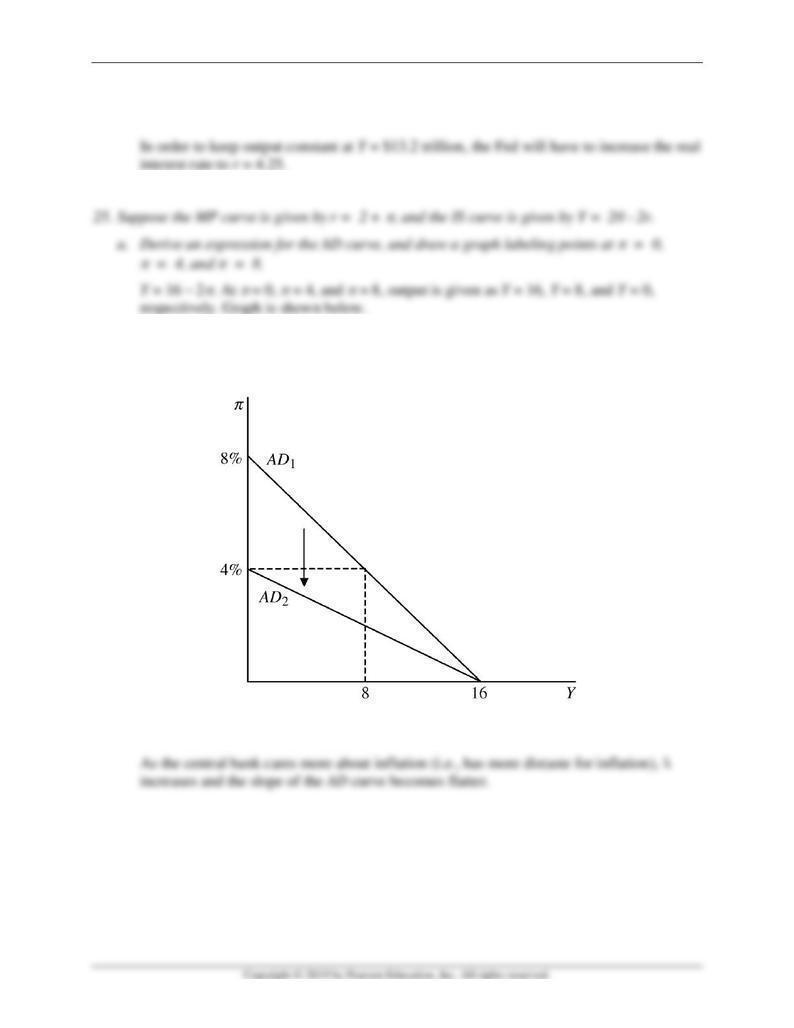
Mishkin • Instructor’s Manual for The Economics of Money, Banking, and Financial Markets, Twelfth Edition 238
d. If the Fed wants to keep output constant, then what monetary policy change should it
make?
b. Suppose that
increases to
= 2. Derive an expression for the new AD curve, and draw
the new AD curve using the graph from part (a).
Y = 16 – 4
. Graph is shown below, with graph from part (a).
c. What does your answer to part (b) imply about the relationship between a central bank’s
distaste for inflation and the slope of the AD curve?

Mishkin • Instructor’s Manual for The Economics of Money, Banking, and Financial Markets, Twelfth Edition 239
1. A measure of real interest rates can be approximated by the Treasury Inflation-Indexed
Security, or TIIS. Go to the St. Louis Federal Reserve FRED database and find data on the
five-year TIIS (FII5) and the personal consumption expenditure price index (PCECTPI), a
measure of the price index. Choose “Quarterly” for the frequency setting of the TIIS, and
download both data series. Convert the price index data to annualized inflation rates by
taking the quarter-to-quarter percent change in the price index and multiplying it by 4. Be
sure to multiply by 100 so that your results are percentages.
a. Calculate the average inflation rate and the average real interest rate over the most
recent four quarters of data available, and the four quarters prior to that.
For the period of 2015:Q2 to 2016:Q1, average inflation was 0.95%, and the average real
2. A measure of real interest rates can be approximated by the Treasury Inflation-Indexed
Security, or TIIS. Go to the St. Louis Federal Reserve FRED database and find data on the
five-year TIIS (FII5) and the personal consumption expenditure price index (PCECTPI), a
measure of the price index. Choose “Quarterly” for the frequency setting for the TIIS, and
choose “Percent Change From Year Ago” for the units setting on (PCECTPI). Plot both
series on the same graph, using data from 2007 through the most current data available. Use
the graph to identify periods of autonomous monetary policy changes. Briefly explain your
reasoning.
See graph below. Periods of autonomous monetary policy change are characterized by a
decoupling of real rates and inflation rates. From the middle of 2007 to late 2008, inflation
increased, while the real interest rate fell, indicating an autonomous easing of policy. The
period from late 2008 through mid-2009 was consistent with a move along the MP curve,
where policy was reacting to variation in inflation. From mid-2009 through mid-2011,
inflation rose steadily, while the real interest rate continued to decline, suggesting
autonomous easing of policy. From mid-2011 to early 2013, both inflation and the real
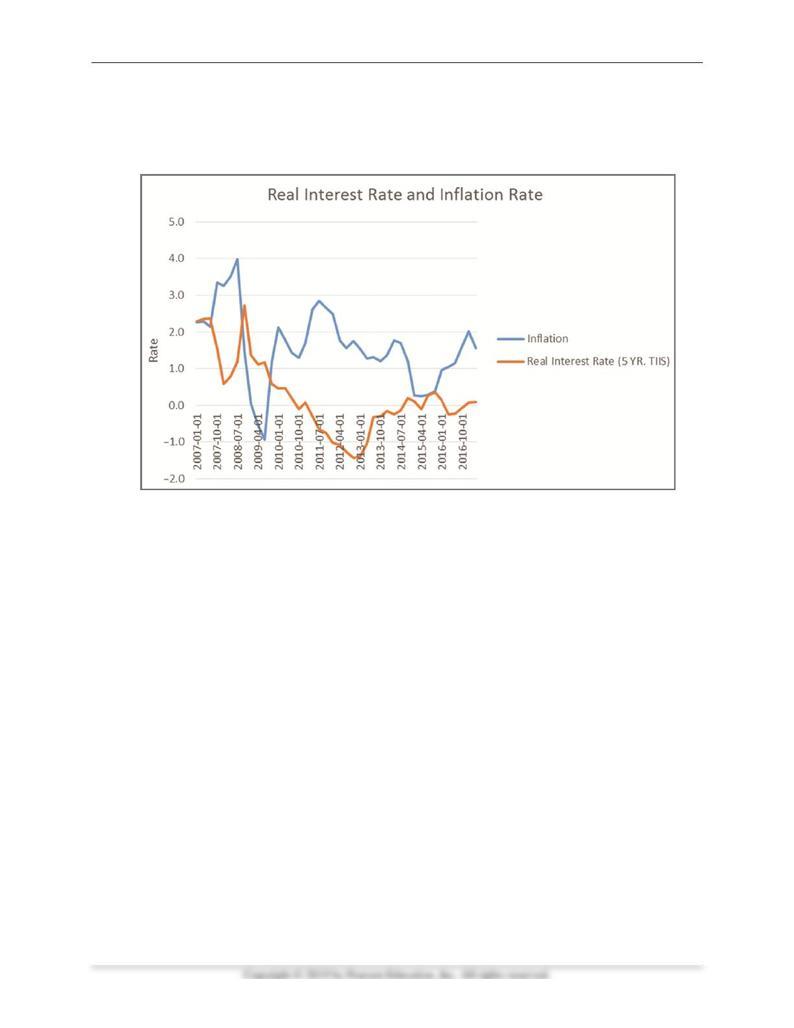
Mishkin • Instructor’s Manual for The Economics of Money, Banking, and Financial Markets, Twelfth Edition 240
interest rate fell, again suggesting a movement along the MP curve as policy reacted to
changes in inflation. After that, the real interest rate was largely decoupled from inflation
movements, suggesting autonomous policy changes occurred.

Mishkin • Instructor’s Manual for The Economics of Money, Banking, and Financial Markets, Twelfth Edition 241
Chapter 22
1. Explain why the aggregate demand curve slopes downward and the short-run aggregate
supply curve slopes upward.
A rise in inflation causes monetary policymakers to raise the real interest rate. This reduces
2. Identify three factors that can shift the aggregate demand curve to the right and three different
factors that can shift the aggregate demand curve to the left.
3. “The appreciation of the dollar from 2012 to 2017 had a negative effect on aggregate demand
in the United States.” Is this statement true, false, or uncertain? Explain your answer.
The statement is correct. An appreciation of the U.S. dollar makes U.S. exports more
4. In many countries around the world, the population is aging and large segments of the
population are retiring or close to retirement. What effect would this have on a countries’
long-run aggregate supply curve? What will happen to income as a result?
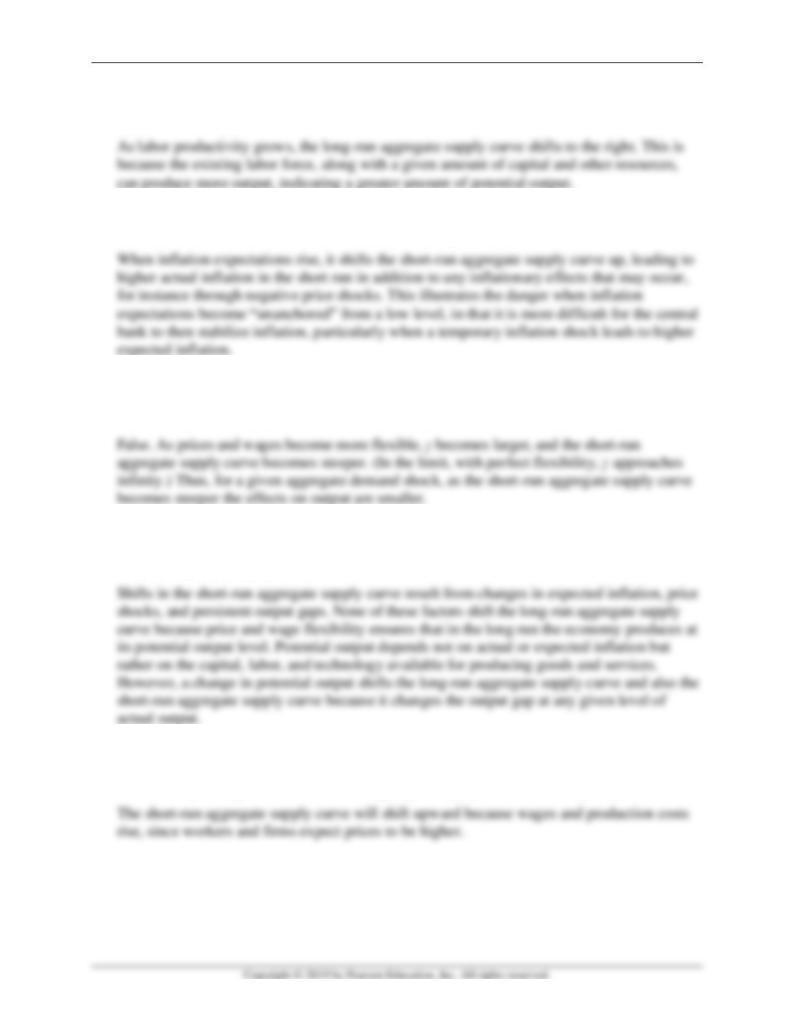
Mishkin • Instructor’s Manual for The Economics of Money, Banking, and Financial Markets, Twelfth Edition 242
5. If the labor force becomes more productive over time, how would the long-run aggregate
supply curve be affected?
6. Why are central banks so concerned with inflation expectations?
7. “If prices and wages are perfectly flexible, then γ = 0 and changes in aggregate demand have
a smaller effect on output.” Is this statement true, false, or uncertain? Explain your answer.
8. What factors shift the short-run aggregate supply curve? Do any of these factors shift the
long-run aggregate supply curve? Why?
9. If large budget deficits cause the public to think there will be higher inflation in the future,
what is likely to happen to the short-run aggregate supply curve when budget deficits rise?
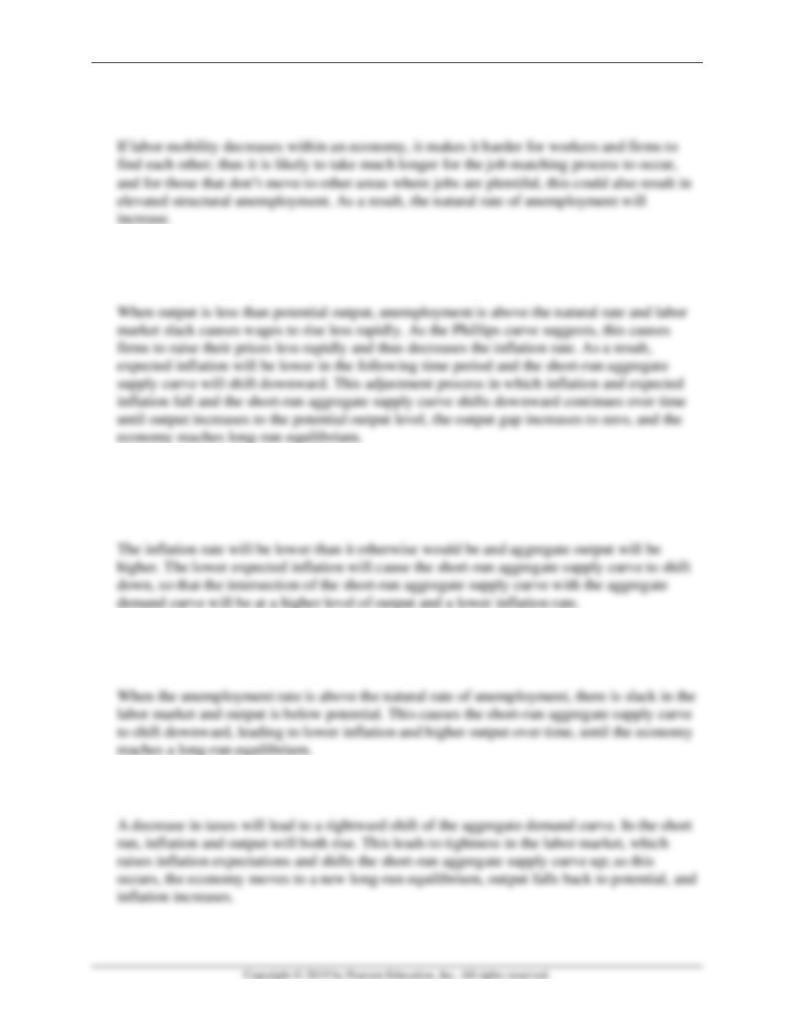
Mishkin • Instructor’s Manual for The Economics of Money, Banking, and Financial Markets, Twelfth Edition 243
10. In the aftermath of the financial crisis in the United States, labor mobility has decreased
significantly. How, if at all, might this affect the natural rate of unemployment?
11. When aggregate output is below the natural rate of output, what happens to the inflation rate
over time if the aggregate demand curve remains unchanged? Why?
12. Suppose the public believes that a newly announced anti-inflation program will work and so
lowers its expectations of future inflation. What will happen to aggregate output and the
inflation rate in the short run?
13. If the unemployment rate is above the natural rate of unemployment, holding other factors
constant, what will happen to inflation and output?
14. What happens to inflation and output in the short run and the long run when taxes decrease?

Mishkin • Instructor’s Manual for The Economics of Money, Banking, and Financial Markets, Twelfth Edition 244
15. What factors led to decreases in both the unemployment and inflation rates in the 1990s?
16. If stagflation is bad (high inflation and high unemployment), does this necessarily mean low
inflation and low unemployment is good?
17. Why did the Federal Reserve pursue inherently recessionary policies in the early 1980s?
18. In what ways is the Volcker disinflation considered a success? In what ways is it considered a
failure?
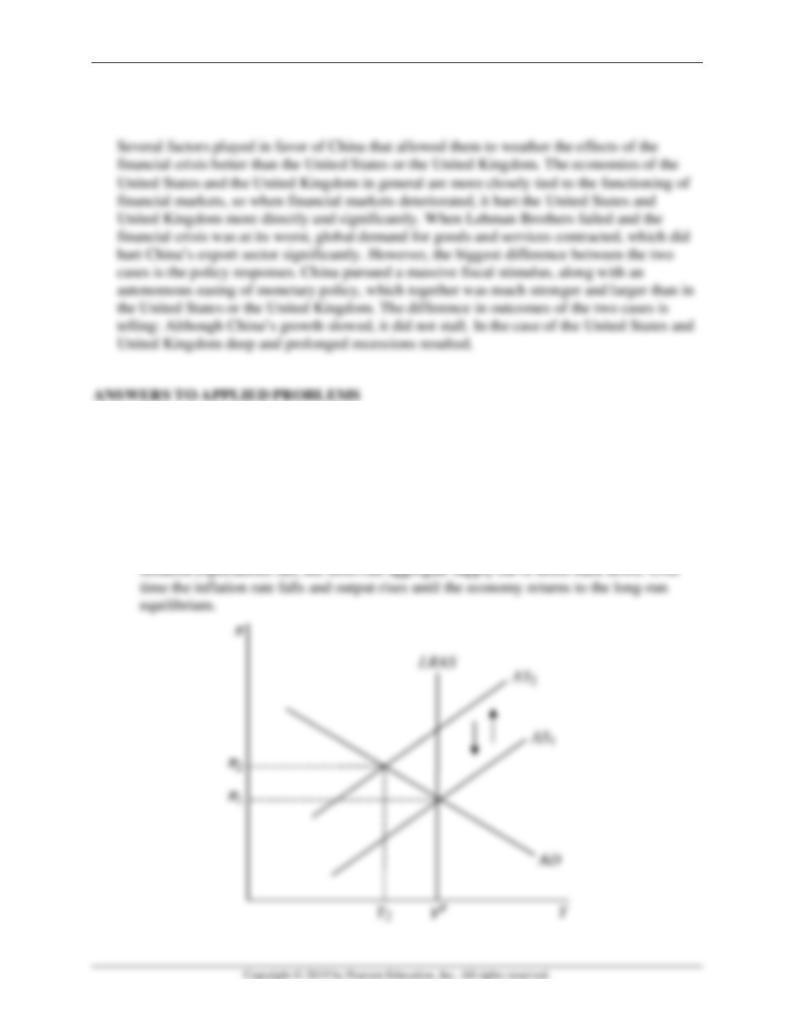
Mishkin • Instructor’s Manual for The Economics of Money, Banking, and Financial Markets, Twelfth Edition 245
19. Why did China fare much better than the United States and the United Kingdom during the
2007–2009 financial crisis?
20. Using an aggregate demand and supply graph, show and describe the effects in both the
short run and the long run of the following:
a. A temporary negative supply shock.
With a temporary negative supply shock, the short-run aggregate supply curve shifts up.
In the short run, output falls and inflation rises. This creates slack in the labor market,
which puts downward pressure on the inflation rate. As labor market slack continues and

Mishkin • Instructor’s Manual for The Economics of Money, Banking, and Financial Markets, Twelfth Edition 246
21. Suppose the President gets Congress to pass legislation that encourages investment in
research and the development of new technologies. Assuming this policy leads to a positive
productivity change for the U.S. economy, use aggregate demand and supply analysis to
predict the effects on inflation and output. Demonstrate these effects on a graph.

Mishkin • Instructor’s Manual for The Economics of Money, Banking, and Financial Markets, Twelfth Edition 247
22. Proposals advocating the implementation of a national sales tax have been presented before
Congress. Predict the effects of such a tax on the aggregate supply and demand curves,
showing the effects on output and inflation. Use a graph of aggregate supply and demand to
demonstrate these effects.
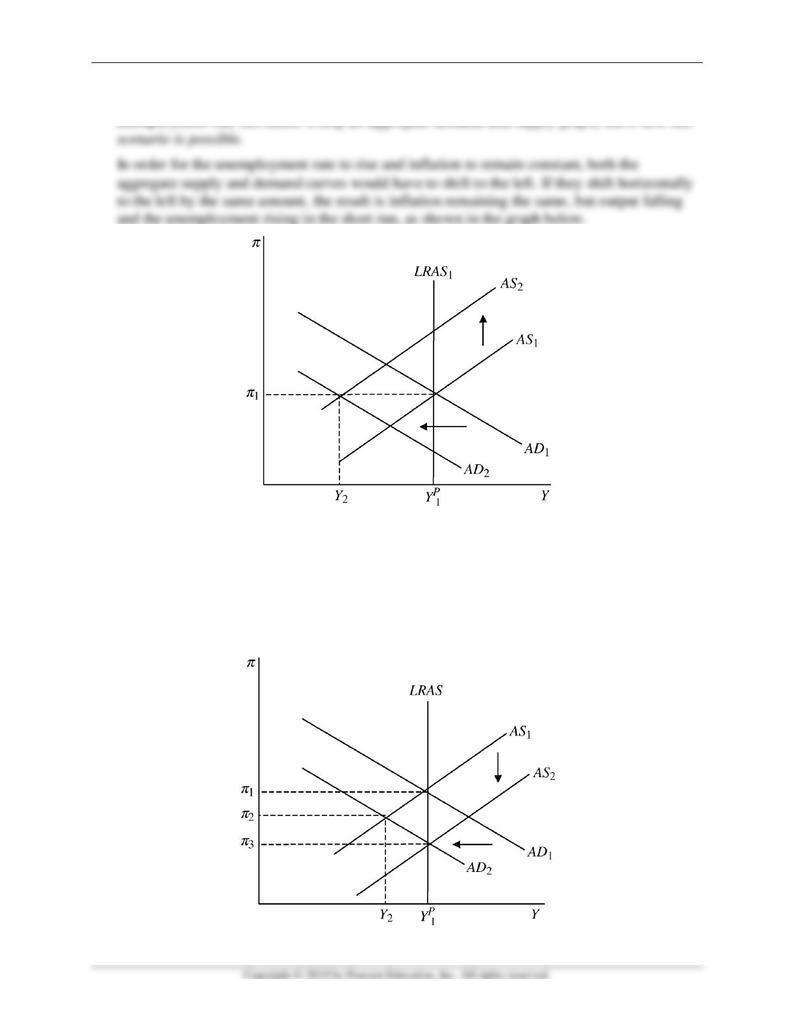
Mishkin • Instructor’s Manual for The Economics of Money, Banking, and Financial Markets, Twelfth Edition 248
23. Suppose the inflation rate remains relatively constant while output decreases and the
24. Classify each of the following as a supply shock or a demand shock. Use a graph to show the
effects on inflation and output in the short run and in the long run.
a. Financial frictions increase.
Negative demand shock. An increase in financial frictions reduces aggregate demand.
Output and inflation fall in the short run; in the long run, output rises back to potential,
and inflation falls.

Mishkin • Instructor’s Manual for The Economics of Money, Banking, and Financial Markets, Twelfth Edition 249
b. Households and firms become more optimistic about the economy.
Positive demand shock. This increases autonomous consumption and investment, which

Mishkin • Instructor’s Manual for The Economics of Money, Banking, and Financial Markets, Twelfth Edition 250
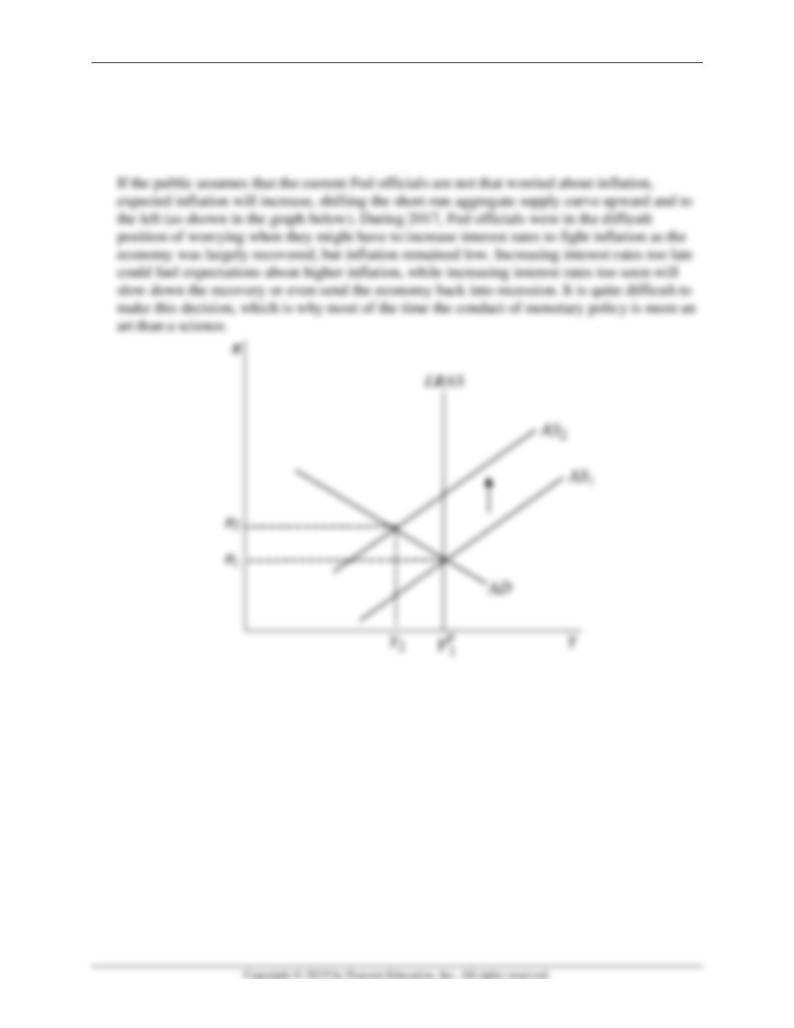
Mishkin • Instructor’s Manual for The Economics of Money, Banking, and Financial Markets, Twelfth Edition 251
25. During 2017, some Fed officials discussed the possibility of increasing interest rates as a
way of fighting potential increases in expected inflation. If the public came to expect higher
inflation rates in the future, what would be the effect on the short-run aggregate supply
curve? Use an aggregate demand and supply graph to illustrate your answer.
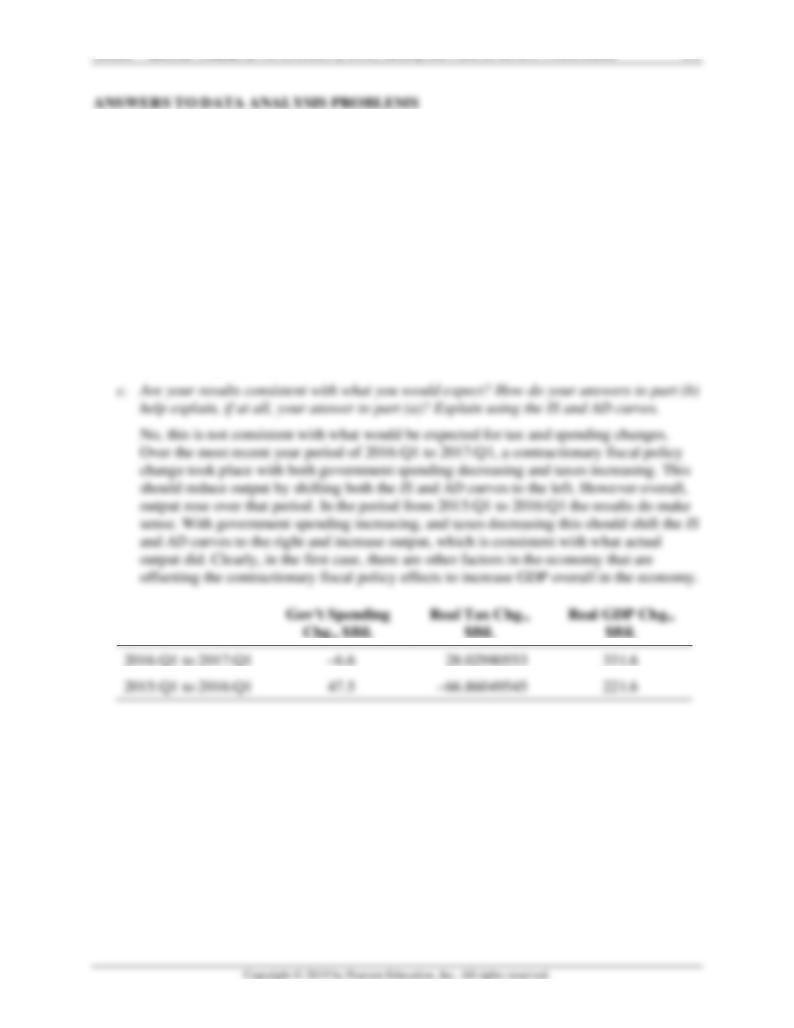
Mishkin • Instructor’s Manual for The Economics of Money, Banking, and Financial Markets, Twelfth Edition 252
1. Go to the St. Louis Federal Reserve FRED database and find data on real government
spending (GCEC1), real GDP (GDPC1), taxes (W006RC-1Q027SBEA), and the personal
consumption expenditure price index (PCECTPI), a measure of the price level. Download all
of the data into a spreadsheet, and convert the tax data series into real taxes. To do this, for
each quarter, divide taxes by the price index and then multiply by 100.
a. Calculate the level change in real GDP over the four most recent quarters of data
available, and the four quarters prior to that.
See summary table below.
b. Calculate the level change in real government spending and real taxes over the four most
recent quarters of data available, and the four quarters prior to that.
See summary table below.
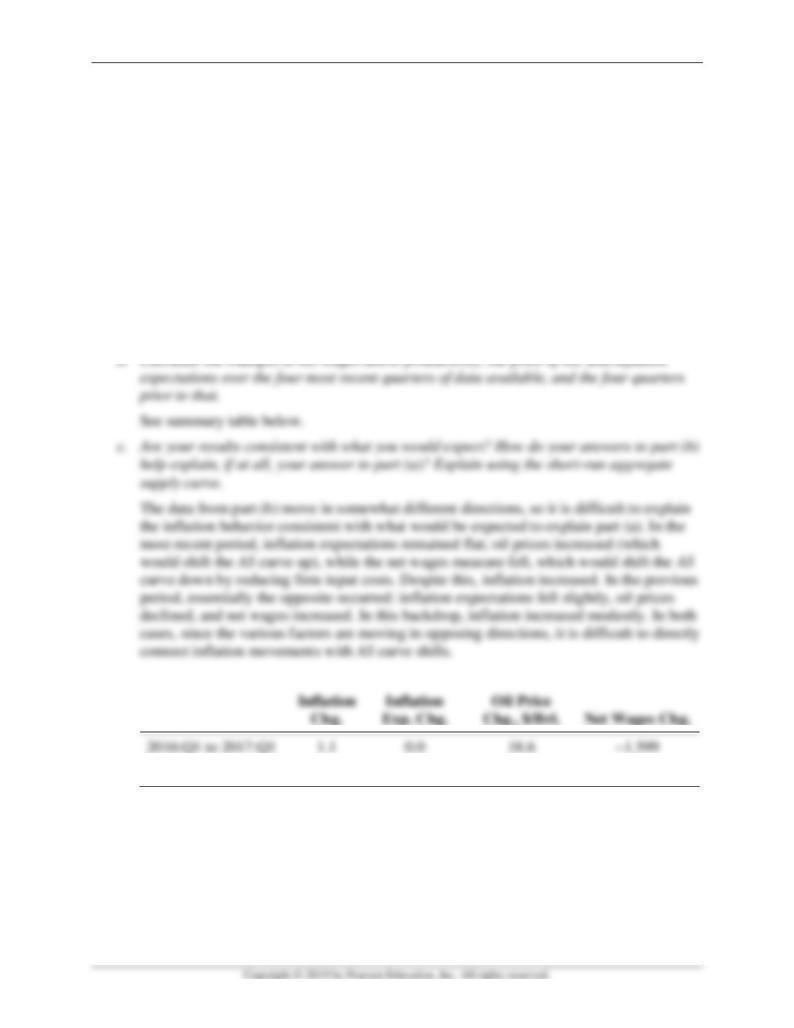
Mishkin • Instructor’s Manual for The Economics of Money, Banking, and Financial Markets, Twelfth Edition 253
2. Go to the St. Louis Federal Reserve FRED database and find data on the personal
consumption expenditure price index (PCECTPI), a measure of the price level; real
compensation per hour (COM-PRNFB); the nonfarm business sector real output per hour
(OPHNFB), a measure of worker productivity; the price of a barrel of oil (MCOILWTICO);
and the University of Michigan survey of inflation expectations (MICH). Use the frequency
setting to convert the oil price and inflation expectations data series to “Quarterly,” and use
the units setting to convert the price index to “Percent Change from Year Ago.” Download
all of the data into a spreadsheet, and convert the compensation and productivity measures
to a single indicator. To do this, for each quarter, take the compensation number and
subtract the productivity number. Call this difference “Net Wages Above Productivity.”
a. Calculate the change in the inflation rate over the four most recent quarters of data
available, and the four quarters prior to that.
See summary table below.
2015:Q1 to 2016:Q1
0.7
−0.2
−15.4
1.348
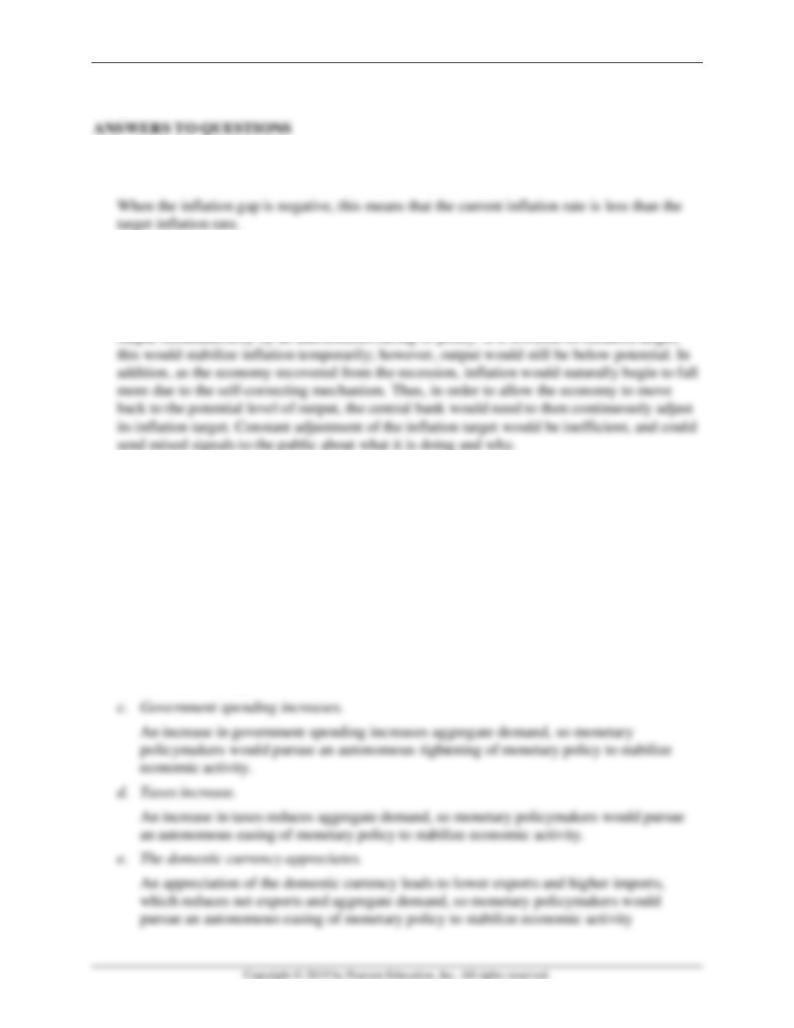
Mishkin • Instructor’s Manual for The Economics of Money, Banking, and Financial Markets, Twelfth Edition 254
Chapter 23
1. What does it mean when we say that the inflation gap is negative?
2. “If autonomous spending falls, the central bank should lower its inflation target in order to
stabilize inflation.” Is this statement true, false, or uncertain? Explain your answer.
False. If the central bank pursues stabilization policy, it can stabilize both inflation and
3. For each of the following shocks, describe how monetary policymakers would respond (if at
all) to stabilize economic activity. Assume the economy starts at a long-run equilibrium.
a. Consumers reduce autonomous consumption.
A reduction in autonomous consumption reduces aggregate demand, so monetary
policymakers would pursue an autonomous easing of monetary policy to stabilize
economic activity.
b. Financial frictions decrease.
A reduction in financial frictions increases aggregate demand, so monetary
policymakers would pursue an autonomous tightening of monetary policy to stabilize
economic activity
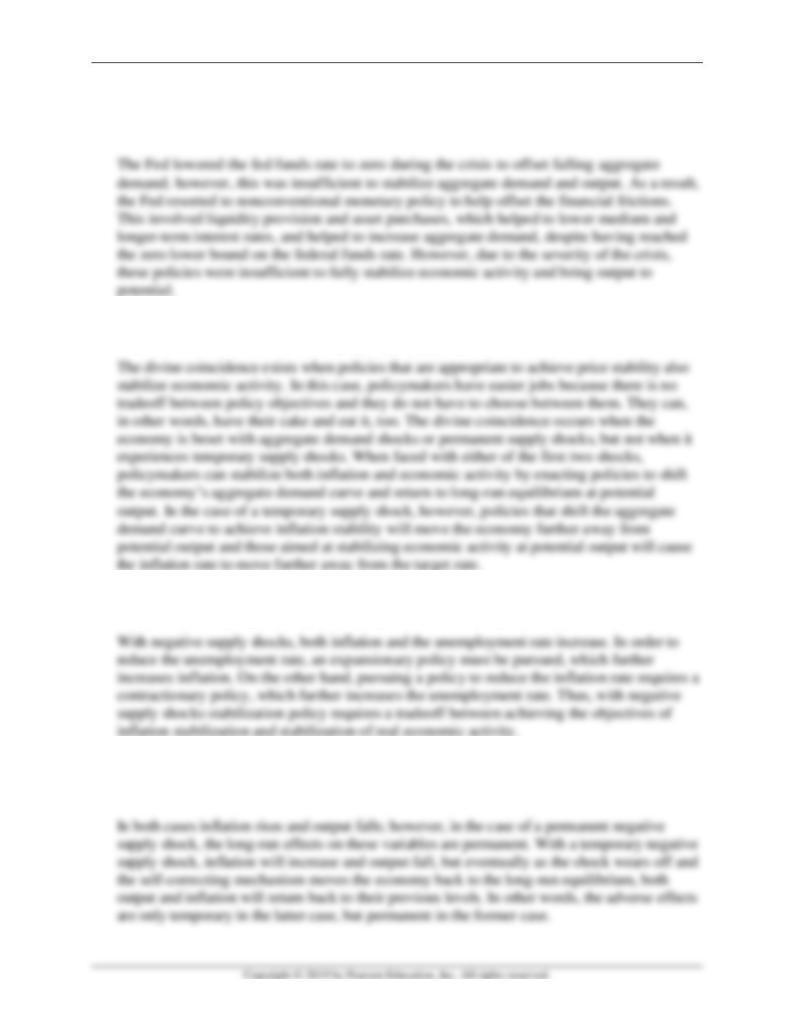
Mishkin • Instructor’s Manual for The Economics of Money, Banking, and Financial Markets, Twelfth Edition 255
4. During the global financial crisis, how was the Fed able to help offset the sharp increase in
financial frictions without the option of lowering interest rates further? Did the Fed’s plan
work?
5. Why does the divine coincidence simplify the job of policymakers?
6. Why do temporary negative supply shocks pose a dilemma for policymakers?
7. In what way is a permanent negative supply shock worse than a temporary negative supply
shock?
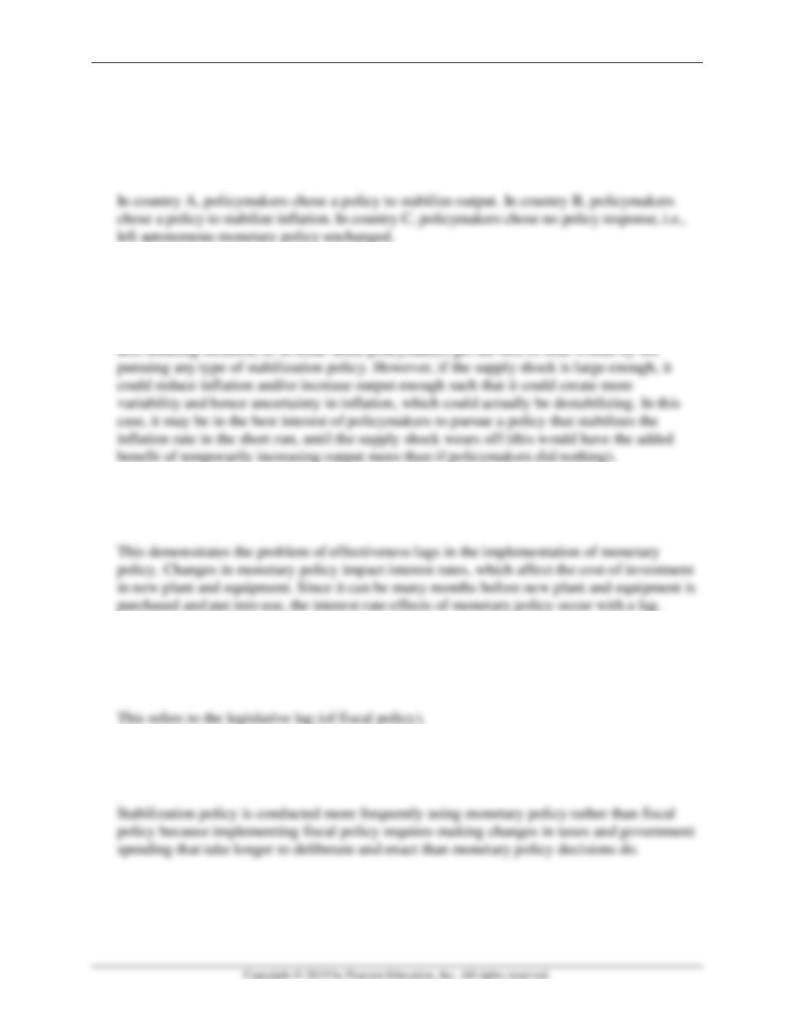
Mishkin • Instructor’s Manual for The Economics of Money, Banking, and Financial Markets, Twelfth Edition 256
8. Suppose three economies are hit with the same temporary negative supply shock. In country
A, inflation initially rises and output falls; then inflation rises more and output increases. In
country B, inflation initially rises and output falls; then both inflation and output fall. In
country C, inflation initially rises and output falls; then inflation falls and output eventually
increases. What type of stabilization approach did each country take?
9. “Policymakers would never respond by stabilizing output in response to a temporary positive
supply shock.” Is this statement true, false, or uncertain? Explain your answer.
Uncertain. A temporary positive supply shock has the dual benefits of increasing output and
10. The fact that it takes a long time for firms to get new plants and equipment up and running is
an illustration of what policy problem?
11. In the United States, many observers have commented in recent years on the “political
gridlock in Washington D.C.” and referred to Congress as a ‘Do Nothing Congress”. What
type of policy lag is this describing?
12. Is stabilization policy more likely to be conducted through monetary policy or through fiscal
policy? Why?

Mishkin • Instructor’s Manual for The Economics of Money, Banking, and Financial Markets, Twelfth Edition 257
13. “If the data and recognition lags could be reduced, activist policy probably would be more
beneficial to the economy.” Is this statement true, false, or uncertain? Explain your answer.
14. If the economy’s self-correcting mechanism works slowly, should the government necessarily
pursue discretionary policy to eliminate unemployment? Why or why not?
15. In the early 1970s, an unexpected productivity slowdown lead most economists to believe
that potential output was larger than it actually was. How are policymakers likely to respond
under this situation, and what do you expect to be the outcome?
16. In both the 1960s and the 1970s in the United States, inflation increased significantly.
However, unemployment behaved very differently in the two decades. Why is this?
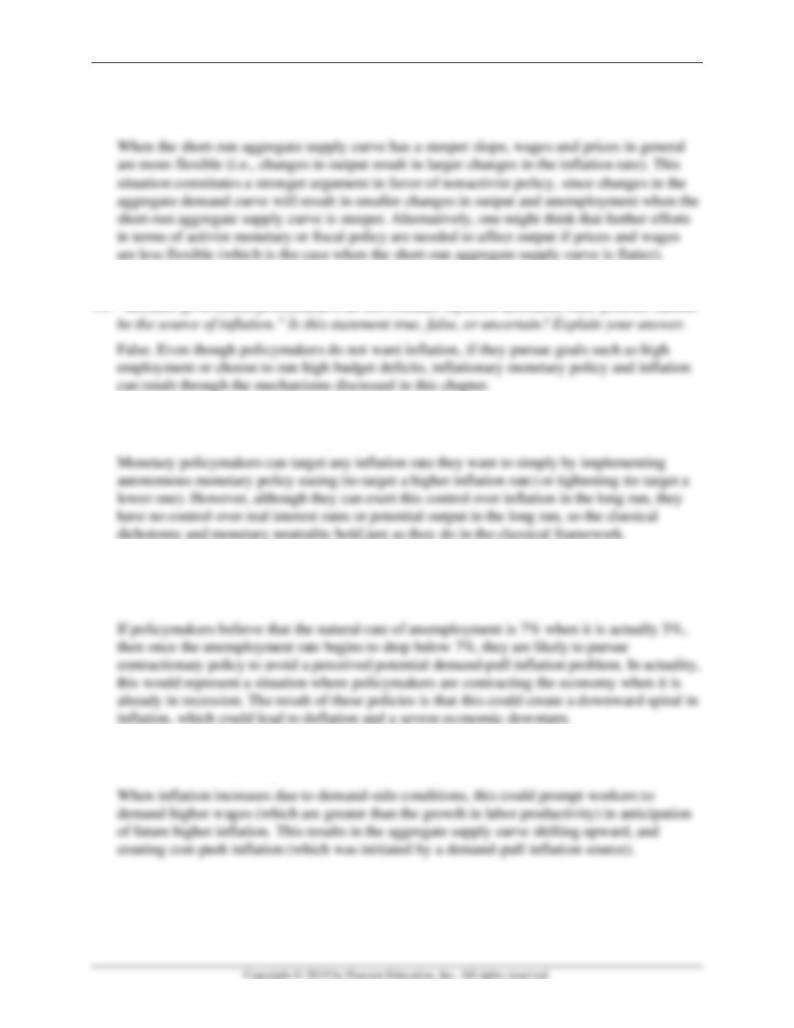
Mishkin • Instructor’s Manual for The Economics of Money, Banking, and Financial Markets, Twelfth Edition 258
17. Given a relatively steep and a relatively flat short-run aggregate supply curve, which curve
would support the case for nonactivist policy? Why?
19. How can monetary authorities target any inflation rate they wish?
20. What will happen if policymakers erroneously believe that the natural rate of unemployment
is 7% when it is actually 5% and therefore pursue stabilization policy?
21. How can demand-pull inflation lead to cost-push inflation?
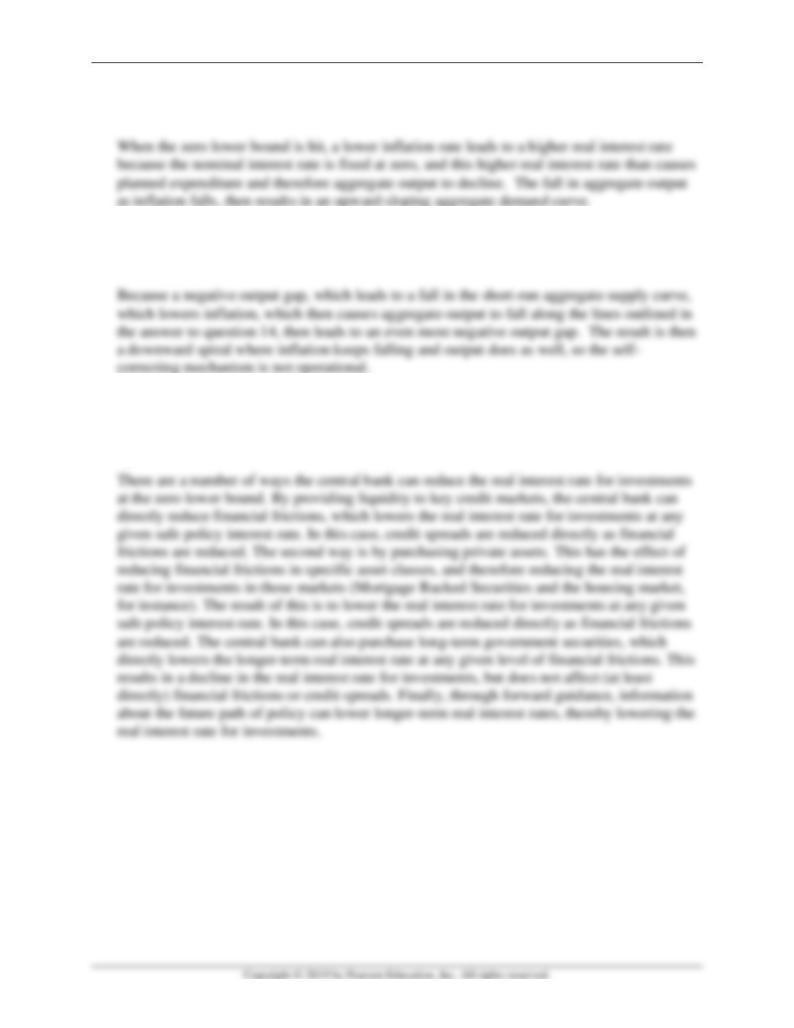
Mishkin • Instructor’s Manual for The Economics of Money, Banking, and Financial Markets, Twelfth Edition 259
22. How does the policy rate hitting a floor of zero lead to an upward-sloping aggregate demand
curve?
23. Why does the self-correcting mechanism stop working when the policy rate hits the zero
lower bound?
24. In what ways can nonconventional monetary policy affect the real interest rate for
investments when the economy reaches the zero lower bound? How are credit spreads
affected?
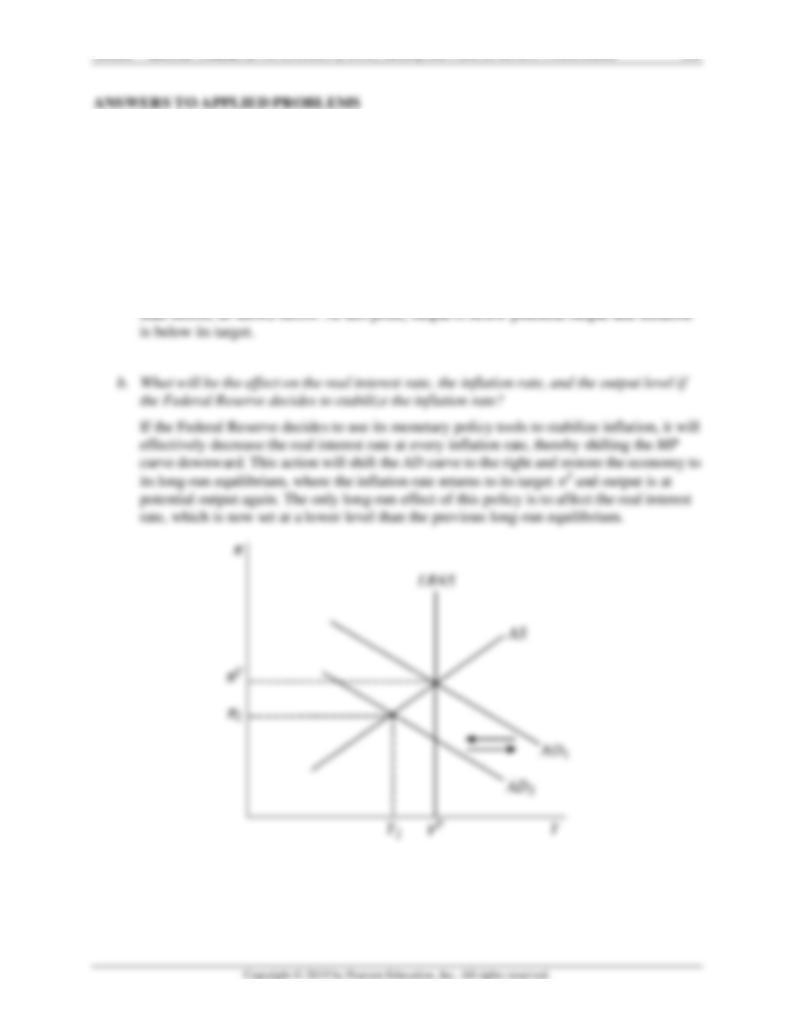
Mishkin • Instructor’s Manual for The Economics of Money, Banking, and Financial Markets, Twelfth Edition 260
25. Suppose the current administration decides to decrease government expenditures as a means
of cutting the existing government budget deficit.
a. Using a graph of aggregate demand and supply, show the effects of such a decision on
the economy in the short run. Describe the effects on inflation and output.
According to aggregate demand and supply analysis, the decrease in government
expenditures results in a shift to the left in the aggregate demand curve, as aggregate
expenditures decrease at every inflation rate. As a result, the new intersection point with
the short-run aggregate supply curve determines a lower inflation rate and output level
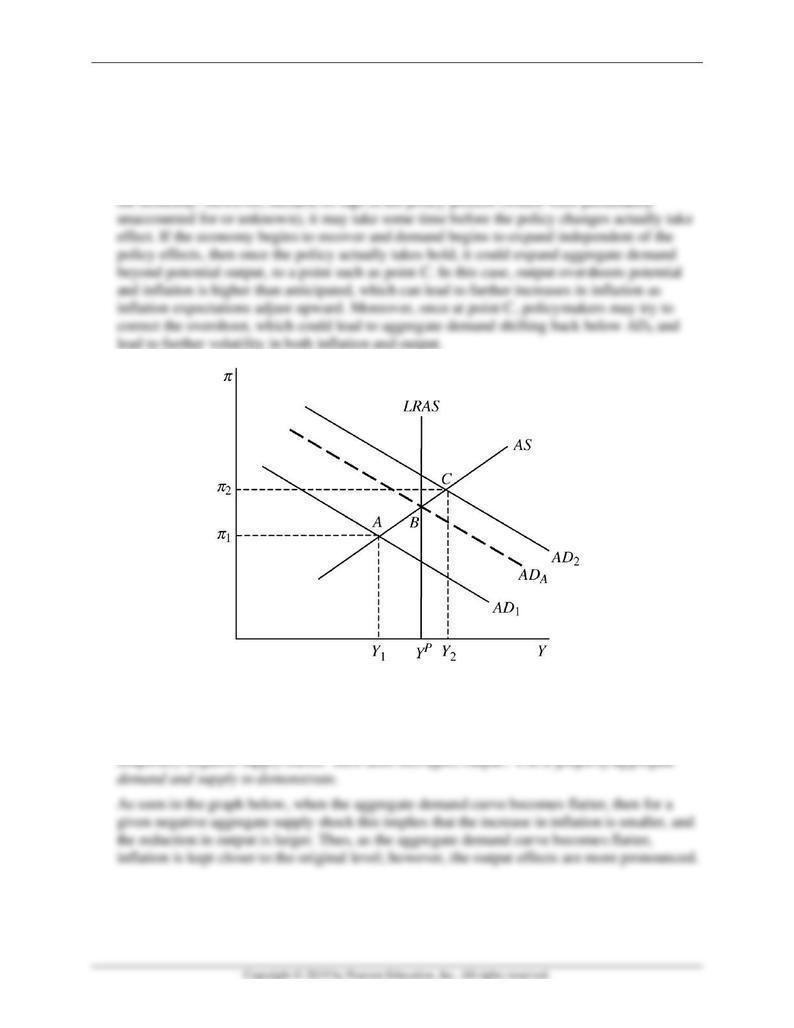
Mishkin • Instructor’s Manual for The Economics of Money, Banking, and Financial Markets, Twelfth Edition 261
26. Use a graph of aggregate demand and supply to demonstrate how lags in the policy process can
result in undesirable fluctuations in output and inflation.
Suppose the economy is currently in recession at point A in the graph, and policymakers wish to
stabilize output. Given current assumptions about the state of the economy, policymakers
may devise a policy that they anticipate will shift aggregate demand out to ADA and stabilize
27. As monetary policymakers become more concerned with inflation stabilization, the slope of
the aggregate demand curve becomes flatter. How does the resulting change in the slope of
the aggregate demand curve help stabilize inflation when the economy is hit with a
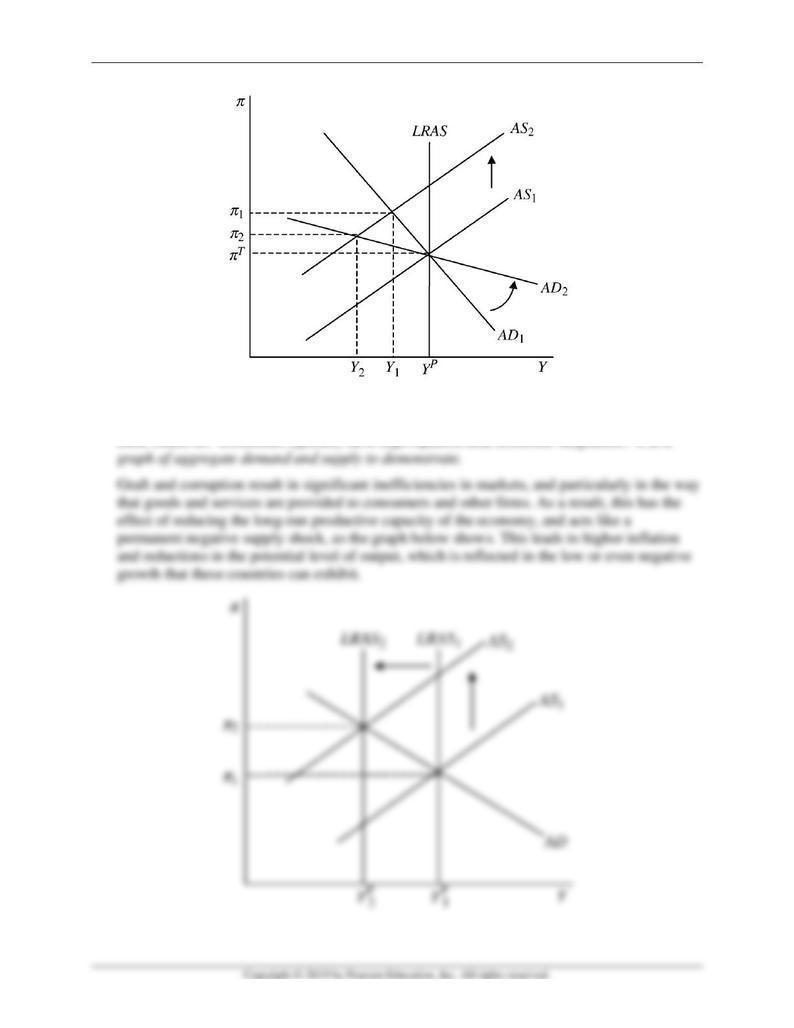
Mishkin • Instructor’s Manual for The Economics of Money, Banking, and Financial Markets, Twelfth Edition 262
28. Many developing countries suffer from endemic corruption. How does this help explain why
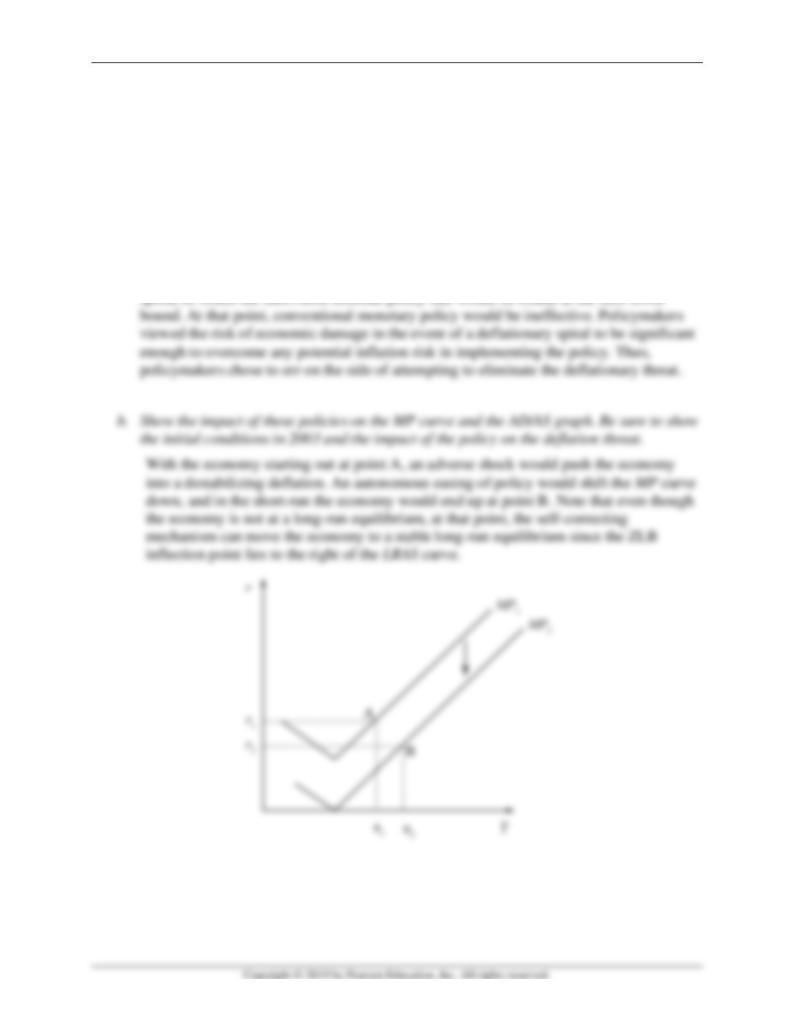
Mishkin • Instructor’s Manual for The Economics of Money, Banking, and Financial Markets, Twelfth Edition 263
29. In 2003, as the U.S. economy finally seemed poised to exit its ongoing recession, the Fed
began to worry about a “soft patch” in the economy, in particular the possibility of a
deflation. As a result, the Fed proactively lowered the federal funds rate from 1.75% in late
2002 to 1% by mid-2003, the lowest federal funds rate on record up to that point in time. In
addition, the Fed committed to keeping the federal funds rate at this level for a considerable
period of time. This policy was considered highly expansionary and was seen by some as
potentially inflationary and unnecessary.
a. How might fears of a zero lower bound justify such a policy, even if the economy was not
actually in a recession?
Policymakers were worried that a shock could push the economy into a deflationary
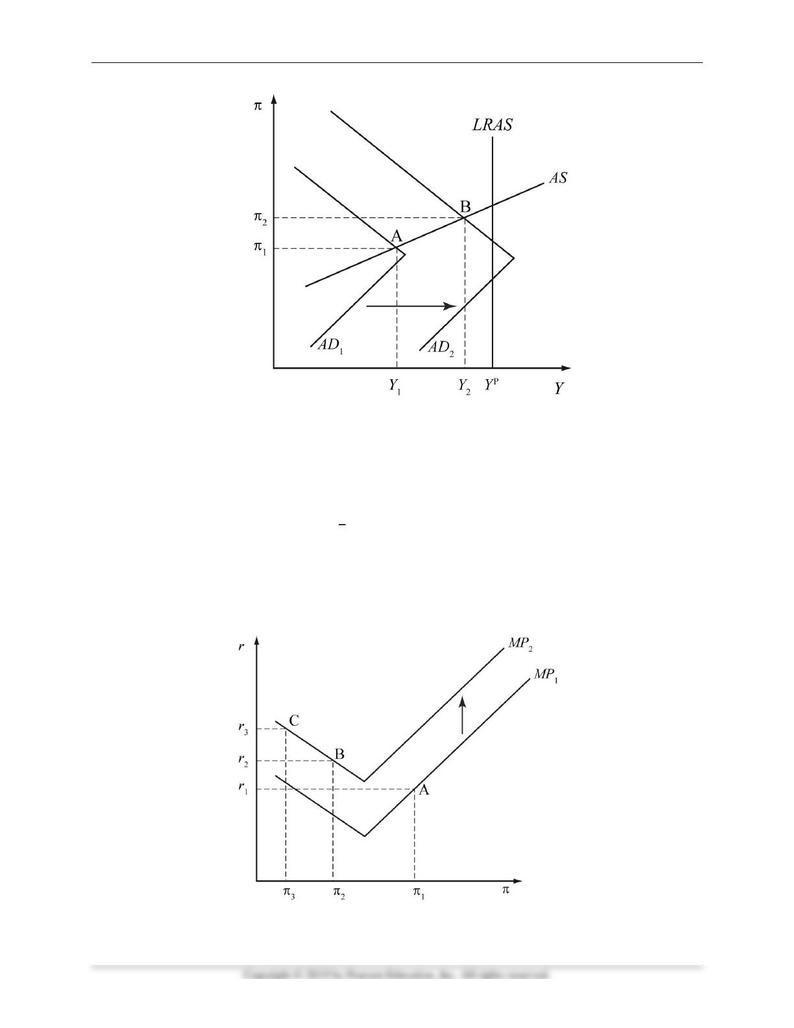
Mishkin • Instructor’s Manual for The Economics of Money, Banking, and Financial Markets, Twelfth Edition 264
30. Suppose that f is determined by two factors: financial panic and asset purchases.
a. Using an MP curve and an AS/AD graph, show how a sufficiently large financial panic
can pull the economy below the zero lower bound and into a destabilizing deflationary
spiral.
A financial panic will increase
f
, thus raising the real interest rate on investments at any
given inflation rate. A sufficiently large panic will push the economy to point B, where
the self-correcting mechanism will lower inflation, and real rates will rise since the
economy is beyond the ZLB. This results in a deflationary spiral in which the economy
will move toward (and past) a point such as point C.


Mishkin • Instructor’s Manual for The Economics of Money, Banking, and Financial Markets, Twelfth Edition 266
1. On January 19, 2017, the Federal Reserve released its amended statement on longer-run
goals and monetary policy strategy. It stated: “The Committee reaffirms its judgment that
inflation at the rate of 2%, as measured by the annual change in the price index for personal
consumption expenditures, is most consistent over the longer run with the Federal Reserve’s
statutory mandate.” and that “the median of FOMC participants’ estimates of the longer-run
normal rate of unemployment was 4.8%.” Assume this statement implies that the natural rate
of unemployment is believed to be 4.8%. Go to the St. Louis Federal Reserve FRED
database, and find data on the personal consumption expenditure price index (PCECTPI),
the unemployment rate (UNRATE), real GDP (GDPC1), and real potential gross domestic
product (GDPPOT), an estimate of potential GDP. For the price index, adjust the units
setting to “Percent Change From Year Ago.” For the unemployment rate, adjust the
frequency setting to ‘Quarterly’. Download the data into a spreadsheet.
a. For the most recent four quarters of data available, calculate the average inflation gap
using the 2% target referenced by the Fed. Calculate this value as the average of the
inflation gaps over the four quarters.

Mishkin • Instructor’s Manual for The Economics of Money, Banking, and Financial Markets, Twelfth Edition 267
2. Go to the St. Louis Federal Reserve FRED database and find data on the personal
consumption expenditure price index (PCECTPI), the unemployment rate (UNRATE), and an
estimate of the natural rate of unemployment (NROU). For the price index, adjust the units
setting to “Percent Change From Year Ago.” For the unemployment rate, adjust the
frequency setting to ‘Quarterly’. Select the data from 2000 through the most current data
available, download the data, and plot all three variables on the same graph. Using your
graph, identify periods of demand-pull or cost-push movements in the inflation rate. Briefly
explain your reasoning.
See graph below. The period from around early 2001 to around the end of 2003 appears to be
influenced by demand-pull inflation conditions, since inflation is a bit lower than what
appears to be normal at the time (2.5%), and the unemployment rate rises and remains above
the estimated natural rate during this time. For a brief time from the middle of 2007 to the
middle of 2008, the economy appears to be hit by a cost-push inflation episode, since the
inflation rate spikes, and the unemployment rate rises above the natural rate of
unemployment. From the middle of 2008 to about early 2014, inflation remains mostly at or
below the 2% target, while the unemployment rate is well above the natural rate, suggesting
that demand-pull forces are at work. Beyond 2014, inflation remains low and unemployment
continues to decline, suggesting some cost-push effects are driving unemployment lower and
keeping inflation low.
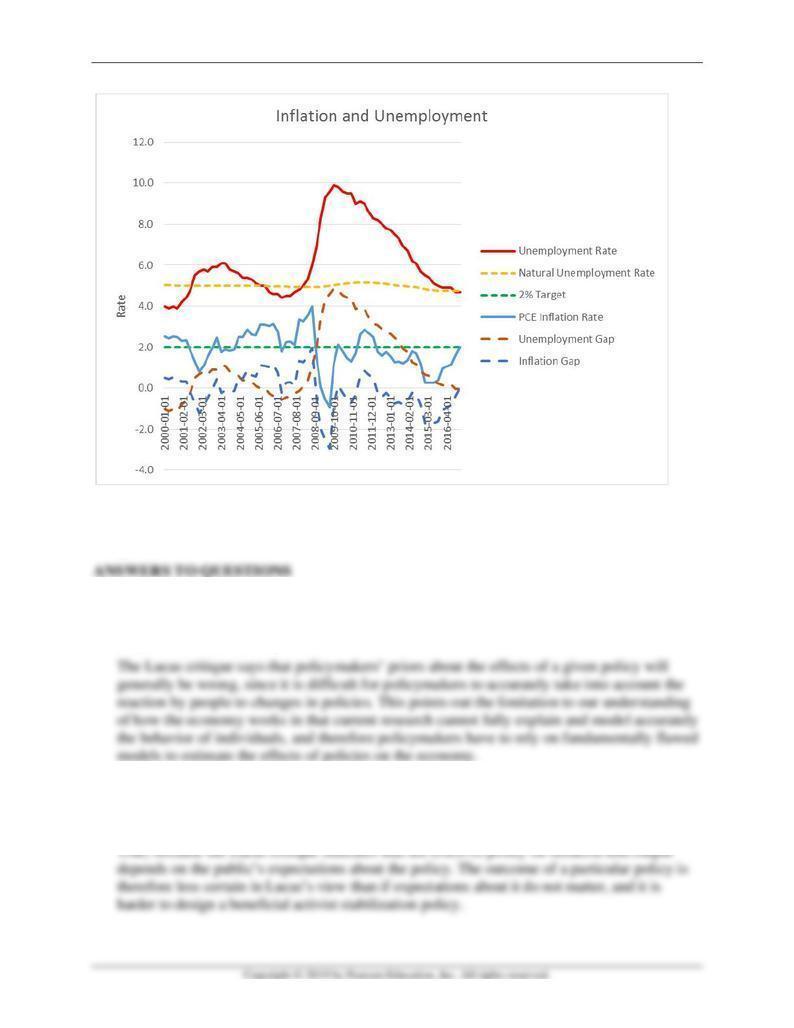
Mishkin • Instructor’s Manual for The Economics of Money, Banking, and Financial Markets, Twelfth Edition 268
Chapter 24
1. What does the Lucas critique state about the limitations of our current understanding of the
way in which the economy works?
2. “The Lucas critique by itself casts doubt on the ability of discretionary stabilization policy to
be beneficial.” Is this statement true, false, or uncertain? Explain your answer.

Mishkin • Instructor’s Manual for The Economics of Money, Banking, and Financial Markets, Twelfth Edition 269
3. Suppose an econometric model based on past data predicts a small decrease in domestic
investment when the Federal Reserve increases the federal funds rate. Assume the Federal
Reserve is considering an increase in the federal funds rate target to fight inflation and
promote a low inflation environment that will encourage investment and economic growth.
a. Discuss the implications of the econometric model’s predictions if individuals interpret
the increase in the federal funds rate target as a sign that the Fed will keep inflation at
low levels in the long run.
According to the rational expectation theory, individuals might interpret this increase in the
federal funds rate target as a signal that the Fed will commit to fight inflation. The increase
in the federal funds rate determines an increase in real interest rates in the short run and
results in a higher user cost of capital. Although this might reduce investment, it is possible
that individuals recognize the Fed’s intentions and therefore decide to increase investment
in anticipation of a low inflation economic environment that encourages investment.
b. What would be Lucas’s critique of this model?
4. If the public expects the Fed to pursue a policy that is likely to raise short-term interest rates
permanently to 5%, but the Fed does not go through with this policy change, what will
happen to long-term interest rates? Explain your answer.
5. In what sense can greater central bank independence make the time-inconsistency problem
worse?
When central banks are more independent, there is less formal accountability by them to
pursue stable inflation policies. In this sense, it is easier for central banks to give the
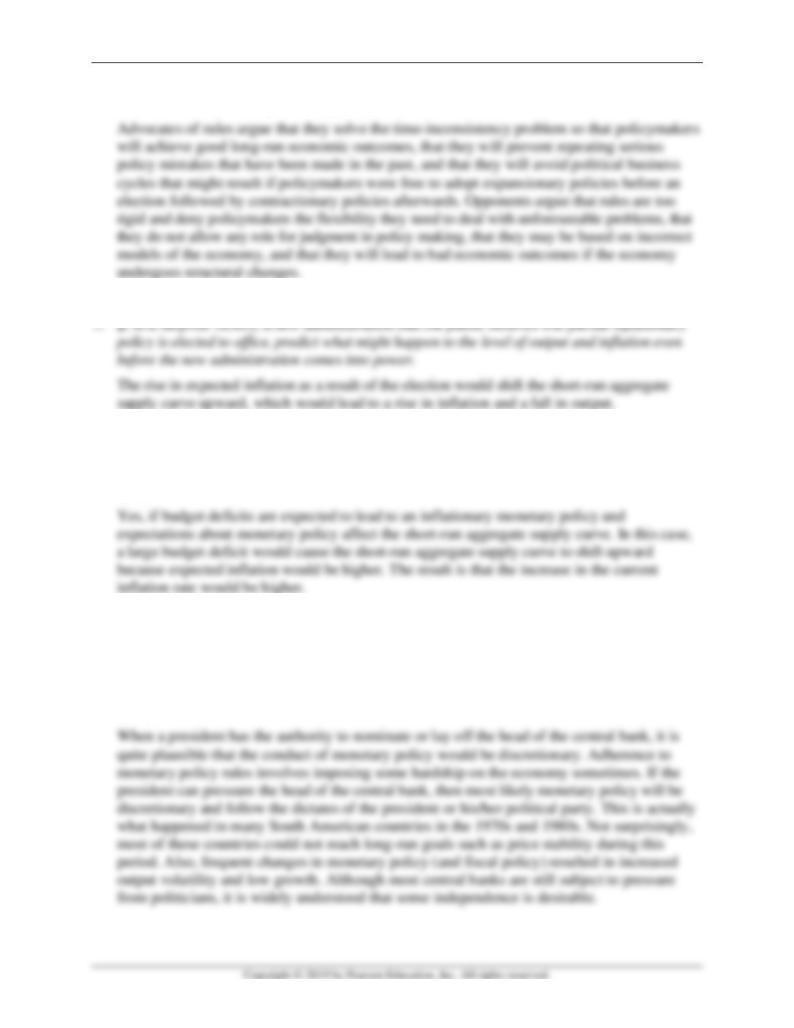
Mishkin • Instructor’s Manual for The Economics of Money, Banking, and Financial Markets, Twelfth Edition 270
6. What are the arguments for and against policy rules?
8. Many economists are worried that a high level of budget deficits may lead to inflationary
monetary policies in the future. Could these budget deficits have an effect on the current rate
of inflation?
9. In some countries, the president chooses the head of the central bank. The same president
can fire the head of the central bank and replace him or her with another director at any
time. Explain the implications of such a situation for the conduct of monetary policy. Do you
think the central bank will follow a monetary policy rule, or will it engage in discretionary
policy?
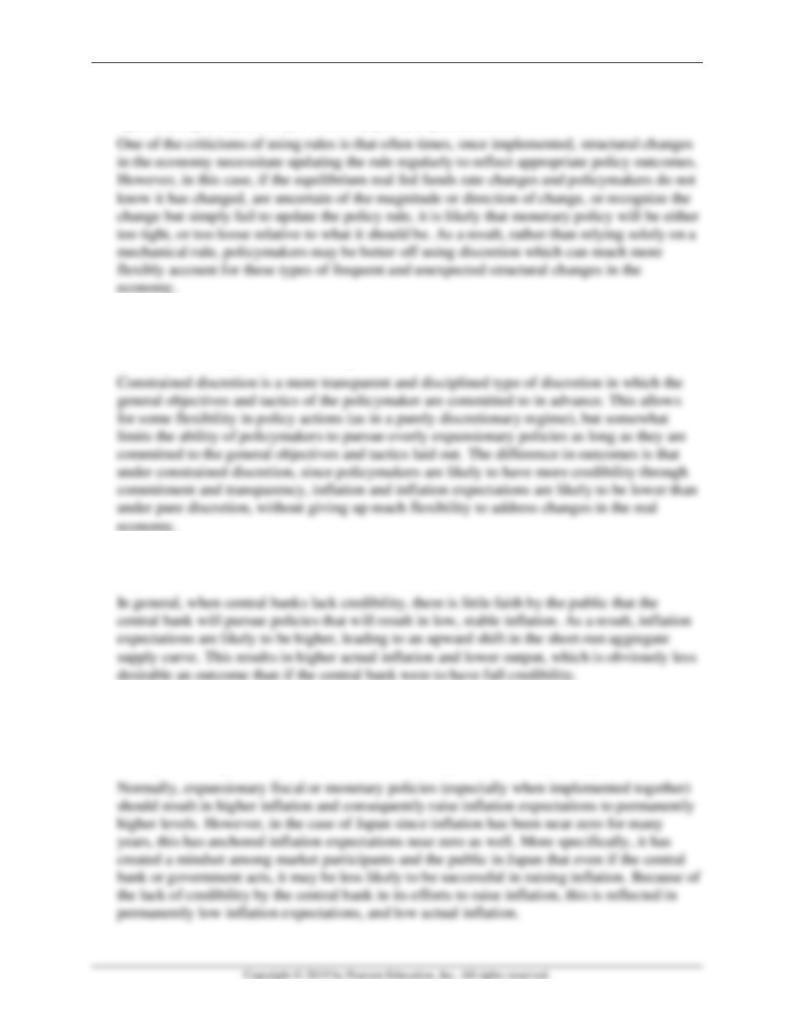
Mishkin • Instructor’s Manual for The Economics of Money, Banking, and Financial Markets, Twelfth Edition 271
10. How would an unexpected change in the equilibrium real fed funds rate be an argument
against using a Taylor rule for monetary policy implementation?
11. How is constrained discretion different from discretion in monetary policy? How are the
outcomes of these policies likely to differ?
12. In general, how does credibility (or lack thereof) affect the aggregate supply curve?
13. In Japan, the government and central bank have enacted policies recently to raise inflation
permanently from persistently low levels, however inflation continues to remain near zero.
How, if at all, might credibility of the central bank explain the low inflation persistence?
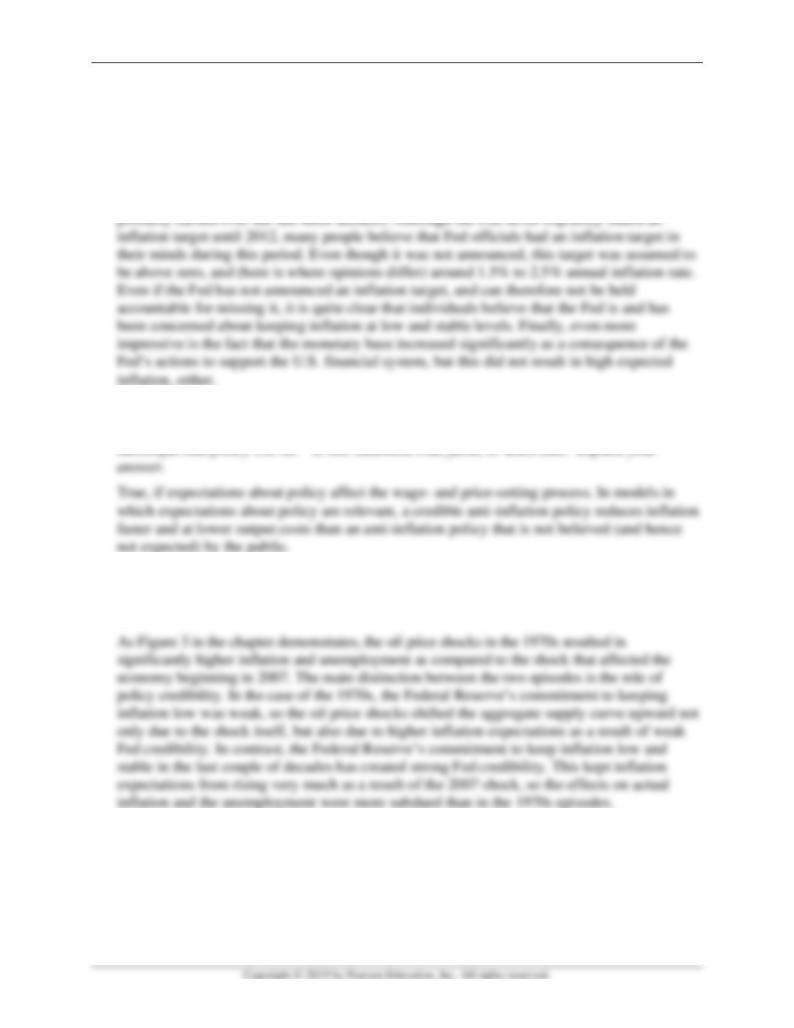
Mishkin • Instructor’s Manual for The Economics of Money, Banking, and Financial Markets, Twelfth Edition 272
14. As part of its response to the global financial crisis, the Fed lowered the federal funds rate
target to nearly zero by December 2008 and quadrupled the monetary base between 2008
and 2017, a considerable easing of monetary policy. However, survey-based measures of
five- to ten-year inflation expectations remained low throughout most of this period.
Comment on the Fed’s credibility in fighting inflation.
This is a clear sign that the Fed enjoys a high level of credibility. This credibility was
15. “The more credible the policymakers who pursue an anti-inflation policy, the more
16. Why did the oil price shocks of the 1970s affect the economy differently than the oil price shocks
of 2007?
17. Central banks that engage in inflation targeting usually announce the inflation target and
time period for which that target will be relevant. In addition, central bank officials are held
accountable for their actions (e.g., they could be fired if the target is not reached), and their
success or lack thereof is also public information. Explain why transparency is such a
fundamental ingredient of inflation targeting.

Mishkin • Instructor’s Manual for The Economics of Money, Banking, and Financial Markets, Twelfth Edition 273
Announcements about the inflation targets and potential punishments for central bank
18. In recent years, central banks have dramatically increased the amount of communication
with market participants and the public, and at the same time in many of these countries,
average inflation has declined and become less volatile. Is this coincidence, or is there a
connection? Explain.
19. What are the purposes of inflation targeting, and how does this monetary policy strategy
achieve them?
20. How can the establishment of an exchange-rate target bring credibility to a country with a
poor record of inflation stabilization?
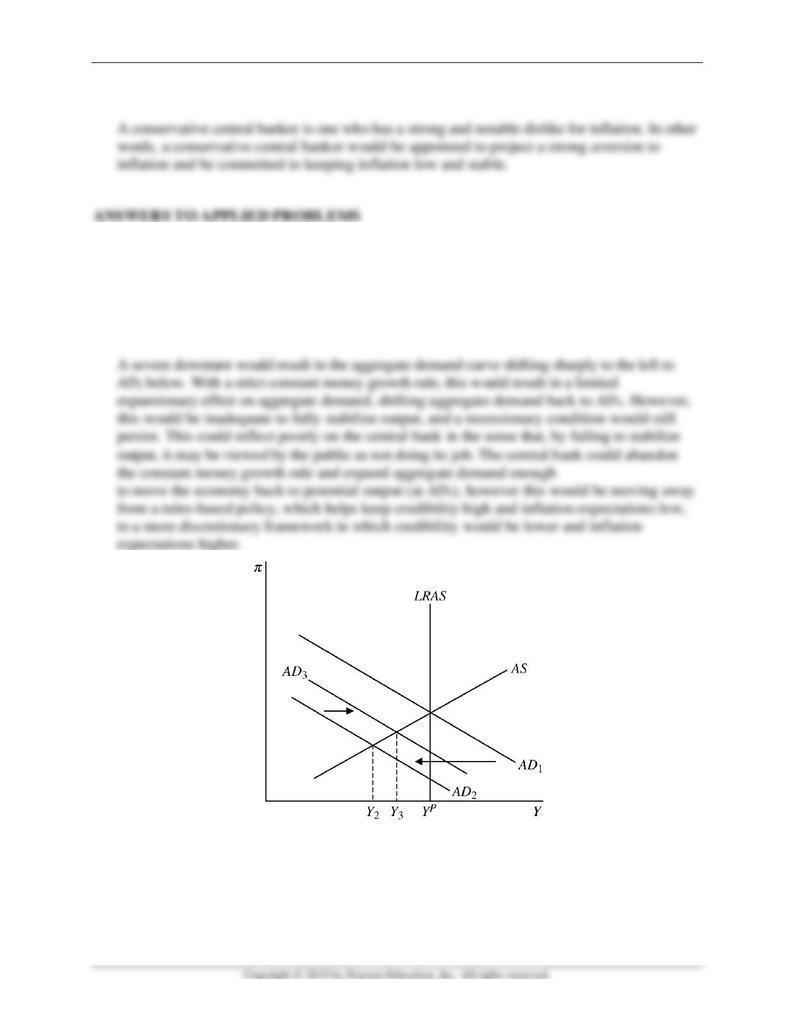
Mishkin • Instructor’s Manual for The Economics of Money, Banking, and Financial Markets, Twelfth Edition 274
21. What traits characterize a “conservative” central banker?
22. Suppose the central bank is following a constant-money-growth-rate rule and the economy is hit
with a severe economic downturn. Use an aggregate supply and demand graph to show the
possible effects on the economy. How does this situation reflect on the credibility of the central
bank if it maintains the money growth rule? How does it reflect on the central bank’s credibility
if it abandons the money growth rule to respond to the downturn?
23. Suppose country A has a central bank with full credibility, and country B has a central bank
with no credibility. How does the credibility of each country’s central bank affect the speed
of adjustment of the aggregate supply curve to policy announcements? How does this result
affect output stability? Use an aggregate supply and demand diagram to demonstrate.
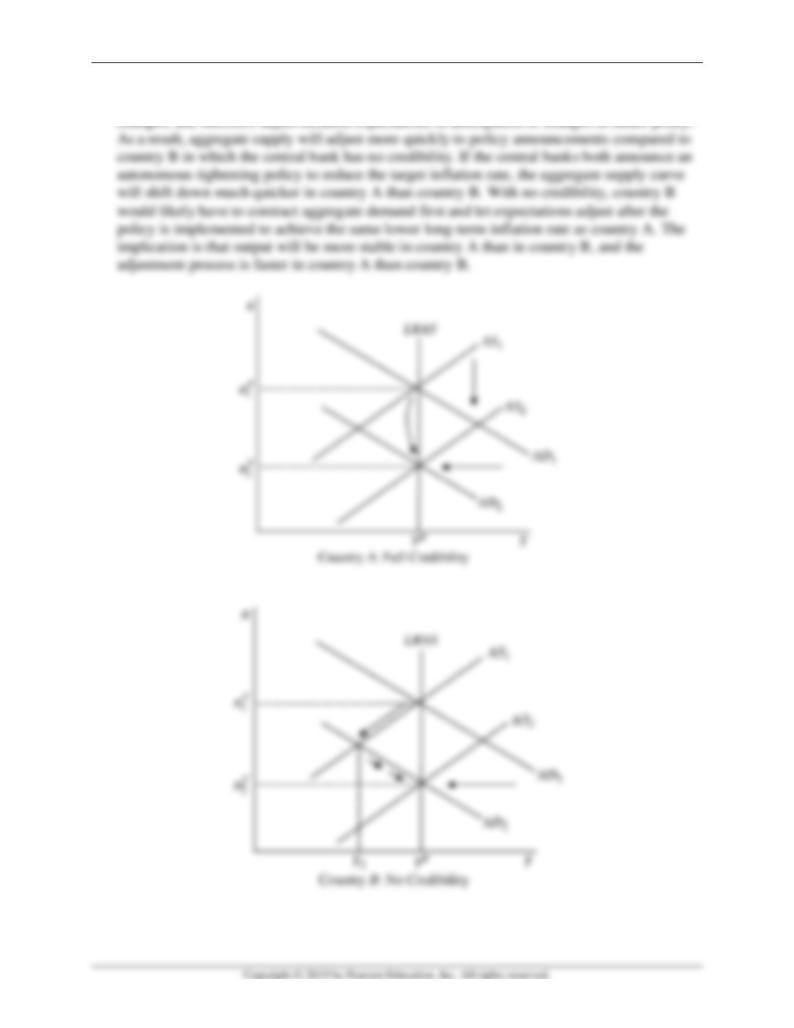
Mishkin • Instructor’s Manual for The Economics of Money, Banking, and Financial Markets, Twelfth Edition 275
In country A, the public is more likely to believe announcements about future policy
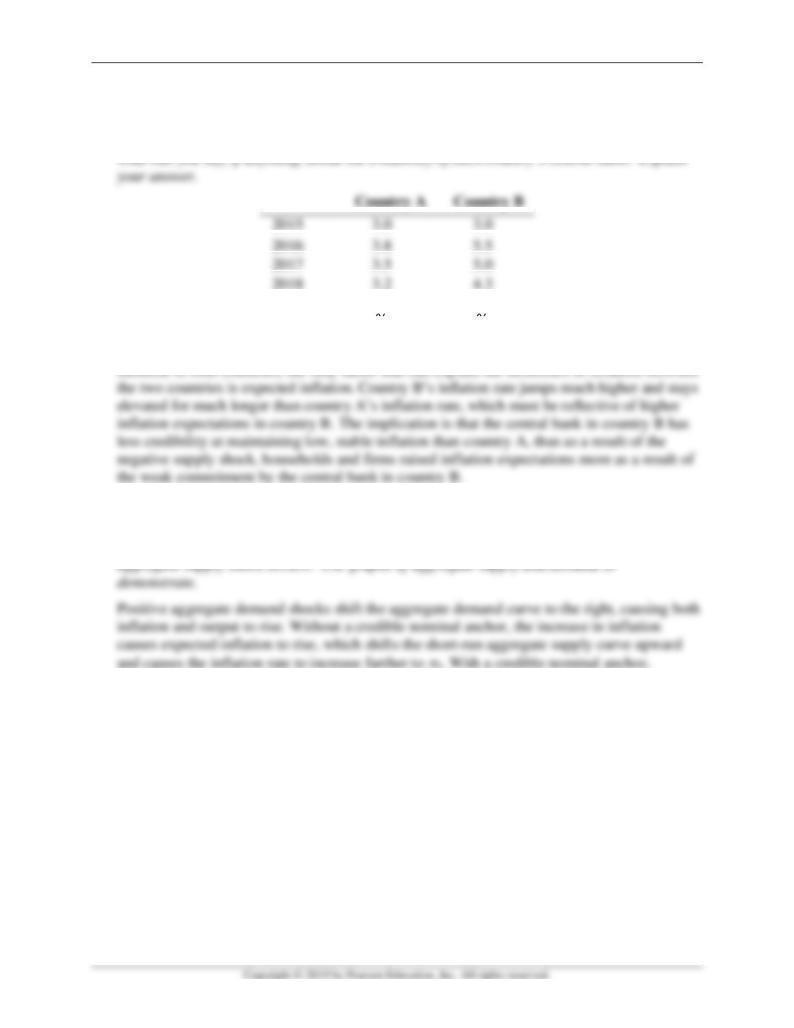
Mishkin • Instructor’s Manual for The Economics of Money, Banking, and Financial Markets, Twelfth Edition 276
24. Suppose two countries have identical aggregate demand curves and potential levels of
output, and
is the same in both countries. Assume that in 2016, both countries are hit with
the same negative supply shock. Given the table of values below for inflation in each country,
%
%
2019
3.0
%
3.8
%
Since the aggregate demand curve, potential output, the parameter
, and the price shock are
25. How does a credible nominal anchor help improve the economic outcomes that result from a
positive aggregate demand shock? How does a credible nominal anchor help if a negative
3. With a credible nominal anchor,
however, expected inflation does not change, so there is no upward shift in the short-run
aggregate supply curve. Thus, with a credible nominal anchor, inflation is more stable
following the demand shock.
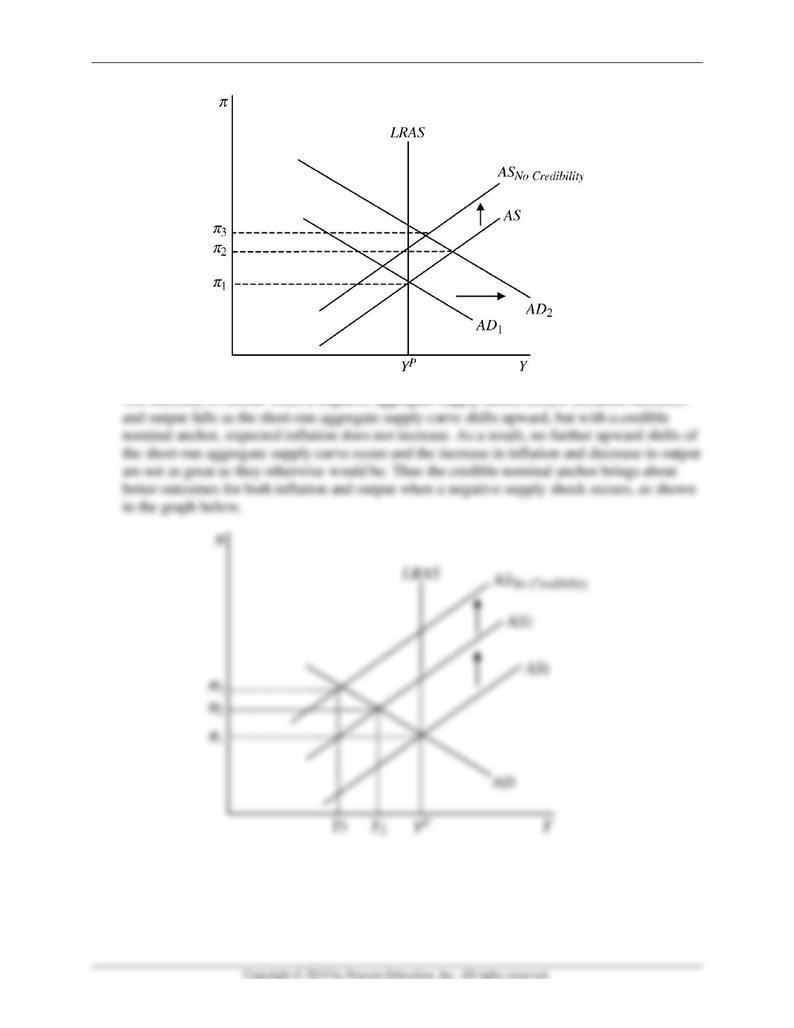
Mishkin • Instructor’s Manual for The Economics of Money, Banking, and Financial Markets, Twelfth Edition 277
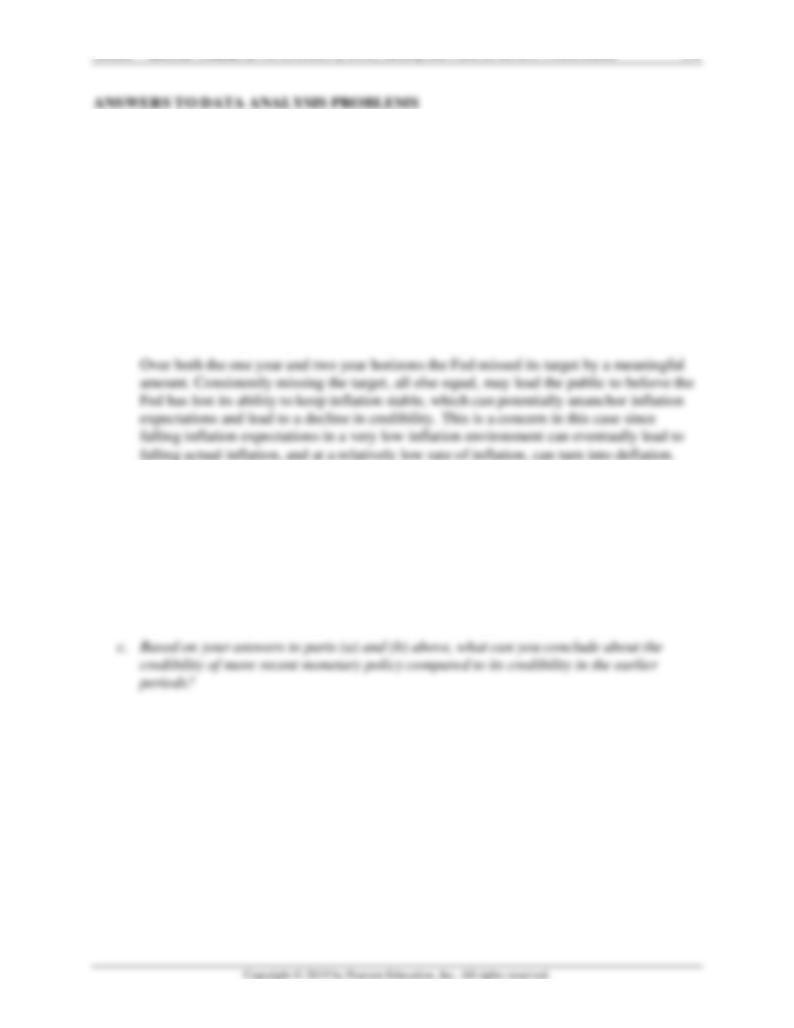
Mishkin • Instructor’s Manual for The Economics of Money, Banking, and Financial Markets, Twelfth Edition 278
1. Go to the St. Louis Federal Reserve FRED database and find data on the personal
consumption expenditure price index (PCECTPI). Convert the units setting to “Percent
Change from Year Ago,” and download the data. Beginning in January 2012, the Fed
formally announced a 2% inflation goal over the “longer-term.”
a. Calculate the average inflation rate over the last four and the last eight quarters of data
available. How does it compare to the 2% inflation goal?
From 2016:Q2 to 2017:Q1, inflation averaged 1.46%, which is below the current 2%
target. Over the two year horizon from 2015:Q2 to 2017:Q1, inflation averaged 0.96%,
which is quite a bit below the 2% target.
b. What, if anything, does your answer to part (a) imply about Federal Reserve credibility?
2. Go to the St. Louis Federal Reserve FRED database and find data on the core PCE price
index (PCEPILFE) and the spot price of a barrel of oil (WTISPLC). For both variables,
convert the units setting to “Percent Change from Year Ago,” and download the data from
1960 to the most recent available data.
a. Identify periods in which oil price inflation is 80% or higher.
b. In the periods identified in part (a), how many months was oil price inflation 80% or
higher? What was the average core inflation rate during each of those episodes?
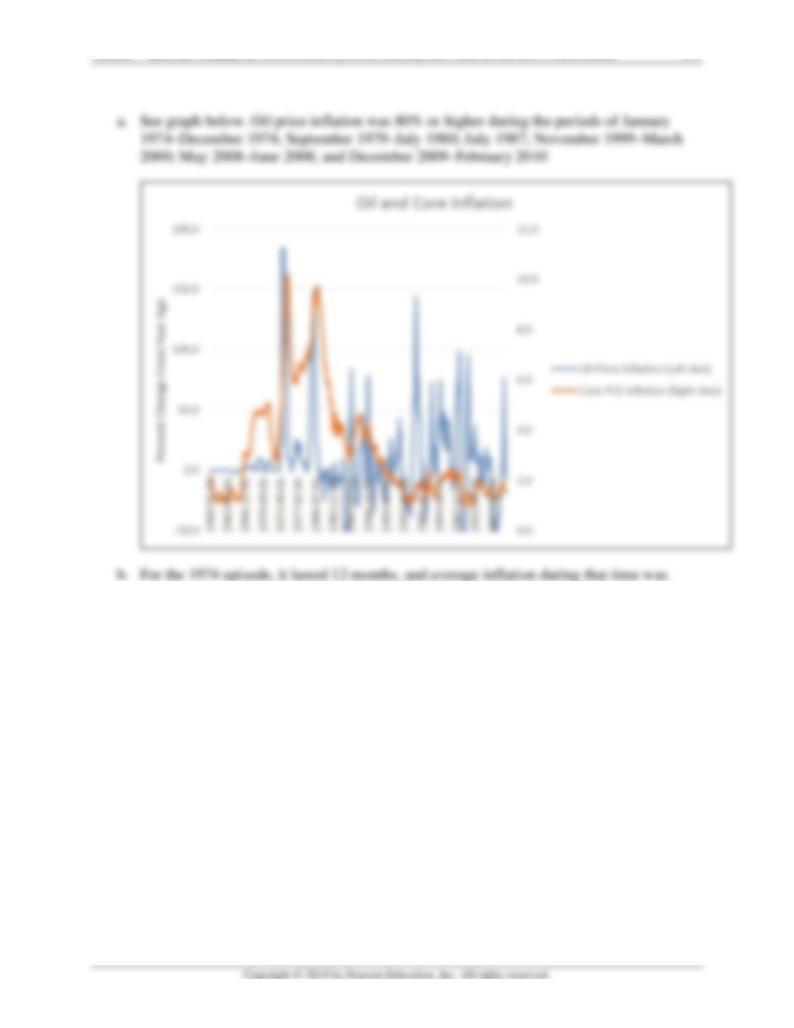
Mishkin • Instructor’s Manual for The Economics of Money, Banking, and Financial Markets, Twelfth Edition 279
7.9%. The 1979–1980 episode was 11 months long, with average core inflation of 8.4%.
The 1987 episode was only 1 month long, with average core inflation of 3.2%. The 1999–
2000 episode was 5 months long, with average core inflation of 1.6%. The 1979–1980
episode was 11 months long, with average core inflation of 8.4%. The 2008 episode was
only two months long, and average core inflation was 2.3%. The 2009–2010 episode was
3 months long, and average core inflation was 1.5%.
c. Clearly, the recent monetary policy has been much more credible in keeping inflation low
and stable. In particular, looking at the average inflation during each episode, it is clear
that sharp increases in oil prices in the 1970s lead to much bigger changes in the inflation
rate. More recent episodes of similar magnitude left inflation rates relatively low and
stable, suggesting an anchoring of expectations inherent with high credibility.
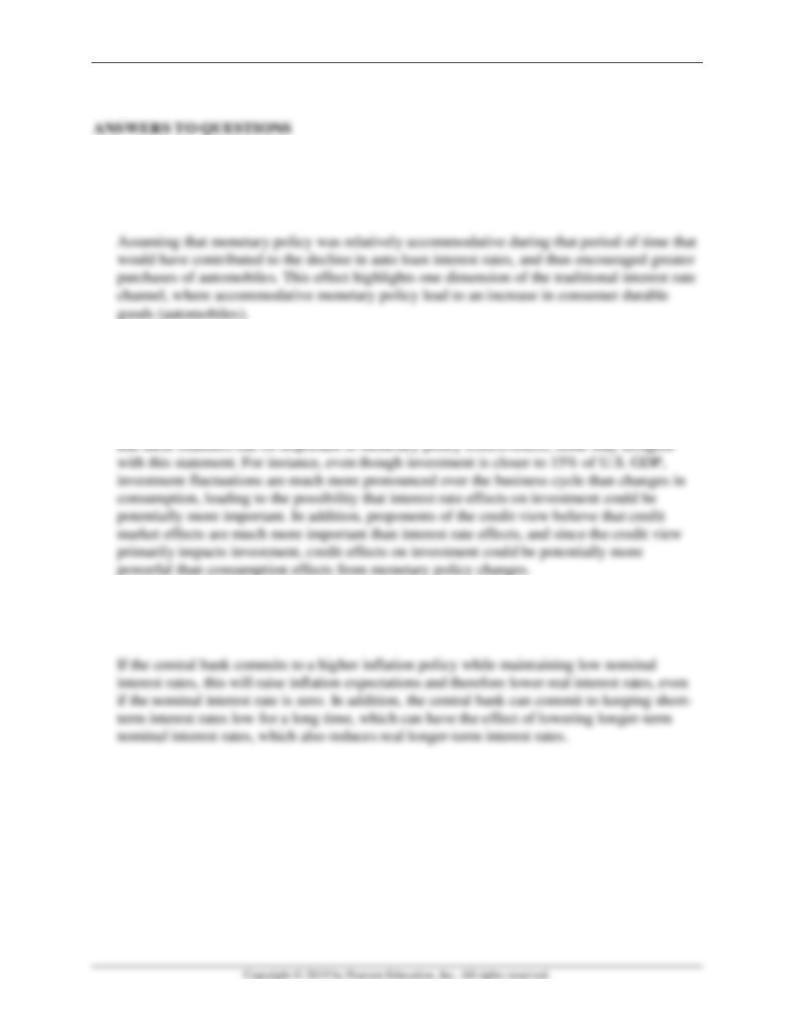
Mishkin • Instructor’s Manual for The Economics of Money, Banking, and Financial Markets, Twelfth Edition 280
Chapter 25
1. From 2008 to 2017, auto loan rates in the United States declined from around 8% to near
historic lows of around 4.5%. At the same time, auto sales increased to near historic high
levels by 2017. How, if at all, does this relate to the monetary transmission mechanism?
2. “Considering that consumption accounts for nearly two-thirds of total GDP, this means that the
interest rate, wealth, and household liquidity channels are the most important monetary policy
channels in the U.S.” Is this statement true, false, or uncertain? Explain your answer.
Uncertain. Although consumption is the largest part of overall U.S. GDP, and there is no doubt
3. How can the interest rate channel still function when short-term nominal interest rates are at
the zero lower bound?
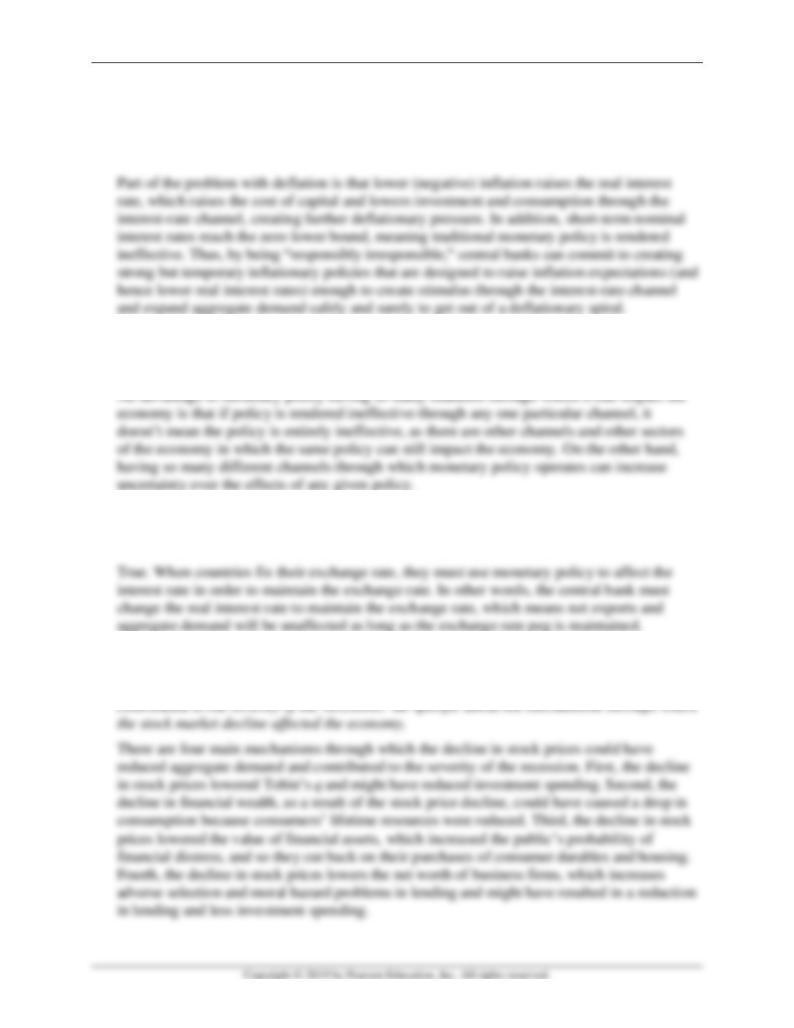
Mishkin • Instructor’s Manual for The Economics of Money, Banking, and Financial Markets, Twelfth Edition 281
4. Lars Svensson, a former Princeton professor and deputy governor of the Swedish central
bank, proclaimed that when an economy is at risk of falling into deflation, central bankers
should be “responsibly irresponsible” with monetary expansion policies. What does this
mean, and how does it relate to the monetary transmission mechanism?
5. Describe an advantage and a disadvantage of the fact that monetary policy has so many
different channels through which it can operate.
6. “If countries fix their exchange rate, the exchange rate channel of monetary policy does not
exist.” Is this statement true, false, or uncertain? Explain your answer.
7. During the 2007–2009 recession, the value of common stocks in real terms fell by more than
50%. How might this decline in the stock market have affected aggregate demand and thus
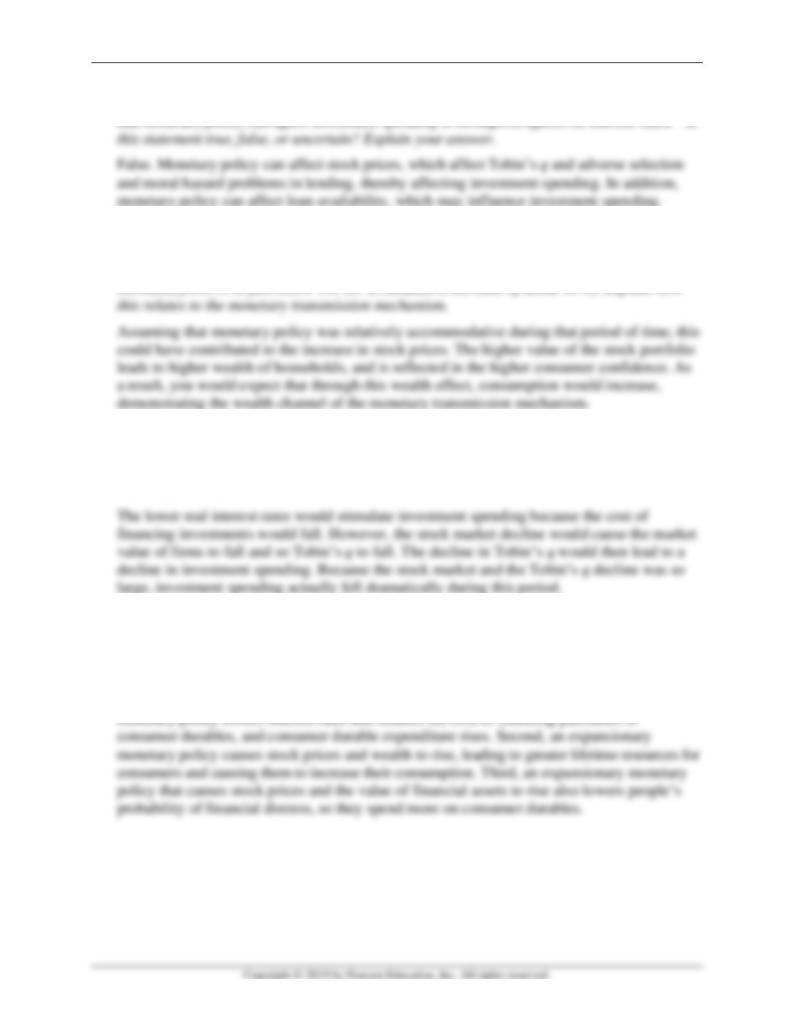
Mishkin • Instructor’s Manual for The Economics of Money, Banking, and Financial Markets, Twelfth Edition 282
8. “The costs of financing investment are related only to interest rates; therefore, the only way
9. From early 2009 to fall 2017, the S&P 500 stock index increased by a cumulative 260%, or
approximately 30% per year. Over the same period, one index of consumer confidence
10. From mid-2008 to early 2009, the Dow Jones Industrial Average declined by more than
50%, while real interest rates were low or falling. What does this scenario suggest should
have happened to investment?
11. Nobel Prize winner Franco Modigliani found that the most important transmission
mechanisms of monetary policy involve consumer expenditure. Describe how at least two of
these mechanisms work.
There are three mechanisms involving consumer expenditure. First, an expansionary
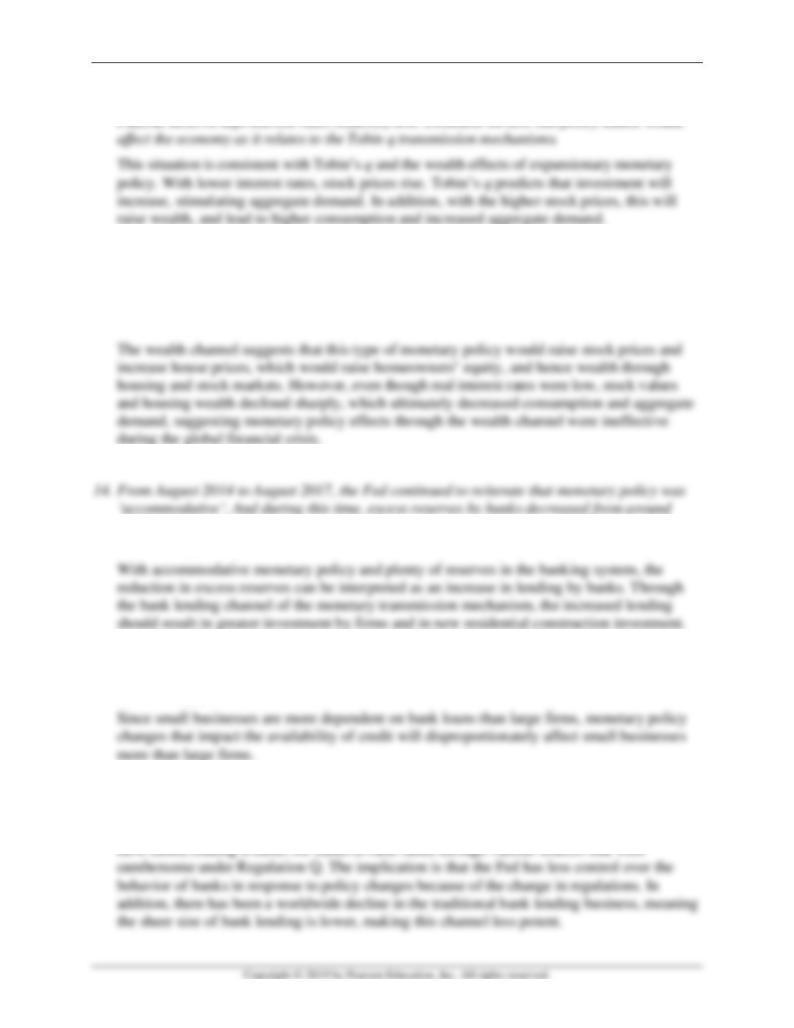
Mishkin • Instructor’s Manual for The Economics of Money, Banking, and Financial Markets, Twelfth Edition 283
12. In the late 1990s, the stock market was rising rapidly, the economy was growing, and the
13. During and after the global financial crisis, the Fed reduced the fed funds rate to nearly
zero. At the same time, the stock market fell dramatically and housing market values declined
sharply. Comment on the effectiveness of monetary policy during this period with regard to
the wealth channel.
$2.67 trillion to around $2 trillion, a decline of about 25%. What does this say about the
bank lending channel?
15. Why does the credit view imply that monetary policy has a greater effect on small businesses
than on large firms?
16. Why might the bank lending channel be less effective today than it once was?
There are a couple reasons why this might be true. First, bank regulations in the United States

Mishkin • Instructor’s Manual for The Economics of Money, Banking, and Financial Markets, Twelfth Edition 284
17. If adverse selection and moral hazard increase, how does this affect the ability of monetary
policy to address economic downturns?
18. How does the Great Depression demonstrate the unanticipated price level channel?
19. How are the wealth effect and the household liquidity effect similar? How are they different?
20. Following the global financial crisis, mortgage rates reached record-low levels in 2011.
a. What effect should this have had on the economy, according to the household liquidity
effect channel?
Lower mortgage rates should lead to higher housing prices and raise the value of housing
wealth. This should lead to a lower probability of financial distress and raise consumer
durable and housing expenditure.

Mishkin • Instructor’s Manual for The Economics of Money, Banking, and Financial Markets, Twelfth Edition 285
21. “If the fed funds rate is at zero, the Fed can no longer implement effective accommodative
policy.” Is this statement true, false, or uncertain? Explain.
22. In December 2015, the Fed raised the fed funds rate for the first time in nearly a decade, and
gradually increased interest rates over a prolonged period of time after that. However, the
Fed continued to reiterate in its policy statements during this time that “the stance of
monetary policy remains accommodative.” Explain this seeming contradiction.
23. In general, if stock prices are rising, consumption growth is strong, house price appreciation
is high, and unemployment is low, would you classify monetary policy as too tight, too loose,
or just right?
24. How does the experience of Japan during the “two lost decades” lend support to the four
lessons for monetary policy outlined in this chapter?

Mishkin • Instructor’s Manual for The Economics of Money, Banking, and Financial Markets, Twelfth Edition 286
25. Suppose the economy is in recession and the monetary policymakers lower interest rates in
an effort to stabilize the economy. Use an aggregate supply and demand diagram to
demonstrate the effects of a monetary easing when the transmission mechanisms are
functioning normally and when the transmission mechanisms are weak, such as during a
deep downturn or when significant financial frictions are present.
When the transmission mechanisms are functioning normally (and predictably),
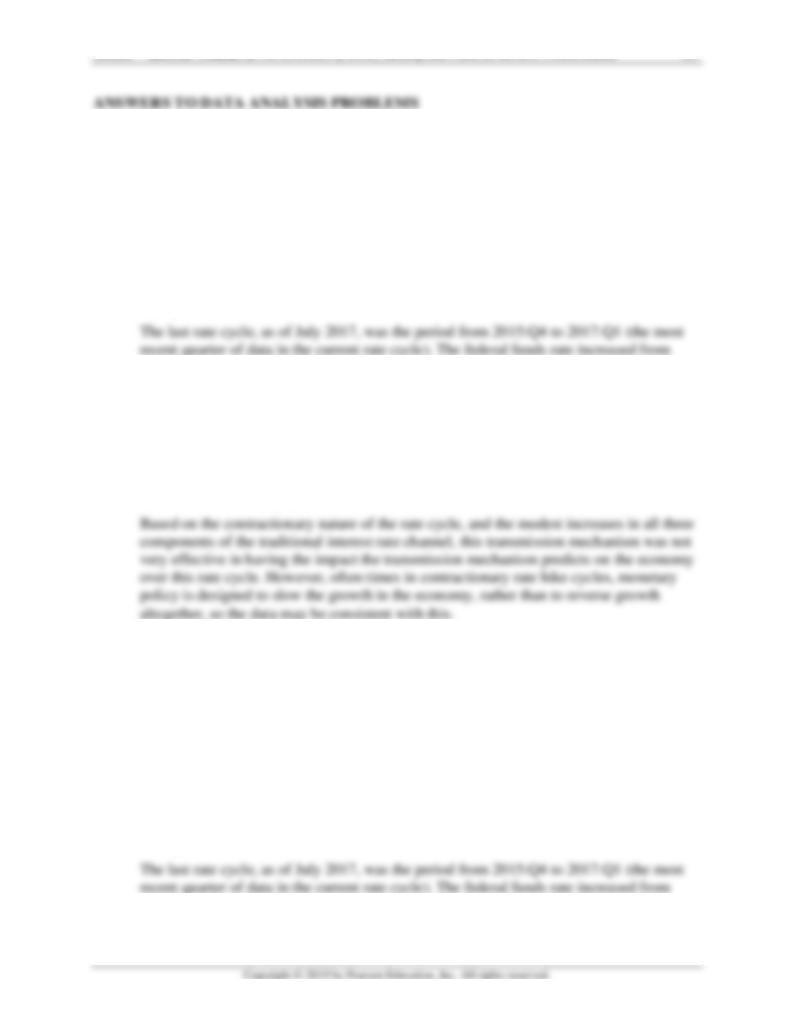
Mishkin • Instructor’s Manual for The Economics of Money, Banking, and Financial Markets, Twelfth Edition 287
1. A “rate cycle” is a period of monetary policy during which the federal funds rate moves from
its low point toward its high point, or vice versa, in response to business cycle conditions. Go
to the St. Louis Federal Reserve FRED database and find data on the federal funds rate
(FEDFUNDS), real business fixed investment (PNFIC96), real residential investment
(PRFIC96), and consumer durable expenditures (PCDGCC96). Use the frequency setting to
convert the federal funds rate data to “quarterly,” and download the data.
a. When did the last rate cycle begin and end? (Note: If a rate cycle is currently in progress,
use the current period as the end.) Is this rate cycle a contractionary or an expansionary
rate cycle?
0.16% to 0.70%, a contractionary policy.
b. Calculate the percentage change in business fixed investment, residential (housing)
investment, and consumer durable expenditures over this rate cycle.
Over this period, business fixed investment increased by 2.4%, residential investment
increased by 5.2%, and consumer durable spending increased by 6.9%.
c. Based on your answers to parts (a) and (b), how effective was the traditional interest rate
channel of monetary policy over this rate cycle?
2. As defined in Exercise 1, a “rate cycle” is a period of monetary policy during which the
federal funds rate moves from its low point toward its high point, or vice versa, in response
to business cycle conditions. Go to the St. Louis Federal Reserve FRED database and find
data on the federal funds rate (FEDFUNDS), bank reserves (TOTRESNS), bank deposits
(TCDSL), commercial and industrial loans (BUSLOANS), real estate loans (REALLN), real
business fixed investment (PNFIC96), and real residential investment (PRFIC96). Use the
frequency setting to convert the federal funds rate, bank reserves, bank deposits, commercial
and industrial loans, and real estate loans data to “quarterly,” and download the data.
a. When did the last rate cycle begin and end? (Note: if a rate cycle is currently in progress,
use the current period as the end.) Is this rate cycle a contractionary or an expansionary
rate cycle?
0.16% to 0.70%, a contractionary policy.

5.2%,
c. Based on your answers to parts (a) and (b), how effective was the bank lending channel
of monetary policy over this rate cycle?